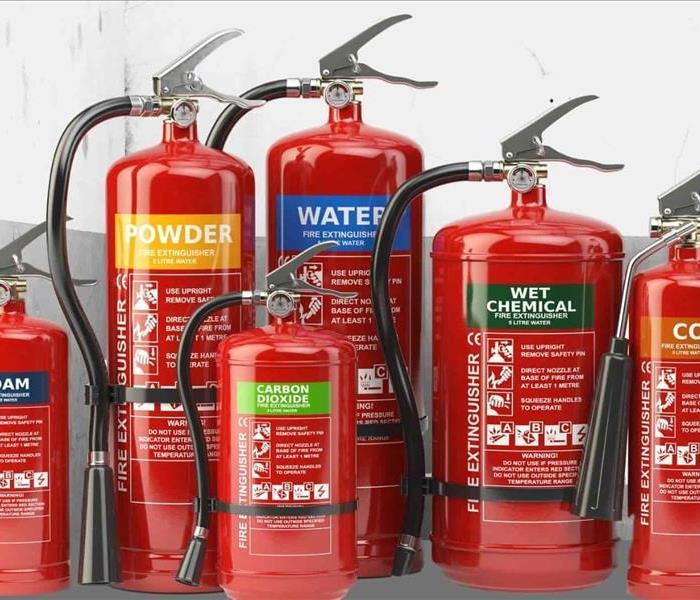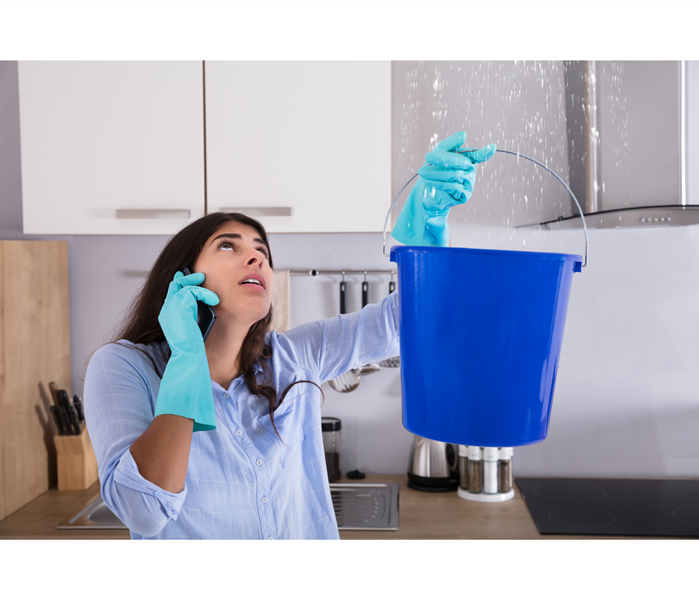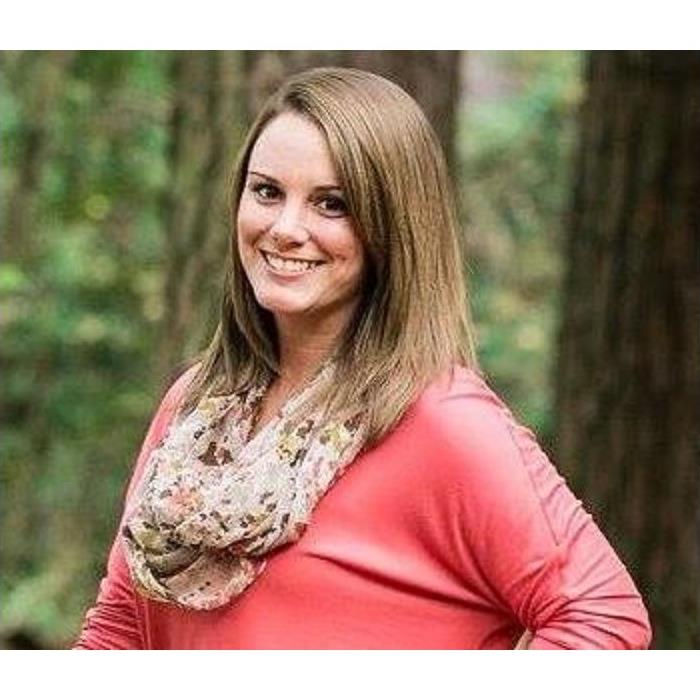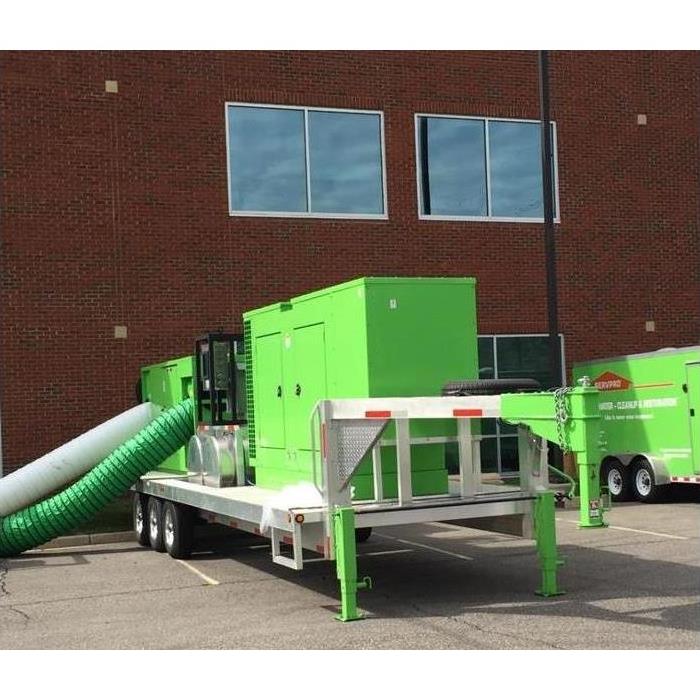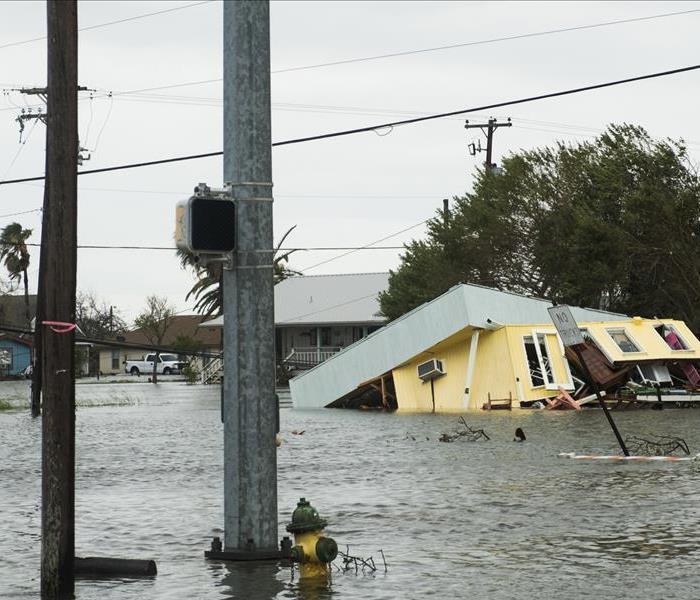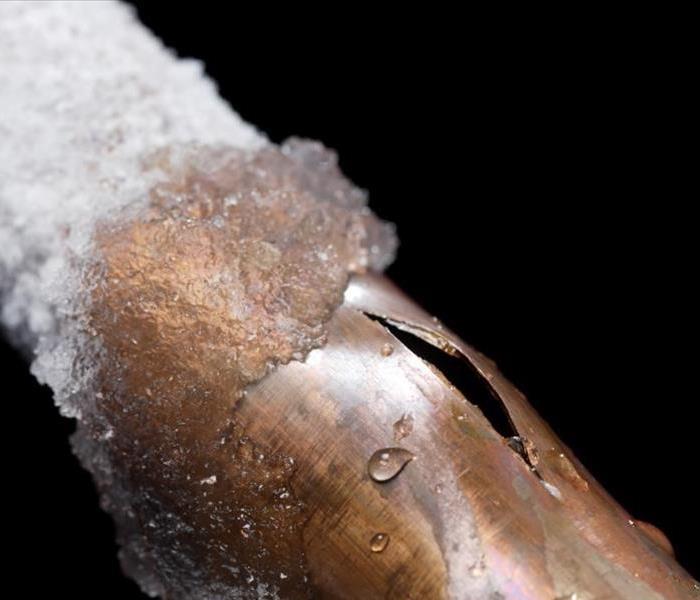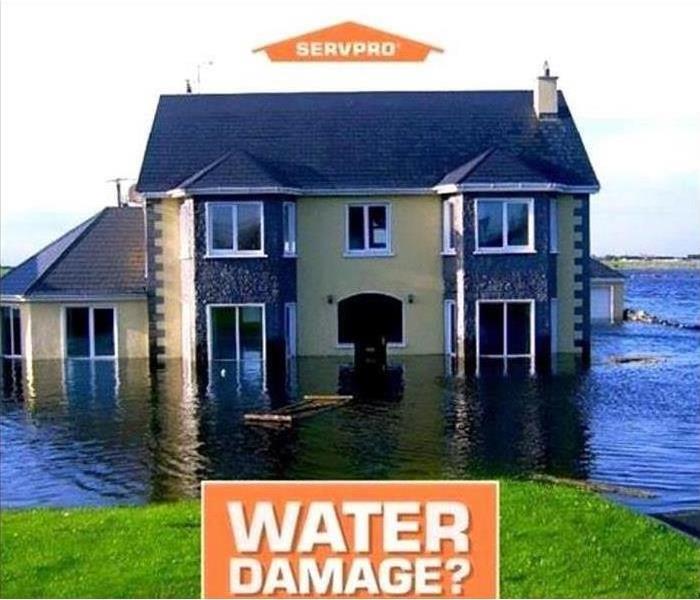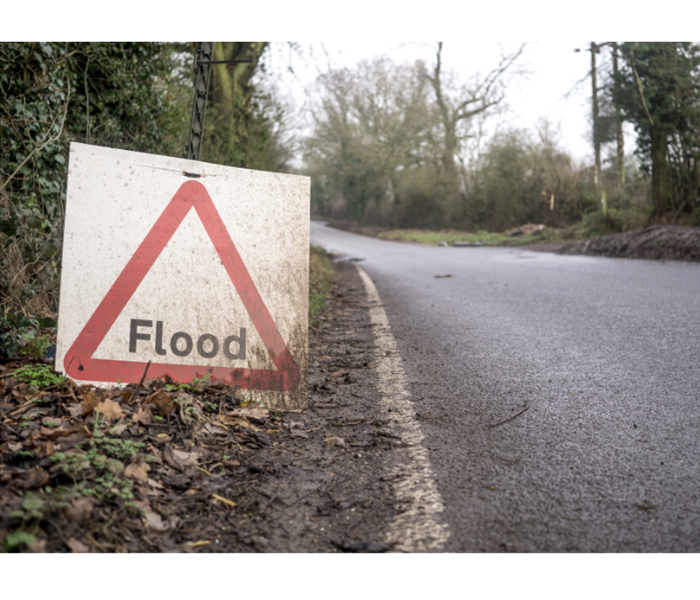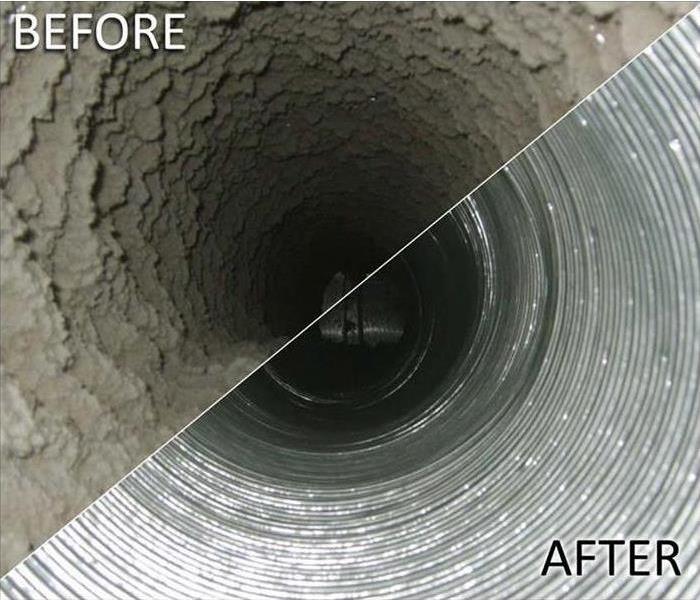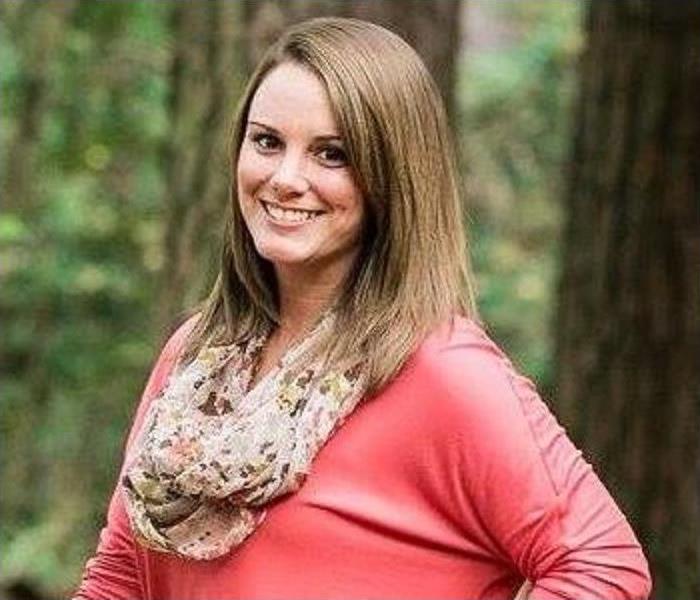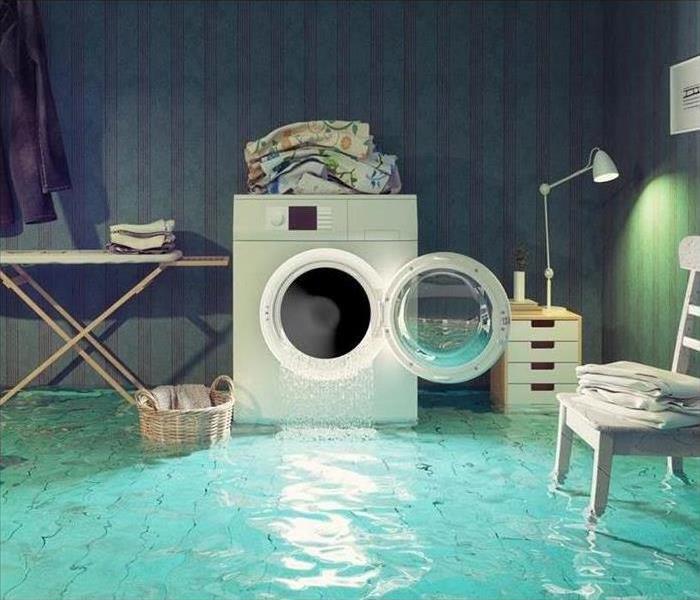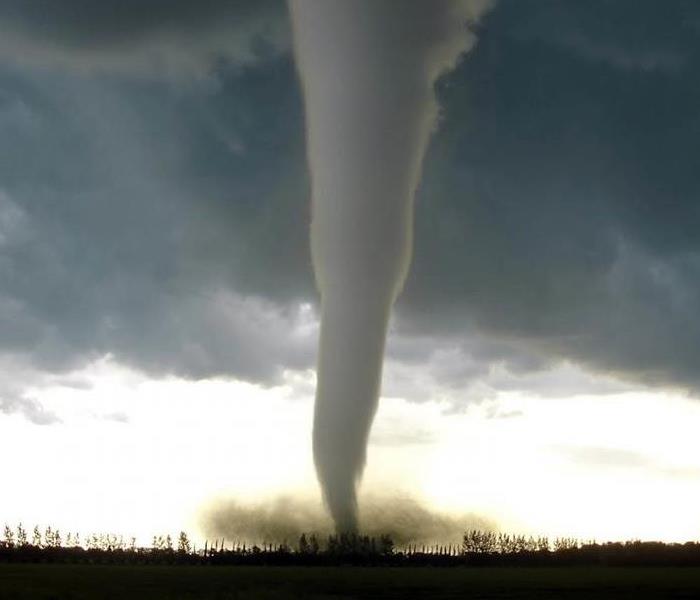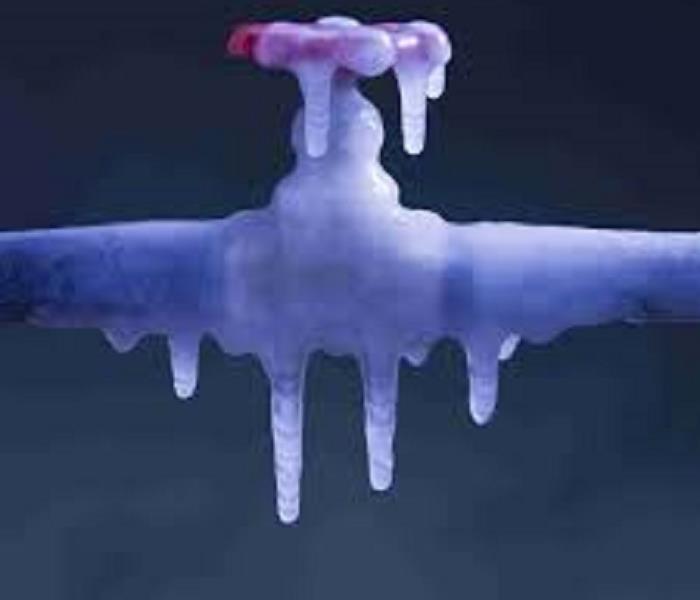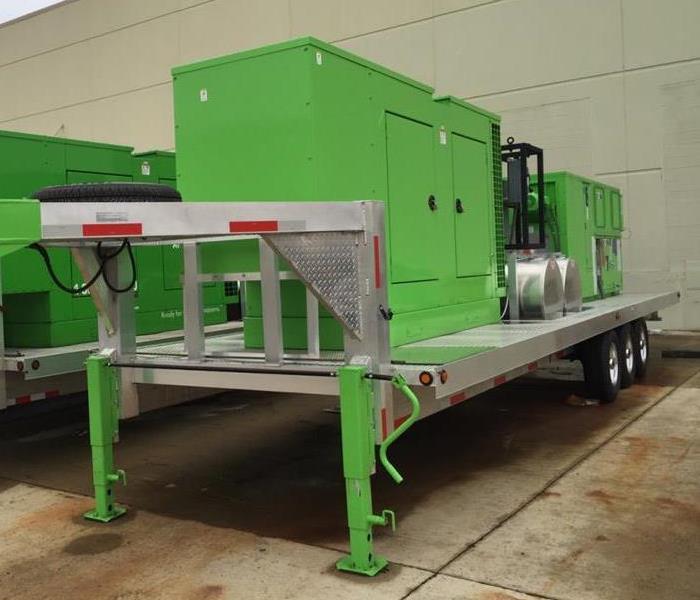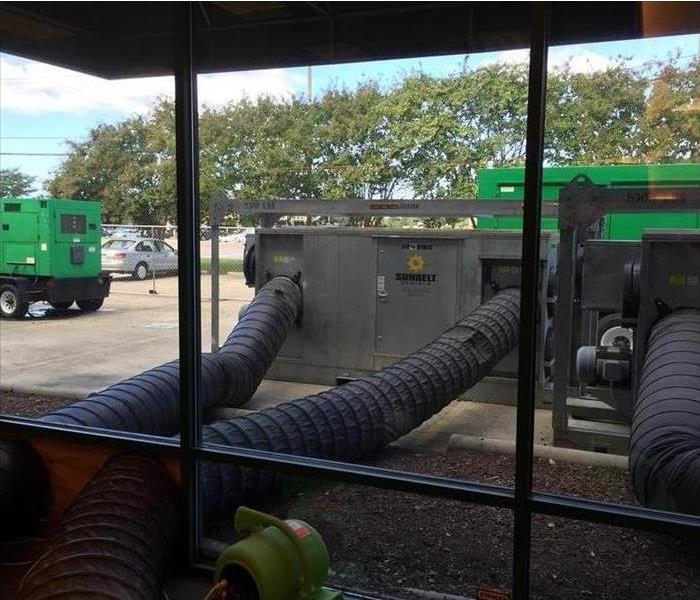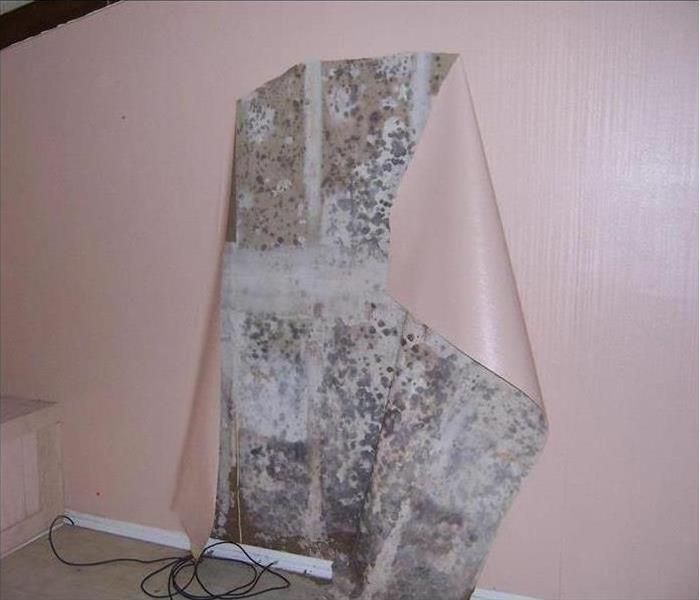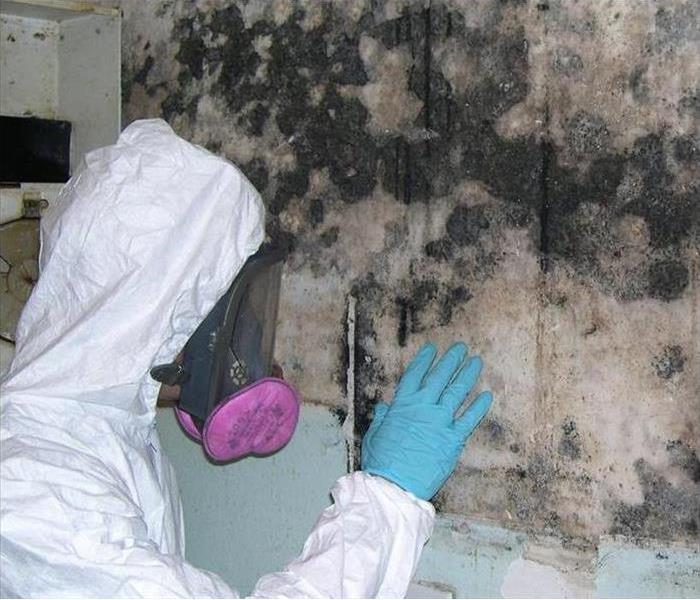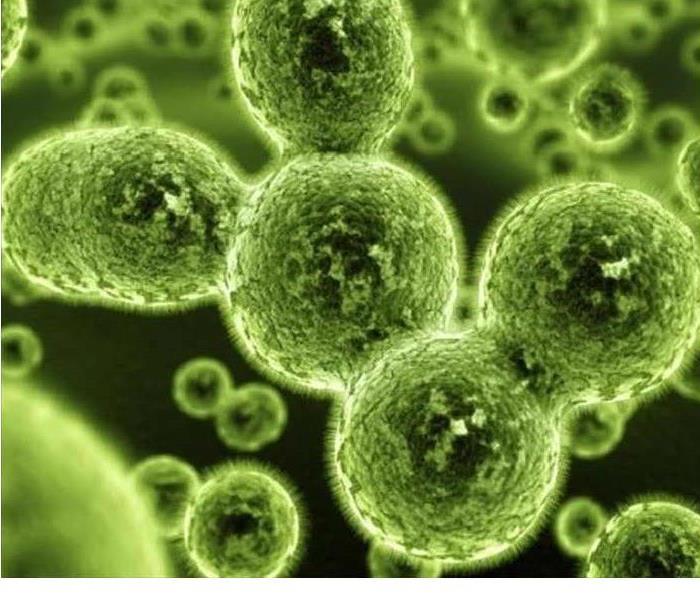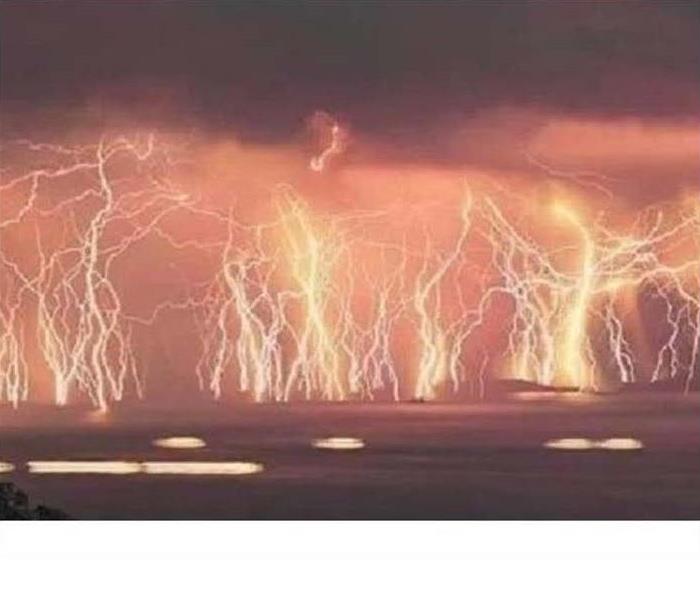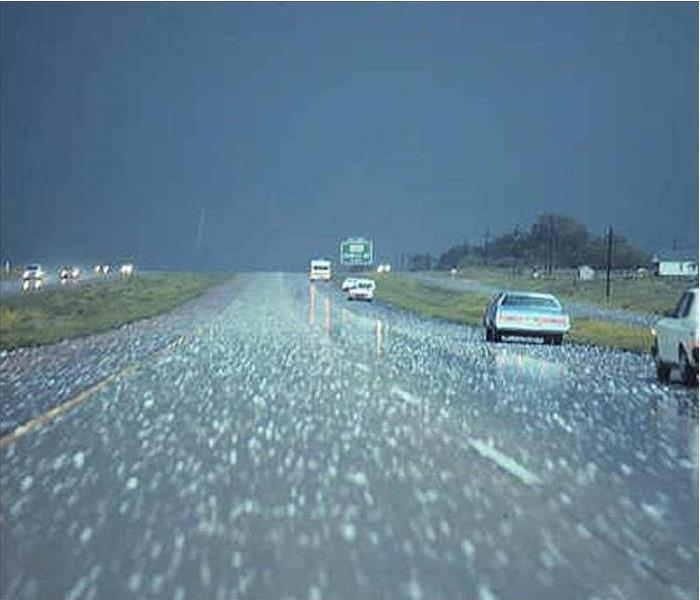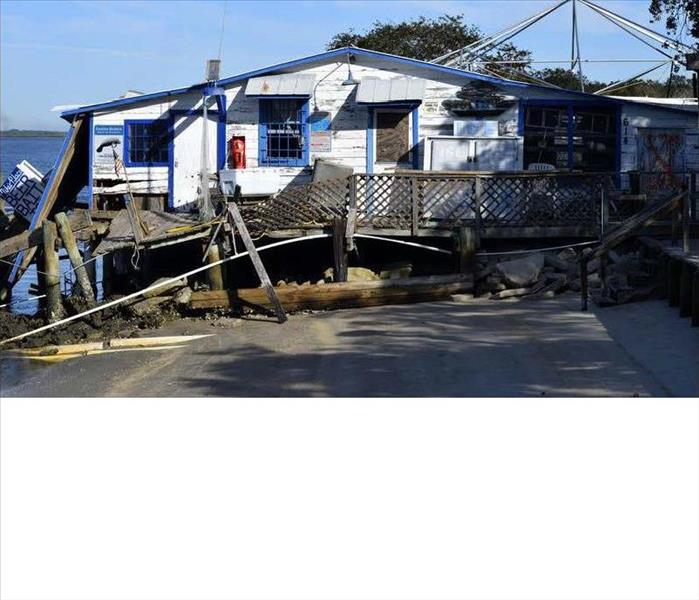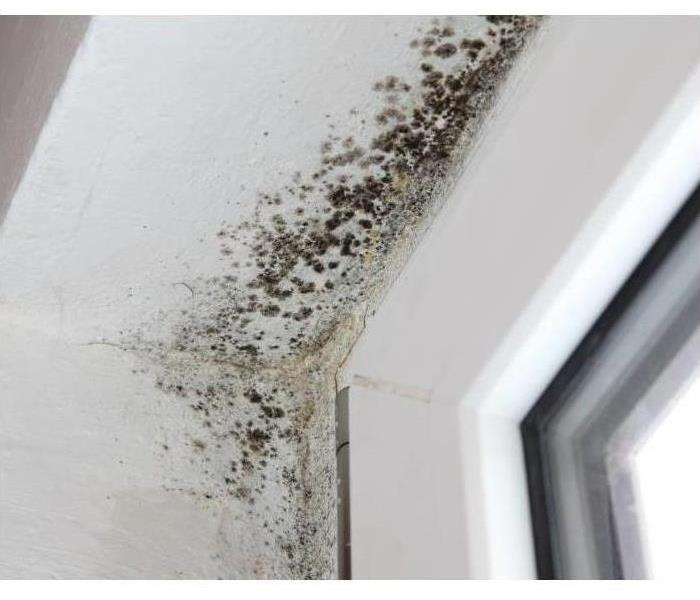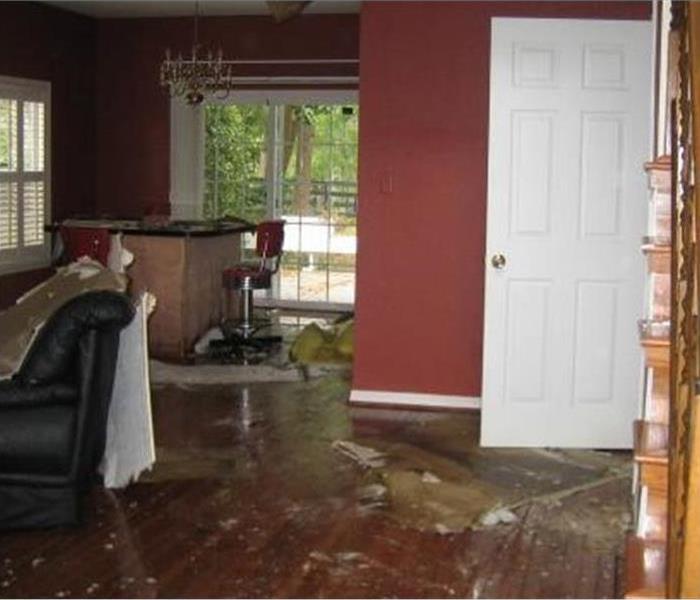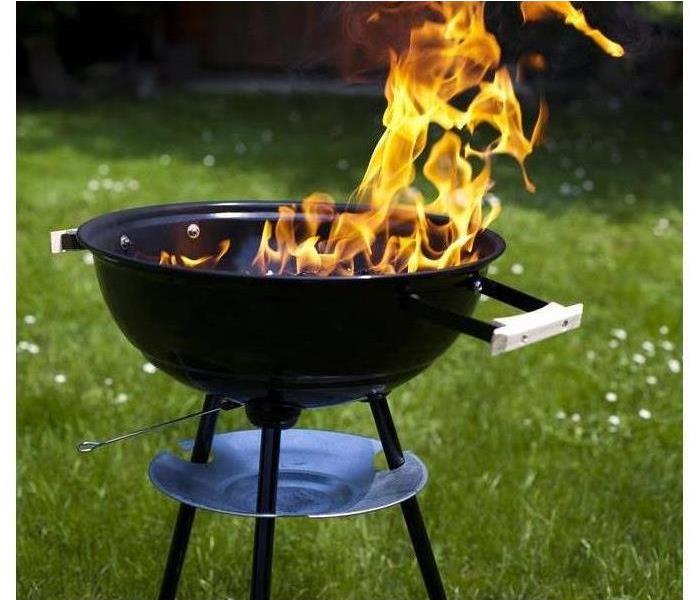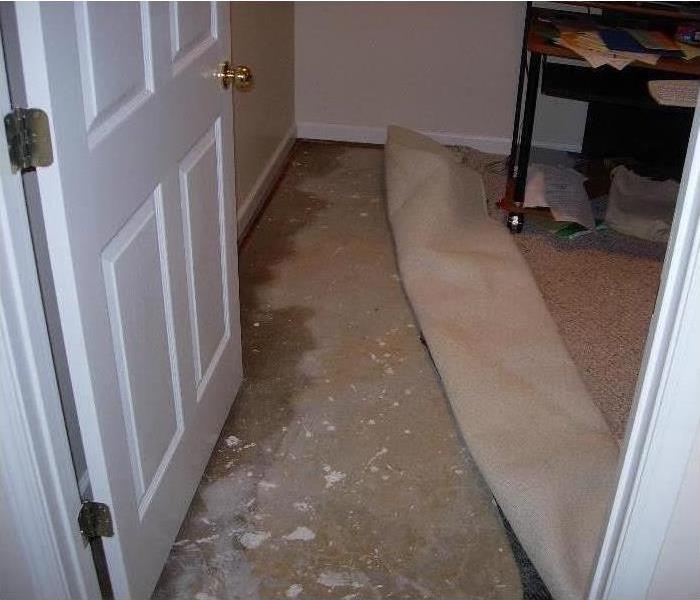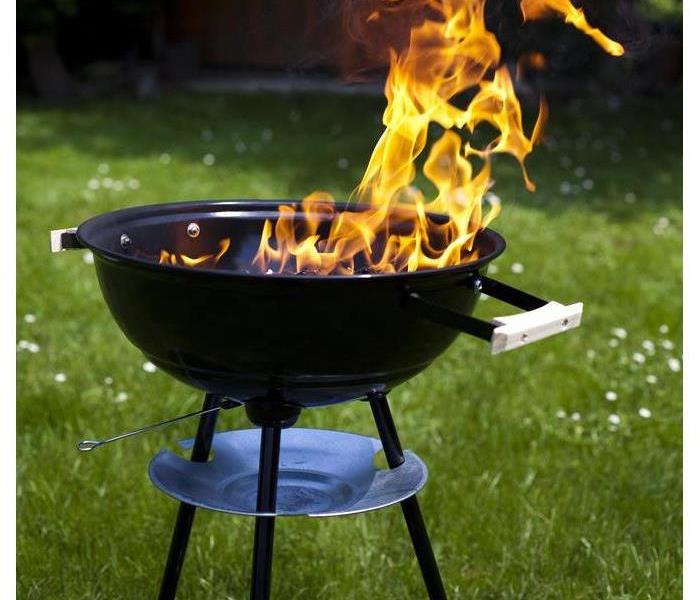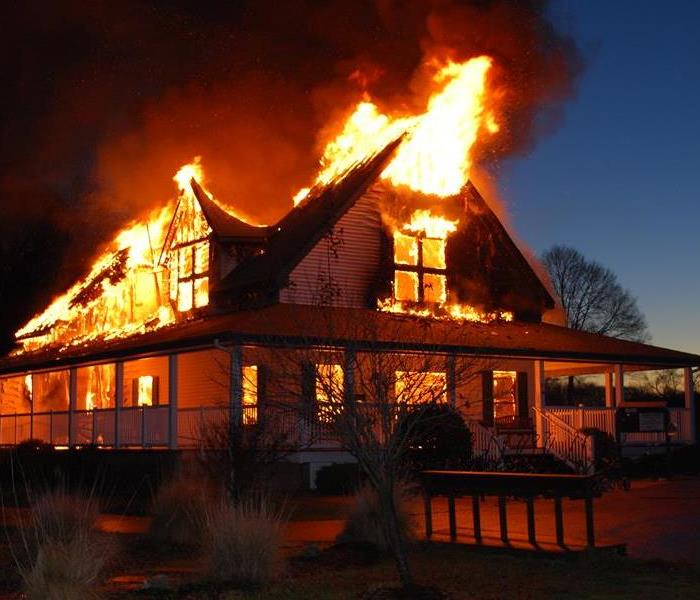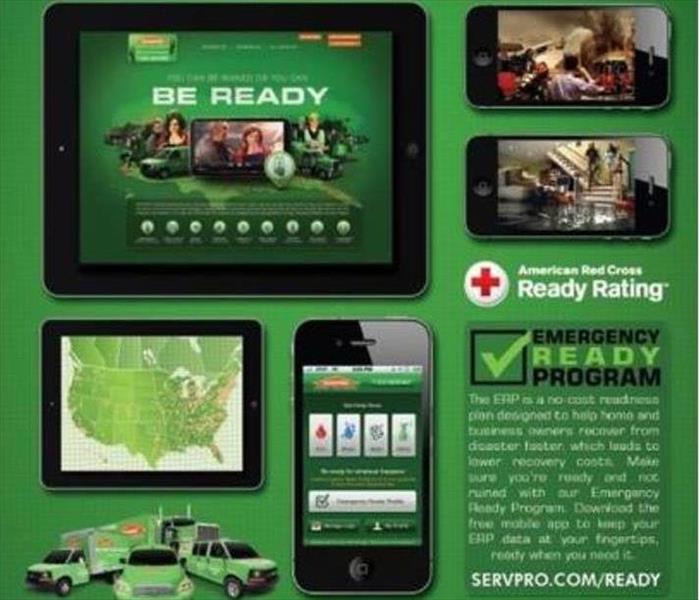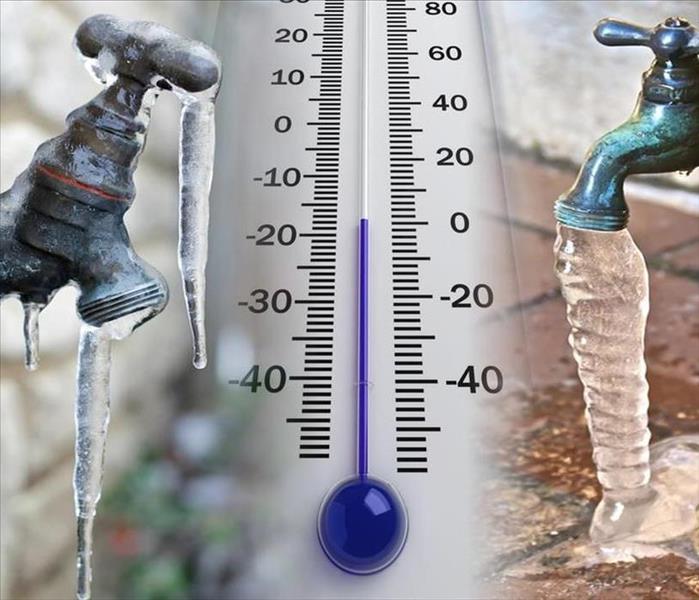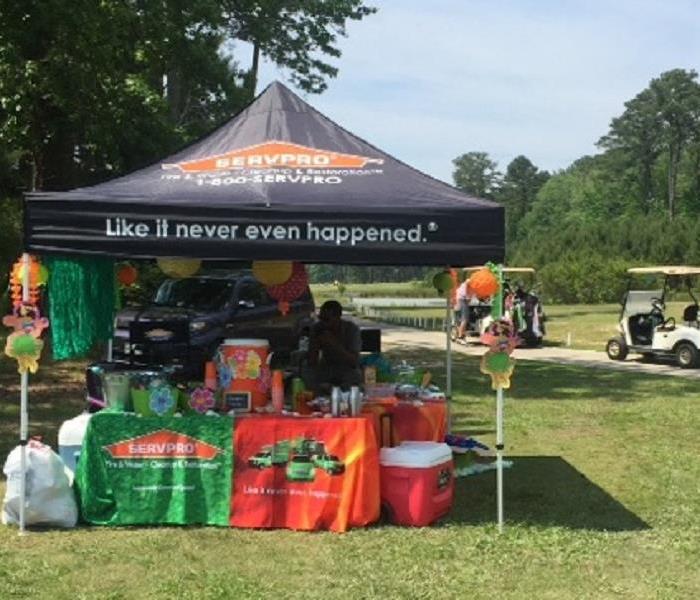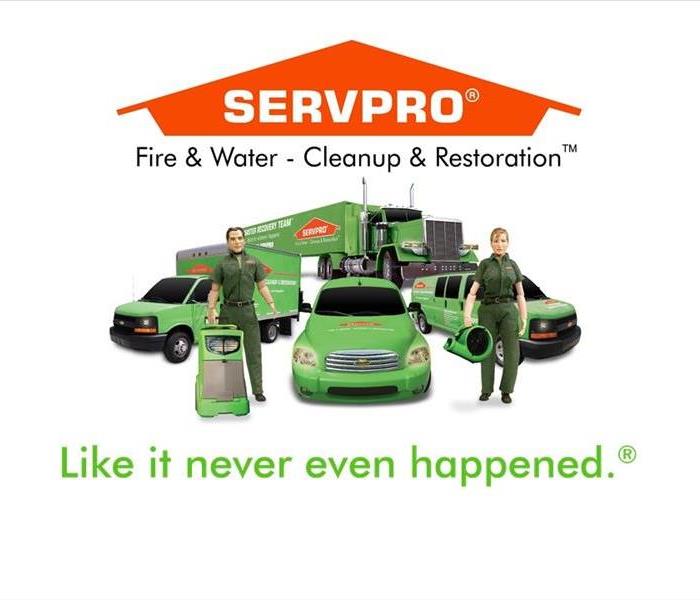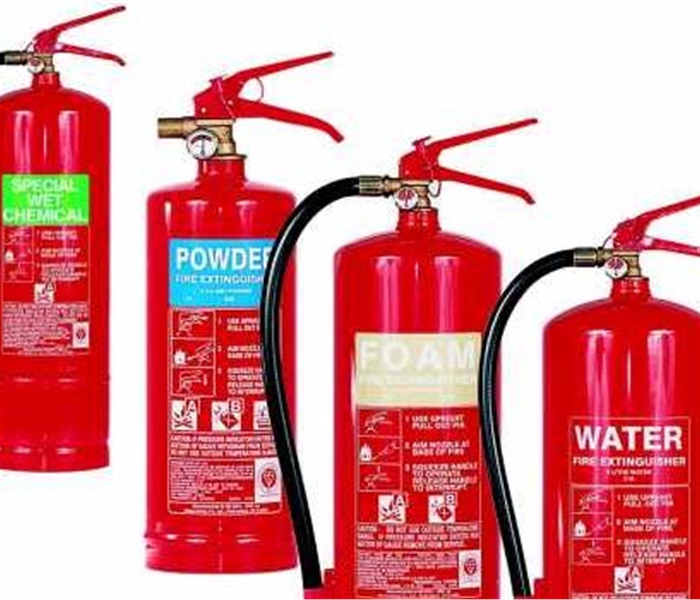Archived Blog Posts
Mold Remediation Masters: Why SERVPRO of Virginia Beach Leads the Pack
2/14/2024 (Permalink)
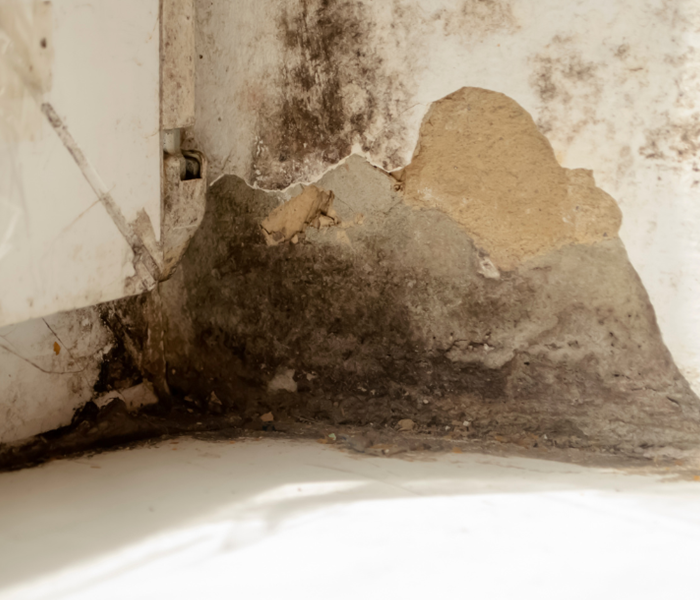 Mold on bottom of wall
Mold on bottom of wall
Mold is a silent menace that can wreak havoc on homes and businesses alike. Its presence not only compromises the structural integrity of buildings but also poses serious health risks to occupants. In the face of mold infestation, swift and effective action is crucial. This is where SERVPRO of Virginia Beach shines as the go-to expert in mold remediation. With a combination of experience, advanced techniques, and a commitment to excellence, we stand out as the premier choice for tackling mold problems head-on.
At SERVPRO of Virginia Beach, mold remediation isn't just a service we offer—it's our specialty. With years of experience under our belt, we've encountered mold in all its forms and know exactly how to combat it. Our team of certified professionals understands the complexities of mold growth, from its preferred environments to its various species. This expertise allows us to develop tailored solutions that address each unique situation effectively.
In the battle against mold, staying ahead of the curve is paramount. That's why SERVPRO of Virginia Beach invests in the latest tools and techniques for mold remediation. From advanced moisture detection devices to state-of-the-art HEPA filtration systems, we leverage technology to identify and mitigate mold at its source. Our methods are not only efficient but also environmentally friendly, minimizing disruption to your property while ensuring thorough mold removal.
Mold remediation is more than just removing visible mold growth—it's about addressing the underlying issues that contribute to its proliferation. At SERVPRO of Virginia Beach, we take a comprehensive approach to mold remediation, focusing not only on eradication but also on prevention. By identifying moisture sources, improving ventilation, and implementing moisture control measures, we help mitigate the risk of future mold outbreaks, safeguarding your property and your health.
When it comes to mold remediation, trust is paramount. That's why SERVPRO of Virginia Beach is proud to be an IICRC-certified firm, adhering to the highest industry standards for mold remediation. Our technicians undergo rigorous training and certification to ensure that they are equipped with the knowledge and skills needed to tackle mold effectively. Additionally, we are fully licensed and insured, providing you with peace of mind knowing that your property is in capable hands.
At SERVPRO of Virginia Beach, customer satisfaction is our top priority. We understand the stress and disruption that mold infestation can cause, which is why we strive to make the remediation process as smooth and hassle-free as possible. From prompt response times to clear communication and transparent pricing, we go above and beyond to exceed our customers' expectations at every turn. When you choose SERVPRO of Virginia Beach, you can trust that you're receiving not only superior mold remediation services but also exceptional customer care.
When mold strikes, don't leave your property's safety and integrity to chance. Trust the experts at SERVPRO of Virginia Beach to deliver prompt, professional, and effective mold remediation services. With our unmatched expertise, cutting-edge techniques, and commitment to customer satisfaction, we'll restore your property to its pre-mold condition, ensuring a safer and healthier environment for you and your loved ones. Don't wait—contact us today and let us put our mold remediation mastery to work for you.
Why Virginia Beach Residents Should Choose SERVPRO™ of Virginia Beach for Fire Restoration
2/14/2024 (Permalink)
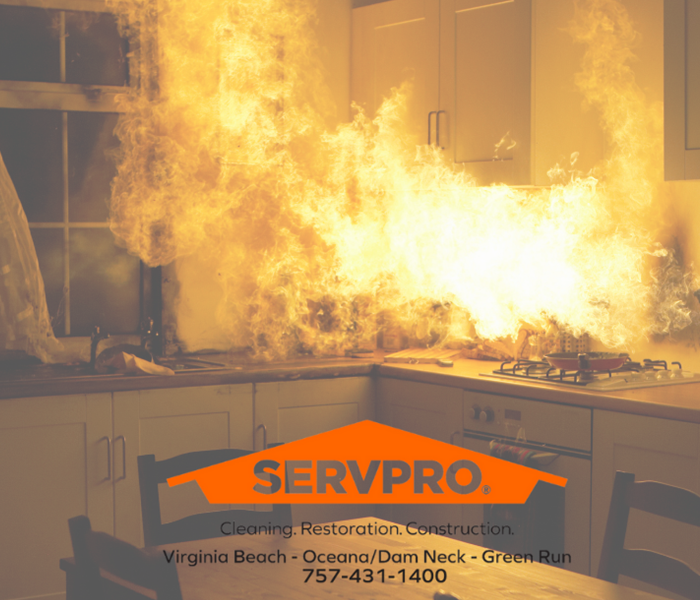 Fire in kitchen
Fire in kitchen
Experiencing a fire in your home is a devastating event that can leave behind not only physical damage but also emotional distress. In such a challenging time, having a reliable and efficient restoration service is crucial to help you get your life back on track. For residents of Virginia Beach, SERVPRO of Virginia Beach stands out as a trusted partner in fire restoration. With their expertise, dedication, and commitment to excellence, they are the go-to choice for restoring homes and peace of mind.
One of the primary reasons why Virginia Beach residents should choose SERVPRO for fire restoration is their unmatched expertise and experience in handling fire damage. With years of experience in the industry, SERVPRO technicians are highly trained and certified to address all aspects of fire damage restoration. From assessing the extent of the damage to implementing effective restoration strategies, they have the knowledge and skills to deliver exceptional results.
Fire damage restoration requires specialized techniques and equipment to ensure thorough and efficient cleanup and restoration. SERVPRO of Virginia Beach utilizes state-of-the-art equipment and advanced restoration techniques to tackle even the most challenging fire damage scenarios. From removing smoke odor to cleaning soot and ash residues, they employ cutting-edge tools and technology to restore your home to its pre-fire condition.
When it comes to fire damage restoration, time is of the essence. That's why SERVPRO of Virginia Beach offers prompt response and 24/7 availability to ensure that help is always just a phone call away. Their team understands the urgency of the situation and works swiftly to mitigate further damage and begin the restoration process immediately. Whether it's day or night, weekends, or holidays, you can count on SERVPRO to be there when you need them the most.
SERVPRO of Virginia Beach provides comprehensive fire damage restoration services tailored to meet the unique needs of each client. From initial assessment and emergency board-up services to debris removal, cleaning, and restoration, they handle every aspect of the restoration process with precision and care. Their comprehensive approach ensures that every detail is addressed, leaving no room for overlooked damage or lingering issues.
Dealing with insurance companies can be overwhelming, especially in the aftermath of a fire. SERVPRO of Virginia Beach simplifies the process by offering assistance with insurance claims. Their team works closely with insurance adjusters to document the damage, provide accurate estimates, and streamline the claims process, allowing you to focus on rebuilding your life while they handle the paperwork.
When it comes to fire damage restoration in Virginia Beach, SERVPRO of Virginia Beach stands out as the premier choice for homeowners in need of reliable and efficient restoration services. With their expertise, advanced techniques, prompt response, and comprehensive approach, they deliver exceptional results that exceed expectations. In the aftermath of a fire, trust SERVPRO to restore your home and peace of mind with professionalism, compassion, and dedication.
The Crucial Role of SERVPRO Of Virginia Beach's ERP in Commercial Buildings
2/14/2024 (Permalink)
In the dynamic landscape of commercial real estate, preparedness is paramount. Whether it's a sudden burst pipe flooding an office space or a fire threatening to engulf a retail store, emergencies can strike without warning, wreaking havoc on businesses and their assets. In such turbulent times, having a solid Emergency Ready Profile (ERP) from SERVPRO Of Virginia Beach can make all the difference between swift recovery and prolonged disruption.
Understanding the Significance
An ERP serves as a comprehensive blueprint for handling emergencies efficiently. It provides vital information at your fingertips, including crucial contacts, shut-off valve locations, utility details, and floor plans. SERVPRO Of Virginia Beach specializes in crafting tailored ERPs that cater to the specific needs and nuances of commercial properties.
Rapid Response and Minimized Downtime
Time is of the essence during emergencies. With an ERP in place, businesses can initiate a rapid response protocol, swiftly alerting key stakeholders and coordinating with SERVPRO Of Virginia Beach's expert team. By streamlining communication and outlining clear steps for mitigation, the ERP minimizes downtime and helps businesses resume operations at the earliest.
Enhanced Safety and Compliance
Safety is non-negotiable in any commercial setting. SERVPRO Of Virginia Beach's ERP not only prioritizes the safety of occupants and employees but also ensures compliance with regulatory standards. From evacuation procedures to hazardous material handling guidelines, the ERP equips businesses with the knowledge and resources needed to uphold safety protocols.
Protection of Assets and Reputation
Commercial properties are not just bricks and mortar; they embody years of hard work, investment, and brand reputation. In the face of adversity, safeguarding these assets becomes paramount. By having a detailed ERP from SERVPRO Of Virginia Beach on file, businesses can mitigate damage to property, inventory, and equipment, thereby preserving their financial stability and reputation.
Proactive Risk Management
Prevention is better than cure—an adage that holds true in the realm of emergency preparedness. SERVPRO Of Virginia Beach's ERP goes beyond reactive measures by fostering a culture of proactive risk management. By identifying potential hazards, implementing preventive measures, and conducting regular drills, businesses can fortify their resilience against unforeseen calamities.
Conclusion
In today's unpredictable business environment, the importance of having an ERP from SERVPRO Of Virginia Beach on file in commercial buildings cannot be overstated. From facilitating rapid response to safeguarding assets and reputation, the ERP serves as a cornerstone of preparedness and resilience. By partnering with SERVPRO Of Virginia Beach and embracing proactive emergency planning, businesses can navigate challenges with confidence, ensuring a brighter and more secure future for all stakeholders involved.
Hurricane Preparedness
6/20/2023 (Permalink)
Hurricane season started June 1st and runs through November 30th. Now is the perfect time to think about making some preparations.
Preparing in advance to deal with the unexpected can make a world of difference in how quickly and completely we can put the pieces of their lives back together. We encourage all realtors, association managers and property owners to take advantage of the no-cost emergency planning tools available from the Federal Emergency Management Agency (FEMA) (www.ready.gov/publications)
Flood Insurance
The most important thing to consider for your home is flood insurance. A common misconception is that homes that are not in a flood zone are not eligible for such coverage. That is not the case. Any home can have a flood insurance policy. Insurance is sold through local agents as part of the National Flood Insurance Program, or NFIP. Homeowners can take out separate polices to insure the structure and any contents inside. Homes that are in a designated flood zone are required to have flood insurance, and it is typically a stipulation during the sale of a house. In fact, it is recommended that homes outside of a flood zone also have coverage, especially in coastal communities, like Hampton Roads. Nationally, about 30 % of flood insurance claims come from homes that are not in a flood zone. Premiums vary by numerous factors such as location, age of the dwelling and value of insured contents inside the home. For more information about the NFIP, please visit FEMA.gov/NFIP.
Know your Zone.
The state introduced “Know Your Zone” to simplify evacuation processes when it becomes necessary. There are four zones, lettered A-D, that specify your evacuation zone based on your address and nature of the emergency event. State and local agencies will alert residents by their zones if there is a need to evacuate or shelter in place. While not every neighborhood is in a zone, that does not mean you will never have to evacuate, so you’ll still need to pay attention to official announcements and news.
To find your zone, go to KnowYourZoneVA.org. Once there, follow the on-screen instructions to enter your address and determine where you fall on the map.
Know your way out.
Have an evacuation plan, become familiar with it and make sure your family is aware of it as well. The most common routes:
- If you live north of I-264, head north and west along I-64 and across the HRBT and move inland.
- If you live south of I-264, head south and west on I-64 towards Suffolk and Highway 460 Continue to head inland and away from the coast to lessen the impact of a storm.
Keep in mind that the Chesapeake Bay Bridge Tunnel will likely be closed if an incoming storm has high winds. Avoid going north on Highway 13 and opt for the other routes.
If you choose to Shelter in Place
Have a cache of supplies that will last each member of your household, including any pets or infants, at least three days. Some of the basic supplies are:
- Water – one gallon per person, per day
- Food – Non-perishable or canned goods
- Medications and first-aid supplies
- Portable lights and batteries
- Portable radio
- Personal hygiene supplies
- Toilet paper
- Cash – to purchase one week’s worth of supplies for your household.
Should you or someone you know experience a water damage from a hurricane or a leaking pipe please do not hesitate to call SERVPRO of Virginia Beach at 757-431-1400
What You Should Know, Should You Experience A Water Damage.
6/20/2023 (Permalink)
The thing about water damage and repair professionals is that no one seems to have interest in knowing one until they're in desperate need of their help! We interviewed SERVPRO of Virginia Beach Franchise Owner, Anna Cheracles, to find out just what it is that a restoration professional does and when and why someone would need to hire one. Here's what Anna had to say:
What exactly does a water damage and repair professional do?
We arrive onsite within 4 hours (usually 1 hour) to remediate a water damage. The sooner you can stop the water and begin to dry the structure, the less damage you will have, which will reduce repairs that will need to be done.
Why is it important to call a professional?
We can restore vs. replace. We have special drying techniques which will save time and money for the insured and insurance company. You don't want to end up with any type of secondary damage or mold that could be prevented by calling a professional right away.
A professional will know when it is necessary to remove materials such as vinyl or laminate floors in order to dry sub floors. We have tools, such as moisture meters, that can detect exactly what's been affected so that we can properly mitigate the loss.
What are the most common problems water damage professionals see?
We often find pre-existing damage. It is important to properly maintain your home so that dry rot or other slow leaks do not occur. If you have a pipe burst under your sink, but you have dry rot already showing on you sub floor, often the insurance companies will not cover this due to the home not being maintained.
Another problem we see is when a homeowner does not take immediate action. They will wait a few days for the insurance company to come out before they call a mitigation company to come out. Or they try to do the work themselves. This will only prolong the process and possibly cause more damage later on. You need special equipment to properly dry a structure.
When should I call a water damage professional?
Anytime you experience a water damage, you should call a professional. The sooner you call, the more you can minimize damage. Even if the cause of the problem is still not fixed, the faster we can begin extracting water, you can lessen the chance of further damage. Often times an area can feel dry to the touch, but it is important to have a professional use a moisture meter to check for water behind cabinets, walls, etc. Dry wall may feel dry, but the insulation inside the wall could possibly be wet. Carpet could feel dry, but the sub floor and padding could have elevated moisture levels.
How much will it cost?
We use industry standard prices, which are set for each region in the country through a program called Xactimate. Most of the charges are done by square foot, by a labor hour or per piece of equipment. It is pricey to properly mitigate your home, but if you do it right the first time, you won't have mold grow and will save money in the long run. We deal directly with the insurance companies so there will not be any type of paperwork that you will need to file. We take care of it all!
What should I do while waiting?
If possible, turn the source of the water off. Begin mopping up water or blotting with towels. DO NOT use a shop vac to remove water. Shop vacs are not meant to extract a lot of water, only a little bit here and there. Put all furniture up on blocks, or even put foil under the legs of furniture to protect it and to also protect your carpet from getting any staining on it. You should also wipe up any water on wood furniture so it does not ruin it. Do not use electrical devices where the moisture is present. Make sure to not stand under any sagging ceilings.
How do I decide who to hire?
You should always try to hire someone who has a national reputation and a brand that stands behind them. Take advice from your insurance company, they work with these professionals everyday and should have a good recommendation.
Storm Damage Clean Up In Virginia Beach
6/20/2023 (Permalink)
SERVPRO of Virginia Beach provides 24 hour, 365 days a year emergency board-up services for any residential or commercial location in the Hampton Roads area. Whether you experience vandalism, storm damage, or another unexpected disaster, you want to restore your property to its normal state as soon as it can be done. Boarding-up incorrectly can cause additional moisture damages, making the situation even worse. We have Class “A” Subcontractors standing by and ready to assist in any emergency. We can provide you with one-stop shopping. Leave the inconvenience of Board-ups to the Professionals at SERVPRO of Virginia Beach to make it “Like it never even happened.” Call us 757-431-1400 to ensure no further damage occurs to the structure or its contents.
4 Facts About Hurricanes You Need To Know
6/20/2023 (Permalink)
Hurricane season is June through November. So, here we are. Hurricane season. And though Virginia rarely gets a direct hit by a hurricane, living near the coast in the south, most people are all too familiar with the hurricane season and the tropical storms that come with it. But what about hurricane damage to your home? If you haven’t had hurricane damage before, here are 4 facts about hurricane damage you need to know before the storm hits.
1. Primary Causes of Hurricane Damage
The primary cause of hurricane damage to homes is damage from high wind and flooding from the torrential rains.
2. What the Wind Does
The wind can cause damage to siding and it can break windows and blow in garage doors. Broken and downed trees are another result of hurricane damage.
3. What the Water Does
Torrential rains can often cause flooding from overwhelmed gutters and downspouts, broken windows and damaged roofs, and saturated soil around and near your home.
4. What a Storm Damage Expert Will Do
A storm damage restoration company like SERVPRO of Virginia Beach will help you deal with hurricane damage quickly. With 24-hour emergency response and the tools and equipment to deal with the damage to trees, siding and flooding, they’re you’re one-stop-shop for hurricane damage.
Please give us a call at 757-431-1400.
Basic Mold Facts For Virginia Beach
6/20/2023 (Permalink)
What are molds?
Molds are fungi that can be found both indoors and outdoors. No one knows how many species of fungi exist but estimates range from tens of thousands to perhaps three hundred thousand or more. Molds grow best in warm, damp, and humid conditions, and spread and reproduce by making spores. Mold spores can survive harsh environmental conditions, such as dry conditions, that do not support normal mold growth.
What are some of the common indoor molds?
- Cladosporium
- Penicillium
- Alternaria
- Aspergillus
Where are molds found?
Molds are found in virtually every environment and can be detected, both indoors and outdoors, year round. Mold growth is encouraged by warm and humid conditions. Outdoors they can be found in shady, damp areas or places where leaves or other vegetation is decomposing. Indoors they can be found where humidity levels are high, such as basements or showers.
How can people decrease mold exposure?
Sensitive individuals should avoid areas that are likely to have mold, such as compost piles, cut grass, and wooded areas. Inside homes, mold growth can be slowed by controlling humidity levels and ventilating showers and cooking areas. If there is mold growth in your home, you should clean up the mold and fix the water problem. Mold growth can be removed from hard surfaces with commercial products, soap and water, or a bleach solution of no more than 1 cup of household laundry bleach in 1 gallon of water. Follow the manufacturers’ instructions for use (see product label).
If you choose to use bleach to clean up mold:
- Never mix bleach with ammonia or other household cleaners. Mixing bleach with ammonia or other cleaning products will produce dangerous, toxic fumes.
- Open windows and doors to provide fresh air.
- Wear rubber boots, rubber gloves, and goggles during cleanup of affected area.
- If the area to be cleaned is more than 10 square feet, consult the U.S. Environmental Protection Agency (EPA) guide titled Mold Remediation in Schools and Commercial Buildings.
- Always follow the manufacturer’s instructions when using bleach or any other cleaning product.
Specific Recommendations:
- Keep humidity levels as low as you can—no higher than 50%–all day long. An air conditioner or dehumidifier will help you keep the level low. Bear in mind that humidity levels change over the course of a day with changes in the moisture in the air and the air temperature, so you will need to check the humidity levels more than once a day.
- Use an air conditioner or a dehumidifier during humid months.
- Be sure the home has adequate ventilation, including exhaust fans.
- Add mold inhibitors to paints before application.
- Clean bathrooms with mold killing products.
- Do not carpet bathrooms and basements.
- Remove or replace previously soaked carpets and upholstery.
What areas have high mold exposures?
- Antique shops
- Greenhouses
- Saunas
- Farms
- Mills
- Construction areas
- Flower shops
- Summer cottages
I found mold growing in my home, how do I test the mold?
Generally, it is not necessary to identify the species of mold growing in a residence, and CDC does not recommend routine sampling for molds. Current evidence indicates that allergies are the type of diseases most often associated with molds. Since the susceptibility of individuals can vary greatly either because of the amount or type of mold, sampling and culturing are not reliable in determining your health risk. If you are susceptible to mold and mold is seen or smelled, there is a potential health risk; therefore, no matter what type of mold is present, you should arrange for its removal.
A qualified environmental lab took samples of the mold in my home and gave me the results. Can CDC interpret these results?
Standards for judging what is an acceptable, tolerable, or normal quantity of mold have not been established. If you do decide to pay for environmental sampling for molds, before the work starts, you should ask the consultants who will do the work to establish criteria for interpreting the test results. They should tell you in advance what they will do or what recommendations they will make based on the sampling results. The results of samples taken in your unique situation cannot be interpreted without physical inspection of the contaminated area or without considering the building’s characteristics and the factors that led to the present condition.
Spring Cleaning Season Is Here
3/6/2023 (Permalink)
The first day of Spring is right around the corner, March 20th to be exact. It's time to start Spring cleaning. We all know Spring cleaning can be a little overwhelming, so we decided to create a check list to get you started on your spring cleaning!
ENTIRE HOME
- Change smoke alarm Batteries
- Clean/polish fixtures
- Clean mirrors and glass
- Clean rugs, floors & baseboards
- Dust/ polish furniture
- Dust bookshelves; donate books
- Dust light fixtures & bulbs
- Replace old light bulbs
- Wipe walls and ceilings
- Wash curtains
- Wash light fixtures/ ceiling fans
- Wash Windows
OUTSIDE
- Clean Garage
- Clean gutters
- Clean house siding
- Clean patio furniture
- Clean porch/deck/patio
- Landscaping
- Seal driveway
- Wash/inspect light fixtures
BEDROOMS
- Clean out closets & donate
- Put away winter bedding
- Rotate mattress
- Wash Bedding
LIVING ROOM
- Clean garage
- Clean gutters
BATHROOMS
- Clean & sanitize sink
- Clean & sanitize tubs, shower & toilet
- Clean out Medicine Cabinet
- Clean under the sink
- Dispose of expired medications
KITCHEN
- Clean oven
- Clean appliances (inside & out)
- Clean pantry, toss old food
- Polish Stainless-steel appliances
- Wash Cabinets (inside &out)
- Clean refrigerator/ freezer
As always, If you are looking for a deep, professional cleaning of your home or business, give SERVPRO Of Virginia Beach a call, remember it is ALWAYS best to call directly 757-431-1400. Always Here to Help!
When Water Strikes in Virginia Beach
10/13/2022 (Permalink)
When Water Strikes in Virginia Beach
If you are looking to prevent damage to your home, staying ahead of water damage is crucial. Water damage leads to rotted wood, insect infestation, peeling paint and weakened roofs and siding, Mold or Mildew
Check for leaks and cracks where water can enter, such as windows and doors, especially around corners. Clean and caulk these leaks immediately. Look for broken shingles and cracks in exterior walls. Repair or replace any broken shingles that are allowing water in, seal all cracks and holes in your home’s foundation, joints, and exterior walls. Ceiling leaks can be dealt with by measuring the location of the leak from the nearest outside wall, then locating this point in the attic with a measuring tape.
Check your home for leaking faucets, sweating pipes, bad drainage systems, and clogged drains—all of these can lead to water leaking, pooling, and causing damage. Keep an eye on your water heater for signs of leaking water or rust. If you have a wood home, look out for termite damage. To prevent future leaks, install flashing around doors, windows, thresholds, chimneys, and roofs—it prevents water from penetrating places where two different building surfaces meet.
Maybe you are just dealing with a burst pipe, or worse yet you have a flooded basement. Regardless of how bad the initial damage is, you cannot afford to wait to start the water cleanup process. Within just a single hour up to a day after your home has been exposed to water, it will begin to cause damage. This is when drywall begins to bulge and break, furniture begins to swell and crack, and metal surfaces begin to tarnish
Water spreads very quickly and will get absorbed into the floors, the walls, your furniture, and other areas in your home. Once you have stopped the actual leak, you need to immediately start the process of water mitigation, which is the process of preventing or reducing the amount of water damage, to prevent additional damage so time is of the essence. If water damage persists for more than a week, mildew and mold growth, structural damage and biohazard contaminants may pose serious risks to you and your family. The delay in restoration time may also significantly increase the cost to repair water damage.
Do not hesitate to call SERVPRO of Virginia Beach at 757-431-1400 we strive to make it “Like it never even happened.”
Preparing for winter weather and avoiding water damage from Frozen Pipes
10/6/2022 (Permalink)
As seasons change, so do property owners preparation checklists. With winter weather upon us, it is important for homeowners and property managers to do everything they can do to reduce risks of costly water damage caused by frozen pipes.
When water freezes, it expands. That’s why a can of soda explodes if it’s put into a freezer to chill quickly and then forgotten. When water freezes in a pipe, it expands the same way. If it expands enough, the pipe bursts and water escapes leaving serious damage as a result.
Pipes in attics, crawlspaces, and outside walls are all vulnerable to freezing, especially if there are cracks or openings that allow the cold, outside air to flow across the pipes. Holes in an outside wall where television, cable or telephone lines enter can provide access for cold air to reach pipes.
The Red Cross warns that pipe freezing is likely to occur after consecutive days and nights of freezing (32 degrees) or below conditions. Taking the following precautions ahead of time can help you prevent potential pipe catastrophes:
- Keep a slow trickle of water flowing through faucets, especially if the pipes for faucets run through unheated or uninsulated areas of your home. Allowing cold water to trickle from a faucet can alleviate pressure and prevent a rupture even if freezing occurs.
- If a vacant home, keep the temperature above 65 degrees.
- Cap outdoor water fixtures. By placing a cover on outdoor spigots and faucets, it reduces the possibility these fixtures build up with ice.
- Keep cabinet doors open during cold spells. This allows warm air to circulate around pipes.
If you have done nothing to prevent frozen pipes and you have water leaking or you have no water pressure, it likely means your pipes have burst. According to State Farm Insurance, this happens to more than 50 million families each year in the United States. If a pipe has even 1/8” crack, it can release 250 gallons of water a day.
You must act fast to prevent further, and more costly damage.
- This first step is to always shut down your property’s main water supply. (Depending on the amount of water and location, you may want to first turn off electricity.)
- If it’s heated water that’s coming from the broken pipe, you should also close the valve attached to your hot water heater.
- After you’ve shut down the water, call a plumber for help with repairing or replacing the burst pipe.
Make SERVPRO of Virginia Beach your first call to help you and your local insurance agent assess the damage. We will work for you to restore your property and your life to make it "Like it never even happened."
Fire Restoration
6/15/2022 (Permalink)
While it’s true that a house fire can be an extremely difficult and overwhelming experience, professional fire restoration companies are available to help you deal with the aftermath. When fire damage is the result of fire in our home—one of the scariest and most devastating events we can face—it can make us feel panicked, vulnerable, and helpless. The good news is that you don’t have to deal with it alone when you have the right fire restoration services to guide you.
What professional fire restoration companies do is a science designed to provide the most effective restoration and resolution after a fire to get your home back to its original condition and get you back to life as you know it.
Here are 3 amazing facts about fire restoration, and #3 just might surprise you:
#1: With a House Fire, Smoke Goes Everywhere
Even if you have a tiny kitchen fire with minimal damage, you will experience the smell of smoke and have the potential for smoke damage throughout other areas of your home, or maybe even throughout your entire home. Smoke travels everywhere. It’s made up of particles of the fuel that burned in the fire combined with chemicals and particulates that become airborne during the fire and then move throughout your house.
Smoke damage restoration is one of the primary concerns during fire restoration. If smoke damage is not treated properly it can cause more and more problems as it sits on surfaces throughout your home. And the odor lingers long after the fire is out and can make a home unlivable if it isn’t dealt with successfully. It takes the proper tools, equipment, products, and know-how to get rid of smoke damage.
#2: Fire Damage Is Often More Extensive (and More Dangerous) than It Looks
When the fire is out and the smoke has cleared, the danger isn’t necessarily over. Fire damage is often more extensive than it first appears. A small fire can damage not just the surface where the fire occurred but can damage the interiors of walls and ceilings and can affect the electrical and the structure of your home in unexpected ways.
When fire burns, the temperature and ferocity often depends on the fuel. In a home fire, that often includes lots of synthetic and petroleum based products like carpet and flooring, toys and furniture, and plastics and artificial laminates. This type of fire creates smoke and soot residue that is greasy and smeary and can be difficult to remove as well as toxic to handle.
When there is a fire against a wall, it can also burn the interior support structure and the floor below. This is another danger you could be facing if you choose to enter the home before it’s deemed safe by the fire department. Use caution when dealing with the interior of your home as well as the residue left behind by the fire. Call in a professional before you do anything.
#3: House Fires Lead to Water, Water Everywhere!
One of the most damaging things about a house fire isn’t necessarily the flames but the water used to extinguish them. Surprised? You’re not alone. Most homeowners expect to find fire damage after a fire, not water damage. The truth is that water can often cause more damage after the fact than the fire itself.
The water, though essential to put out the fire, is used in massive quantities and will run down through your home, pooling in the lowest areas of each floor. Not only can this cause damage to your belongings and the structure of your home, but it can cause an even more dangerous situations.
Fire damage is something we all hope we never have to deal with, but if you should be faced with a fire in your home, it’s important to know what you’re dealing with and why you should put the care of your home in the hands of a restoration company.
Contact SERVPRO for any restoration needs at 757-431-1400.
Flooding can happen ANYWHERE
5/3/2022 (Permalink)
It seems appropriate to write a little about flooding since we are smack in the middle of Hurricane Preparedness Week
According to the National Weather Service (NOAA), “Approximately seventy-five percent of all Presidential disaster declarations are associated with flooding.” NOAA lists the most common flood hazards in the United States as
- Flash Flooding
- River Flooding
- Storm Surge and Coastal Inundation from Tropical and Non-Tropical systems
- Burn Scars/Debris Flows (caused by wildfires)
- Ice/Debris Jams
- Snowmelt
- Dry Wash (caused by heavy rainfall in dry areas)
- Dam Breaks/Levee Failure
Just because you haven’t experienced a flood doesn’t mean you won’t in the future. In fact, 20% of all claims paid by the National Flood Insurance Program (NFIP) were for polices in the low-risk communities. On average, floods cost $3.5 billion in annual losses in the U.S., and commercial flood claims average more than $75,000 (NFIP).
When Catastrophic water damage (or any water damage) happens to you, SERVPRO of Virginia Beach professionals can help. It is always best to call SERVPRO of Virginia Beach directly at 757-544-6027
Choosing The Right Fire Extinguisher
5/3/2022 (Permalink)
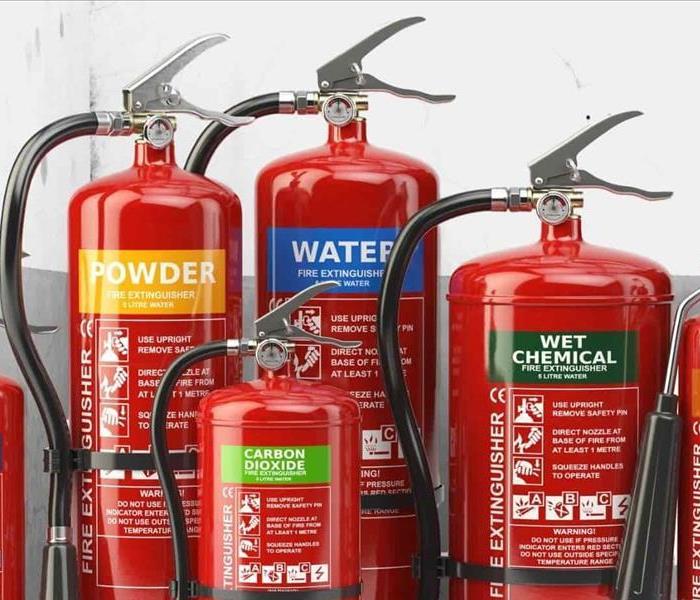 Choosing the right fire extinguisher
Choosing the right fire extinguisher
Here's a tip... Choosing the appropriate Fire Extinguisher
Class A:
This is the most common extinguisher and can be used to put out fires in ordinary combustibles such as cloth, wood, rubber, paper and many plastics.
Class B:
Used on fires involving flammable liquids such as grease, gasoline and oil.
Class C:
Designed for fires involving appliances, tools or other equipment electrically energized or plugged in.
Class D:
For use on flammable metals; often specific for the type of metal in question. These are typically found only in factories working with these metals.
Class K:
Intended for use on fires that involve vegetable oils, animal oils or fats in cooking appliances. These extinguishers are generally found in commercial kitchens, but are becoming more popular in the residential market for use in kitchens.
SERVPRO of Virginia Beach is quietly taking to the streets, every hour of every day, proving that whenever there is a house full of water or an office full of smoke, there is a van full of clean! It's always best to call our office directly! 757-431-1400
Water Damage Do's and Don'ts
4/4/2022 (Permalink)
Experiencing a water damage is no fun. The Key to avoiding costly future restoration is to handle every water problem as a real threat to your property. SERVPRO of Virginia Beach has the equipment, training, and experience to find and dry unseen water before secondary damages occur. When time matters, technology, and equipment and experience must be counted on to perform. Here are some Do’s and Don’ts to help you until help arrives.
STOP the source of water.
REMOVE as much excess water as possible by mopping or blotting.
WIPE excess water from wood furnishings after removing any contents lying on the surface.
Clearly designate wet area with floor signs and safety tape.
Pad or block wood furniture to prevent permanent staining of carpet.
Carefully remove colored items in affected areas, especially those in contact with carpet and upholstery
Remove and prop wet upholstery and pillow cushions for even drying
Isolate areas where sewer or black water exposure has occurred
Be aware of potential electrical hazards. DO NOT attempt to vacuum up water with standard vacuum equipment.
DO NOT turn on Ceiling fans or light fixtures is ceiling is wet. Avoid standing beneath sagging ceilings.
It is always best to rely on the professionals at SERVPRO of Virginia Beach. It is always best to call us directly at 757-431-1400
Spring Cleaning
3/8/2022 (Permalink)
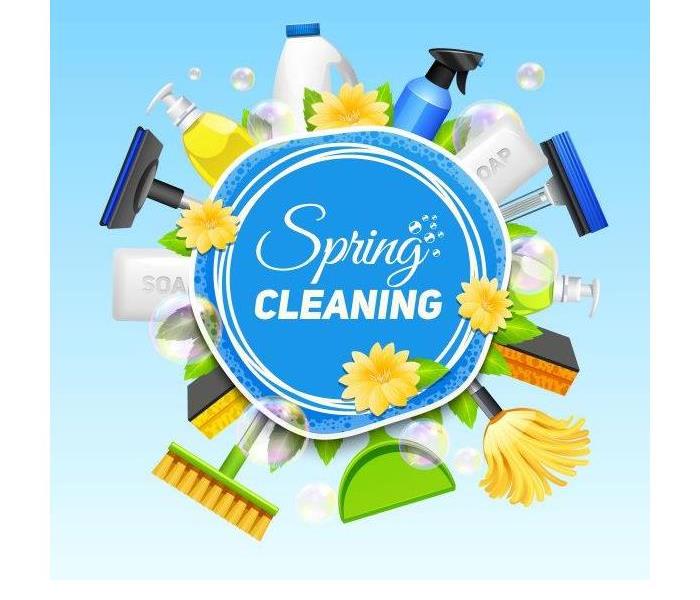 Spring cleaning collage
Spring cleaning collage
Spring is in the air! The first day of Spring is Sunday March 20th! Spring cleaning can be a little overwhelming, so we decided to create a check list to get you started on your spring cleaning!
ENTIRE HOME
- Change smoke alarm Batteries
- Clean/polish fixtures
- Clean mirrors and glass
- Clean rugs, floors & baseboards
- Dust/ polish furniture
- Dust bookshelves; donate books
- Dust light fixtures & bulbs
- Replace old light bulbs
- Wipe walls and ceilings
- Wash curtains
- Wash light fixtures/ ceiling fans
- Wash Windows
OUTSIDE
- Clean Garage
- Clean gutters
- Clean house siding
- Clean patio furniture
- Clean porch/deck/patio
- Landscaping
- Seal driveway
- Wash/inspect light fixtures
BEDROOMS
- Clean out closets & donate
- Put away winter bedding
- Rotate mattress
- Wash Bedding
LIVING ROOM
- Clean garage
- Clean gutters
BATHROOMS
- Clean & sanitize sink
- Clean & sanitize tubs, shower & toilet
- Clean out Medicine Cabinet
- Clean under the sink
- Dispose of expired medications
KITCHEN
- Clean oven
- Clean appliances (inside & out)
- Clean pantry, toss old food
- Polish Stainless-steel appliances
- Wash Cabinets (inside &out)
- Clean refrigerator/ freezer
As always, If you are looking for a deep, professional cleaning of your home or business, give SERVPRO Of Virginia Beach a call, remember it is ALWAYS best to call directly 757-431-1400. Aways Here to Help!
Spring is in the air, the first day of Spring is Sunday March 20th! Spring cleaning can be a little overwhelming, so we decided to create a check list to get you started on your spring cleaning!
ENTIRE HOME
- Change smoke alarm Batteries
- Clean/polish fixtures
- Clean mirrors and glass
- Clean rugs, floors & baseboards
- Dust/ polish furniture
- Dust bookshelves; donate books
- Dust light fixtures & bulbs
- Replace old light bulbs
- Wipe walls and ceilings
- Wash curtains
- Wash light fixtures/ ceiling fans
- Wash Windows
OUTSIDE
- Clean Garage
- Clean gutters
- Clean house siding
- Clean patio furniture
- Clean porch/deck/patio
- Landscaping
- Seal driveway
- Wash/inspect light fixtures
BEDROOMS
- Clean out closets & donate
- Put away winter bedding
- Rotate mattress
- Wash Bedding
LIVING ROOM
- Clean garage
- Clean gutters
BATHROOMS
- Clean & sanitize sink
- Clean & sanitize tubs, shower & toilet
- Clean out Medicine Cabinet
- Clean under the sink
- Dispose of expired medications
KITCHEN
- Clean oven
- Clean appliances (inside & out)
- Clean pantry, toss old food
- Polish Stainless-steel appliances
- Wash Cabinets (inside &out)
- Clean refrigerator/ freezer
As always, If you are looking for a deep, professional cleaning of your home or business, give SERVPRO Of Virginia Beach a call, remember it is ALWAYS best to call directly 757-431-1400. Aways Here to Help!
How SERVPRO of Virginia Beach Saves Damaged Documents
2/7/2022 (Permalink)
Fire and water damage can not only affect the structure of your property but also your belongings. SERVPRO of Virginia Beach specializes in restoring contents damaged by water, fire, or mold. Our expertise and “restore” versus “replace” mentality can help save you money while preserving precious keepsakes, furnishings and clothing that can’t be replaced.
If your home requires extensive restoration or cleaning due to fire damage, SERVPRO of Virginia Beach can conduct an organized, efficient move-out of the affected area. Each item is carefully packed up and transported to our facility for cleaning. We use several methods of cleaning your contents: dry cleaning, used for cleaning light residues or to pre-clean prior to wet cleaning; wet cleaning, an effective cleaning method for removing moderate to heavy residues; spray and wipe, effective for items that can’t withstand wet cleaning; foam cleaning, used for upholstery fabrics that might shrink or bleed if wet cleaned; abrasive cleaning, involves agitation of the surface being cleaned and emersion cleaning, where contents are dipped into a bath of the cleaning product.
After cleaning, we meticulously re-wrap the contents in fresh packing material and place them in new boxes, which are stored, until building restoration is completed.
Five Things That You Need To Know About a Water Damage.
2/7/2022 (Permalink)
When a pipe bursts, a drain backs up, or a flood occurs in your home, it can be hard to see past the mess. A million questions will run through your mind.
There is no doubt about it. Water damage is extremely stressful, and the more you know about it, the better you will be able to decide how to address it. Here are five things that every homeowner needs to know about water damage.
- There are different insurance policies for flood damage and water damage.
You might think that water is water, whether it is from flooding or a burst pipe, but flood damage is not covered under homeowner’s insurance. If you live in an area likely to experience flooding, you will probably already have a separate policy through the National Flood Insurance Policy (NFIP). When you report the claim to the insurance company, make sure to specify whether the claim is for water damage or for flood damage, so they can begin adjusting your claim correctly.
- Not all water damage is covered by your insurance.
It is a good idea to look over your insurance policy and familiarize yourself with any exclusion to your water damage coverage. For instance, most policies cover sudden damage, like water damage from a really bad storm or from an overflowing washing machine. On the other hand, any water damage that happens because you didn’t maintain the property may be excluded, as well as gradual leaks that caused water damage over time.
- Once water damage has happened; the clock is ticking before it gets worse.
When your property has been water damaged, you don’t have the luxury of waiting around for a convenient time to start the cleanup. Secondary damage from mold growth can present serious health effects associated with mold in the living environment.
Mold spores are everywhere, but they need moisture and a nutrient source to grow. And that is exactly what your wet carpet or drywall offers.
To prevent mold growth, you will need to get your property completely dry again within that 24-48-hour window. To do this, you will need to contact a company that specializes in water damage restoration and emergency water extraction. They will have the professional water removal equipment and drying equipment to get the job done as quickly as possible. Many have 24-hour a day emergency hotline, so you can start recovering your property almost immediately.
- Your insurance company needs to know right away.
It is a good idea to call your insurance company right away when you discover water damage. Your insurance agent can start the claims process immediately, as well as guide you through the first steps you will need to take to protect your property from more damage, like stopping the source of the water at the main water turnoff.
- The pollution level of the water is important.
Water damage is categorized as one of three levels by how polluted the water source was that caused the damage.
Category 1: Water from a clean water source, like a freshwater line for a dishwasher. This water will not cause illness or any ill effects.
Category 2: Water that may cause illness through contact. It may have bacteria in it,
Even though water may start out as Category 1, that doesn’t mean it will stay that way. Any contamination that the water touches, such as dirty carpeting or soil from the ground, can change water damage Category to 2 or even Category 3. And since standing breeds bacteria, the longer the water is around, the worse the contamination of your property.
More contamination can mean that the restoration team will have to use more aggressive measures to clean your structure and property, and it might mean that soft furnishings, like your carpet and the carpet pad, may have to be discarded for your safety.
Water damage can be dangerous and expensive, so preventing water damage is an important part of home maintenance. But if you know the basics of what to do once it happens, you can prevent it from doing its worst.
SERVPRO of Virginia Beach is always here to help, it is always best to call us directly at 757-544-6027.
Don't Turn The Drying Equipment Off!!
2/7/2022 (Permalink)
 This is an air mover that could be placed in your home for drying after a water damage.
This is an air mover that could be placed in your home for drying after a water damage.
When you call SERVPRO of Virginia Beach to help restore your property after suffering a water damage, our professional technicians will place the appropriate equipment to dry out the area as quickly as possible. It is important to always follow our instructions and keep the equipment running at all times. We realize that the equipment is noisy and can become bothersome if you remain in your home during the restoration process, however, turning off the air movers and/or dehumidifiers can delay the drying time and can cause further damage to your property such as mold growth. It is also important to note that oftentimes your insurance coverage will only pay for the drying equipment for a specific length of time, depending on the category of damage. Your SERVPRO of Virginia Beach project manager will monitor the moisture readings of the equipment daily to determine the appropriate time for removal. If you have any concerns or questions about the drying equipment, be sure to speak to any of our crew members.
SERVPRO of Virginia Beach Additional Services
2/3/2022 (Permalink)
Let’s be honest, there is never a good time for storm waters to flood your property or fire to smoke out your home or business. It seems that Disasters strike at the worst possible moment. That is one reason to have our phone number, 757-431-1400, saved in your phone.
Timely and efficient mitigation is the key to reducing costs and minimizing home or business interruption. The sooner restoration and cleanup begins, the sooner you and your family or business can resume your everyday lives.
That is why it is important to choose a team with the capabilities, like SERVPRO of Virginia Beach, to help make any size disaster, “Like it never even happened.”
The Benefits of Using SERVPRO of Virginia Beach
*Class "A" Licensed Contractor
*24 Hour Competitive Bids
*Drug Free Workplace with Criminal Background Checks
*IICRC Certified Firm & IICRC Certified Team
*Onsite Climate Controlled Storage Facilities
*Large Loss/Storm Team Member
*Repair Division
*Three Day average Dry time.
That is just a sample of our services, if you have any questions or would like more information do not hesitate to call SERVPRO of Virginia Beach at 757-431-1400
SERVPRO Emergency Ready Profile, Why Is It Important?
2/3/2022 (Permalink)
SERVPRO of Virginia Beach has 30 years of experience in restoring property damaged by fire, water & smoke. During those years, we have discovered that businesses that do not have an emergency plan in place, prior to a disaster, sustain much greater losses due in large part to the additional time it takes them to react and take proper emergency steps to mitigate damage after a loss has occurred.
The degree of damage not only increases with the length of time it takes to react, but dollars lost due to business interruptions also increase very rapidly. As many as 50% of businesses may never recover following a disaster, according to the latest industry research. Of the businesses that do survive, many of them had a preparedness plan in place. Pre-planning can serve as an insurance policy aimed at giving you peace of mind.
By developing a SERVPRO Emergency Ready Profile for your business, you minimize business interruption by having an immediate plan of action. Knowing what to do, who to call and what to expect in advance is the key to timely mitigation and can help minimize the affects water and fire damage can have on your business.
The SERVPRO Emergency Ready Profile offers:
- A no cost assessment of your facility
- A concise Profile Document that contains only the critical information needed in the event of an emergency
- A guide to help you get back into your building following a disaster
- Establishes SERVPRO of Virginia Beach as your disaster mitigation and restoration provider
- Identification of the line of command for authorizing work to begin
- Facility details such as shut-off valve locations, priority areas and priority contact information
Give SERVPRO of Virginia Beach a call at 757-431-1400 to schedule yours now.
SERVPRO of Virginia Beach spotlight, Anna Cheracles
2/2/2022 (Permalink)
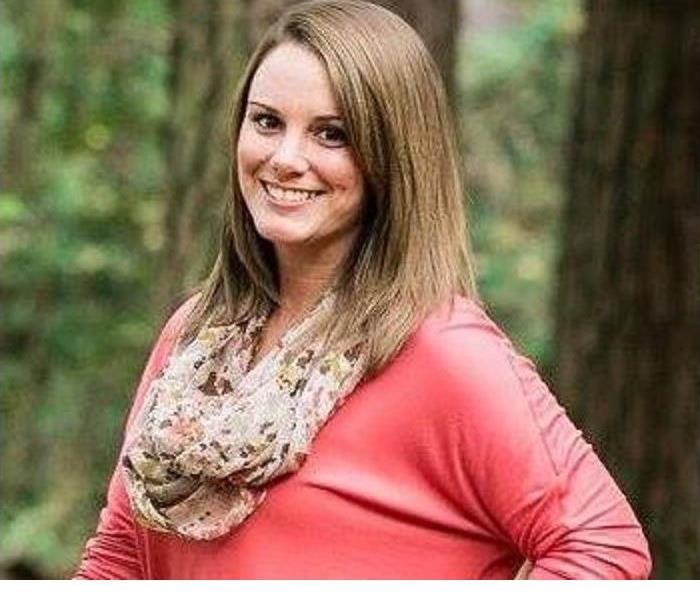 Owner of SERVPRO of Virginia Beach
Owner of SERVPRO of Virginia Beach
As a second-generation owner, Anna has held almost every position within the company since she began working at SERVPRO of Virginia Beach. Before SERVPRO, Anna attended Old Dominion University, had a few jobs between high school and college, including managing a couple local tanning salons, while working part time at SERVPRO until 2007, when she came on board full time to learn how to run the business.
Anna is currently running the franchise as an owner, alongside her sister, Katie Anderton and husband Jason Cheracles. Together they have grown the business with a wonderful culture consisting of their office team, a phenomenal marketing division and amazing production team of extremely hard-working technicians and managers.
Anna says, “Each and every person serves a very important role in making sure that our SERVPRO franchise is successful. From the very first phone call into the office about a new loss, to the production technician performing the work and all the way to the accounts receivable team collecting the money at the end and leaving us with a happy and 100% satisfied customer. Our customers don’t ask for these water/fire/mold losses to occur, so we do our best to put their lives and homes back together as quickly and effectively as possible, while trying to make a bad experience a less stressful one. It’s a hard job, but by having the right, positive people on our team, we make it work.”
Anna learned everything show knows from her parents, Bob and Beth Simeone, who started the Virginia Beach franchise in 1991. She has grown up in the business and enjoys seeing how her team helps people each and every day. Anna’s interest is not only on the customers, but on the employees as well. It has been fun for her to see so many people grow into their career and personal lives while they are working with the SERVPRO family.
When not working at the office, Anna enjoys spending her time with her husband Jason, and their three children: Ray, Maddox and Charlee, and their three dogs, Bella, Molly and Willow.
At the end of the day, Anna loves that her family gets to work together every day. They get to share in each other’s successes and build a company together that truly believes in their mission statement, which is “to develop an accountable team of caring people who are committed to excellence and focus on quality service by being honest, fair and enthusiastic in their work.” By following this mission statement, SERVPRO of Virginia Beach has been able to build an incredible team of individuals that care about the work they do, the customers that are impacted by them everyday.
Dryer Fire- Don't Be a Victim.
1/7/2022 (Permalink)
An electric or gas clothes dryer is nearly an essential part of life in most homes. In families with children, the laundry can seem a daunting task, going on forever with washing machines and dryers churning and turning away slowly at a never-ending mountain of laundry.
But, all that convenience carries with it the possibility of a deadly hazard -- a dryer fire -- the leading cause of home fires in this country at the rate of about 15,000 every year.
*Don't dry dangerously*
While today's clothes dryer is in itself a safe piece of machinery and a feat of modern technology, it isn't fail-safe and requires regular preventive maintenance to prevent fires that could start in your lint trap or anywhere within your dryer's venting.
When lint traps aren't cleaned as often as they should be, the resulting build-up in the screen or other areas can cause the dryer to perform poorly, operate at elevated temperatures and possibly overheat -- with dangerous consequences. Vent systems must also be checked and cleaned to maintain proper air flow for the same reasons.
Problems may also occur if consumers place improper items in their dryers, such as foam backed rugs or athletic shoes, or vent their appliances with plastic or vinyl exhaust materials. Make sure that whatever you put in your dryer is approved and safe to place in a dryer. When in doubt, check the washing instructions on the tag of the clothing or consult the manufacturers website for more information.
Please follow these useful tips to avoid a dryer fire. In the unfortunate event that you encounter a dryer fire and the damage left in its wake, please call us at SERVPRO of Virginia Beach and we can make it "Like it never even happened."
757-431-1400
It' s always best to call us directly
How To Prepare for Winter Weather, Avoid Frozen Pipes!
1/7/2022 (Permalink)
As seasons change, so do property owners preparation checklists. With winter weather upon us, it is important for homeowners and property managers to do everything they can do to reduce risks of costly water damage caused by frozen pipes.
When water freezes, it expands. That’s why a can of soda explodes if it’s put into a freezer to chill quickly and then forgotten. When water freezes in a pipe, it expands the same way. If it expands enough, the pipe bursts and water escapes leaving serious damage as a result.
Pipes in attics, crawlspaces, and outside walls are all vulnerable to freezing, especially if there are cracks or openings that allow the cold, outside air to flow across the pipes. Holes in an outside wall where television, cable or telephone lines enter can provide access for cold air to reach pipes.
The Red Cross warns that pipe freezing is likely to occur after consecutive days and nights of freezing (32 degrees) or below conditions. Taking the following precautions ahead of time can help you prevent potential pipe catastrophes:
- Keep a slow trickle of water flowing through faucets, especially if the pipes for faucets run through unheated or uninsulated areas of your home. Allowing cold water to trickle from a faucet can alleviate pressure and prevent a rupture even if freezing occurs.
- If a vacant home, keep the temperature above 65 degrees.
- Cap outdoor water fixtures. By placing a cover on outdoor spigots and faucets, it reduces the possibility these fixtures build up with ice.
- Keep cabinet doors open during cold spells. This allows warm air to circulate around pipes.
If you have done nothing to prevent frozen pipes and you have water leaking or you have no water pressure, it likely means your pipes have burst. According to State Farm Insurance, this happens to more than 50 million families each year in the United States. If a pipe has even 1/8” crack, it can release 250 gallons of water a day.
You must act fast to prevent further, and more costly damage.
- This first step is to always shut down your property’s main water supply. (Depending on the amount of water and location, you may want to first turn off electricity.)
- If it’s heated water that’s coming from the broken pipe, you should also close the valve attached to your hot water heater.
- After you’ve shut down the water, call a plumber for help with repairing or replacing the burst pipe.
Make SERVPRO of Virginia Beach your first call to help you and your local insurance agent assess the damage. We will work for you to restore your property and your life to make it "Like it never happened."
Frozen Pipe Prevention
1/5/2022 (Permalink)
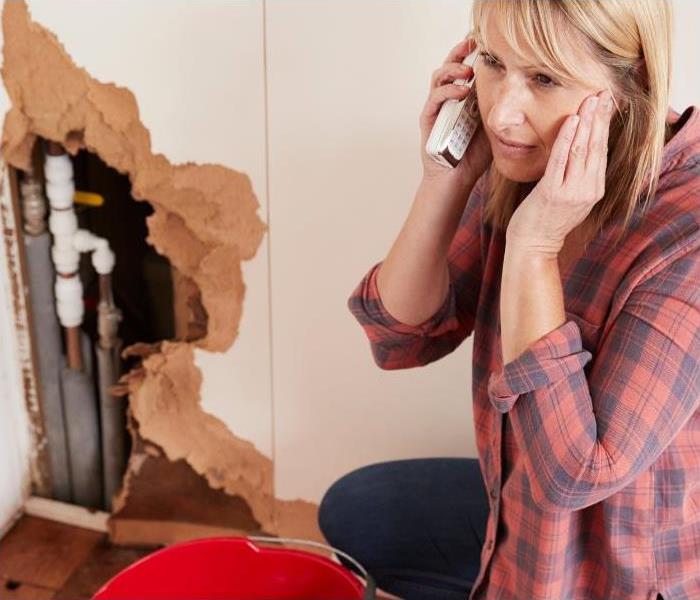 to help clean up after a water damage.
to help clean up after a water damage.
When you think of winter weather you probably think of school closings, slippery roads and a driveway to shovel. Winter weather can cause a lot more issues then those listed above. If we have below freezing temperatures for 3 days in a row you are at risk for frozen pipes, which can create a major disaster at your home or office.
Typically, frozen pipes are the ones exposed to the cold weather such as basements, attics, garages, and kitchen cabinets. A frozen pipe will usually rupture because of the backflow pressure between the blockage and the water source; this can cause catastrophic damage to your home and office if not addressed quickly.
According to the American Red Cross there several steps you can take to prevent your pipes from freezing:
- Keep your heat set both day and night
- Be sure to completely drain the water from sprinkler lines as well as outside hoses
- Open your kitchen cabinets to let the warm air to circulate near the pipes
- When weather is extremely cold, let water drip from your exposed faucets
If you experience water damage from frozen pipes, call SERVPRO of Virginia Beach at 757-431-1400
SNOW What?
1/5/2022 (Permalink)
Snow is a lot like liver and onions. You either love it or hate it. After Mondays SNOW event paralyzed vehicles for 48 miles south of Washington, leaving hundreds of motorists stranded — many for more than 24 hours without food or water while temps dropped into the teens then chances are that, you hate the fact that you weren't prepared for it, or love that you are.
S'now what...
Mother nature can be a real beast. In fact, she's a killer. And when it comes to a snow event, the best idea for safety is to stay off the roads and keep warm and safe at home. However, that isn't always possible. When you find that you must venture out on snowy and icy roads, you know to stay alert, drive a little slower, brake according to road conditions... But what if your vehicle breaks down or gets stuck and you must wait for help in a disabled vehicle in dangerously cold, wet weather?
SERVPRO of Virginia Beach wants you to be prepared in the face of any hazard that may cross your path, whether flood, fire or treacherous travel conditions.
Please take a moment to look at the list (below) of suggested items to keep in your vehicle. Just a little bit of preparation can keep a little emergency from becoming a catastrophe.
Stay warm and carry on! And tune in to AM 1310 on radio to stay alert to the latest weather conditions.
SERVPRO of Virginia Beach
757-431-1400
It's always best to call us directly
Keep These Things in Your Vehicle
Cell phone
Car charger
LED flashlight
Bag of rock salt
Shovel
Wool blankets/one for each passenger
Ice scraper
Leatherman or Swiss Army knife
Jumper cables
Two quarts of oil
Extra fuses
Fix-a-Flat
Paper towels
First aid kit
Prescription and OTC medications
Winter boots, scarves, hats and heavy winter clothes for each passenger
Water
Snack bars
Toilet paper
Music/games for young passengers
Five Things To Do After A House Fire
1/4/2022 (Permalink)
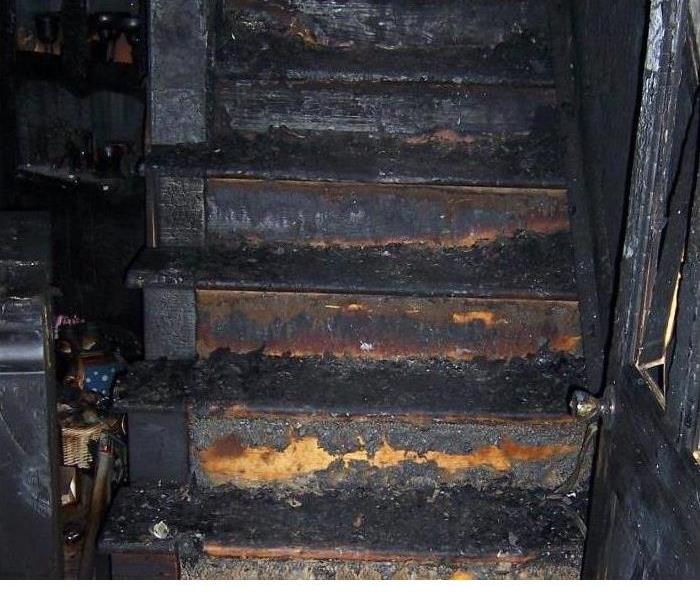 aftermath of a house fire
aftermath of a house fire
A house fire is traumatic event that can certainly leave you with a mix of emotions. You’ll be nervous, worried, scared, upset, wondering what to do next, and just how to do it. First things first…take a deep breath, try to relax, and know that everything will be more than fine. Ultimately you need to make sure that your family is safe and sound. Once you can confirm that, then you can tackle the recovery process of your home and belongings.
We’ve compiled a list of five things that you should do and be aware of after a fire. This way, you can approach the rebuilding of your home in a cool, calm, and collected manner!
(1) Review with the authorities and the professionals as to when it is safe to enter the home after the fire. The fire department will make sure that the fire is completely extinguished and then will go through their precautionary measures in order to deem the area ‘safe’.
(2) Know who to contact. First, contact any family members to let them know of the occurrence and the fact that you are safe. Review, and then contact your insurance company. A clean-up team, such as G.W.Savage, should also be one of the first calls made. We can efficiently and professionally get you back into your home – it will be as if nothing happened!
(3) Get the fire report. Typically coming to you from the fire department, this correspondence will review the facts of the fire – the home structure, the area of the fire, as well as the time and date. In some cities and towns, you may need to call the fire department directly in order to get a copy of this report.
(4) Make sure to secure your property. If you are not securing the property, you could potentially be making a bad situation into a terrible one – your home could be robbed of it’s remaining property, or, in some cases, another individual could be injured on the property (becoming your responsibility). You can ask the authorities and emergency services on the best methods in securing what is yours.
(5) Begin the clean-up process. Interior and exterior clean-up will most certainly be required, and more often than not there is damage that you cannot locate with the naked eye. That said, you should definitely hire a professional service like SERVPRO to do a thorough cleaning of all areas and of all soot, smoke, and odor.
Call us at 757-431-1400
Holiday Fire Safety in Virginia Beach
12/8/2021 (Permalink)
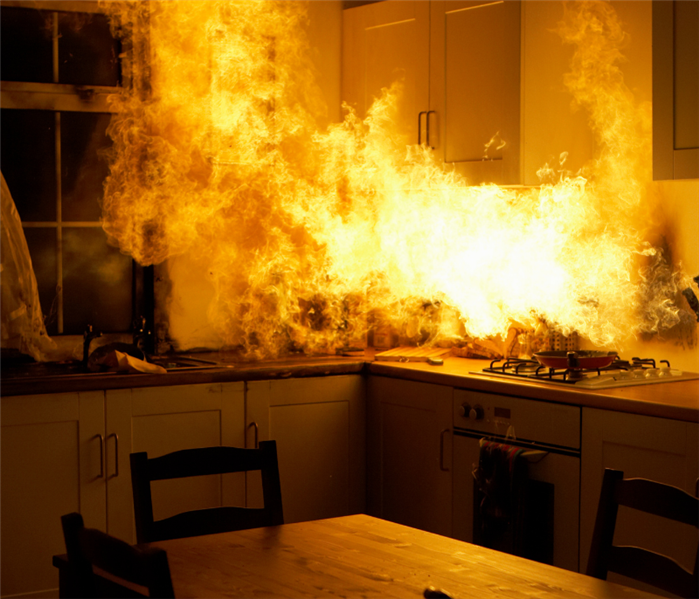 Cooking equipment is the leading cause of residential fires.
Cooking equipment is the leading cause of residential fires.
Cooking equipment is the leading cause of residential fires. During this time of year, you will find that you are using your cooking equipment more often while hosting family and friends, and fire precautions should be top of mind.
You may experience a flood of emotions if a fire damages your home or business. There might be fear, stress, and uncertainty about the future of the property. Here at SERVPRO of Virginia Beach, we have a restore not replace attitude and our number one goal is to get everything back to preloss condition. We strive not only to restore your property, but your piece of mind as well. If you experience a fire, the following tips may help reduce damage and increase chances of a successful restoration.
- Do not attempt to wash any walls or painted services.
- Limit movement in the home to prevent soot particles from being embedded into upholstery and carpet.
- If heat is off during winter, pour RV antifreeze in sinks, toilet bowls and holding tanks and tubs to avoid freezing pipes and fixtures.
- Wipe soot from chrome kitchen and bathroom faucets, trim, and appliances. Then protect these surfaces with a light coating of a lubricant.
- Tape double layers of cheesecloth over air registers to stop particles of soot from getting into the HVAC system.
After the first wave of heroes have secured the building, Call SERVPRO of Virginia Beach professionals and let us help make it “Like it never even happened.” 757-431-1400
Start the NEW YEAR off Right with an ERP
12/8/2021 (Permalink)
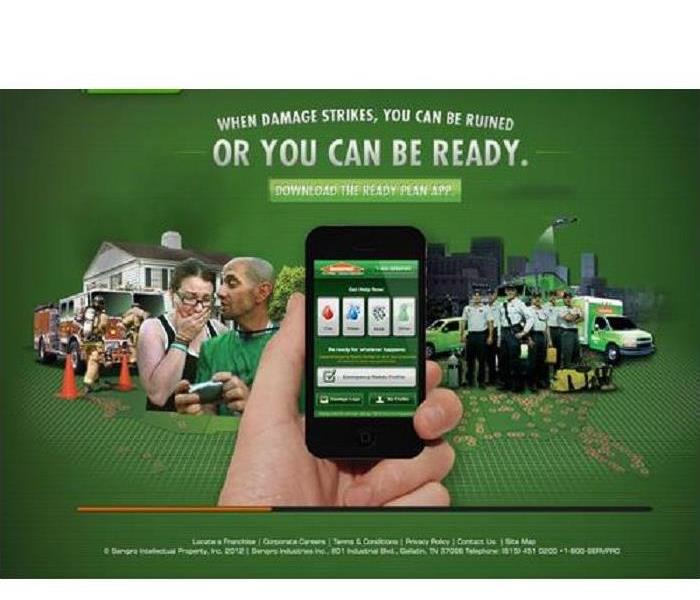 ERP
ERP
With 2021 coming to a close, SERVPRO of Virginia Beach would like to remind you about the advantages of the SERVPRO Emergency READY Profile
A no-cost assessment of your facility.
A concise profile that contains only the critical information needed in the event of an emergency.
A guide to help you get back into your building following a disaster.
Identification of the line of command for authorizing work to begin.
Provides facility details such as shut-off valve locations, priority areas and priority contact information.
Profile is viewable online or on your SERVPRO READY APP and is secured with a login and password.
Don't wait until a disaster strikes. Contact SERVPRO of Virginia Beach to establish your Emergency READY Profile.
It's always best to call us SERVPRO of Virginia Beach directly 757-431-1400
Make a plan to stay in business
12/8/2021 (Permalink)
 Make a plan and be prepared
Make a plan and be prepared
As a business owner or manager, you are a leader in your community and have the opportunity to set an example for your employees, customers and community to follow. This September, join your community in preparing for emergencies and disasters of all types and leading efforts to encourage the community as a whole to become more prepared.
It can happen... Disasters not only devastate individuals and neighborhoods, but entire communities, including businesses of all sizes. As an employer in your community, having a business continuity plan can help protect your company, its employees, and its infrastructure, and maximizes your chances of recovery after an emergency or disaster.
Ready Business asks companies to take three simple steps: plan to stay in business; encourage your people to become Ready and protect your investment. This year, the Ready Campaign and Citizen Corps, with support from Coalition Members across the nation, including a wide range of businesses and organizations, is focusing National Preparedness month (NPM) on encouraging individuals, families, and businesses to take active steps toward becoming Ready.
Ready Business, an extension of the Ready Campaign, helps business owners and managers of small and medium-sized businesses prepare their employees, operations and assets in the event of an emergency. The Business section of Ready.gov contains vital information for businesses on how to get started preparing their business and their unique needs during an emergency.
For more information on NPM, or for help preparing your business, call 1-800-BE-READY, 1-800-SE-LISTO, and TTY 1-800-462-7585 or visit Ready.gov/business where business owners can download or order free Ready information, publications, and much more. 1,2,3 - GO!
Recommended Items for a Basic Emergency Supply Kit:
- Water: one gallon per person per day
- Food, non-perishable 3-day supply
- Manual can opener
- Battery operated radio, preferably a NOAA Weather Radio with tone alert and extra batteries
- Flashlight and extra batteries
- First Aid kit Whistle to signal for help
- Clothing: Dust masks or bandanas
- Plastic sheeting, garbage bags
- Duct tape
- Wrench or pliers to turn off utilities, if necessary
- Local maps
- Hygiene items
- Important documents such as copies of insurance policies, identification and bank account information
- Cash
- Fire extinguisher
- Matches in a waterproof container
It's always best to call SERVPRO of Virginia Beach directly 757-431-1400
Knowing the Class of Your Fire Extinguisher in Virginia Beach
12/8/2021 (Permalink)
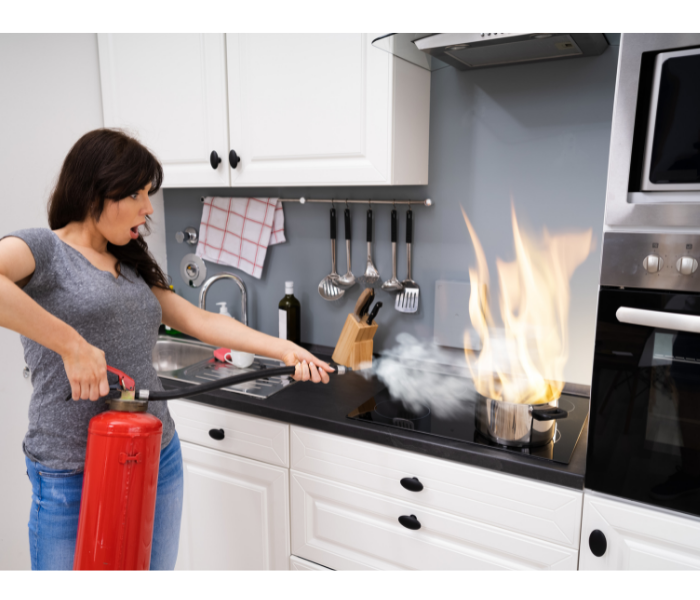 Knowing how to use a fire extinguisher can save your home.
Knowing how to use a fire extinguisher can save your home.
Understanding Fire Extinguisher Classes
There are four classes of fire extinguishers – A, B, C and D – and each class can put out a different type of fire.
- Class A will put out fires in ordinary combustibles such as wood and paper
- Class B are for use on flammable liquids like grease, gasoline, and oil
- Class C are suitable for use only on electrically energized fires
- Class D are designed for use on flammable metals
Multipurpose extinguishers can be used on different types of fires and will be labeled with more than one class, like A-B, B-C or A-B-C.
Purchasing Your Fire Extinguisher
Now that you know how many extinguishers you need and what types to get, you can head to the hardware store. Look for fire extinguishers that you can easily lift. Larger extinguishers may pack more power, but you must be able to use it properly.
Learning How to Use Your Fire Extinguisher
Once you have made your purchases, familiarize yourself with the fire extinguisher directions so you will be prepared in case you need to put out a fire. Typically, fire extinguishers are easy to use in the case of a fire. Most of the types operate using the P.A.S.S. technique:
- P. Pull the pin on the fire extinguisher to break the tamper seal.
- A. Aim the fire extinguisher low, with the nozzle pointed at the base of the fire.
- S. Squeeze the handle of the fire extinguisher to release the extinguishing agent.
- S. Sweep the nozzle from side to side while pointed at the base of the fire until it is extinguished.
- If the fire re-ignites, repeat the last 3 steps.
SERVPRO of Virginia Beach professionals have the training and the equipment to make it "Like it never even happened." Give us a call at 757-431-1400.
How to prepare for winter weather and avoid water damage from FROZEN PIPES.
12/8/2021 (Permalink)
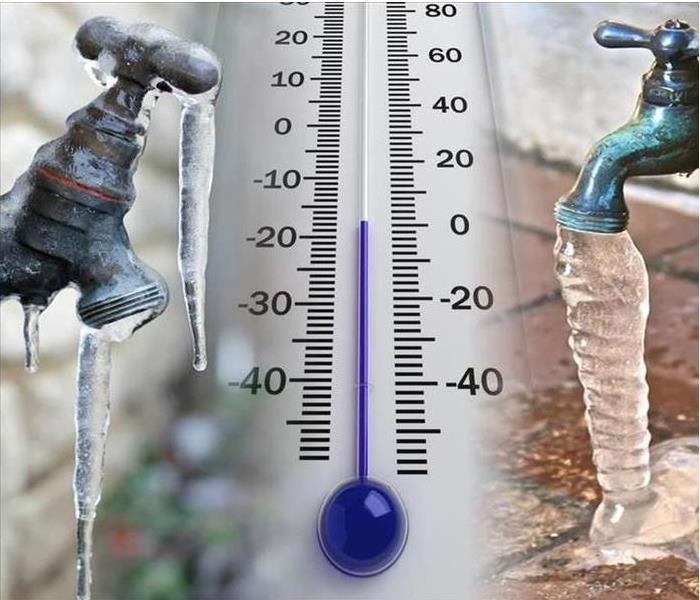 Winter weather worries
Winter weather worries
As seasons change, so do property owners preparation checklists. With winter weather upon us, it is important for homeowners and property managers to do everything they can do to reduce risks of costly water damage caused by frozen pipes.
When water freezes, it expands. That’s why a can of soda explodes if it’s put into a freezer to chill quickly and then forgotten. When water freezes in a pipe, it expands the same way. If it expands enough, the pipe bursts and water escapes leaving serious damage as a result.
Pipes in attics, crawlspaces, and outside walls are all vulnerable to freezing, especially if there are cracks or openings that allow the cold, outside air to flow across the pipes. Holes in an outside wall where television, cable or telephone lines enter can provide access for cold air to reach pipes.
The Red Cross warns that pipe freezing is likely to occur after consecutive days and nights of freezing (32 degrees) or below conditions. Taking the following precautions ahead of time can help you prevent potential pipe catastrophes:
- Keep a slow trickle of water flowing through faucets, especially if the pipes for faucets run through unheated or uninsulated areas of your home. Allowing cold water to trickle from a faucet can alleviate pressure and prevent a rupture even if freezing occurs.
- If a vacant home, keep the temperature above 65 degrees.
- Cap outdoor water fixtures. By placing a cover on outdoor spigots and faucets, it reduces the possibility these fixtures build up with ice.
- Keep cabinet doors open during cold spells. This allows warm air to circulate around pipes.
If you have done nothing to prevent frozen pipes and you have water leaking or you have no water pressure, it likely means your pipes have burst. According to State Farm Insurance, this happens to more than 50 million families each year in the United States. If a pipe has even 1/8” crack, it can release 250 gallons of water a day.
You must act fast to prevent further, and more costly damage.
- This first step is to always shut down your property’s main water supply. (Depending on the amount of water and location, you may want to first turn off electricity.)
- If it’s heated water that’s coming from the broken pipe, you should also close the valve attached to your hot water heater.
- After you’ve shut down the water, call a plumber for help with repairing or replacing the burst pipe.
Make SERVPRO of Virginia Beach your first call to help you and your local insurance agent assess the damage. We will work for you to restore your property and your life to make it "Like it never even happened."
Home Fires Are Preventable
12/8/2021 (Permalink)
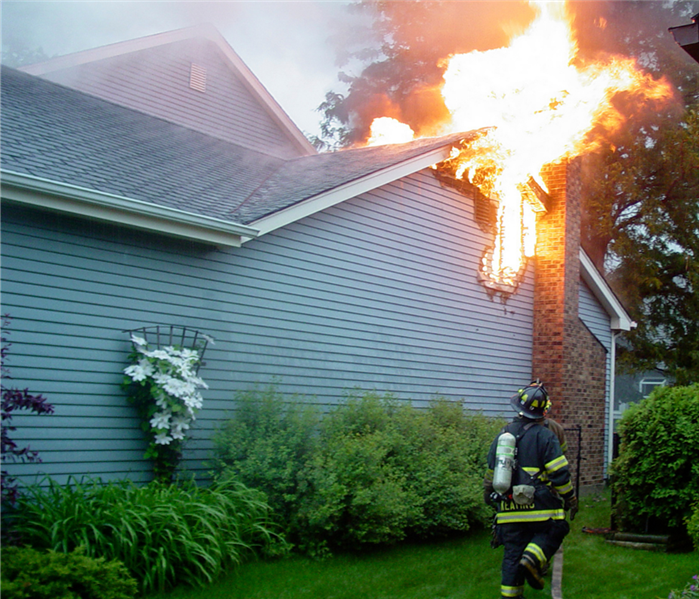 Home fires are preventable
Home fires are preventable
When it comes to your home or business there are certain safety precautions that can be taken to help to prevent fires. Ready.gov has provided the following tips on home fire prevention.
- Frayed wires can cause fires. You should replace all worn, old or damaged appliance cords as soon as possible. Do not run cords under rugs or furniture.
- Immediately shut off then replace light switches that are hot to the touch and all lights that flicker.
- This one seems more obvious, if you have a three-prong plug, use it only in a three-slot outlet. Never force it into a two-slot outlet or an extension cord
- Never leave candles unattended.
If you have a fireplace a woodstove they should be inspected annually. They should also be checked monthly for damage and or obstructions. You should use a fireplace screen heavy enough to stop rolling logs and big enough to cover the entire opening of the fireplace to catch flying sparks.
Make sure the fire is completely out before leaving the house or going to bed.
The professionals at SERVPRO of Virginia Beach have the training and equipment to help make it "Like it never even happened." Give us a call at 757-431-1400.
The Three Levels of Loss for Virginia Beach Businesses
12/8/2021 (Permalink)
 Virginia Beach commercial buildings
Virginia Beach commercial buildings
SERVPRO of Virginia Beach specializes in both residential and commercial losses. Similar to residential losses, commercial losses have a three-tier damage level that we access.
Level 1 is a small commercial loss involving 15,000 square feet or less of affected floor space. Examples of a small commercial loss may include a stand-alone store front, a small church, or a daycare facility. A Level 1 loss can also be a small portion of a much larger structure.
Level 2 is a medium commercial loss involving 15,000 to 60,000 square feet of affected floor space. They are typically multi-level or greatly divided spaces. Examples of a level 2 loss may include a small multi-family property, a midsize church, or a school. A Level 2 loss can also be just a portion of a much larger structure
Level 3 is a large commercial loss typically involving more than 60,000 square feet of affected floor space. The building or buildings involved will likely be large multi-level structures. Examples of a level 3 loss can include a large church, hospital, school, or university; a large multi-family property; or a large strip-style shopping center or shopping mall. This is the level at which it would be appropriate to refer to the project as a “large loss.”
Make SERVPRO of Virginia Beach your first call to help you or your business and your local insurance agent assess the damage. We will work for you to restore the property to make it "Like it never even happened." 757-431-1400
Virginia Beach commercial property cleaning
12/8/2021 (Permalink)
 Commercial Property Cleaning
Commercial Property Cleaning
As a business owner or facility manager, you do not have time to worry about the common wear and tear that gradually soils your office. When grime, odor and moisture challenges go beyond the scope of your regular janitorial staff, call in SERVPRO of Virginia Beach. Whether it’s removing an odor problem or deep cleaning carpets, you can rely on us to make your workspace look its very best. SERVPRO of Virginia Beach also offers disinfecting services designed to treat proactive, suspected, and positive COVID-19 contamination. We have the specialized training and products to get your property back to business. Our cleaning services include the following:
- Air Ducts and HVAC
- Biohazard
- Carpet and Upholstery
- Ceilings, Floors, and Walls
- Drapes and Blinds
- Odor Removal
- Sewage
- Trauma and Crime Scene
- Vandalism
- Disinfecting
SERVPRO of Virginia Beach has the resources to help you immediately. Give us a call at 757-431-1400 to schedule an estimate.
Roof Damage in Virginia Beach
11/22/2021 (Permalink)
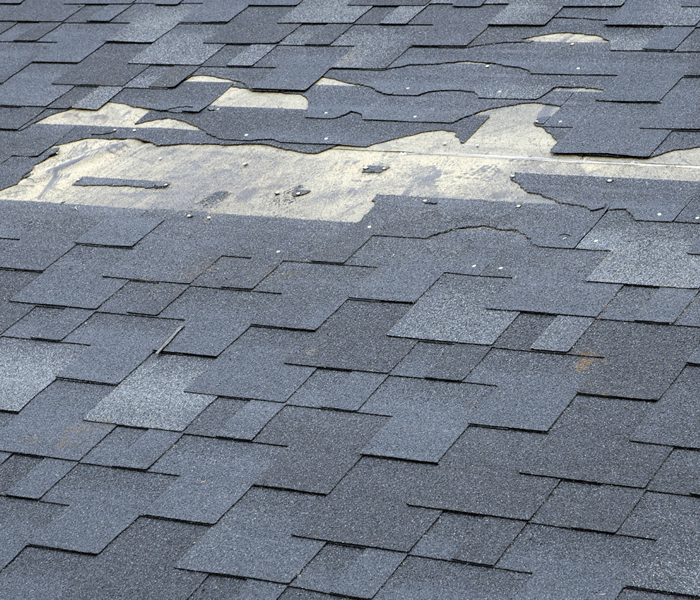 Strong winds can cause roof shingles to loosen or come off
Strong winds can cause roof shingles to loosen or come off
Virginia Beach roofs take a beating with destructive wind damage. Being on the coast means strong winds can kick up at a moment’s notice. If your roof has vulnerable spots, especially along edges and corners, strong winds can sneak under your shingles and blow them off. Once your shingles loosen, your roof is compromised.
To avoid wind damage, have your roof inspected and updated regularly. If you can, use impact-resistant materials. Also, keep the trees surrounding your home trimmed to prevent loose or dead branches from falling on or being blown onto your roof.
But what if a windstorm has blown shingles off your roof?
- Document the full extent of the damage. Do not clean up or make any temporary repairs.
- Call a roofing company or contractor to inspect the roof and get an estimate for repairs. If you aren’t sure who to use, contact your insurance adjuster for help finding a trusted contractor. Remember, you don’t have to take the first estimate you receive, so try different contractors if you’re not happy with the first estimate.
- Call your homeowner’s insurance company to report the damage and file a claim.
- Depending on the extent of the damage, contact a reliable company, like SERVPRO of Virginia Beach, to tarp your roof and prevent further damage.
If you find yourself in need of storm damage repair and cleanup, give SERVPRO of Virginia Beach a call at 757-431-1400. Representatives are available 24/7.
Before Winter Arrives. . . Don’t Let Pipes Freeze
11/22/2021 (Permalink)
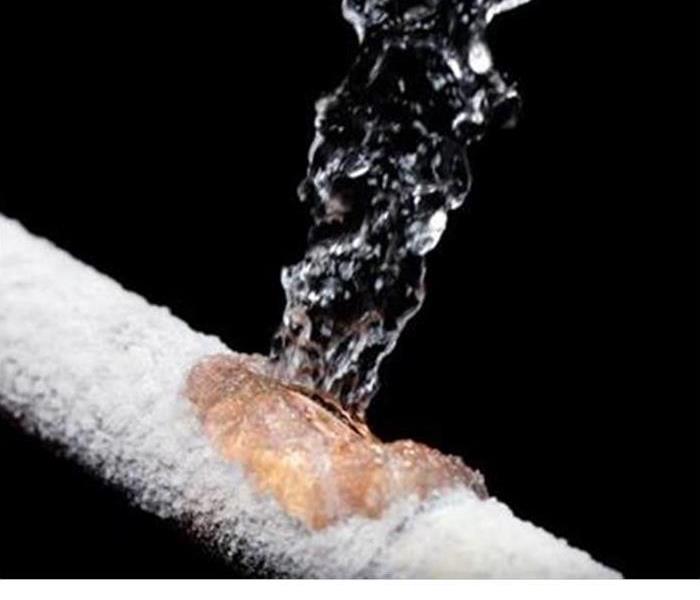 Winter weather and frozen pipe
Winter weather and frozen pipe
Before Winter Arrives. . . Don’t Let Pipes Freeze
A major home maintenance disaster is bad enough in itself, but when several disasters happen all at once, well that’s a nightmare. This is especially true when your water pipes freeze because not only do you have to call a plumber, but that crack in your pipe can spew up to 250 gallons of water a day, causing flood damage, serious structure damage, and the immediate potential for mold damage.
The causes of frozen pipes are quick and sudden drops in temperature, poor insulation, and thermostats that are set too low. Now is the time when the temps are warmer to prepare your home and here are a few preventive precaution steps.
- Insulate your pipes in your crawlspace and in your attic. Exposed pipes are vulnerable, and the more insulation, the better.
- Use approved and tested insulation products for use intended, either indoors or outdoors and make sure to follow the manufacturers’ instructions.
- Seal those leaks near or around the pipes. Electrical wiring outlets, dryer vents, and pipes can be caulked or insulated to keep out the cold air. The least little opening during severe cold weather can cause a pipe to freeze.
- Disconnect garden hoses before winter and if you can drain water from indoor pipes that lead to outside faucets and shut off the valve. This can help prevent that little bit of inside pipe from freezing.
- Keep cabinet doors open during cold spells. This allows warm air to circulate around the pipes
- Keep a slow trickle of water flowing through faucets, especially if the pipes for faucets run through unheated or uninsulated areas of your home.
SERVPRO of Virginia Beach is available 24 hours a day, 7 days a weeks should you need our services it is ALWAYS best to call us directly 757-431-1400
Steps To Protect Commercial Buildings From Wind Driven Rain
11/12/2021 (Permalink)
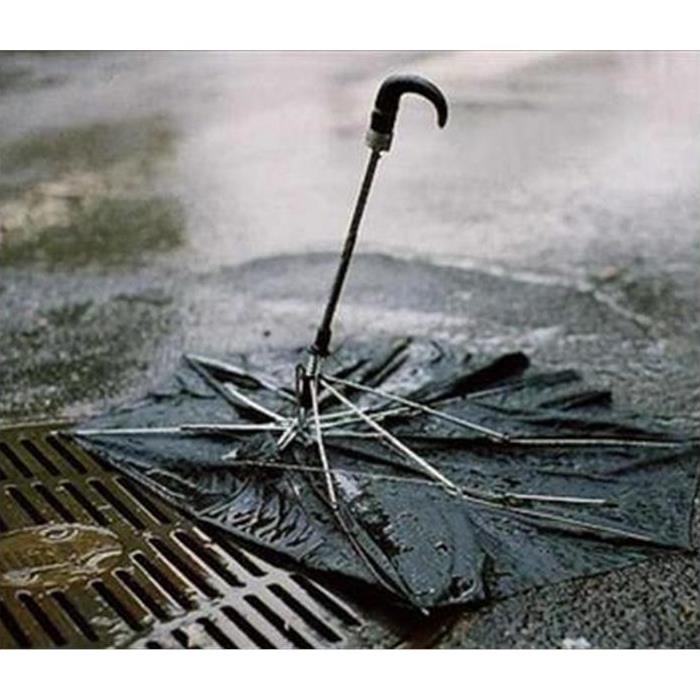 Wind driven rain
Wind driven rain
More than 60 percent of the United States is vulnerable to damage from high-wind events such as hurricanes, straight-line winds and severe thunderstorms that can produce high winds and heavy rains. Here in Hampton Roads, we are certainly susceptible to damage from strong winds and rain -- and, evidenced by recent weather events, it need not be hurricane season for us to take a wallop from wind.
Taking simple steps can make a big difference when it comes to reducing the damage caused by wind-driven rain.
Check for leaks around windows and doors, especially near corners.
Check for peeling paint, it can be a sign of water getting into the wood.
Inspect for discolorations in paint or caulking, swelling of the window or doorframe or surrounding materials.
Flashing, which is typically a thin metal strip found around doors, windows, thresholds, chimneys, and roofs, is designed to prevent water intrusion in spaces where two different building surfaces meet.
All vents, including gable vents, roof vents, and exhaust vents should be well anchored to the roof, flashed and sealed to prevent leaks.
And while the outside of the building may survive unscathed, inside water intrusion can soak documents, computers and other valuable supplies.
Water damage can threaten a business's ability to quickly bounce back after a storm. SERVPRO of Virginia Beach can help with cleanup to get your business back up and running and can assist you with future concerns by creating a plan. And it's a free service.
In addition to preparing the building against water damage, leaks can find their way in through any opening, it's important to plan for the worst before it happens. The IBHS suite of Open for Business® continuity planning and recovery tools can get you on the road to preparation. Should your building become damaged by a catastrophic event such as wind-driven rain, take appropriate actions to prevent further water damage once it is safe to do so. Water damage left unattended can result in structural failure or, potentially, mold growth. Here's what to do:
Remove standing water and all moist materials, such as wet, damaged flooring or rugs, carpet, personal property, stock, equipment or inventory, and consult SERVPRO of Virginia Beach determine the extent of the repairs necessary.
Board up damaged windows and doors.
After you have dealt with the immediate crises, contact your insurance agent to report the loss and let them know you'll be using SERVPRO of Virginia Beach for mitigation and restoration needs.
It is always best to call SERVPRO of Virginia Beach directly 757-431-1400
Winter Weather Happens in Virginia Beach
11/12/2021 (Permalink)
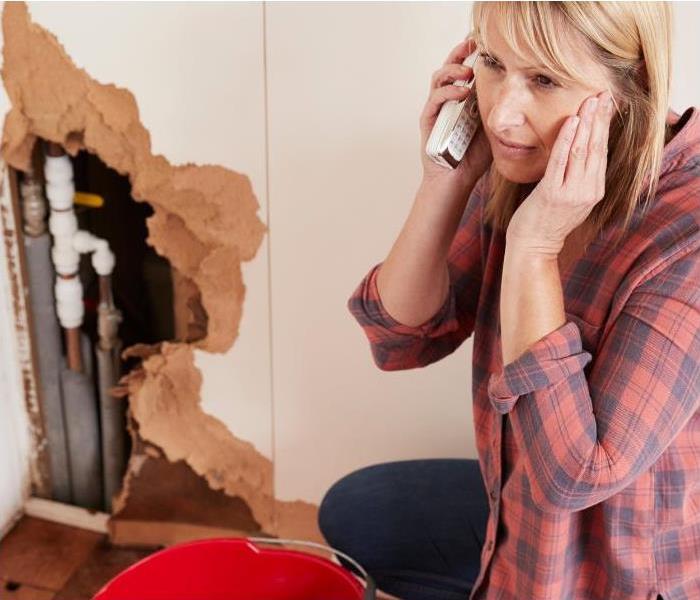 Call SERVPRO of Virginia Beach to help after frozen pipe damage.
Call SERVPRO of Virginia Beach to help after frozen pipe damage.
When you think of winter weather you probably think of school closings, slippery roads and a driveway to shovel. Winter weather can cause a lot more issues then those listed above. If we have below freezing temperatures for 3 days in a row you are at risk for frozen pipes, which can create a major disaster at your home or office.
Typically, frozen pipes are the ones exposed to the cold weather such as basements, attics, garages, and kitchen cabinets. A frozen pipe will usually rupture because of the backflow pressure between the blockage and the water source; this can cause catastrophic damage to your home and office if not addressed quickly.
According to the American Red Cross there several steps you can take to prevent your pipes from freezing:
- Keep your heat set both day and night
- Be sure to completely drain the water from sprinkler lines as well as outside hoses
- Open your kitchen cabinets to let the warm air to circulate near the pipes
- When weather is extremely cold, let water drip from your exposed faucets
If you experience water damage from frozen pipes, call SERVPRO of Virginia Beach at 757-431-1400 and let us make it "Like it never even happened."
Commercial Restoration Services
11/9/2021 (Permalink)
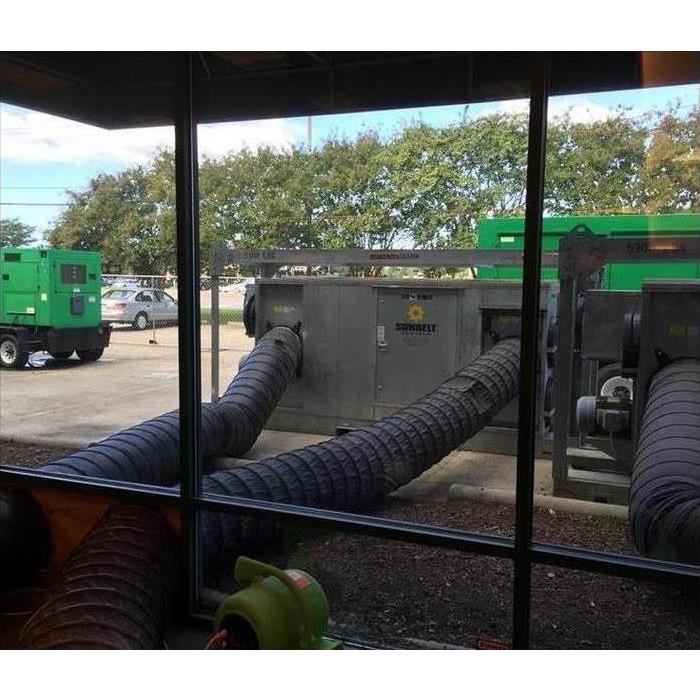 Commercial Water Damage-
Commercial Water Damage-
A commercial property is always at risk of being damaged by natural elements. If your business gets hit by a disaster, you’ll need a commercial restoration company with real-world experience and the resources to return your property to its normal state. SERVPRO Restoration has over years of experience in residential and commercial restoration services. Our team of experts offers:
- Commercial water damage restoration
- Commercial fire damage restoration
- Commercial mold damage restoration
- Commercial storm damage restoration
Our professionals have the training and equipment needed to restore your business after common issues with minimal interruption to your daily operations. SERVPRO also provides disaster planning to ensure that your property fortified in case future damage strikes.
At SERVPRO, we offer 24/7 commercial restoration and reconstruction services for damage caused by water, fire, smoke, mold, storms, and other disasters.
Why SERVPRO Commercial Restoration?
What makes SERVPRO Restoration different from other commercial restoration services? We offer multiple services through one point of contact. This means you only need one number to reach our reconstruction, emergency services mitigation, contents cleaning, training, insurance claims assistance, and disaster planning teams. You can depend on us for additional commercial damage services like cost savings, streamlined catastrophe planning, and minimized disruption.
SERVPRO has a longstanding heritage dedicated to innovation, resourcefulness, empathy, and outstanding customer service. Our franchise organization is proud to provide fast, high-quality cleanup and restoration services to both commercial and residential properties. We always put your property first at SERVPRO of Virginia Beach.
Call SERVPRO of Virginia Beach 757-431-1400
Responding to a devastating commercial fire
11/9/2021 (Permalink)
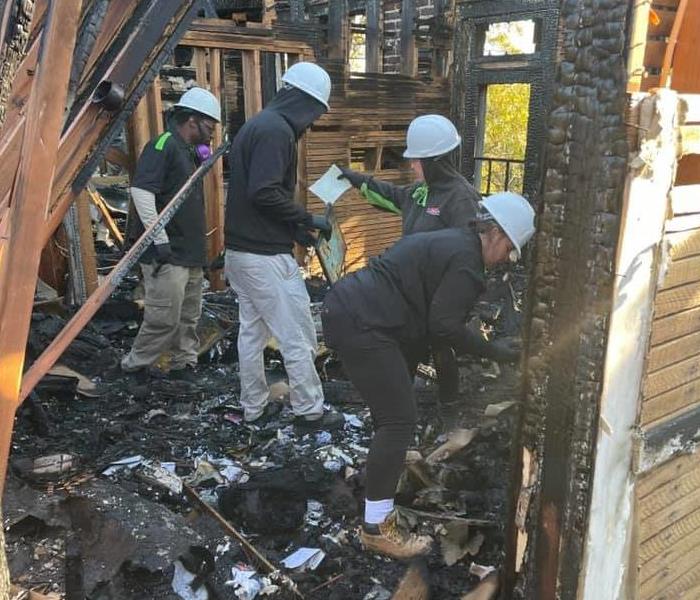 Crew members searching threw debris for displaced residents belongings
Crew members searching threw debris for displaced residents belongings
SERVPRO of Virginia Beach’s Large Loss Disaster Recovery Team has been activated to perform services after a three-alarm fire devastated a local 15-unit apartment building. Our team is all hands on deck, including the owner of SERVPRO of Virginia Beach, Anna Cheracles, who had this to say after seeing the devastation first hand
"Most of these tenants lost everything they have had their entire lives - photos, jewelry, antiques, special furniture from grandparents, even a pet. I have never been so proud of our team. We have spent the last two days searching high and low through literal rubble just to find important and sentimental items for them before we start demoing and drying the building. I don’t think there were many dry eyes. I’m so glad that we were entrusted with this project to help restore this historic building. This is why we do what we do. Also - if you don’t have renters insurance, you NEED it." Should you require our services please call us directly at 757-431-1400 we are HERE TO HELP
When Water Strikes in Virginia Beach
10/14/2021 (Permalink)
When Water Strikes in Virginia Beach
If you are looking to prevent damage to your home, staying ahead of water damage is crucial. Water damage leads to rotted wood, insect infestation, peeling paint and weakened roofs and siding, Mold or Mildew
Check for leaks and cracks where water can enter, such as windows and doors, especially around corners. Clean and caulk these leaks immediately. Look for broken shingles and cracks in exterior walls. Repair or replace any broken shingles that are allowing water in, seal all cracks and holes in your home’s foundation, joints, and exterior walls. Ceiling leaks can be dealt with by measuring the location of the leak from the nearest outside wall, then locating this point in the attic with a measuring tape.
Check your home for leaking faucets, sweating pipes, bad drainage systems, and clogged drains—all of these can lead to water leaking, pooling, and causing damage. Keep an eye on your water heater for signs of leaking water or rust. If you have a wood home, look out for termite damage. To prevent future leaks, install flashing around doors, windows, thresholds, chimneys, and roofs—it prevents water from penetrating places where two different building surfaces meet.
Maybe you are just dealing with a burst pipe, or worse yet you have a flooded basement. Regardless of how bad the initial damage is, you cannot afford to wait to start the water cleanup process. Within just a single hour up to a day after your home has been exposed to water, it will begin to cause damage. This is when drywall begins to bulge and break, furniture begins to swell and crack, and metal surfaces begin to tarnish
Water spreads very quickly and will get absorbed into the floors, the walls, your furniture, and other areas in your home. Once you have stopped the actual leak, you need to immediately start the process of water mitigation, which is the process of preventing or reducing the amount of water damage, to prevent additional damage so time is of the essence. If water damage persists for more than a week, mildew and mold growth, structural damage and biohazard contaminants may pose serious risks to you and your family. The delay in restoration time may also significantly increase the cost to repair water damage.
Do not hesitate to call SERVPRO of Virginia Beach at 757-431-1400 we strive to make it “Like it never even happened.”
It's the water you don't see that can be scary
10/8/2021 (Permalink)
It's The Water You Don't See...
Even small water damages have the potential to cause serious structural and indoor air quality issues over time.
The key to avoiding costly future restoration is to handle every water problem as a real threat to your property. The proper equipment makes a measurable difference in reducing the damage expense during a water loss. When time matters most, technology and equipment must be counted on to perform.
Here are a few tools used by Professional Restoration Contractors to properly mitigate a loss.
Moisture Sensors- used to detect moisture in carpets, baseboards, and walls.
Moisture Meters- used to determine the actual moisture content of various materials. The meter provides accurate readings to monitor the drying process.
Thermohydrometers- measures temperature and relative humidity to calculate and create an environment most conducive to drying. When handling a contaminated loss (CAT 2 or 3), it is not only important to dry the structure, but disinfect and often deodorize.
Ultra-Low-Volume (ULV) Foggers- used to atomize liquid deodorizing agents, producing a fine mist that can easily penetrate the site where odor-causing residues may accumulate. It can also be used to inject fungicides and disinfectants into wall cavities and other hard-to-reach areas.
Thermal Foggers- dispenses solvent-based products by creating a dense fog that consists of tiny particles of deodorant solution that attach to and neutralize odor causing particles.
The bottom line... ALWAYS treat a water damage seriously. Call a professional contractor that is trained and experienced in property damage restoration.
Call SERVPRO of Virginia Beach for any restoration needs you may have at 757-431-1400.
September is National Preparedness Month!
8/25/2021 (Permalink)
As a business owner or manager, you are a leader in your community and have the opportunity to set an example for your employees, customers and community to follow. This September 2021, join our community in preparing for emergencies and disasters of all types and leading efforts to encourage the community as a whole to become more prepared.
Disasters not only devastate individuals and neighborhoods, but entire communities, including businesses of all sizes. As an employer in your community, having a business continuity plan can help protect your company, its employees and its infrastructure, and maximizes your chances of recovery after an emergency or disaster. Ready Business asks companies to take three simple steps: plan to stay in business, encourage your people to become Ready and protect your investment.
This year, the Ready Campaign and Citizen Corps, with support from Coalition Members across the nation, including a wide range of businesses and organizations, is focusing National Preparedness Month (NPM) on encouraging individuals, families, and businesses to take active steps toward becoming Ready. We must work together as a team to ensure that our families, businesses, neighborhoods, and communities are Ready. Ready Business, an extension of the Ready Campaign, helps business owners and managers of small and medium-sized businesses prepare their employees, operations and assets in the event of an emergency. The Business section of Ready.gov contains vital information for businesses on how to get started preparing their business and their unique needs during an emergency. For more information on NPM, or for help preparing your business, call 1-800-BE-READY, 1- 888-SE-LISTO, and TTY 1-800-462-7585 or visit Ready.gov/business where business owners can download or order free Ready information, publications, and much more.
Choosing the appropriate Fire Extinguisher
6/16/2021 (Permalink)
Here's a tip... Choosing the appropriate Fire Extinguisher
Class A:
This is the most common extinguisher and can be used to put out fires in ordinary combustibles such as cloth, wood, rubber, paper and many plastics.
Class B:
Used on fires involving flammable liquids such as grease, gasoline and oil.
Class C:
Designed for fires involving appliances, tools or other equipment electrically energized or plugged in.
Class D:
For use on flammable metals; often specific for the type of metal in question. These are typically found only in factories working with these metals.
Class K:
Intended for use on fires that involve vegetable oils, animal oils or fats in cooking appliances. These extinguishers are generally found in commercial kitchens, but are becoming more popular in the residential market for use in kitchens.
SERVPRO of Virginia Beach is quietly taking to the streets, every hour of every day, proving that whenever there is a house full of water or an office full of smoke, there is a van full of clean! It's always best to call our office directly! 757-431-1400
Hurricane Preparedness
5/6/2021 (Permalink)
Hurricane season 2021 is predicted to be busier than normal, according to a forecast released from Colorado State University on Thursday.
CSU predicts 17 named storms, eight hurricanes, and four major hurricanes for the 2021 Atlantic season. This would be above the normal of 12 named storms, six hurricanes, and three major hurricanes. SERVPRO of Virginia Beach is urging everyone to “Resolve to be Ready” in 2021. Hurricane season starts June 1st and runs through November 30th. Now is the perfect time to think about making some preparations.
Preparing in advance to deal with the unexpected can make a world of difference in how quickly and completely we can put the pieces of their lives back together. We encourage all realtors, association managers and property owners to take advantage of the no-cost emergency planning tools available from the Federal Emergency Management Agency (FEMA) (www.ready.gov/publications)
Flood Insurance
The most important thing to consider for your home is flood insurance. A common misconception is that homes that are not in a flood zone are not eligible for such coverage. That is not the case. Any home can have a flood insurance policy. Insurance is sold through local agents as part of the National Flood Insurance Program, or NFIP. Homeowners can take out separate polices to insure the structure and any contents inside. Homes that are in a designated flood zone are required to have flood insurance, and it is typically a stipulation during the sale of a house. In fact, it is recommended that homes outside of a flood zone also have coverage, especially in coastal communities, like Hampton Roads. Nationally, about 30 % of flood insurance claims come from homes that are not in a flood zone. Premiums vary by numerous factors such as location, age of the dwelling and value of insured contents inside the home. For more information about the NFIP, please visit FEMA.gov/NFIP.
Know your Zone.
The state introduced “Know Your Zone” to simplify evacuation processes when it becomes necessary. There are four zones, lettered A-D, that specify your evacuation zone based on your address and nature of the emergency event. State and local agencies will alert residents by their zones if there is a need to evacuate or shelter in place. While not every neighborhood is in a zone, that does not mean you will never have to evacuate, so you’ll still need to pay attention to official announcements and news.
To find your zone, go to KnowYourZoneVA.org. Once there, follow the on-screen instructions to enter your address and determine where you fall on the map.
Know your way out.
Have an evacuation plan, become familiar with it and make sure your family is aware of it as well. The most common routes:
- If you live north of I-264, head north and west along I-64 and across the HRBT and move inland.
- If you live south of I-264, head south and west on I-64 towards Suffolk and Highway 460 Continue to head inland and away from the coast to lessen the impact of a storm.
Keep in mind that the Chesapeake Bay Bridge Tunnel will likely be closed if an incoming storm has high winds. Avoid going north on Highway 13 and opt for the other routes.
If you choose to Shelter in Place
Have a cache of supplies that will last each member of your household, including any pets or infants, at least three days. Some of the basic supplies are:
- Water – one gallon per person, per day
- Food – Non-perishable or canned goods
- Medications and first-aid supplies
- Portable lights and batteries
- Portable radio
- Personal hygiene supplies
- Toilet paper
- Cash – to purchase one week’s worth of supplies for your household.
Should you or someone you know experience a water damage from a hurricane or a leaking pipe please do not hesitate to call SERVPRO of Virginia Beach at 757-431-1400
Fire restoration
5/6/2021 (Permalink)
While it’s true that a house fire can be an extremely difficult and overwhelming experience, professional fire restoration companies are available to help you deal with the aftermath. When fire damage is the result of fire in our home—one of the scariest and most devastating events we can face—it can make us feel panicked, vulnerable, and helpless. The good news is that you don’t have to deal with it alone when you have the right fire restoration services to guide you.
What professional fire restoration companies do is a science designed to provide the most effective restoration and resolution after a fire to get your home back to its original condition and get you back to life as you know it.
Here are 3 amazing facts about fire restoration, and #3 just might surprise you:
#1: With a House Fire, Smoke Goes Everywhere
Even if you have a tiny kitchen fire with minimal damage, you will experience the smell of smoke and have the potential for smoke damage throughout other areas of your home, or maybe even throughout your entire home. Smoke travels everywhere. It’s made up of particles of the fuel that burned in the fire combined with chemicals and particulates that become airborne during the fire and then move throughout your house.
Smoke damage restoration is one of the primary concerns during fire restoration. If smoke damage is not treated properly it can cause more and more problems as it sits on surfaces throughout your home. And the odor lingers long after the fire is out and can make a home unlivable if it isn’t dealt with successfully. It takes the proper tools, equipment, products, and know-how to get rid of smoke damage.
#2: Fire Damage Is Often More Extensive (and More Dangerous) than It Looks
When the fire is out and the smoke has cleared, the danger isn’t necessarily over. Fire damage is often more extensive than it first appears. A small fire can damage not just the surface where the fire occurred but can damage the interiors of walls and ceilings and can affect the electrical and the structure of your home in unexpected ways.
When fire burns, the temperature and ferocity often depends on the fuel. In a home fire, that often includes lots of synthetic and petroleum based products like carpet and flooring, toys and furniture, and plastics and artificial laminates. This type of fire creates smoke and soot residue that is greasy and smeary and can be difficult to remove as well as toxic to handle.
When there is a fire against a wall, it can also burn the interior support structure and the floor below. This is another danger you could be facing if you choose to enter the home before it’s deemed safe by the fire department. Use caution when dealing with the interior of your home as well as the residue left behind by the fire. Call in a professional before you do anything.
#3: House Fires Lead to Water, Water Everywhere!
One of the most damaging things about a house fire isn’t necessarily the flames but the water used to extinguish them. Surprised? You’re not alone. Most homeowners expect to find fire damage after a fire, not water damage. The truth is that water can often cause more damage after the fact than the fire itself.
The water, though essential to put out the fire, is used in massive quantities and will run down through your home, pooling in the lowest areas of each floor. Not only can this cause damage to your belongings and the structure of your home, but it can cause an even more dangerous situation as it creates the perfect environment for mold growth.
Dealing with mold after a fire is more common than you might think. Mold is damaging to your home and belongings but it can also pose a huge health risk and needs to be dealt with by an experienced professional. This is why the fire restoration process generally includes water damage restoration to ensure a successful and safe repair.
Fire damage is something we all hope we never have to deal with, but if you should be faced with a fire in your home, it’s important to know what you’re dealing with and why you should put the care of your home in the hands of a restoration company.
Contact SERVPRO for any restoration needs at 757-431-1400.
Virginia Beach: Your Mop is NOT Qualified
4/8/2021 (Permalink)
We know how disruptive unseen water damage can be for your home or business. For this reason, SERVPRO of Virginia Beach offers 24-hour emergency response services. We understand how to manage the drying process and use the proper equipment and moisture measuring devices. We ensure your home or building is quickly and thoroughly dried. This helps prevent secondary water damage and allows you to regain control quickly, ensuring your structure and its contents are properly dried, deodorized and protected.
So, before you risk further damaging the value of your home or business by attempting to clean up the mess yourself, call SERVPRO of Virginia Beach and let us make it "Like it never even happened."
Give us a call directly at 757-431-1400.
SERVPRO of Virginia Beach Additional services
3/9/2021 (Permalink)
Let’s be honest, there is never a good time for storm waters to flood your property or fire to smoke out your home or business. It seems that Disasters strike at the worst possible moment. That is one reason to have our phone number, 757-431-1400, saved in your phone.
Timely and efficient mitigation is the key to reducing costs and minimizing home or business interruption. The sooner restoration and cleanup begins, the sooner you and your family or business can resume your everyday lives.
That is why it is important to choose a team with the capabilities, like SERVPRO of Virginia Beach, to help make any size disaster, “Like it never even happened.”
The Benefits of Using SERVPRO of Virginia Beach
*Class "A" Licensed Contractor
*24 Hour Competitive Bids
*Drug Free Workplace with Criminal Background Checks
*IICRC Certified Firm & IICRC Certified Team
*Onsite Climate Controlled Storage Facilities
*Large Loss/Storm Team Member
*Repair Division
*Three Day average Dry time.
That is just a sample of our services, if you have any questions or would like more information do not hesitate to call SERVPRO of Virginia Beach at 757-431-1400
Don't Turn Off The Drying Equipment
2/17/2021 (Permalink)
 This is an air mover that could be placed in your home for drying after a water damage.
This is an air mover that could be placed in your home for drying after a water damage.
When you call SERVPRO of Virginia Beach to help restore your property after suffering a water damage, our professional technicians will place the appropriate equipment to dry out the area as quickly as possible. It is important to always follow our instructions and keep the equipment running at all times. We realize that the equipment is noisy and can become bothersome if you remain in your home during the restoration process, however, turning off the air movers and/or dehumidifiers can delay the drying time and can cause further damage to your property such as mold growth. It is also important to note that oftentimes your insurance coverage will only pay for the drying equipment for a specific length of time, depending on the category of damage. Your SERVPRO of Virginia Beach project manager will monitor the moisture readings of the equipment daily to determine the appropriate time for removal. If you have any concerns or questions about the drying equipment, be sure to speak to any of our crew members.
We Are Cleaning Experts
2/17/2021 (Permalink)
SERVPRO is Here to Help during this time of need
During this unprecedented time caused by the global pandemic of coronavirus, this is a reminder to our customers that we are specialists in cleaning services, and we adhere to the highest cleaning and sanitation standards.
Specialized Training
We are prepared to clean and disinfect your home or business, according to protocols set forth by the Centers for Disease Control and Prevention. We have years of experience in dealing with biological contaminants, and we will go beyond the scope of work that regular janitorial staff perform on a daily basis.
The CDC encourages cleaning of high-touch surfaces such as counters, tabletops, doorknobs, light switches, bathroom fixtures, toilets, phones, keyboards, tablets and tables. Other spaces mentioned in the CDC’s guidance for commercial spaces include:
- Kitchen/Food Areas
- Bathrooms
- Schools/Classrooms
- Offices
- Retail Spaces
- Water Fountains
- Shelving/Racks
- Sales Counters
- Carpets and Rugs
- Stair Handrails
- Elevator Cars
- Playground Equipment
- Fitness Equipment
Specialized Products
The CDC recommends usage of a labeled hospital-grade disinfectant with claims against similar pathogens to the coronavirus. Multiple products in the SERVPRO product line carry the EPA-approved emerging pathogens claims. While there is currently no product tested against this particular strain of the coronavirus, we are following all guidelines as provided by the CDC and local authorities.
Call Today for a Proactive Cleaning
If your home or business needs deep cleaning services, call the experts today – SERVPRO of Virginia Beach, 757-431-1400
Certified: SERVPRO Cleaned
2/17/2021 (Permalink)
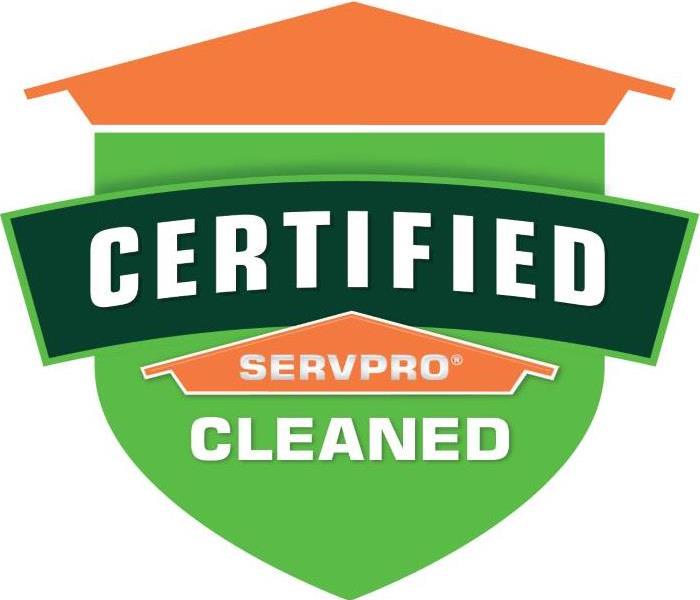 When our logo is on your door, your commitment to clean is clear.
When our logo is on your door, your commitment to clean is clear.
Getting back to business relies on getting your employees and customers back through your doors. When the stakes are this high, you want a partner who has developed an industry-leading and proprietary training program, cleaning solutions, and remediation processes. The COVID pandemic has changed what it means to be clean. SERVPRO of Virginia Beach is Here to Help get your business back to normal.
Certified: SERVPRO Cleaned is a defensive cleaning program that goes beyond janitorial cleaning, this is a proactive viral pathogen cleaning. SERVPRO of Virginia Beach is being called on by numerous businesses and community leaders to clean, disinfect and sanitize their properties as either a preventative measure or following a suspected or known positive COVID exposure. SERVPRO uses EPA approved products and follows the CDC guidelines for cleanup practices.
1. Consult - A Tailored Cleaning Program to Meet Your Needs
2. Clean - Proactive and COVID Emergency Response Cleaning Program
3. Certify - A Commitment to Clean for Your Employees and Consumers
We are here 24 hours a day, seven days a week, while life gets back to normal in the community we call home.
Five Things That You Need To Know About a Water Damage
2/15/2021 (Permalink)
When a pipe bursts, a drain backs up, or a flood occurs in your home, it can be hard to see past the mess. A million questions will run through your mind.
There is no doubt about it. Water damage is extremely stressful, and the more you know about it, the better you will be able to decide how to address it. Here are five things that every homeowner needs to know about water damage.
- There are different insurance policies for flood damage and water damage.
You might think that water is water, whether it is from flooding or a burst pipe, but flood damage is not covered under homeowner’s insurance. If you live in an area likely to experience flooding, you will probably already have a separate policy through the National Flood Insurance Policy (NFIP). When you report the claim to the insurance company, make sure to specify whether the claim is for water damage or for flood damage, so they can begin adjusting your claim correctly.
- Not all water damage is covered by your insurance.
It is a good idea to look over your insurance policy and familiarize yourself with any exclusion to your water damage coverage. For instance, most policies cover sudden damage, like water damage from a really bad storm or from an overflowing washing machine. On the other hand, any water damage that happens because you didn’t maintain the property may be excluded, as well as gradual leaks that caused water damage over time.
- Once water damage has happened; the clock is ticking before it gets worse.
When your property has been water damaged, you don’t have the luxury of waiting around for a convenient time to start the cleanup. Secondary damage from mold growth can present serious health effects associated with mold in the living environment.
Mold spores are everywhere, but they need moisture and a nutrient source to grow. And that is exactly what your wet carpet or drywall offers.
To prevent mold growth, you will need to get your property completely dry again within that 24-48-hour window. To do this, you will need to contact a company that specializes in water damage restoration and emergency water extraction. They will have the professional water removal equipment and drying equipment to get the job done as quickly as possible. Many have 24-hour a day emergency hotline, so you can start recovering your property almost immediately.
- Your insurance company needs to know right away.
It is a good idea to call your insurance company right away when you discover water damage. Your insurance agent can start the claims process immediately, as well as guide you through the first steps you will need to take to protect your property from more damage, like stopping the source of the water at the main water turnoff.
- The pollution level of the water is important.
Water damage is categorized as one of three levels by how polluted the water source was that caused the damage.
Category 1: Water from a clean water source, like a freshwater line for a dishwasher. This water will not cause illness or any ill effects.
Category 2: Water that may cause illness through contact. It may have bacteria in it,
Even though water may start out as Category 1, that doesn’t mean it will stay that way. Any contamination that the water touches, such as dirty carpeting or soil from the ground, can change water damage Category to 2 or even Category 3. And since standing breeds bacteria, the longer the water is around, the worse the contamination of your property.
More contamination can mean that the restoration team will have to use more aggressive measures to clean your structure and property, and it might mean that soft furnishings, like your carpet and the carpet pad, may have to be discarded for your safety.
Water damage can be dangerous and expensive, so preventing water damage is an important part of home maintenance. But if you know the basics of what to do once it happens, you can prevent it from doing its worst.
SERVPRO of Virginia Beach Additional services
2/15/2021 (Permalink)
These are some additional services provided by SERVPRO of Virginia Beach. Our team is dedicated to helping with ALL of your property damage restoration needs.
* HVAC duct and coil cleaning- commercial and residential
* Dry ice blasting- a nonabrasive alternative to solvent-based cleaning
*Commercial carpet and upholstery Cleaning
*FREE Emergency Ready Profile- a complimentary profile to get a commercial building back in business after a disaster...BEFORE a disaster
*We are a class A licensed contractor
We also offer some free services
*Free board up (depending on the severity of loss)
*On sight generators (depending on severity of loss)
*Free ladder assist for adjusters
*Infrared Thermo Pictures
*Training (state, alfa college/real estate, insurance, C.E.)
* SERVPRO is a green certified firm
If you have any questions, please do not hesitate to call SERVPRO of Virginia Beach at 757-431-1400
What is a SERVPRO Emergency Ready Profile?
2/15/2021 (Permalink)
SERVPRO of Virginia Beach has 30 years of experience in restoring property damaged by fire, water & smoke. During those years, we have discovered that businesses that do not have an emergency plan in place, prior to a disaster, sustain much greater losses due in large part to the additional time it takes them to react and take proper emergency steps to mitigate damage after a loss has occurred.
The degree of damage not only increases with the length of time it takes to react, but dollars lost due to business interruptions also increase very rapidly. As many as 50% of businesses may never recover following a disaster, according to the latest industry research. Of the businesses that do survive, many of them had a preparedness plan in place. Pre-planning can serve as an insurance policy aimed at giving you peace of mind.
By developing a SERVPRO Emergency Ready Profile for your business, you minimize business interruption by having an immediate plan of action. Knowing what to do, who to call and what to expect in advance is the key to timely mitigation and can help minimize the affects water and fire damage can have on your business.
The SERVPRO Emergency Ready Profile offers:
- A no cost assessment of your facility
- A concise Profile Document that contains only the critical information needed in the event of an emergency
- A guide to help you get back into your building following a disaster
- Establishes SERVPRO of Virginia Beach as your disaster mitigation and restoration provider
- Identification of the line of command for authorizing work to begin
- Facility details such as shut-off valve locations, priority areas and priority contact information
Give SERVPRO of Virginia Beach a call at 757-431-1400 to schedule yours now.
Don't know what to do if you experience a water damage? We asked an Expert, Anna Chercles, Owner of SERVPRO of Virginia beach.
1/11/2021 (Permalink)
The thing about water damage and repair professionals is that no one seems to have interest in knowing one until they are in desperate need of their help! We interviewed SERVPRO of Virginia Beach Franchise Owner, Anna Cheracles, to find out just what it is that a restoration professional does and when and why someone would need to hire one. Here is what Anna had to say:
What exactly does a water damage and repair professional do?
We arrive onsite within 4 hours (usually 1 hour) to remediate a water damage. The sooner you can stop the water and begin to dry the structure, the less damage you will have, which will reduce repairs that will need to be done.
Why is it important to call a professional?
We believe in restore vs. replace. We have special drying techniques which will save time and money for the insured and insurance company. You do not want to end up with any type of secondary damage or mold that could be prevented by calling a professional right away.
A professional will know when it is necessary to remove materials such as vinyl or laminate floors in order to dry sub floors. We have tools, such as moisture meters, that can detect exactly what's been affected so that we can properly mitigate the loss.
What are the most common problems water damage professionals see?
We often find pre-existing damage. It is important to properly maintain your home so that dry rot or other slow leaks do not occur. If you have a pipe burst under your sink, but you have dry rot already showing on you sub floor, often the insurance companies will not cover this due to the home not being maintained.
Another problem we see is when a homeowner does not take immediate action. They will wait a few days for the insurance company to come out before they call a mitigation company to come out. Or they try to do the work themselves. This will only prolong the process and possibly cause more damage later. You need special equipment to properly dry a structure.
When should I call a water damage professional?
You should call a professional Anytime you experience a water damage. The sooner you call, the more you can minimize damage. Even if the cause of the problem is still not fixed, the faster we can begin extracting water, you can lessen the chance of further damage. Often an area can feel dry to the touch, but it is important to have a professional use a moisture meter to check for water behind cabinets, walls, etc. Dry wall may feel dry, but the insulation inside the wall could possibly be wet. Carpet could feel dry, but the sub floor and padding could have elevated moisture levels.
How much will it cost?
We use industry standard prices, which are set for each region in the country through a program called Xactimate. Most of the charges are done by square foot, by a labor hour or per piece of equipment. It is pricey to properly mitigate your home, but if you do it right the first time, you won't have mold grow and will save money in the long run. We deal directly with the insurance companies so there will not be any type of paperwork that you will need to file. We take care of it all!
What should be done while waiting?
If possible, turn the source of the water off. Begin mopping up water or blotting with towels. DO NOT use a shop vac to remove water. Shop vacs are not meant to extract a lot of water, only a little bit here and there. Put all furniture up on blocks, or even put foil under the legs of furniture to protect it and to also protect your carpet from getting any staining on it. You should also wipe up any water on wood furniture, so it does not ruin it. Do not use electrical devices where the moisture is present. Make sure to not stand under any sagging ceilings.
How do I decide who to hire?
You should always try to hire someone who has a national reputation and a brand that stands behind them.
Should you require a professional, call, SERVPRO of Virginia Beach
Did you know that SERVPRO of Virginia Beach can restore your documents after a fire?
1/7/2021 (Permalink)
Did you know that SERVPRO of Virginia Beach Can Restore Your Documents After a Fire?
We want our customers taken care of in their most vulnerable time of need, that is why we offer the services that we do: emergency mitigation, fire and water restoration, mold remediation, and so much more. However, one item that often is overlooked after are our customer’s paper documents and records.
If you are not familiar with it, here is an overview.
SERVPRO of Virginia Beach’s Commercial Large Loss Division (CLLD) offers four services: Vacuum Freeze Drying, Gamma Irradiation, Digitizing, and Certified Destruction. Vacuum Freeze Drying is the most effective way to salvage water damaged documents. The saturated documents are immediately frozen and shipped from the loss site to our Corporate office where they are dried via sublimation. Sublimation is the process of solid ice converting directly to the gas state bypassing the liquid state. This prevents further damage to the water-logged documents. This process takes between 7-10 days depending on the severity and the number of documents affected. Gamma Irradiation is a process that is used for cleaning/disinfecting and decontaminating documents. In a CAT 3 situation (sewage or flood water), documents are not only deteriorating but are also contaminated with all types of bacteria. Using high-energy photons, the bacteria is killed at the molecular level. There is no fear of residual radiation or contamination, so don’t worry, you won’t turn into the Incredible Hulk. If you want to go digital with your records, we can do that too.
To bullet point and sum up the above article:
- Drying- process in which an item containing moisture is frozen and dried using vacuums and pressures to achieve sublimation (A process in which a substance is converted directly from a solid to a gas or from a gas to a solid without an intermediate liquid phase.) Note: Damaged documents should be frozen as quickly as possible to stabilize them and prevent further damage.
- Cleaning- we offer onsite cleaning. This is cleaning each document front and back to remove debris and any surface particulate.
- Sterilization- Gamma Irradiation is a process that is used for disinfecting and decontaminating documents or other consumer goods.
- Deodorization- once paper has been wet, an odor can begin to form. Letting us deodorize your documents will reduce the odor and sometimes almost eliminate it.
- Destruction- we offer destruction onsite.
- Digitization- digitizing documents makes them easier to access as well as easier to store. We use state-of-the-art equipment to turn your paper copy into a digital file.
If you find yourself in need of saving damaged documents, SERVPRO of Virginia Beach and we will make it "Like it never even happened."
Virginia Beach Board-up Services
1/7/2021 (Permalink)
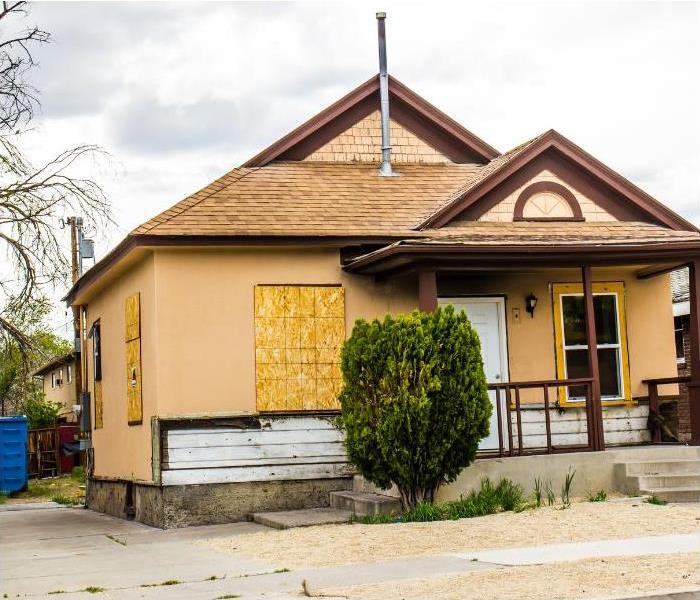 Board-up to protect from further damage or vandalism
Board-up to protect from further damage or vandalism
SERVPRO of Virginia Beach provides 24 hour, 365 day a year emergency board-up services for any residential or commercial location in the Hampton Roads area. Whether you experience vandalism, storm damage, a fire, or another unexpected disaster, you want to restore your property to its normal state as soon as it can be done. Boarding-up incorrectly can cause additional moisture damage, making the situation even worse. We have Class A Subcontractors standing by and ready to assist in any emergency. We can provide you with one-stop shopping. Leave the inconvenience of board-ups to the professionals at SERVPRO of Virginia Beach to make it "Like it never even happened." Call us at 757-431-1400 to ensure no further damage occurs to the structure or its contents.
Winter Storm Help in Virginia Beach
1/7/2021 (Permalink)
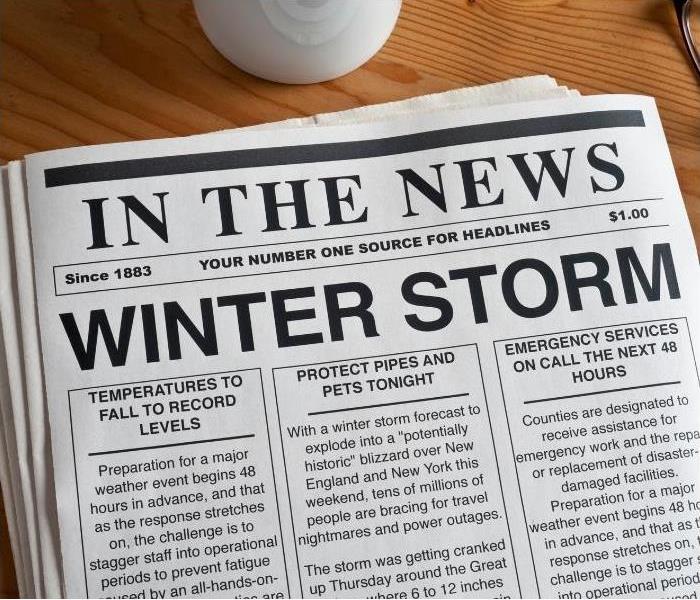 Virginia winter weather can be unpredictable
Virginia winter weather can be unpredictable
Winter weather in Virginia can be very unpredictable. Though snow has not yet been in the forecast this year, it will still prove to be beneficial to prepare your home, car and surrounding area for any impending storm. A few helpful tips for homeowners:
Salt pavement around your house: The city is pretty good with clearing the roads around your home, however any sidewalks and pathways are left up to the homeowner to clear. To make things easier on homeowners, once you are aware of any storm headed your way, spread street salt on your driveway and walkway. Placing salt down prior to any snow storm can reduce the ice that forms underneath piles of snow.
Keep a steady drip: With snow comes freezing and sometimes below freezing temperatures leaving your pipes vulnerable and likely to freeze and in turn burst. Having a slow but steady drip of warm water flow through will help keep your pipes from freezing during these conditions.
Create a winter ready emergency kit: In the event of a snow storm, the strength of it is always unpredictable. To keep you and your family safe, create and keep a winter ready emergency kit available. A few things to keep in the kit; bottled water, batteries, a functioning radio, different layers of clothing, blankets and non perishable food items.
SERVPRO of Virginia Beach has a 24/7 emergency response team that is ready to handle all storm damage in Hampton Roads, 24 hour, 365 days a year, for any residential or commercial location in the Hampton Roads area.
Virginia Beach Commercial Property Cleaning
12/30/2020 (Permalink)
 Commercial Property Cleaning
Commercial Property Cleaning
As a business owner or facility manager, you do not have time to worry about the common wear and tear that gradually soils your office. When grime, odor and moisture challenges go beyond the scope of your regular janitorial staff, call in SERVPRO of Virginia Beach. Whether it’s removing an odor problem or deep cleaning carpets, you can rely on us to make your workspace look its very best. SERVPRO of Virginia Beach also offers disinfecting services designed to treat proactive, suspected, and positive COVID-19 contamination. We have the specialized training and products to get your property back to business. Our cleaning services include the following:
- Air Ducts and HVAC
- Biohazard
- Carpet and Upholstery
- Ceilings, Floors, and Walls
- Drapes and Blinds
- Odor Removal
- Sewage
- Trauma and Crime Scene
- Vandalism
- Disinfecting
SERVPRO of Virginia Beach has the resources to help you immediately. Give us a call at 757-431-1400 to schedule an estimate.
The Three Levels of Loss for Virginia Beach Businesses
12/30/2020 (Permalink)
 Virginia Beach commercial buildings
Virginia Beach commercial buildings
SERVPRO of Virginia Beach specializes in both residential and commercial losses. Similar to residential losses, commercial losses have a three-tier damage level that we access.
Level 1 is a small commercial loss involving 15,000 square feet or less of affected floor space. Examples of a small commercial loss may include a stand-alone store front, a small church, or a daycare facility. A Level 1 loss can also be a small portion of a much larger structure.
Level 2 is a mediumcommercial loss involving 15,000 to 60,000 square feet of affected floor space. They are typically multi-level or greatly divided spaces. Examples of a level 2 loss may include a small multi-family property, a midsize church, or a school. A Level 2 loss can also be just a portion of a much larger structure
Level 3 is a largecommercial loss typically involving more than 60,000 square feet of affected floor space. The building or buildings involved will likely be large multi-level structures. Examples of a level 3 loss can include a large church, hospital, school, or university; a large multi-family property; or a large strip-style shopping center or shopping mall. This is the level at which it would be appropriate to refer to the project as a “large loss.”
Make SERVPRO of Virginia Beach your first call to help you or your business and your local insurance agent assess the damage. We will work for you to restore the property to make it "Like it never even happened."
When Water Strikes in Virginia Beach
12/14/2020 (Permalink)
When Water Strikes in Virginia Beach
If you are looking to prevent damage to your home, staying ahead of water damage is crucial. Water damage leads to rotted wood, insect infestation, peeling paint and weakened roofs and siding, Mold or Mildew
Check for leaks and cracks where water can enter, such as windows and doors, especially around corners. Clean and caulk these leaks immediately. Look for broken shingles and cracks in exterior walls. Repair or replace any broken shingles that are allowing water in, seal all cracks and holes in your home’s foundation, joints, and exterior walls. Ceiling leaks can be dealt with by measuring the location of the leak from the nearest outside wall, then locating this point in the attic with a measuring tape.
Check your home for leaking faucets, sweating pipes, bad drainage systems, and clogged drains—all of these can lead to water leaking, pooling, and causing damage. Keep an eye on your water heater for signs of leaking water or rust. If you have a wood home, look out for termite damage. To prevent future leaks, install flashing around doors, windows, thresholds, chimneys, and roofs—it prevents water from penetrating places where two different building surfaces meet.
Maybe you are just dealing with a burst pipe, or worse yet you have a flooded basement. Regardless of how bad the initial damage is, you cannot afford to wait to start the water cleanup process. Within just a single hour up to a day after your home has been exposed to water, it will begin to cause damage. This is when drywall begins to bulge and break, furniture begins to swell and crack, and metal surfaces begin to tarnish
Water spreads very quickly and will get absorbed into the floors, the walls, your furniture, and other areas in your home. Once you have stopped the actual leak, you need to immediately start the process of water mitigation, which is the process of preventing or reducing the amount of water damage, to prevent additional damage so time is of the essence. If water damage persists for more than a week, mildew and mold growth, structural damage and biohazard contaminants may pose serious risks to you and your family. The delay in restoration time may also significantly increase the cost to repair water damage.
Do not hesitate to call SERVPRO of Virginia Beach at 757-431-1400 we strive to make it “Like it never even happened.”
Home Fires are Preventable in Virginia Beach
12/14/2020 (Permalink)
Home Fires are Preventable in Virginia Beach
When it comes to your home or business there are certain safety precautions that can be taken to help to prevent fires. Ready.gov has provided the following tips on Home fire prevention.
- Frayed wires can cause fires. You should replace all worn, old or damaged appliance cords as soon as possible. Do not run cords under rugs or furniture.
- Immediately shut off then replace light switches that are hot to the touch and all lights that flicker.
- This one seems more obvious, if you have a three-prong plug, use it only in a three-slot outlet. Never force it into a two-slot outlet or an extension cord
- Never leave candles unattended.
If you have a fireplace a woodstove they should be inspected annually. They should also be checked monthly for damage and or obstructions. You should use a fireplace screen heavy enough to stop rolling logs and big enough to cover the entire opening of the fireplace to catch flying sparks.
Make sure the fire is completely out before leaving the house or going to bed.
Emergency Ready Profile for Virginia Beach Commercial Buildings
12/11/2020 (Permalink)
No one ever plans a disaster; however, you can prepare for it with our Emergency Ready Profile (ERP). The ERP will help ensure you are “ready for whatever happens”. In the event of an emergency the ERP is a FREE comprehensive document containing critical information about your business. Some examples are listed below:
- A no-cost assessment of your facility.
- A concise profile that contains only the critical information needed in the event of an emergency.
- A guide to help you get back into your building following a disaster.
- Provides facility details such as shut-off valve locations, priority areas and priority contact information, emergency exits.
- Profile is viewable online or on your SERVPRO READY APP and is secured with a login and password.
Preparation is key to making it through any size disaster, whether it is a small water leak, a large fire, or an area flood. Having an Emergency READY Profile in place may help minimize the amount of time that your business is inactive and get you back into your building. Do not wait until a disaster strikes, Contact SERVPRO of Virginia Beach to establish your Emergency READY Profile.
Knowing the Class of Your Fire Extinguisher in Virginia Beach
12/11/2020 (Permalink)
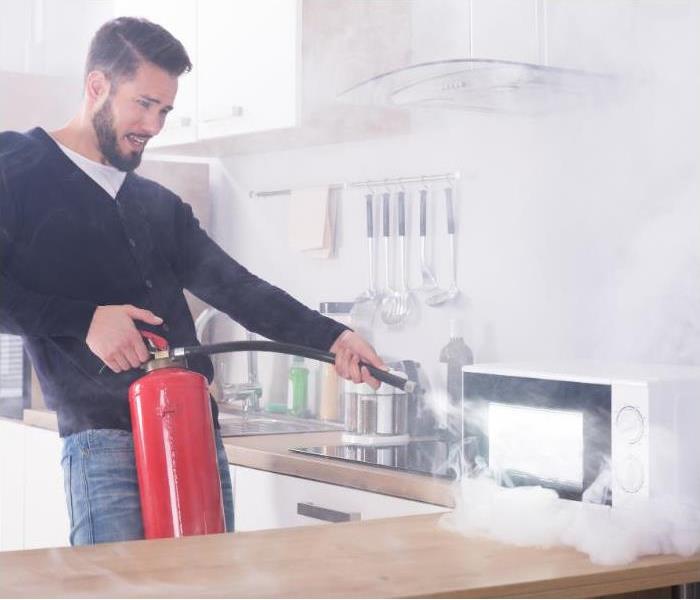 Kitchen fire
Kitchen fire
Understanding fire extinguisher classes
There are four classes of fire extinguishers – A, B, C and D – and each class can put out a different type of fire.
- Class A will put out fires in ordinary combustibles such as wood and paper
- Class B are for use on flammable liquids like grease, gasoline, and oil
- Class C are suitable for use only on electrically energized fires
- Class D are designed for use on flammable metals
Multipurpose extinguishers can be used on different types of fires and will be labeled with more than one class, like A-B, B-C or A-B-C.
Purchasing your fire extinguisher
Now that you know how many extinguishers you need and what types to get, you can head to the hardware store. Look for fire extinguishers that you can easily lift. Larger extinguishers may pack more power, but you must be able to use it properly.
Learning how to use your fire extinguisher
Once you have made your purchases, familiarize yourself with the fire extinguisher directions so you will be prepared in case you need to put out a fire. Typically, fire extinguishers are easy to use in the case of a fire. Most of the types operate using the P.A.S.S. technique:
- P. Pull the pin on the fire extinguisher to break the tamper seal.
- A. Aim the fire extinguisher low, with the nozzle pointed at the base of the fire.
- S. Squeeze the handle of the fire extinguisher to release the extinguishing agent.
- S. Sweep the nozzle from side to side while pointed at the base of the fire until it is extinguished.
- If the fire re-ignites, repeat the last 3 steps.
SERVPRO of Virginia Beach professionals have the training and the equipment to make it “Like it never even happened.”
Causes of Water Damage in Virginia Beach
12/11/2020 (Permalink)
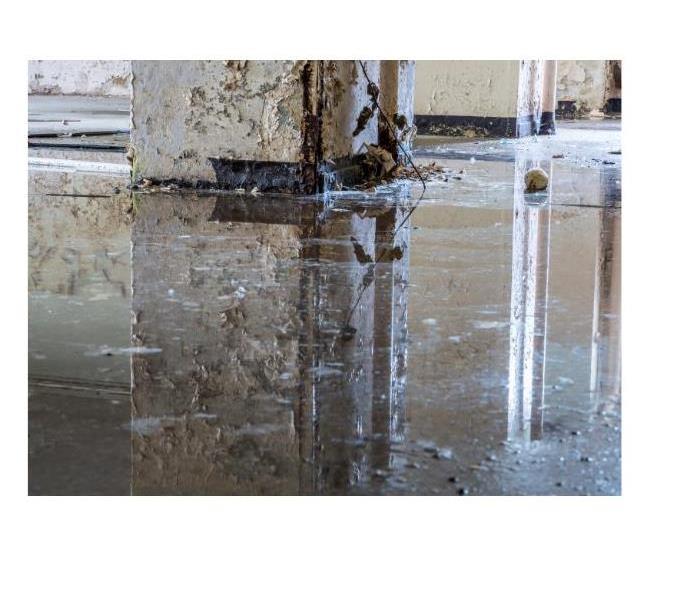 flooded warehouse
flooded warehouse
When business owners visualize water damage, they often picture a massive storm wiping out power lines, flooding offices, and shutting down businesses for days at a time. It is true that commercial water damage is often the result of floods and water that stems from weather events and storms. However, many entrepreneurs and business space renters forget that storms and severe weather are not the only causes of floods and water damage. Here are some of the typical causes of water damage to commercial buildings.
1. Malfunctioning sprinkler systems
Some older office and retail buildings still have outdated sprinkler systems that work in conjunction with fire protection systems. While such sprinklers can come in handy during a fire emergency, they can also cause commercial flood damage if they are faulty or in need of replacement. This could easily damage inventory and business assets.
2. Damaged appliances and equipment
This cause of commercial flood damage is more common in restaurants and catering facilities, as well as any business that has appliances and equipment that make use of water. If the appliance fails and sends water across your building, especially during late hours when no one is around, you may come back to work and face a water emergency.
3. Broken pipes and plumbing
Just like in a residence, if the plumbing system in your workplace fails a water damage could be the result.
4. Backed up sewer lines
This is another cause of commercial water damage that often catches business owners by surprise. Should the sewer line to your building back up or become damaged, realize the potential dangers of contaminated Black Water which can cause health effects and ruin products and office furnishings.
If your business has suffered commercial water damage, SERVPRO of Virginia Beach will get you back up and running again "Like it never even happened." Give us a call at 757-431-1400.
Holiday fire safety in Virginia Beach
12/10/2020 (Permalink)
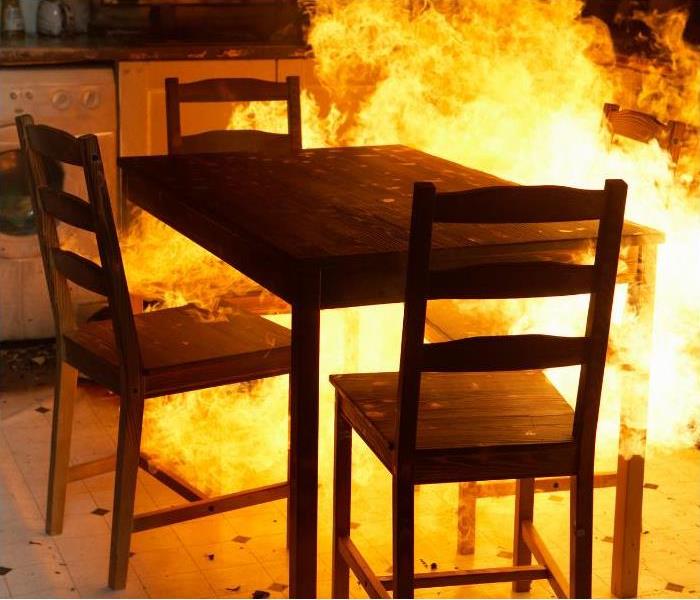 Kitchen fire
Kitchen fire
Cooking equipment is the leading cause of residential fires. During this time of year, you will find that you are using your cooking equipment more often while hosting family and friends, and fire precautions should be on top of the mind.
You may experience a flood of emotions if a fire damages your home or business. There might be fear, stress, and uncertainty about the future of the property. Here at SERVPRO of Virginia Beach, we have a restore not replace attitude and our number one goal is to get everything back to preloss condition. We strive not only to restore your property, but your piece of mind as well. If you experience a fire, the following tips may help reduce damage and increase chances of a successful restoration.
- Do not attempt to wash any walls or painted services.
- Limit movement in the home to prevent soot particles from being embedded into upholstery and carpet.
- If heat is off during winter, pour RV antifreeze in sinks, toilet bowls and holding tanks and tubs to avoid freezing pipes and fixtures.
- Wipe soot from chrome kitchen and bathroom faucets, trim, and appliances. Then protect these surfaces with a light coating of a lubricant.
- Tape double layers of cheesecloth over air registers to stop particles of soot from getting into the HVAC system.
After the first wave of heroes have secured the building, Call SERVPRO of Virginia Beach professionals and let us help make it “Like it never even happened.”
Strong Winds Cause Big Damage in Virginia Beach
11/23/2020 (Permalink)
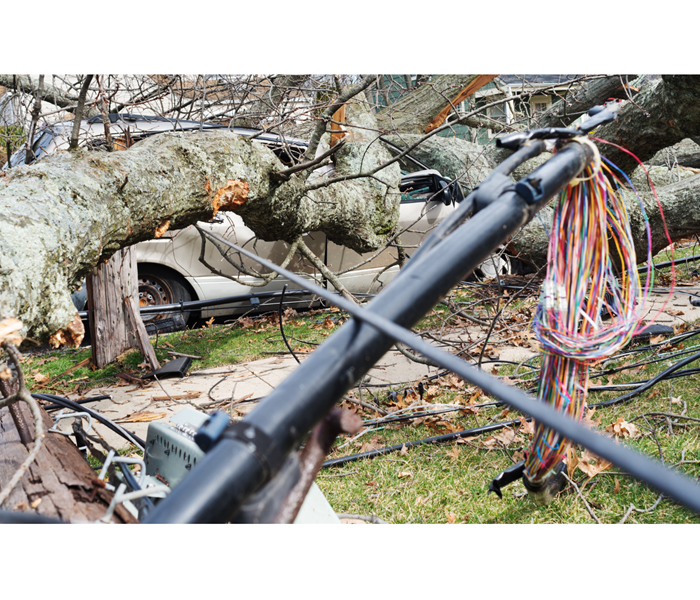 Wind can do lots of damage to your property.
Wind can do lots of damage to your property.
With strong storms comes strong winds that can cause damage to your home. There are a few things homeowners can do that will be helpful in the long run.
If nothing else, maybe you'll sleep better!
Tips for avoiding wind damage from Nationwide Insurance:
- Shingles should meet or exceed the local building code, and be rated high for wind and impact resistance.
- Make sure shingles are snugly nailed down and fitted tightly together.
- Inspect the roof sheathing to ensure it is securely nailed to avoid sections being peeled off by winds.
- Make sure the connection between the roof and walls is tight to avoid updrafts lifting off the roof.
- Check that HVAC units, skylights and pipes are tightly affixed and won't be blown off.
About walls and doors:
- Is the building well sealed to prevent wind from getting into cracks and crevices and causing interior damage?
- Check all siding and windows to ensure they are tightly attached.
- All entry doors should be triple hinged and secured with a deadbolt lock for maximum windstorm protection.
- Overhead doors should be able to withstand high winds and braced sufficiently.
Regarding outdoor areas:
- Storage sheds and outbuildings should be securely anchored.
- Evaluate everything you have stored outside, such as equipment, inventory and supplies, and make sure these are anchored or can be easily moved inside if a storm approaches.
- Make sure dumpsters, outdoor lighting fixtures and fencing are secured. Strong windstorms can pick up items, such as waste receptacles, and turn them into destructive missiles.
- Are there large shrubs and trees close to your building? Make sure they are healthy and pruned to prevent large limbs or whole trees from falling onto your building.
- Outdoor signage should be tightly anchored and secure, and designed to withstand the weather in your region. Check with your insurer to see if your sign is included in your property insurance or if you need an endorsement to cover it.
- Ensure your commercial property insurance covers any damage to your building or other business property caused by a windstorm.
About vehicles and fleet:
- If possible, store any vehicles inside a garage or storage building.
- Never park vehicles under a tree if a storm approaches.
- If you must park vehicles outdoors, be aware of things that could cause damage such as branches, lampposts and power lines.
If you encounter damage from wind or rain at your personal or business property, please call SERVPRO of Virginia Beach and let us make it "Like it never even happened."
Virginia Beach Tornado Damage
11/23/2020 (Permalink)
 Hampton Roads is no stranger to the damage of tornadoes.
Hampton Roads is no stranger to the damage of tornadoes.
Most violent tornadoes come from supercells, large thunderstorms that have winds already in rotation. About one in a thousand storms becomes a supercell, and one in five or six supercells spawns off a tornado. Tornado season begins in early spring for the states along the Gulf of Mexico. The season follows the jet stream—as it swings farther north, so does tornado activity. May generally has more tornadoes than any other month, but April's twisters are usually more violent. Although they can occur at any time of the day or night, most tornadoes form in the late afternoon. By this time the sun has heated the ground and the atmosphere enough to produce thunderstorms. Tornadoes form when warm, humid air collides with cold, dry air. Twisters are usually accompanied or preceded by severe thunderstorms and high winds. Hail is also common. Once a tornado hits the ground, it may live for as little as a few seconds or as long as three hours.
What is a State of Emergency for Hampton Roads: A state of emergency allows state agencies to perform actions, that normally would not be permitted, in the interest of quickly getting assistance to local governments, and in turn Virginia residents.
SERVPRO of Virginia Beach is well-versed to handle all tornado damage in Hampton Roads, 24 hour, 365 days a year emergency for any residential or commercial location in the Hampton Roads area. We have Class “A” Subcontractors standing by and ready to assist in any emergency. We can provide you with one-stop shopping. Leave the hassle of repairing the damage to the professionals at SERVPRO of Virginia Beach and make it "Like it never even happened." Call us 757-431-1400 to ensure no further damage occurs to the structure or your contents.
How to Look for Storm Damage in Virginia Beach
11/16/2020 (Permalink)
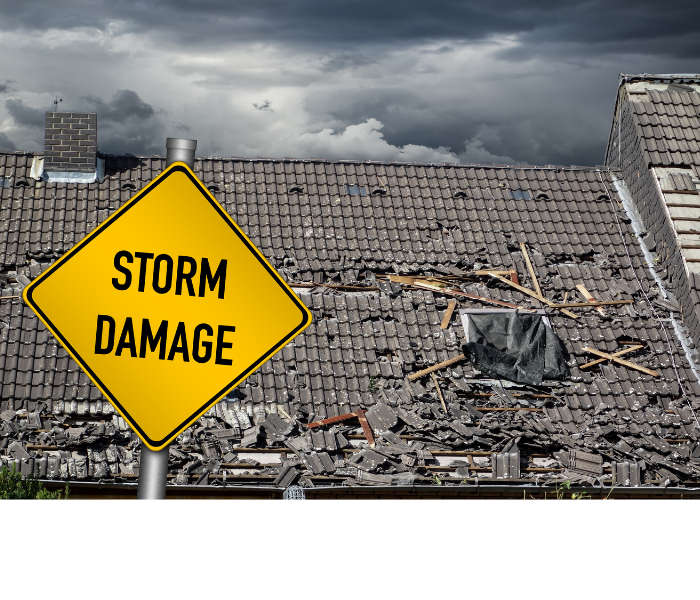 Roof damage after a severe storm.
Roof damage after a severe storm.
How to look for storm damage
- Roof: Look for shingles that have discoloration, tearing, or even holes in them. These can all be signs that your roof has been damaged. Another sign is if there are leaks in your roof or your ceiling.
- Gutters: After a hailstorm, looking for dents or dings can also give you a better picture of what the storm did to the rest of your home. Your gutters can also give you insight to whether you have roof damage. Check to see if there are granules from the asphalt shingles in your gutter.
- Windows: Look at each of the windows at your homes and note any signs of shattered or broken windows and frame damage. This is especially important after a hailstorm or a strong wind storm.
- Exterior: Not only is it important to look at the siding of your home to check for damage, it is also important that you check any appliances. Inspect your AC/HCAC unit as well as items such as a barbeque grill.
After your inspection, if you notice any signs of storm damage follow up by checking the area for signs of mold, mildew, pests or other secondary damage. If damage has occurred have it repaired immediately. Call SERVPRO of Virginia Beach at 757-431-1400 for any restoration needs you may have.
Winter Weather in Virginia Beach
11/16/2020 (Permalink)
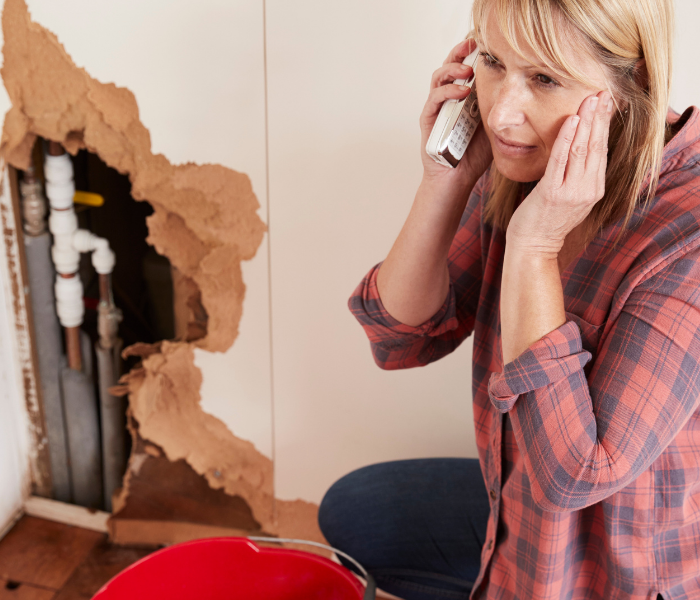 Call SERVPRO of Virginia Beach to help clean up after a water damage.
Call SERVPRO of Virginia Beach to help clean up after a water damage.
When you think of winter weather you probably think of school closings, slippery roads and a driveway to shovel. Winter weather can cause a lot more issues then those listed above. If we have below freezing temperatures for 3 days in a row you are at risk for frozen pipes, which can create a major disaster at your home or office.
Typically, frozen pipes are the ones exposed to the cold weather such as basements, attics, garages, and kitchen cabinets. A frozen pipe will usually rupture because of the backflow pressure between the blockage and the water source; this can cause catastrophic damage to your home and office if not addressed quickly.
According to the American Red Cross there several steps you can take to prevent your pipes from freezing:
- Keep your heat set both day and night
- Be sure to completely drain the water from sprinkler lines as well as outside hoses
- Open your kitchen cabinets to let the warm air to circulate near the pipes
- When weather is extremely cold, let water drip from your exposed faucets
If you experience water damage from frozen pipes, call SERVPRO of Virginia Beach at 757-431-1400 and let us make it "Like it never even happened."
The Only 5000 CFM Desiccant in Virginia Beach
11/16/2020 (Permalink)
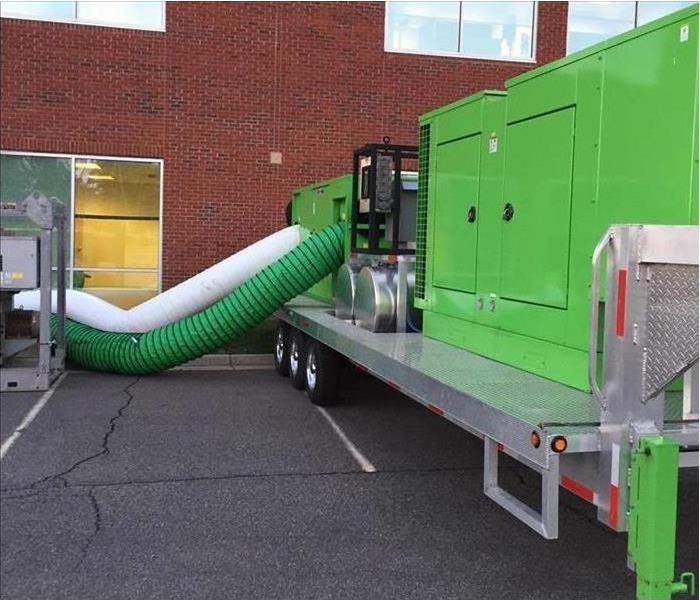 5000 CFM Desiccant Trailer
5000 CFM Desiccant Trailer
At SERVPRO of Virginia Beach, our mission is to be the premier fire and water restoration contractor in Hampton Roads. To do so, we are continuously training our staff and updating our procedures to stay current within our industry. We are very excited to introduce this state-of-the-art piece of equipment and announce that we are the ONLY restoration contractor in Hampton Roads to own it!
This commercial trailer houses a 5000 CFM Desiccant, capable of drying a medium to large commercial building, and a 150kw Generator. Together, this trailer of equipment can conveniently save both time and money when it matters most.
- Many advanced features are included to provide precision control and maximum operating efficiency
- Ideal for water damage restoration, condensate and humidity control in manufacturing, and corrosion and humidity control for industrial coating and lining, and moisture mitigation in construction project
For more information, contact SERVPRO of Virginia Beach at 757-431-1400.
Commercial Restoration in Virginia Beach
11/16/2020 (Permalink)
A commercial property is always at risk of being damaged by natural elements. If your business gets hit by a disaster, you’ll need a commercial restoration company with real-world experience and the resources to return your property to its normal state. SERVPRO of Virginia Beach has over 30 years of experience in residential and commercial restoration services. Our team of experts offer:
- Commercial water damage restoration
- Commercial fire damage restoration
- Commercial mold damage restoration
- Commercial storm damage restoration
Our professionals have the training and equipment needed to restore your business after common issues with minimal interruption to your daily operations. SERVPRO of Virginia Beach also provides disaster planning to ensure that your property fortified in case future damage strikes.
At SERVPRO of Virginia Beach, we offer 24/7 commercial restoration and reconstruction services for damage caused by water, fire, smoke, mold, storms, and other disasters.
Why SERVPRO Commercial Restoration?
What makes SERVPRO of Virginia Beach Restoration different from other commercial restoration services? Besides having a Class A contractor license, we offer multiple services through one point of contact. This means you only need one number to reach our reconstruction, emergency services mitigation, contents cleaning, training, insurance claims assistance, and disaster planning teams. You can depend on us for additional commercial damage services like cost savings, streamlined catastrophe planning, and minimized disruption.
Our franchise organization is proud to provide fast, high-quality cleanup and restoration services to both commercial and residential properties. We always put your property first at SERVPRO of Virginia Beach.
Call SERVPRO of Virginia Beach at 757-431-1400
Tips for Dealing with Water Damage in Virginia Beach
10/14/2020 (Permalink)
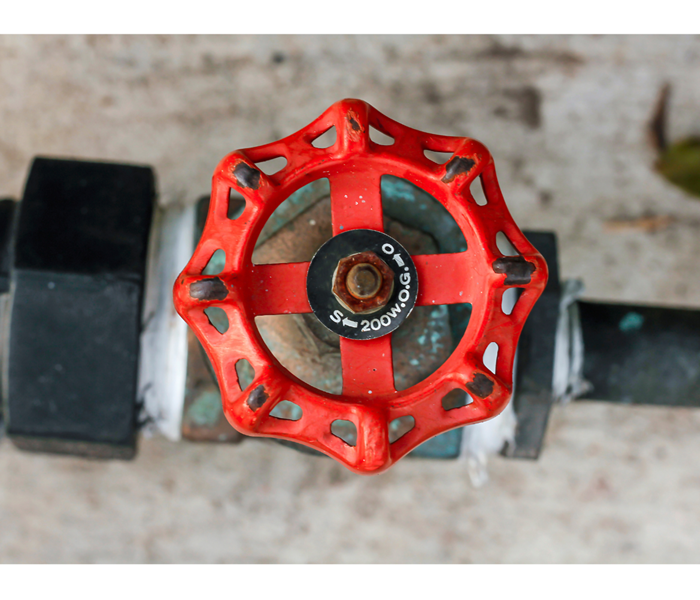 Know where your main water shut off is located
Know where your main water shut off is located
Water damage should always be taken seriously. Even if your home in Virginia Beach experiences a minor leak from a leaky faucet or broken pipes, water has a way of spreading into walls, floors, and other hidden areas. To ensure the damage doesn’t spread, trust a water damage expert to get your home back to new. While you wait for help to arrive, below are a few tips to help contain the damage.
Shut Off the Water Source and Electricity
Safety should always come first. If the water is coming from a pipe, turning off the main water source is imperative since mold can start growing within hours. Depending on where the damage occurs, turn off the electricity.
Check for Mold and Mildew
A main issue resulting from water damage is the growth of mildew and mold. These spores quickly grow and spread, even to areas in the home that aren’t affected by the water. If left unchecked, it can create more serious issues down the road.
Eradicate the Moisture
Water mitigation is an essential part of getting your home back to normal. Along with removing excess water, use fans and dehumidifiers to circulate the air and assist with evaporation. However, if you have visible mold, you should refrain from the use of fans to avoid further spread.
Remove Affected Porous Materials
Water can shrink and warp porous materials. All effected carpeting, insulation, fabrics, paper and other items should be removed from the area. Along with helping the damaged area dry out, removing these items could potentially save them from having to be disposed of.
Disinfect
Once items have been removed and the damaged area is dry, it’s time for some deep cleaning. Any hard surfaces that were touched by water should be disinfected. This will help reduce the chances of mold spreading.
Dealing with water damage is not a fun job, but not addressing early it will make it a much bigger job. While these steps can help reduce the spread of damage, calling the professionals at SERVPRO of Virginia Beach can make it “Like it never even happened.”
Flood Safety Tips for Virginia Beach
10/9/2020 (Permalink)
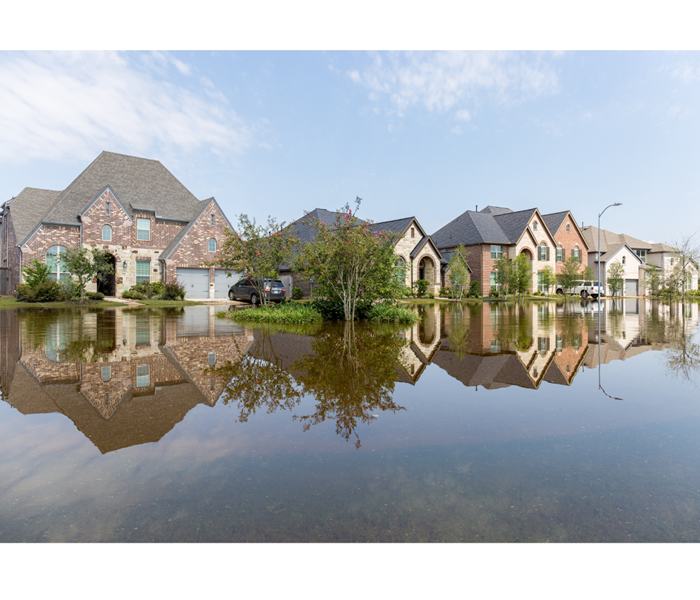 Devastating flood effects
Devastating flood effects
Hurricane Season runs from June 1st to November 30th. Although we are nearing the end of hurricane season, it is still beneficial for everyone to be prepared and aware of impacts that come along with natural disasters.
It is very important that homeowners are aware of the possibilities of damaging winds and overflowing rainwater and have an action plan in place so they can act quickly if and when necessary. Here are four helpful tips:
1- The safety of the homeowner and their family should be first priority. They should know how to leave their home safely, so having an evacuation plan is essential.
2- Make an Evacuation Kit. Each kit will vary Depending on the specific storm you are facing, however the basics of each kit should include items like flashlights, canned food, water, radio, batteries and any necessary medication.
3- If evacuation is necessary stay away from flooded streets.
4- Have a clean up plan. After the water resides and you feel it is safe to re-enter your home, It is imperative that you call a professional to verify that the contamination caused by the flooding is completely out of your home.
SERVPRO of Virginia Beach offers 24- hour emergency response services. We are fully trained and understand how to manage the drying process and use the proper equipment and moisture measuring devices. This prevents secondary water damage and insures that your home is quickly and thoroughly dried.
call SERVPRO of Virginia Beach during your time of need and let us make it "Like it never even happened." 757-431-1400
SERVPRO of Virginia Beach at the Westminster-Canterbury Golf Classic
8/3/2020 (Permalink)
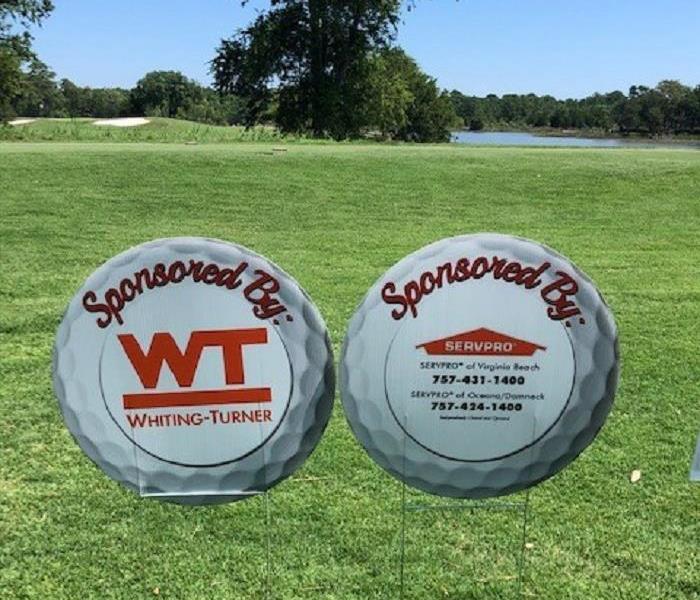 SERVPRO of Virginia Beach at hole #1
SERVPRO of Virginia Beach at hole #1
On Tuesday, July 28th, the Marketing Team (Amber Megrath, Angela Meyer and Corey Doe) of SERVPRO of Virginia Beach attended the 17th Annual Westminster-Canterbury on Chesapeake Bay Foundation Golf Classic at Bayville Golf Course as a hole sponsor. The event supports the Foundation’s mission, “Bringing Joy to Life”. The day was extremely hot but, as always, attendees enjoyed our Orange Crush drinks, handed out in a SERVPRO of Virginia Beach stadium cup, to help cool them down. Our snacks were also a hit. For information about the tournament or to express interest in 2021 participation, you can contact Ashley Allman, Executive Director of the Foundation and Director of Public Relations at 757-496-1106. SERVPRO of Virginia Beach is very much looking forward to next year’s Golf Classic.
Smoke Alarms Save Lives in Virginia Beach
6/24/2020 (Permalink)
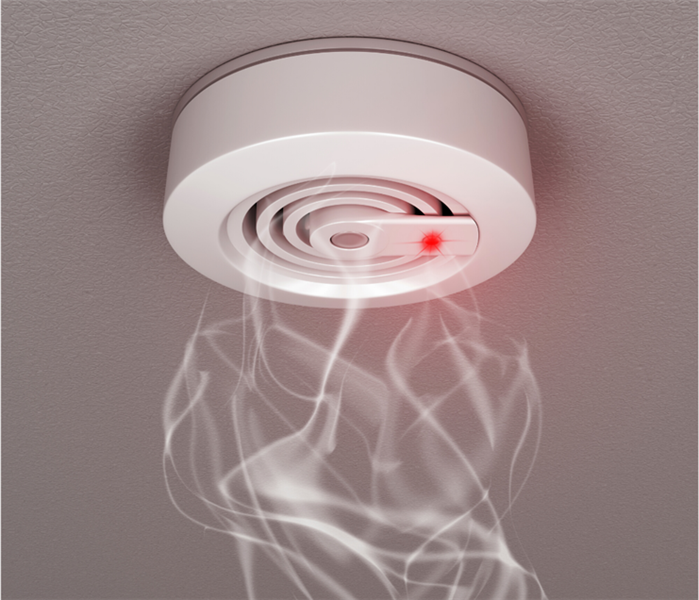 Smoke alarms save lives
Smoke alarms save lives
Smoke alarms save lives when property installed and maintained, according to the National Fire Protection Association (NFPA).
Test smoke alarms monthly using the test button. Smoke alarms with non-replaceable batteries need the entire smoke alarm unit replaced every ten years. If the alarm chirps signaling low battery, take the proper steps to replace the unit or the batteries immediately. Never disable or remove the battery from an alarm. Almost half of first where smoke alarms were present but did not activate had missing or disconnected batteries (NFPA).
In larger commercial facilities, hard wired or wireless smoke alarms offer benefits such as not needing to be tested as often and activating throughout the entire building if smoke is detected in just one area (NFPA).
If you need help installing, testing or changing batteries in your smoke alarms, contact your local fire department, an electrician or the American Red Cross.
Be sure your home or workplace has a fire emergency plan in place and conduct regular fire drills. For more information on Emergency Preparedness, contact SERVPRO of Virginia Beach at 757-431-1400.
SERVPRO of Virginia Beach owner explains when and why you should hire a professional after water damage
5/14/2020 (Permalink)
 Water damage have can long term effects on your home
Water damage have can long term effects on your home
The thing about water damage and repair professionals is that no one seems to have interest in knowing one until they're in desperate need of their help! We interviewed SERVPRO of Virginia Beach Franchise Owner, Anna Cheracles, to find out just what it is that a restoration professional does and when and why someone would need to hire one. Here's what Anna had to say:
What exactly does a water damage and repair professional do?
We arrive onsite within 4 hours (usually 1 hour) to remediate a water damage. The sooner you can stop the water and begin to dry the structure, the less damage you will have, which will reduce repairs that will need to be done.
Why is it important to call a professional?
We can restore vs. replace. We have special drying techniques which will save time and money for the insured and insurance company. You don't want to end up with any type of secondary damage or mold that could be prevented by calling a professional right away.
A professional will know when it is necessary to remove materials such as vinyl or laminate floors in order to dry sub floors. We have tools, such as moisture meters, that can detect exactly what's been affected so that we can properly mitigate the loss.
What are the most common problems water damage professionals see?
We often find pre-existing damage. It is important to properly maintain your home so that dry rot or other slow leaks do not occur. If you have a pipe burst under your sink, but you have dry rot already showing on you sub floor, often the insurance companies will not cover this due to the home not being maintained.
Another problem we see is when a homeowner does not take immediate action. They will wait a few days for the insurance company to come out before they call a mitigation company to come out. Or they try to do the work themselves. This will only prolong the process and possibly cause more damage later on. You need special equipment to properly dry a structure.
When should I call a water damage professional?
Anytime you experience a water damage, you should call a professional. The sooner you call, the more you can minimize damage. Even if the cause of the problem is still not fixed, the faster we can begin extracting water, you can lessen the chance of further damage. Often times an area can feel dry to the touch, but it is important to have a professional use a moisture meter to check for water behind cabinets, walls, etc. Dry wall may feel dry, but the insulation inside the wall could possibly be wet. Carpet could feel dry, but the sub floor and padding could have elevated moisture levels.
How much will it cost?
We use industry standard prices, which are set for each region in the country through a program called Xactimate. Most of the charges are done by square foot, by a labor hour or per piece of equipment. It is pricey to properly mitigate your home, but if you do it right the first time, you won't have mold grow and will save money in the long run. We deal directly with the insurance companies so there will not be any type of paperwork that you will need to file. We take care of it all!
What should I do while waiting?
If possible, turn the source of the water off. Begin mopping up water or blotting with towels. DO NOT use a shop vac to remove water. Shop vacs are not meant to extract a lot of water, only a little bit here and there. Put all furniture up on blocks, or even put foil under the legs of furniture to protect it and to also protect your carpet from getting any staining on it. You should also wipe up any water on wood furniture so it does not ruin it. Do not use electrical devices where the moisture is present. Make sure to not stand under any sagging ceilings.
How do I decide who to hire?
You should always try to hire someone who has a national reputation and a brand that stands behind them. Take advice from your insurance company, they work with these professionals everyday and should have a good recommendation.
Smoke & Soot Facts for Virginia Beach
5/13/2020 (Permalink)
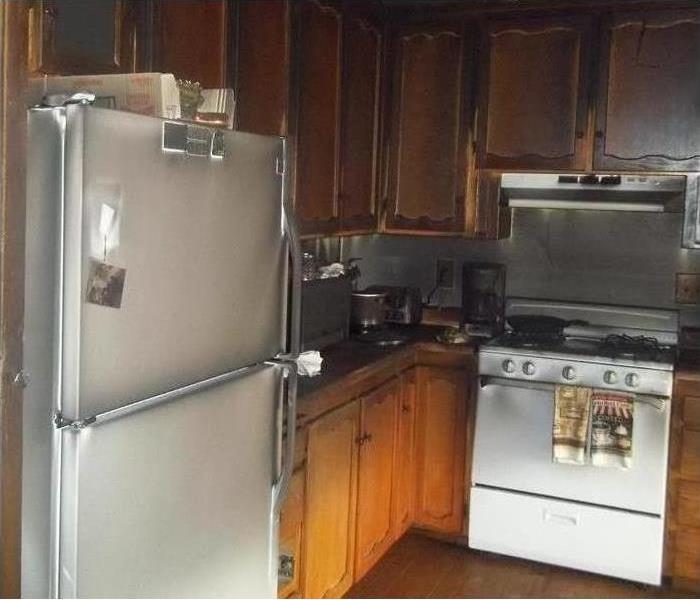 Smoke and soot damage caused by a kitchen fire
Smoke and soot damage caused by a kitchen fire
Smoke and soot from a fire is very invasive and can penetrate various cavities within your home, causing hidden damage and odor. SERVPRO of Virginia Beach’s smoke damage expertise and experience allows us to inspect and accurately assess the extent of the damage to develop a comprehensive plan of action.
Smoke and soot facts:
- Hot smoke migrates to cooler areas and upper levels of a structure
- Smoke flows around plumbing systems, seeping through the holes used by pipes to go from floor to floor
- The type of smoke may greatly affect the restoration process
Different Types of Smoke
There are two different types of smoke–wet and dry. As a result, there are different types of soot residue after a fire. Before restoration begins, SERVPRO of Virginia Beach will test the soot to determine which type of smoke damage occurred. The cleaning procedures will then be based on the information identified during pretesting. Here is some additional information:
Wet Smoke – Plastic and Rubber
- Low heat, smoldering, pungent odor, sticky, smeary. Smoke webs are more difficult to clean
Dry Smoke – Paper and Wood
- Fast burning, high temperatures, heat rises therefore smoke rises
Protein Fire Residue – Produced by evaporation of material rather than from a fire
- Virtually invisible, discolors paints and varnishes, extreme pungent odor
Our Fire Damage Restoration Services
Since each smoke and fire damage situation is a little different, each one requires a unique solution tailored for the specific conditions. The professionals at SERVPRO of Virginia Beach have the equipment, expertise, and experience to restore your fire and smoke damage. We will also treat your family with empathy and respect and your property with care.
Have Questions about Fire, Smoke, or Soot Damage? Call SERVPRO of Virginia Beach at 757-431-1400.
When Water Damage Strikes in Virginia Beach
4/24/2020 (Permalink)
The first 24 hours following a water loss are the most important in preventing secondary or permanent damage. Within four hours of receiving a loss notification, SERVPRO of Virginia Beach professionals will be on-site to help ensure a water damage is handled by completing the following steps.
INSPECTION – SERVPRO of Virginia Beach will inspect affected areas to determine the extent of water damage and will review the inspection with you to answer any questions before beginning the work.
EMERGENCY SERVICES – SERVPRO of Virginia Beach will take steps to help protect your home or business, as well as personal property and other contents, from further damage by extracting the excess water and preparing the area for drying. They will explain the needed emergency services to you step-by-step.
MONITORING – To help ensure your home or business and belongings are dried to appropriate industry standards, a SERVPRO of Virginia Beach professional will monitor the drying process. The updates will be consistently communicated with you.
RESTORATION SERVICES – SERVPRO of Virginia Beach will repair structural materials, reinstall carpets and clean affected areas of your property and contents. A final walk-through of the jobsite will be conducted with you to help ensure the property was returned to its preloss condition.
EMERGENCY WATER DAMAGE TIPS:
- Shut off the water source, if possible, or contact a qualified professional to stop the water source
- Turn off circuit breakers for wet areas of the building when access to the power distribution panel is safe from electrical shock
- Remove as much excess water as possible by mopping and blotting
- Place aluminum foil or wood blocks between furniture legs and wet carpeting
- Move any paintings, art objects, computers, documents and other sensitive valuables to a dry place
- Do not enter affected areas if electrical outlets, switches, circuit breakers or electrical equipment are exposed to water to avoid electrical shock hazards
- Do not use your household vacuum cleaner to remove water – this could cause electrical shock or damage to the device
- Do not turn on ceiling fixtures if the ceiling is wet or enter rooms where ceilings are sagging from retained water
For more information on recovering from water damage, contact SERVPRO of Virginia Beach at 757-431-1400.
Improve Your Air Quality: Duct Cleaning Can Help
4/16/2020 (Permalink)
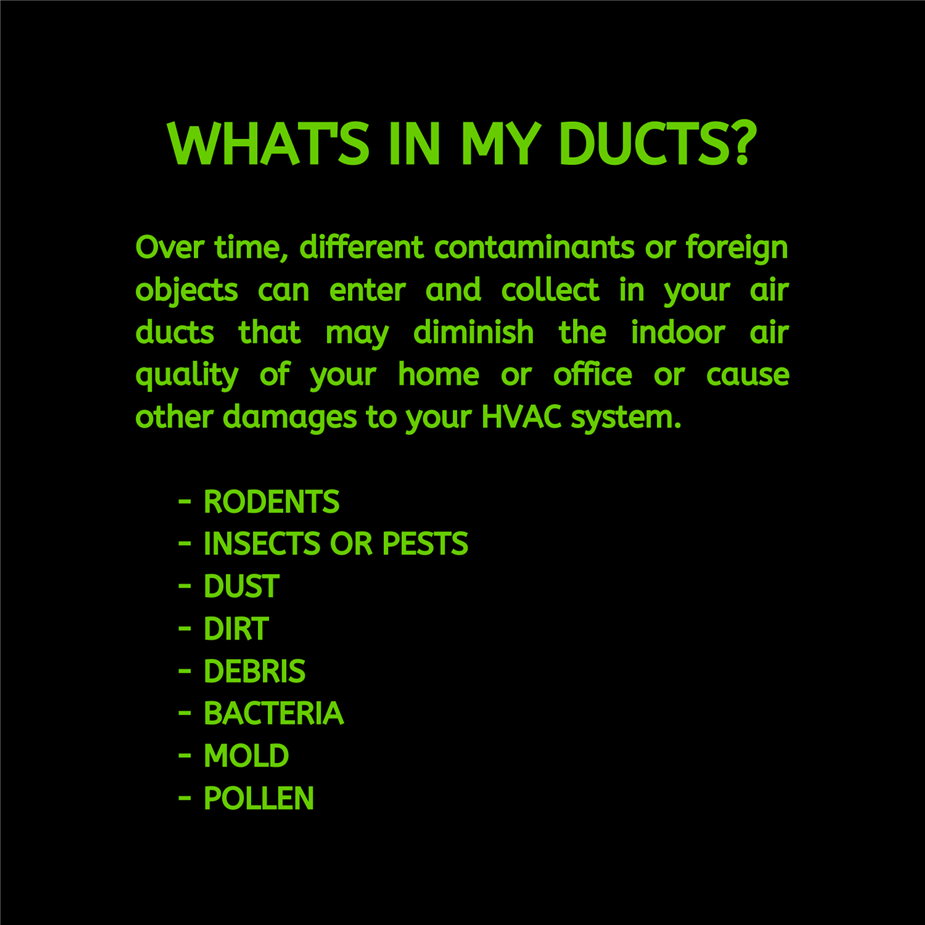 Source: U.S. Environmental Protection Agency
Source: U.S. Environmental Protection Agency
The ventilation system is often the biggest culprit in poor indoor air quality, but you can help change that! Inspecting the ductwork in your home should be a high priority. In most cases, the HVAC system has been operating for some time without much attention. Dirty ducts can circulate odors, contaminants such as mold and irritating dust throughout your home.
A routine part of SERVPRO of Virginia Beach's service is inspecting the heating, ventilation and air conditioning unit (HVAC). Keeping the HVAC and ductwork clean can potentially extend the life-span of the equipment by allowing it to operate at peak condition, which may help save you money.
The SERVPRO duct cleaning system is proven and cost-efficient. Unlike the majority of duct cleaning services, SERVPRO professionals use a portable ventilation and air duct cleaning system to examine ductwork and make a clean sweep, removing years of dust and grime.
SERVPRO'S DUCT CLEANING SYSTEM:
- The process begins by suing patented equipment, including a roto-scraper, which automatically adapts to the duct's shape and diameter while traveling through the duct, removing debris and filth before vacuuming begins.
- Next, a powerful push-pull delivery and collection system transfers the debris from the ducting to a 16 gallon container.
- Air is filtered through a HEPA filtration system, removing 99.97 percent of the particles in the airstream. HEPA filters capture debris and keep the indoor environment clean.
- Filters will either be cleaned or replaced to remove odor and dirt.
For more information on duct cleaning or to schedule an appointment, contact SERVPRO of Virginia Beach today at 757-431-1400.
We Are Cleaning Experts
3/23/2020 (Permalink)
SERVPRO is Here to Help during this time of need
During this unprecedented time caused by the global pandemic of coronavirus, this is a reminder to our customers that we are specialists in cleaning services, and we adhere to the highest cleaning and sanitation standards.
Specialized Training
We are prepared to clean and disinfect your home or business, according to protocols set forth by the Centers for Disease Control and Prevention. We have years of experience in dealing with biological contaminants, and we will go beyond the scope of work that regular janitorial staff perform on a daily basis.
The CDC encourages cleaning of high-touch surfaces such as counters, tabletops, doorknobs, light switches, bathroom fixtures, toilets, phones, keyboards, tablets and tables. Other spaces mentioned in the CDC’s guidance for commercial spaces include:
- Kitchen/Food Areas
- Bathrooms
- Schools/Classrooms
- Offices
- Retail Spaces
- Water Fountains
- Shelving/Racks
- Sales Counters
- Carpets and Rugs
- Stair Handrails
- Elevator Cars
- Playground Equipment
- Fitness Equipment
Specialized Products
The CDC recommends usage of a labeled hospital-grade disinfectant with claims against similar pathogens to the coronavirus. Multiple products in the SERVPRO product line carry the EPA-approved emerging pathogens claims. While there is currently no product tested against this particular strain of the coronavirus, we are following all guidelines as provided by the CDC and local authorities.
Call Today for a Proactive Cleaning
If your home or business needs deep cleaning services, call the experts today – SERVPRO of Virginia Beach, 757-431-1400
SERVPRO of Virginia Beach Spotlight: Anna Cheracles
2/21/2020 (Permalink)
As a second-generation owner, Anna has held almost every position within the company since she began working at SERVPRO of Virginia Beach. Before SERVPRO, Anna attended Old Dominion University, had a few jobs between high school and college, including managing a couple local tanning salons, while working part time at SERVPRO until 2007, when she came on board full time to learn how to run the business.
Anna is currently running the franchise as the General Manager, alongside operations manager, Jason Cheracles, her husband. Together they have grown the business with a wonderful team consisting of their office team (lead by her sister, Katie Anderton and office manager, Lisa Corley); a phenomenal marketing division and amazing production team of extremely hard-working technicians and managers.
Anna says, “Each and every person serves a very important role in making sure that our SERVPRO franchise is successful. From the very first phone call into the office about a new loss, to the production technician performing the work and all the way to the accounts receivable team collecting the money at the end and leaving us with a happy and 100% satisfied customer. Our customers don’t ask for these water/fire/mold losses to occur, so we do our best to put their lives and homes back together as quickly and effectively as possible, while trying to make a bad experience a less stressful one. It’s a hard job, but by having the right, positive people on our team, we make it work.”
Anna learned everything show knows from her parents, Bob and Beth Simeone, who started the Virginia Beach franchise in 1991. She has grown up in the business and enjoys seeing how her team helps people each and every day. Anna’s interest is not only on the customers, but on the employees as well. It has been fun for her to see so many people grow into their career and personal lives while they are working with the SERVPRO family.
While not working at the office, Anna enjoys spending her time with her husband Jason, and their three children; Ray, Maddox and Charlee. She loves watching her son Maddox play keeper for his Tsunami soccer team, which have been together for the past 4 years, growing from recreational soccer, all the way up to division 1 travel. She also enjoys watching (and listening) to her daughter Charlee play the piano. Her step-son Ray, who just turned 16, keeps her on her toes. She has loved seeing him grow into a young adult during his teenage years.
Anna and Jason also have two dogs: an 11-year-old Shih Tzu named Bella (who also serves as the SERVPRO office guard dog) and 3 year old Australian Shepherd, Molly.
At the end of the day, Anna loves that her family gets to work together every day. They get to share in each other’s successes and build a company together that truly believes in their mission statement, which is “to develop an accountable team of caring people who are committed to excellence and focus on quality service by being honest, fair and enthusiastic in their work.” By following this mission statement, SERVPRO of Virginia Beach has been able to build an incredible team of individuals that care about the work they do, and the customers that are affected by their actions.
Free ERP'S
2/19/2020 (Permalink)
SERVPRO of Virginia Beach has 30 years of experience in restoring property damaged by fire, water & smoke. During those years, we have discovered that businesses that do not have an emergency plan in place, prior to a disaster, sustain much greater losses due in large part to the additional time it takes them to react and take proper emergency steps to mitigate damage after a loss has occurred.
The degree of damage not only increases with the length of time it takes to react, but dollars lost due to business interruptions also increase very rapidly. As many as 50% of businesses may never recover following a disaster, according to the latest industry research. Of the businesses that do survive, many of them had a preparedness plan in place. Pre-planning can serve as an insurance policy aimed at giving you peace of mind.
By developing a SERVPRO Emergency Ready Profile for your business, you minimize business interruption by having an immediate plan of action. Knowing what to do, who to call and what to expect in advance is the key to timely mitigation and can help minimize the affects water and fire damage can have on your business.
The SERVPRO Emergency Ready Profile offers:
- A no cost assessment of your facility
- A concise Profile Document that contains only the critical information needed in the event of an emergency
- A guide to help you get back into your building following a disaster
- Establishes SERVPRO of Virginia Beach as your disaster mitigation and restoration provider
- Identification of the line of command for authorizing work to begin
- Facility details such as shut-ff valve locations, priority areas and priority contact information
Give us a call today to get started!
How SERVPRO of Virginia Beach saves Damaged Documents
2/19/2020 (Permalink)
Fire and water damage can not only affect the structure of your property but also your belongings. SERVPRO of Virginia Beach specializes in restoring contents damaged by water, fire, or mold. Our expertise and “restore” versus “replace” mentality can help save you money while preserving precious keepsakes, furnishings and clothing that can’t be replaced.
If your home requires extensive restoration or cleaning due to fire damage, SERVPRO of Virginia Beach can conduct an organized, efficient move-out of the affected area. Each item is carefully packed up and transported to our facility for cleaning. We use several methods of cleaning your contents: dry cleaning, used for cleaning light residues or to pre-clean prior to wet cleaning; wet cleaning, an effective cleaning method for removing moderate to heavy residues; spray and wipe, effective for items that can’t withstand wet cleaning; foam cleaning, used for upholstery fabrics that might shrink or bleed if wet cleaned; abrasive cleaning, involves agitation of the surface being cleaned and emersion cleaning, where contents are dipped into a bath of the cleaning product.
After cleaning, we meticulously re-wrap the contents in fresh packing material and place them in new boxes, which are stored, until building restoration is completed.
Dont Turn Off the Drying Equipment
2/19/2020 (Permalink)
When you call SERVPRO of Virginia Beach to help restore your property after suffering a water damage, our professional technicians will place the appropriate equipment to dry out the area as quickly as possible. It is important to always following our instructions and keep the equipment running at all times. We realize that the equipment is noisy and can become bothersome if you remain in your home during the restoration process, however, turning off the air movers and/or dehumidifiers can delay the drying time and can cause further damage to your property such as mold growth. It is also important to note that oftentimes your insurance coverage will only pay for the drying equipment for a specific length of time, depending on the category of damage. Your SERVPRO of Virginia Beach project manager will monitor the moisture readings of the equipment daily to determine the appropriate time for removal. If you have any concerns or questions about the drying equipment, be sure to speak to any of our crew members.
Happenings at SERVPRO of Virginia Beach
2/17/2020 (Permalink)
SERVPRO of Virginia Beach is the only restoration contractor in Hampton Roads to own this 5000 CFM drying desiccant, capable of drying a large commercial building, with its own 150kw generator. This state-of-the-art equipment can quickly evaporate humidity to effectively help to dry large areas quickly. While other area restoration companies must rent this type of machinery, SERVPRO of Virginia Beach has it at the ready.
Why is this piece of equipment important to you?
Here at SERVPRO of Virginia Beach, our goal is to get your business back up and operational as quickly as possible. The desiccant can move 5000 cubic feet of air per minute, keeping the moisture levels normalized during evaporation. Applications include larger buildings such as schools, hotels, hospitals and commercial buildings requiring more dehumidification, to provide environmental control and restorative drying.
For more information and for 24-hour emergency response, contact SERVPRO of Virginia Beach at 757-431-1400.
It's the Water you Don't See
1/13/2020 (Permalink)
It's The Water You Don't See...
Even small water damages have the potential to cause serious structural and indoor air quality issues over time.
The key to avoiding costly future restoration is to handle every water problem as a real threat to your property. The proper equipment makes a measurable difference in reducing the damage expense during a water loss. When time matters most, technology and equipment must be counted on to perform.
Here are a few tools used by Professional Restoration Contractors to properly mitigate a loss;
Moisture Sensors- used to detect moisture in carpets, baseboards and walls.
Moisture Meters- used to determine the actual moisture content of various materials. The meter provides accurate readings to monitor the drying process.
Thermo Hygrometers- measures temperature and relative humidity to calculate and create an environment most conducive to drying. When handling a contaminated loss (CAT 2 or 3), it is not only important to dry the structure, but disinfect and deodorize.
Ultra Low-Volume (ULV) Foggers- used to atomize liquid deodorizing agents, producing a fine mist that can easily penetrate the site where odor-causing residues may accumulate. It can also be used to inject fungicides and disinfectants into wall cavities and other hard-to-reach areas.
Thermal Foggers- dispenses solvent-based products by creating a dense fog that consists of tiny particles of deodorant solution that attach to and neutralize odor causing particles.
The bottom line... ALWAYS treat water damage seriously. Call in a professional team like SERVPRO of Virginia Beach. We will work for you to restore your property and your life to make it "Like it never even happened."
Storm Damage Cleanup
1/9/2020 (Permalink)
SERVPRO of Virginia Beach provides 24 hour, 365 days a year emergency board-up services for any residential or commercial location in the Hampton Roads area. Whether you experience vandalism, storm damage, or another unexpected disaster, you want to restore your property to its normal state as soon as it can be done. Boarding-up incorrectly can cause additional moisture damages, making the situation even worse. We have Class “A” Subcontractors standing by and ready to assist in any emergency. We can provide you with one-stop shopping. Leave the inconvenience of Board-ups to the Professionals at SERVPRO of Virginia Beach to make it “Like it never even happened.” Call us 757-431-1400 to ensure no further damage occurs to the structure or its contents.
SERVPRO of Virginia Beach can Restore your Documents after any Fire
1/9/2020 (Permalink)
We want our customers taken care of in their most vulnerable time of need, that’s why we offer the services that we do: emergency mitigation, fire and water restoration, mold remediation, and so much more. However, one item that often times are overlooked after are our customer’s paper documents and records.
If you’re not familiar with it, here’s an overview..
SERVPRO of Virginia Beach’s Commercial Large Loss Division (CLLD) offers four services: Vacuum Freeze Drying, Gamma Irradiation, Digitizing, and Certified Destruction. Vacuum Freeze Drying is the most effective way to salvage water damaged documents. The saturated documents are immediately frozen and shipped from the loss site to Corporate where they are dried via sublimation. Sublimation is the process of solid ice converting directly to the gas state bypassing the liquid state. This prevents further damage to the water-logged documents. This process takes between 7-10 days depending on the severity and the number of documents affected. Gamma Irradiation is a process that is used for cleaning/disinfecting and decontaminating documents. In a CAT 3 situation (sewage or flood water), documents are not only deteriorating but are also contaminated with all types of bacteria. Using high-energy photons, the bacteria is killed at the molecular level. There is no fear of residual radiation or contamination, so don’t worry, you won’t turn into the Incredible Hulk. If you want to go digital with your records, we can do that too.
To bullet point and sum up the above article:
- Drying - process in which an item containing moisture is frozen and dried using vacuums and pressures to achieve sublimation(A process in which a substance is converted directly from a solid to a gas or from a gas to a solid without an intermediate liquid phase.) Note: Damaged documents should be frozen as quickly as possible to stabilize them, and prevent further damage.
- Cleaning - we offer onsite cleaning. This is cleaning each document front and back to remove debris and any surface particulate.
- Sterilization - Gamma Irradiation is a process that is used for disinfecting and decontaminating documents or other consumer goods.
- Deodorization - once paper has been wet, an odor can begin to form. Letting us deodorize your documents will reduce the odor and sometimes almost completely eliminate it.
- Destruction - we offer destruction onsite.
- Digitization - digitizing documents makes them easier to access as well as easier to store. We use state-of-the-art equipment to turn your paper copy into a digital file.
If you find yourself in need of saving damaged documents, SERVPRO of Virginia Beach and we will make it "Like it never even happened."
Winter Storm Help
1/9/2020 (Permalink)
Winter weather in Virginia can be very unpredictable. Though snow has not been on the forecast this year it will still prove to be beneficial to prepare your home, car and surrounding area for any impending storm. A few helpful tips for homeowners;
Salt pavement around your house: the city is pretty good with clearing the roads around your home, however any sidewalks and pathways are left up to the homeowner to clear. To make things easier on homeowners, once you are aware of any storm headed your way spread street salt on your driveway and walkway. Placing salt down prior to any snowstorm can reduce the ice that forms underneath piles of snow.
Keep a steady drip: With snow comes freezing and sometimes below freezing conditions leaving your pipes vulnerable and likely to freeze and in turn burst. Having a settle but steady drip of warm water flow through will help keep your pipes from freezing during these conditions.
Create a winter ready emergency kit: In an event of a snow storm the strength of it is always unpredictable. To keep you and your family safe, create and keep a winter ready emergency kit available. A few things to keep in the kit; bottled water, batteries, a functioning radio, different layers of clothing, blankets and non perishable food items.
SERVPRO of Virginia Beach has a 24/7 emergency response team that is well-versed to handle all storm damage in Hampton Roads, 24 hour, 365 days a year emergency for any residential or commercial location in the Hampton Roads area.
SERVPRO of Virginia Beach Offers Free ERP's
1/8/2020 (Permalink)
As many as 50% of businesses close down following a disaster, according to the latest research. Of the businesses that survive, the overwhelming majority of them had a preparedness plan in place. Pre-planning can serve as an insurance policy aimed at peace of mind. And knowing you are "Ready for whatever happens" speaks trust to your clients and employees that in the event your business is affected by a disaster, they don’t necessarily have to be.
By developing a SERVPRO Emergency READY Profile for your business, you minimize business interruption by having an immediate plan of action. Knowing what to do and what to expect in advance is the key to timely mitigation and can help minimize how water and fire damage can affect your business.
- A no cost assessment of your facility. This means there is no need to allocate funds, giving you a great value at no cost.
- A concise Profile Document that contains only the critical information needed in the event of an emergency. It will only take a little time to complete and will not take you away from current projects. But it will save a lot of time if ever needed.
- A guide to help you get back into your building following a disaster. This can help minimize the amount of time your business is inactive by having an immediate plan of action.
- Establishes your local SERVPRO Franchise Professional as your disaster mitigation and restoration provider. You have a provider that is recognized as an industry leader and close by.
- Identification of the line of command for authorizing work to begin. This saves time so we can begin the work of mitigating the damage which can save you time and money.
- Provides facility details such as shut-off valve locations, priority areas and priority contact information. Having a quick reference of what to do, how to do it and who to call provides solutions in advance of an emergency so that during the emergency you are "Ready for whatever happens."
This Is A FREE Service To Your Company!
Commercial Property Cleanup
1/7/2020 (Permalink)
You don’t have time to worry about the common wear and tear that gradually soils your office. When grime, odor and moisture challenges go beyond the scope of your regular janitorial staff, call in SERVPRO of Virginia Beach. Whether it’s removing an odor problem or deep cleaning flooring or carpets, you can rely on SERVPRO of Virginia Beach to make your workspace look its very best. SERVPRO of Virginia Beach will get the job done right and get it done quickly, because the SERVPRO Advantage includes these benefits: The state-of-the-art SERVPRO National Training Center teaches restoration and mitigation skills to Franchise Owners, SERVPRO’s Corporate employees and insurance industry employees. It is one of the few facilities in the country that has been recognized as a state-approved continuing education course location and IICRC approved training facility. SERVPRO Franchise Professionals offer cleaning services ranging from cleaning restaurant hoods to removing bio-hazard contaminants. We have the specialized training and products to get your property back to business. Their cleaning services include the following:
- Air Ducts and HVAC
- Biohazard
- Carpet and Upholstery
- Ceilings, Floors, and Walls
- Drapes and Blinds
- Odor Removal
- Sewage
- Trauma and Crime Scene
- Vandalism
Award-Winning Training Nearly 50 Years of Experience Exclusive Cleaning Products
SPECIALTY CLEANING SERVICES TRAINING EXCELLENCE
SERVPRO of Virginia Beach’s Commercial Large Loss Division is composed of our best of the best in restoration. Our elite large-loss specialists are prequalified and strategically positioned throughout the United States to handle any-size disaster. Every large loss is supervised by a commercial operations manager to help ensure seamless communication and timely mitigation.
The SERVPRO Advantage is our ability to dispatch trained production professionals and cut costs through the strategic placement and oversight of temporary labor.
COMMERCIAL LARGE LOSS DIVISION
1,700+ FRANCHISES
Property Management Hospitality Facilities
Healthcare Facilities Food Service Facilities
Education Facilities
Retail Facilities
NO JOB IS TOO LARGE
SERVPRO of Virginia Beach has the resources to help you immediately. SERVPRO performs the necessary work to reduce further damage. SERVPRO works with you and your carrier to develop and approve a recovery plan designed to reduce business interruption.
Fire Cleanup
1/2/2020 (Permalink)
The difference between restoring and replacing your property and belongings after a fire depends greatly by how quickly help arrives and mitigation services begin. SERVPRO of Virginia Beach can be onsite within four hours of a fire loss notification. Our professionals provide timely response with mitigation services from fire, smoke and soot removal to content inventory and document restoration. Our services help ensure your property, belongings and memories are restored to preloss condition whenever possible.
Before you risk doing further damage by trying to clean up the damage yourself, call SERVPRO of Virginia Beach at 757-431-1400. We are the fire damage cleanup and restoration professionals and can make it “Like it never even happened."
What Can You Do Until Help Arrives?
- Prevent soot particles from spreading and creating additional damage by limiting movement in the structure
- Put down clean towels and/or linens on high traffic areas
- Put a coat of petroleum jelly or oil on chrome faucets, trim and appliances
- Place aluminum foil under furniture legs to prevent water from carpet wicking into upholstery
SERVPRO of Virginia Beach professionals are available 24-hours a day, 365 days a year to help you regain control.
Keeping House Fires at Bay
1/2/2020 (Permalink)
A sure sign of fire hazard season in Virginia Beach is dropping temperatures and shorter days. While we are all tempted to use our electric blankets and space heaters to stay toasty (it is important to remember to use extra caution when using these items) specifically do not plug them into extension cords or power strips. Space heaters in particular generate a lot of energy with the ability for the heating elements to reach up to 600 degrees so they should only be plugged directly into a wall outlet. When hooked up to a power strip or extension cord the outlet can overheat and potentially catch fire.
The U.S. Consumer Product Safety Commission estimates that more than 25,000 residential fires every year are associated with the use of space heaters, causing 300 deaths.
When buying and installing a small space heater, follow these guidelines:
- Only purchase newer model heaters that have all of the current safety features. Make sure the heater carries the Underwriter's Laboratory (UL) label.
- Choose a thermostatically controlled heater, because they avoid the energy waste of overheating a room.
- Select a heater of the proper size for the room you wish to heat. Most heaters come with a general sizing table.
- Locate the heater on a level surface away from foot traffic. Be especially careful to keep children and pets away from the heater.
- Plug directly into the wall outlet
As always during this time of need, make SERVPRO of Virginia Beach your first call to help you and your local insurance agent assess any damages. We will work for you to restore your property and your life to make it "Like it never even happened."
Do's and Dont's for House Fire
1/2/2020 (Permalink)
What To Do After A Fire
- Limit movement in the home to prevent soot particles from being embedded into upholstery and carpets.
- Keep hands clean so as not to further soil upholstery, walls and woodwork.
- Place clean towels or old linens on rugs, upholstery and carpet traffic areas.
- If electricity is off, empty freezer and refrigerator and prop doors open.
- Clean and protect chrome with light coating of petroleum jelly or oil.
- Wash houseplants on both sides of leaves.
- Change HVAC filter.
- Tape double layers of cheesecloth over air registers.
What NOT To Do After A Fire
- Don't attempt to wash any walls or painted surfaces or shampoo carpet or upholstery without contacting SERVPRO of Virginia Beach.
- Don't attempt to clean any electrical appliances that may have been close to fire, heat or water without consulting an authorized repair service.
- Don't use any canned or packaged food or beverages that may have been stored near the fire, heat or water.
- Don't turn on ceiling fixtures if ceiling is wet. The wiring may be damaged.
- Don't send garments to an ordinary dry cleaner. Improper cleaning may set smoke odor.
Frozen Pipe Season
1/2/2020 (Permalink)
Frozen pipe season is upon us. If you live in an older home, the risk of encountering frozen pipes is increased. However, it can happen to anyone because when water freezes, it expands and non-insulated pipes are more likely to burst or leak. A burst pipe can cause extraordinary damage if not handled immediately so in order to prevent pipes from freezing here are a few steps that you as a homeowner can take according to The American Red Cross:
- Be sure to completely drain water from sprinkler lines as well as outside hoses
- Open all of your kitchen cabinets to let warm air circulate around the plumbing
- Let water drip from your faucets
- Keep your heat set to the same temperature both day and night
SERVPRO of Virginia Beach professionals are available 24-hours a day, 365 days a year. Call us if your pipes freeze this winter and we will make it “Like it never even happened." 757-431-1400
The Three Levels of Lost
1/2/2020 (Permalink)
SERVPRO® of Virginia Beach specializes in both residential and commercial losses. Similar to residential losses, commercial losses have a three tier damage level that we access.
Level 1; Level 1 is a small commercial loss involving 15,000 square feet or less of affected floor space. Examples of a small commercial loss may include a stand-alone store front, a small church or a daycare facility. A Level 1 loss can also be a small portion of a much larger structure.
Level 2; Level 2 is a medium commercial loss involving 15,000 to 60,000 square feet of affected floor space. They are typically multi-level or greatly divided spaces. Examples of a level 2 loss may include a small multi-family property, a midsize church or a school. A Level 2 loss can also be just a portion of a much larger structure
Level 3; Level 3 is a large commercial loss typically involving more than 60,000 square feet of affected floor space. The building or buildings involved will likely be large multi-level structures. Examples of a level 3 loss can include, a large church, hospital, school, or university; a large multi-family property; or a large strip-style shopping center or shopping mall. This is the level at which it would be appropriate to refer to the project as a “large loss.”
Make SERVPRO® of Virginia Beach your first call to help you or your business and your local insurance agent assess the damage. We will work for you to restore the property to make it "Like it never even happened."
The Three Different Categories of Water
1/2/2020 (Permalink)
When a water event occurs in your property, damage to the structure and contents can occur. The type of water that affects a building includes:
Category 1 water originates from a sanitary water source and does not pose substantial risk from dermal, ingestion, or inhalation exposure. In most cases drying procedures are recommended.
Category 2 water contains significant contamination and has the potential to cause discomfort or sickness if contacted by people. For this category, environmental interpretation is critical as drying for some materials is acceptable while removal of others must occur
Category 3 water is grossly contaminated and can contain pathogenic, toxigenic or other harmful agents. In most cases removal is necessary and environmental remediation is necessary.
When a water event occurs a water extraction contractor is generally hired to remove the water. However, the ability of the contractor to identify the water category, deal with the issues of health and safety properly as well as remove or dry out the affected building materials and contents can vary greatly.
Assessment for water damage independently of the water removal contractor ensures that the project is dealt with relative to the category of water, health and safety concerns are identified and controlled and their work product is validated.
Winter Storm Challanges
11/25/2019 (Permalink)
With Winter clashing with Fall it will be helpful for homeowners to prepare for any impending Winter weather. Living in Virginia, its safe to say Winter weather could go either way. However which way it swings it would do homeowners good to prepare for anything.
Prepare for power outages: Extreme freezing conditions, strong winds and snow pile ups can cause for power outages. Depending on the impact of the storm this could cause power lines to be down for days at a time. With the possibility of lingering power outages, homeowners should keep a storm bag ready. Useful things to have in a storm bag would include a flashlight, extra batteries, non perishable food items, water, extra clothes and blankets for both you and your family.
Stay off roads: During such bad conditions the most important things for homeowners to remember is to stay safe. If evacuation is being called for your area make sure you and your family are evacuated before the storm hits. Freezing weather mixed with snow can cause black ice to sit on the roads. Black ice is virtually invisible, but what you can't see can cause a lot of damage.
Keep snow material on hand: In the stillness after a huge storm, there are a few things you as a homeowner can do to prepare your home. Keep a shovel and salt for ice on hand. In the days after a huge storm the city is working to clean the roads that surround your home, as a homeowner you have to clean any sidewalks or driveways that lead up to your home. The easiest thing to do, once it is safe to return outside is to shovel the snow off your driveways and sidewalks and sprinkle a layer of salt on the ground to gain traction and to speed up melting the ice.
SERVPRO of Virginia Beach has a 24/7 emergency response team that is well-versed to handle all storm damage in Hampton Roads, 24 hour, 365 days a year emergency for any residential or commercial location in the Hampton Roads area.
What Storm Damage Looks Like
11/25/2019 (Permalink)
A terrible storm can cause an immense amount of damage to your home. Some visible to the naked eye some not. Below are a few things homeowners should look for.
- Roof: Look for shingles that have discoloration, tearing, or even holes in them. These can all be signs that your roof has been damaged. Another sign is if there are leaks in your roof or your ceiling.
- Gutters: After a hail storm, looking for dents or dings can also give you a better picture of what the storm did to the rest of your home. Your gutters can also give you insight to whether you have roof damage. Check to see if there are granules from the asphalt shingles in your gutter.
- Windows: Look at each of the windows at your homes and note any signs of shattered or broken windows and frame damage. This is especially important after a hail storm or a strong wind storm.
- Exterior: Not only is it important to look at the siding of your home to check for damage, it is also important that you check any appliances. Inspect your AC/HCAC unit as well as items such as a barbeque grill.
SERVPRO of Virginia Beach has a 24/7 emergency response team that is well-versed to handle all storm damage in Hampton Roads, 24 hour, 365 days a year emergency for any residential or commercial location in the Hampton Roads area.
Wind Pickup
11/25/2019 (Permalink)
With strong storms comes strong winds that can cause damage to your home. There are a few things homeowners can do that will be helpful in the long run.
If nothing else, maybe you'll sleep better!
Tips for avoiding wind damage from Nationwide Insurance
- Shingles should meet or exceed the local building code, and be rated high for wind and impact resistance.
- Make sure shingles are snugly nailed down and fitted tightly together.
- Inspect the roof sheathing to ensure it is securely nailed to avoid sections being peeled off by winds.
- Make sure the connection between the roof and walls is tight to avoid updrafts lifting off the roof.
- Check that HVAC units, skylights and pipes are tightly affixed and won't be blown off.
About walls and doors:
- Is the building well sealed to prevent wind from getting into cracks and crevices and causing interior damage?
- Check all siding and windows to ensure they are tightly attached.
- All entry doors should be triple hinged and secured with a deadbolt lock for maximum windstorm protection.
- Overhead doors should be able to withstand high winds and braced sufficiently.
Regarding outdoor areas:
- Storage sheds and outbuildings should be securely anchored.
- Evaluate everything you have stored outside, such as equipment, inventory and supplies, and make sure these are anchored or can be easily moved inside if a storm approaches.
- Make sure dumpsters, outdoor lighting fixtures and fencing are secured. Strong windstorms can pick up items, such as waste receptacles, and turn them into destructive missiles.
- Are there large shrubs and trees close to your building? Make sure they are healthy and pruned to prevent large limbs or whole trees from falling onto your building.
- Outdoor signage should be tightly anchored and secure, and designed to withstand the weather in your region. Check with your insurer to see if your sign is included in your property insurance or if you need an endorsement to cover it.
- Ensure your commercial property insurance covers any damage to your building or other business property caused by a windstorm.
About vehicles and fleet:
- If possible, store any vehicles inside a garage or storage building.
- Never park vehicles under a tree if a storm approaches.
- If you must park vehicles outdoors, be aware of things that could cause damage such as branches, lampposts and power lines.
Should you encounter damage from wind or rain at your personal or business property, please call SERVPRO of Virginia Beach and let us make it Like it never even happened.
Water Damage in your Workplace
11/25/2019 (Permalink)
When business owners visualize water damage, they often picture a massive storm wiping out power lines, flooding offices, and shutting down businesses for days at a time. It is true that commercial water damage is often the result of floods and water that stems from weather events and storms.
However, many entrepreneurs and business space renters forget that storms and severe weather aren't the only cause of floods and water damage. Here are some of the typical causes of water damage to commercial buildings.
- Malfunctioning sprinkler systems: Some older office and retail buildings still have outdated sprinkler systems that work in conjunction with fire protection systems. While such sprinklers can come in handy during a fire emergency, they can also cause commercial flood damage if they are faulty or in need of replacement. This could easily damage inventory and business assets.
- Damaged appliances and equipment: If the appliance fails and sends water across your building, especially during late hours when no one is around, you may come back to work and face a water emergency.
- Broken pipes and plumbing: Just like in a residence, if the plumbing system in your workplace fails water damage could be the result.
- Backed up sewer lines: Should the sewer line to your building back up or become damaged, realize the potential dangers of contaminated Black Water which can cause health effects and ruin products and office furnishings.
If your business has suffered commercial water damage, SERVPRO of Virginia Beach will get you back up and running again. Give us a call at 757-431-1400.
Commercial Water Damage
11/25/2019 (Permalink)
When it comes to water damage to a residential or commercial property, there is more than meets the eye.
Here are some water facts and figures as they pertain to the restoration industry:
- Water is capable of dissolving a variety of different substances. In fact, water is known as the “universal solvent” because it dissolves more substances than any other liquid.
- A sheet of drywall standing upright with its edge sitting in a ½” of water can wick water up to 6 inches in less than three hours.
- Mold typically begins to grow within 24 to 48 hours in an untreated moist environment.
- A good indication of a failing hot water heater is a puddle of water underneath it, indicating a slow leak, or rusted or corroded fittings on the top of the heater. If you don’t investigate the leak ASAP, you may quickly flood your home because water heaters are under a great deal of water pressure.
- There are three categories of water contamination defined in the restoration industry:
- Category One – Water from a clean water source with no substantial risk of causing sickness or discomfort. Examples include water from a broken water supply pipe or an overflowing bathtub.
- Category Two – Water that has a significant degree of chemical, biological, and/or physical contamination. Examples include water from aquariums, dishwasher or clothes washer leaks, and water entering the structure from below grade. Discharged Category One water that sits untreated for more than 24 hours becomes Category Two.
- Category Three – Water emanating from a grossly unsanitary source or carrying disease causing agents. Examples include discharges from sewer or septic systems/pipes and flood waters. Discharged Category One water that sits more for more than 48 hours becomes Category Three. Discharged Category Two water that sits more for more than 24 hours becomes Category Three.
- Controlling pathogenic microorganisms during a restoration project may require the use of chemical agents that act as biocides. The United States Environmental Protection Agency (EPA) has defined three levels of biocidal activity:
- Sanitizers – Designed to reduce the number of microorganisms.
- Disinfectants – Designed to destroy or inhibit the growth of microorganisms but not necessarily their spores.
- Sterilizer – Designed to destroy all microorganisms (fungi/molds, bacteria, viruses, etc.) and their spores.
Storm Damage? Tips for Homeowners
11/21/2019 (Permalink)
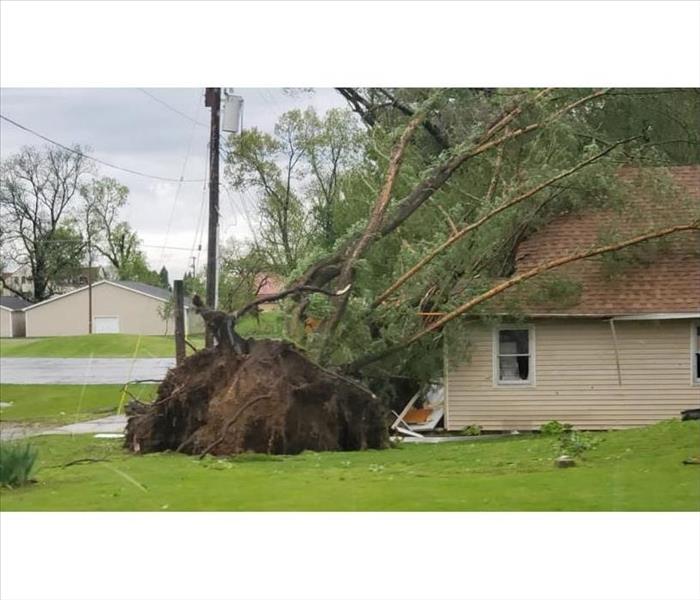 A tree falling on a house
A tree falling on a house
The damage a storm can cause is unsettling for many homeowners. A storm with strong winds and heavy rain can cause tremendous damage to homes that may cause homeowners to react quickly. The days that follow after a huge storm are the most crucial in returning to normalcy. Here are a few tips for homeowners that will help them transition back into their normal day to day lives.
- Remember, stay safe: Avoid power lines and large pools of water. With large pools of standing water mold may and can appear. It would do homeowners good to have professionals come out to access any damages before returning to their homes.
- Document the damage and contact your insurance company: It’s always helpful to have pictures securred of your home before an impending storm. After the storm if your home is safe to enter document any damages and contact your insurance company immediately, they will help you act fast and stop any further damages that may occur.
- Plan, plan, plan: Once you are aware that a storm is coming to your area have a full proof plan that will keep you and your family safe. Have an evacuation plan in motion that you and your family have practiced. Have a safe place where you and your family can go, an expense plan and a plan to get your families life back on track.
During this time of need, make SERVPRO of Virginia Beach your first call to help you and your local insurance agent assess the damage. We will work for you to restore your property and your life to make it "Like it never even happened."
Flood Safety Tips
10/16/2019 (Permalink)
Though we’re nearing the end of hurricane season it still proves beneficial for homeowners to be prepared and aware of all the troubles that comes along with natural disasters.
Hurricane season runs from June 1st to November 30th, during that span of time homeowners could find themselves falling victim to damaging winds and an overflow of rainwater. It is prudent that homeowners are aware of these possibilities and put an action plan into place so that they are able to act fast if and when necessary. Here are a few helpful tips for homeowners everywhere.
- Have an Evacuation Plan - The safety of the homeowner and their family should be first priority. Homeowners should know how to safely leave their home in these circumstances. Homeowners should create a safety plan with their families and practice said plan ahead of the storm.
- Make and Evacuation Kit - Each kit can vary depending on the storm you’re facing, however certain items should always be in an evacuation kit. Items like a flashlight, canned food, water, radios and batteries.
- Stay Away From Pools of Water - If evacuation is necessary for you and your family stray away from flooded streets. Shallow water could also be full of debris that could cause damage your motor vehicle as well as you and your family.
- Have a Cleanup Plan - Even after the water resides and you deem it safe to re-enter your home, it is important that you call a professional to verify the harmful debris and contamination caused by the flooding is completely out.
SERVPRO of Virginia Beach offers 24-hour emergency response services. We understand how to manage the drying process and use the proper equipment and moisture measuring devices. We ensure your home is quickly and thoroughly dried. This helps prevent secondary water damage and allows you to regain control quickly, ensuring your structure and its contents are properly dried, deodorized and protected.
Call SERVPRO of Virginia Beach during your time of need and let us make it "Like it never even happened."
Ways to Spot Frozen Pipes
10/11/2019 (Permalink)
As the weather begins to transition into the colder months there are certain precautions homeowners should begin to take to keep their home safe under freezing conditions.
One of the most common headaches homeowners face during the colder months are frozen pipes.
Have you ever placed a can of soda in the freezer and simply just forgot about it and by the time you realized you forgot the can has already exploded making a mess of your freezer? Well, when water freezes in a pipe, it expands in the same way. If it expands enough, the pipe bursts and water escapes leaving serious damage as a result.
Pipes in attics, crawlspaces, and outside walls are all vulnerable to freezing, especially if there are cracks or openings that allow cold, outside air to flow across the pipes. Holes in an outside wall where television, cable or telephone lines enter can provide access for cold air to reach pipes.
Pipes tend to freeze after consecutive days and nights of freezing (32degrees Fahrenheit) and below freezing temperatures.
Frozen pipes should cause many homeowners concern, for bigger issues may and will arise. If you are unaware of the status of your pipes or what are some clues of a frozen pipe here’s a few signs that may help you.
- A slow stream of water, or no water at all coming through.
- Visible frost on your pipes
- Unusual loud sounds coming from your faucets
- Strange odors coming from your faucets
If any of these signs appear then it likely means your pipes have burst. If this is true, you must act fast, a few things you can do to prevent any further damage.
- This first step is to always shut down your property’s main water supply. (Depending on the amount of water and location, you may want to first turn off electricity.)
- If it’s heated water that’s coming from the broken pipe, you should also close the valve attached to your hot water heater.
- After you’ve shut down the water, call a plumber for help with repairing or replacing the burst pipe.
During this time of need, make SERVPRO of Virginia Beach your first call to help you and your local insurance agent assess the damage. We will work for you to restore your property and your life to make it "Like it never even happened."
Celebrate Safely Virginia Beach
6/25/2019 (Permalink)
 Happy Fourth of July from SERVPRO of Virginia Beach
Happy Fourth of July from SERVPRO of Virginia Beach
The fourth of July is a time to celebrate with friends and family at a barbeque or picnic. With traditions like fireworks and bonfires, there may be some potential dangers along the way. In order to celebrate safely when it comes to these events, consider the following tips provided by the US Fire Administration.
- The best way to enjoy fireworks is to view pubic fireworks displays put on by professionals.
- If you plan to use fireworks, ensure they are legal in your area.
- Always read the directions and warning labels on fireworks. If a device is not marked with the contents, directions and a warning label, do not light it.
- Supervise children around fireworks at all times.
- Stand several feet away from lit fireworks. If a firework does not go off, do not stand over it to investigate. Pour water over it and dispose of it.
More July Fourth Safety Tips:
- Never light fireworks indoors or near dry grass.
- Keep a bucket of water and/or fire extinguisher nearby. Know how to operate the fire extinguisher properly.
- Do not wear loose clothing while cooking at a barbeque.
- Use caution when using lighter fluid on a barbeque. Do not add fluid to an already lit fire, as the flame can flashback into the container and explode.
- Never grill in an enclosed area, as carbon monoxide could be produced.
Sources: SERVPRO Restoration Newsline, Volume 30, Issue 7; National Fire Protection Association
SERVPRO of Virginia Beach Owner Explains When and Why You Should Hire a Professional After a Water Damage
5/14/2019 (Permalink)
The thing about water damage and repair professionals is that no one seems to have interest in knowing one until they're in desperate need of their help! We interviewed SERVPRO of Virginia Beach Franchise Owner, Anna Cheracles, to find out just what it is that a restoration professional does and when and why someone would need to hire one. Here's what Anna had to say:
What exactly does a water damage and repair professional do?
We arrive onsite within 4 hours (usually 1 hour) to remediate a water damage. The sooner you can stop the water and begin to dry the structure, the less damage you will have, which will reduce repairs that will need to be done.
Why is it important to call a professional?
We can restore vs. replace. We have special drying techniques which will save time and money for the insured and insurance company. You don't want to end up with any type of secondary damage or mold that could be prevented by calling a professional right away.
A professional will know when it is necessary to remove materials such as vinyl or laminate floors in order to dry sub floors. We have tools, such as moisture meters, that can detect exactly what's been affected so that we can properly mitigate the loss.
What are the most common problems water damage professionals see?
We often find pre-existing damage. It is important to properly maintain your home so that dry rot or other slow leaks do not occur. If you have a pipe burst under your sink, but you have dry rot already showing on you sub floor, often the insurance companies will not cover this due to the home not being maintained.
Another problem we see is when a homeowner does not take immediate action. They will wait a few days for the insurance company to come out before they call a mitigation company to come out. Or they try to do the work themselves. This will only prolong the process and possibly cause more damage later on. You need special equipment to properly dry a structure.
When should I call a water damage professional?
Anytime you experience a water damage, you should call a professional. The sooner you call, the more you can minimize damage. Even if the cause of the problem is still not fixed, the faster we can begin extracting water, you can lessen the chance of further damage. Often times an area can feel dry to the touch, but it is important to have a professional use a moisture meter to check for water behind cabinets, walls, etc. Dry wall may feel dry, but the insulation inside the wall could possibly be wet. Carpet could feel dry, but the sub floor and padding could have elevated moisture levels.
How much will it cost?
We use industry standard prices, which are set for each region in the country through a program called Xactimate. Most of the charges are done by square foot, by a labor hour or per piece of equipment. It is pricey to properly mitigate your home, but if you do it right the first time, you won't have mold grow and will save money in the long run. We deal directly with the insurance companies so there will not be any type of paperwork that you will need to file. We take care of it all!
What should I do while waiting?
If possible, turn the source of the water off. Begin mopping up water or blotting with towels. DO NOT use a shop vac to remove water. Shop vacs are not meant to extract a lot of water, only a little bit here and there. Put all furniture up on blocks, or even put foil under the legs of furniture to protect it and to also protect your carpet from getting any staining on it. You should also wipe up any water on wood furniture so it does not ruin it. Do not use electrical devices where the moisture is present. Make sure to not stand under any sagging ceilings.
How do I decide who to hire?
You should always try to hire someone who has a national reputation and a brand that stands behind them. Take advice from your insurance company, they work with these professionals everyday and should have a good recommendation.
Virginia Beach Smoke and Soot Facts
5/13/2019 (Permalink)
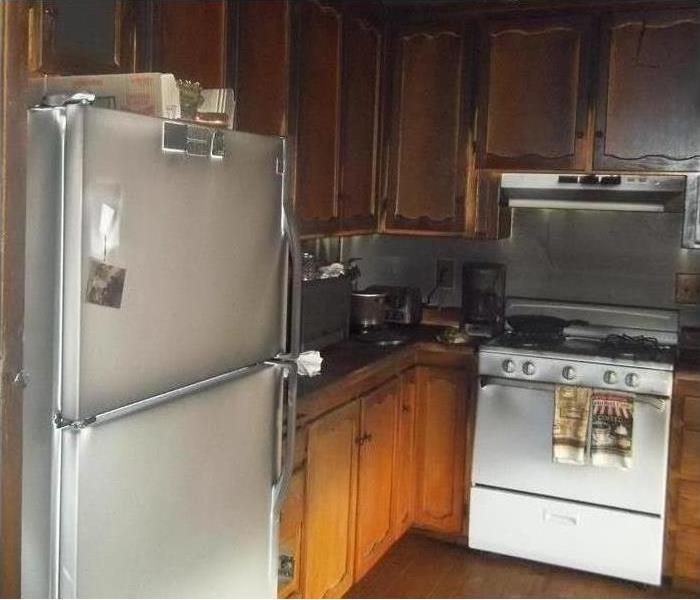 Smoke and soot damage from a kitchen fire
Smoke and soot damage from a kitchen fire
Smoke and soot from a fire is very invasive and can penetrate various cavities within your home, causing hidden damage and odor. SERVPRO of Virginia Beach’s smoke damage expertise and experience allows us to inspect and accurately assess the extent of the damage to develop a comprehensive plan of action.
Smoke and soot facts:
- Hot smoke migrates to cooler areas and upper levels of a structure
- Smoke flows around plumbing systems, seeping through the holes used by pipes to go from floor to floor
- The type of smoke may greatly affect the restoration process
Different Types of Smoke
There are two different types of smoke–wet and dry. As a result, there are different types of soot residue after a fire. Before restoration begins, SERVPRO of Virginia Beach will test the soot to determine which type of smoke damage occurred. The cleaning procedures will then be based on the information identified during pretesting. Here is some additional information:
Wet Smoke – Plastic and Rubber
- Low heat, smoldering, pungent odor, sticky, smeary. Smoke webs are more difficult to clean
Dry Smoke – Paper and Wood
- Fast burning, high temperatures, heat rises therefore smoke rises
Protein Fire Residue – Produced by evaporation of material rather than from a fire
- Virtually invisible, discolors paints and varnishes, extreme pungent odor
Our Fire Damage Restoration Services
Since each smoke and fire damage situation is a little different, each one requires a unique solution tailored for the specific conditions. The professionals at SERVPRO of Virginia Beach have the equipment, expertise, and experience to restore your fire and smoke damage. We will also treat your family with empathy and respect and your property with care.
Have Questions about Fire, Smoke, or Soot Damage? Call SERVPRO of Virginia Beach at 757-431-1400.
Be Flood Smart in Virginia Beach
4/25/2019 (Permalink)
Floods are one of the most common and widespread natural disasters in the United States. Here in Virginia Beach, most of us have had to deal with flooded streets, yards and neighborhoods at one time. Whether your home or business is in a flood zone or not, there is always potential for flood damage. Flooding can occur near a coastline like in the Hampton Roads area, along city streets, in the mountains, near a river or even in the desert. Floodsmart.gov reports that in the last five years, all 50 states have experiences floods or flash floods.
Here are a few important tips from the American Red Cross to always follow:
- Stay away from floodwaters. If you come up on a flowing stream where water is above your ankles, stop, turn around and go another way. Six inches of swiftly moving water can sweep you off your feet.
- If you approach a flooded road while driving, turn around and go another way. If you are caught on a flooded road and waters are rising rapidly around you, get out of the car quickly and move to higher ground. Most cars can be swept away by less than two feet of moving water.
- Keep children out of the water. They are curious and often lack judgment about running or contaminated water.
If a flood strikes your home or business, contact the professionals at SERVPRO of Virginia Beach. Even minor flooding has the potential to cause major damage to a structure when not treated quickly and properly. The cleanup is often an overwhelming task, but our team is prepared to handle any size disaster.
Do You Have Dirty Ducts? Improve Your Indoor Air Quality in Virginia Beach with Duct Cleaning
4/23/2019 (Permalink)
Spring is a great time to be thinking about your air ducts. Over time, contaminants and foreign objects can collect in your ducts which can diminish your air quality or cause other damages to the heating, ventilation and air conditioning unit (HVAC) of your home or building. Keeping the HVAC system and ductwork clean can extend the life of the equipment by allowing it to operate more efficiently, which can help save you money. Dirty ducts can circulate odors, contaminants like mold and irritating dust within your structure.
Inspecting the HVAC system is a service offered by SERVPRO of Virginia Beach. We use a portable ventilation and air duct cleaning system to remove years of dust and grime.
In some circumstances, such as after a fire, smoke or suspected mold growth, duct cleaning may become an essential part of the cleanup process. In these cases, SERVPRO of Virginia Beach can often restore the HVAC system and ductwork to pre-damage condition.
The SERVPRO system can help:
- Remediate bacteria, fungi and mold
- Reduce potential for mold growth
- Restore peak energy efficiency
- Eliminate offensive odors
- Provide free written inspections and estimates
Call SERVPRO of Virginia Beach today to help protect your health and property from ventilation and air quality issues at 757-431-1400.
Virginia Beach Biohazard, Vandalism and Crime Scene Remediation and Cleanup
4/23/2019 (Permalink)
Exposure to biological and chemical contaminants can pose serious health consequences for building occupants. Failure to property handle and safely remove such substances can contribute to unhealthy or even dangerous environments.
SERVPRO of Virginia Beach professionals are trained to effectively and safely remove hazardous biological substances and prepare waste for proper disposal. Equipped with the needed safety equipment and cleaning products, SERVPRO of Virginia Beach can turn unsafe environments into clean, safe homes and businesses.
Bloodborne Pathogens
SERVPRO of Virginia Beach technicians remove and dispose of bodily fluids, tissue and other potentially pathogenic substances resulting from accident, trauma, crime or death. Our professionals are trained to thoroughly clean, disinfect and deodorize the structure.
Methamphetamine Labs
Many of the chemicals used in the production of illegal drugs, such as methamphetamine, are volatile and can leave harmful residues throughout a structure. SERVPRO of Virginia Beach follows all applicable federal and state guidelines to clean all surfaces.
Arson and Vandalism
SERVPRO of Virginia Beach provides general cleaning and deodorization services for situations resulting from vandalism including graffiti, egg, spoiled foods and human or animal waste.
Sewage Backup
Sewage backups and black water intrusions are more than nasty, smelly deposits. These damages also introduce harmful microorganisms into a structure. SERVPRO of Virginia Beach technicians remove the sewage, contaminants and moisture, disinfecting as they clean. Our professionals ensure the structure is cleaned, disinfected and deodorized.
Recognized as a leading fire and water cleanup and restoration provider, SERVPRO of Virginia Beach offers fast and reliable biohazard, vandalism and crime scene cleanup and remediation services to residential and commercial property owners. Give us a call at 757-431-1400.
SERVPRO of Virginia Beach Storm Team is Ready to Travel
3/25/2019 (Permalink)
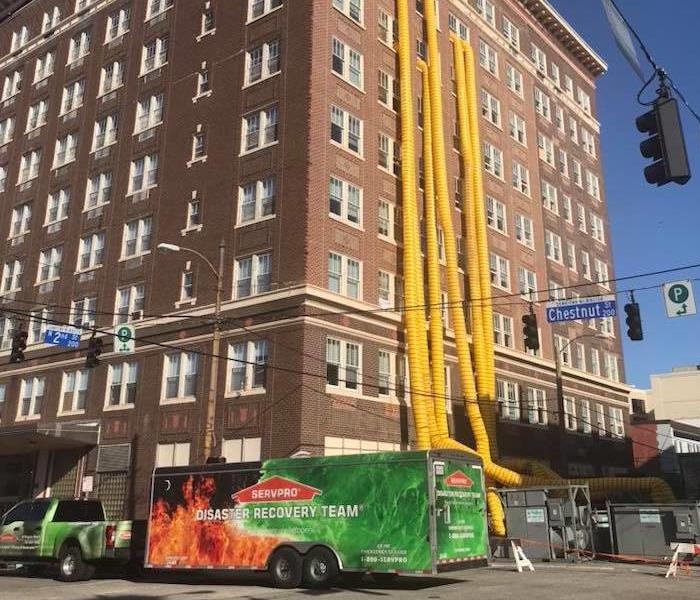 SERVPRO of Virginia Beach Storm Team working in Wilmington, NC in 2018
SERVPRO of Virginia Beach Storm Team working in Wilmington, NC in 2018
The SERVPRO Disaster Recovery Teams provide help to local franchises when a tornado, hurricane, blizzard or flood disaster strikes. SERVPRO of Virginia Beach has been a part of these storm teams since their inception. We traveled to Alabama after Hurricane Katrina in 2005 and in November 2009 franchises from Pennsylvania came to assist us with claims from a Nor’easter that hit and caused record amounts of flooding in Hampton Roads. In 2011 and 2013, SERVPRO of Virginia Beach assisted with microburst flooding in Northern Virginia. In August of 2016, we expanded our storm teams and dispatched 4 crews to Louisiana to assist with flooding cleanup for 2 weeks. In 2017, we dispatched another 4 crews to Texas for 3 weeks to help after Hurricane Harvey. In the spring and summer of 2018, we went to Maryland, Northern Virginia and Pennsylvania to assist with microbursts and localized flooding events when the job load was too much for the local franchises to handle. Our most recent storm activity was assisting after Hurricane Florence caused devastating damage in North Carolina; we sent 4 crews on September 16th and stayed until January 2019 to complete jobs. Available 24 hours a day and 365 days a year, SERVPRO of Virginia Beach is prepared for the unpredictable and available to travel with any of the 4 storm teams at a moment’s notice.
SERVPRO Spotlight: Anna Cheracles
2/22/2019 (Permalink)
As a second-generation owner, Anna has held almost every position within the company since she began working at SERVPRO of Virginia Beach. Before SERVPRO, Anna attended Old Dominion University, had a few jobs between high school and college, including managing a couple local tanning salons, while working part time at SERVPRO until 2007, when she came on board full time to learn how to run the business.
Anna is currently running the franchise as the General Manager, alongside operations manager, Jason Cheracles, her husband. Together they have grown the business with a wonderful team consisting of their office team (lead by her sister, Katie Anderton and office manager, Lisa Corley); a phenomenal marketing division and amazing production team of extremely hard-working technicians and managers.
Anna says, “Each and every person serves a very important role in making sure that our SERVPRO franchise is successful. From the very first phone call into the office about a new loss, to the production technician performing the work and all the way to the accounts receivable team collecting the money at the end and leaving us with a happy and 100% satisfied customer. Our customers don’t ask for these water/fire/mold losses to occur, so we do our best to put their lives and homes back together as quickly and effectively as possible, while trying to make a bad experience a less stressful one. It’s a hard job, but by having the right, positive people on our team, we make it work.”
Anna learned everything show knows from her parents, Bob and Beth Simeone, who started the Virginia Beach franchise in 1991. She has grown up in the business and enjoys seeing how her team helps people each and every day. Anna’s interest is not only on the customers, but on the employees as well. It has been fun for her to see so many people grow into their career and personal lives while they are working with the SERVPRO family.
While not working at the office, Anna enjoys spending her time with her husband Jason, and their three children; Ray, Maddox and Charlee. She loves watching her son Maddox play keeper for his Tsunami soccer team, which have been together for the past 4 years, growing from recreational soccer, all the way up to division 1 travel. She also enjoys watching (and listening) to her daughter Charlee play the piano. Her step-son Ray, who just turned 16, keeps her on her toes. She has loved seeing him grow into a young adult during his teenage years.
Anna and Jason also have two dogs: an 11-year-old Shih Tzu named Bella (who also serves as the SERVPRO office guard dog) and 3 year old Australian Shepherd, Molly.
At the end of the day, Anna loves that her family gets to work together every day. They get to share in each other’s successes and build a company together that truly believes in their mission statement, which is “to develop an accountable team of caring people who are committed to excellence and focus on quality service by being honest, fair and enthusiastic in their work.” By following this mission statement, SERVPRO of Virginia Beach has been able to build an incredible team of individuals that care about the work they do, and the customers that are affected by their actions.
Water Damage Statistics for Virginia Beach
1/11/2019 (Permalink)
Water Damage Statistics
Water damage covers a broad range of potential loss. Homeowners understand that wear and tear will occur in any circumstance; however, there are a variety of unforeseen events that may trigger water damage. Natural disasters are often given the most blame for water damage, and they should, considering that the majority of damages due to water stem from some sort of outside environmental factor.
Nevertheless, water damage may come in a variety of forms. Understanding the sources of this type of damage is important to not only potentially preventing an incident, but more importantly, to understand where you stand in the eyes of your insurance provider. Water damage in homes most typically comes from the following causes:
- Frozen pipes
- Leaking pipes
- Leaky roof
- Broken washing machine hose
- Plumbing problems
- Insulations issues
The water damage statistics below will highlight the widespread nature of this issue. While many people do not view this as a common occurrence, water damage accounts for a significant number of homeowners insurance claims. The following are some of the most interesting water damage statistics:
- Almost 40 percent of all homeowners have said that they have experienced loss from water damage
- About 93 percent of all water damage can be prevented
- Water damage is the second most frequently filed insurance claim in the United States
- 250 gallons of water is released a day due to a 1/8-inch crack in a pipe
- About 20 percent of all insurance claims related to water damage of some kind
- Billions of dollars in property losses are spent each year as a direct result of water damages
Those homeowners with an understanding of the prospective damages associated with water are much more likely to stop problems before they become major issues. Hopefully these water damage statistics were able to shed some light on the vast complications that may arise from water in the home. If you or your family has experienced water damage and are looking to file a claim, contact Arguello, Hope & Associates for more information.
To get started today, simply fill out a Free Case Review form on this page.
Water Damage Insurance Coverage
First and foremost, homeowners must maintain an understanding of exactly what is and is not covered under their current insurance policy. Without this knowledge, homeowners will be left in shock when disaster strikes and they must pay for these damages out of pocket. Besides purchasing a flood policy for protection, you may be able to add coverage to your existing policy. These additions may cover things such as the following:
- Mold remediation (varies on state)
- Backup of drains or sewers
- Plumbing water damage
- Air conditioning damages
- Water heater damage
Homeowners must be astute in recognizing water damage as early as possible. When a sudden storm, plumbing issue, or sewer backup occurs, knowing what will be covered will ease stress and make the entire repair process much more fluid. To find out more, contact SERVPRO of Virginia Beach at 757-431-1400.
Virginia Beach Tornado Facts
1/10/2019 (Permalink)
Most violent tornadoes come from supercells, large thunderstorms that have winds already in rotation. About one in a thousand storms becomes a supercell, and one in five or six supercells spawns off a tornado. Tornado season begins in early spring for the states along the Gulf of Mexico. The season follows the jet stream—as it swings farther north, so does tornado activity. May generally has more tornadoes than any other month, but April's twisters are usually more violent. Although they can occur at any time of the day or night, most tornadoes form in the late afternoon. By this time the sun has heated the ground and the atmosphere enough to produce thunderstorms. Tornadoes form when warm, humid air collides with cold, dry air. Twisters are usually accompanied or preceded by severe thunderstorms and high winds. Hail is also common. Once a tornado hits the ground, it may live for as little as a few seconds or as long as three hours.
What is a State of Emergency for Hampton Roads: A state of emergency allows state agencies to perform actions, that normally would not be permitted, in the interest of quickly getting assistance to local governments, and in turn Virginia residents.
SERVPRO of Virginia Beach is well-versed to handle all Tornado damage in Hampton Roads, 24 hour, 365 days a year emergency for any residential or commercial location in the Hampton Roads area. We have Class “A” Subcontractors standing by and ready to assist in any emergency. We can provide you with one-stop shopping. Leave the hassle of repairing the damage to the Professionals at SERVPRO of Virginia Beach and make it “Like it never even happened.”, call us 757-431-1400 to ensure no further damage occurs to the structure or your contents.
Pipes Freeze in Virginia Beach
1/2/2019 (Permalink)
If you need a plumber this year, don’t worry…you are NOT alone. Frozen pipe season is upon us. If you live in a older home, the risk of encountering frozen pipes is increased however, it can happen to anyone because when water freezes, it expands and non-insulated pipes are more likely to burst or leak. A burst pipe can cause extraordinary damage if not handled immediately so in order to prevent pipes from freezing here are a few steps that you as a homeowner can take according to The American Red Cross:
- Be sure to completely drain water from sprinkler lines as well as outside hoses
- Open all of your Kitchen cabinets to let warm air circulate around the plumbing
- Let water drip from your faucets
- Keep your heat set to the same temperature both day and night
SERVPRO of Virginia Beach professionals are available 24-hours a day, 365 days a year. Call us if your pipe’s freeze this winter and we will make it “Like it never even happened." 757-431-1400
MOLD in Virginia Beach: What are the 5 MOST TOXIC TYPES?
1/2/2019 (Permalink)
Ascospores are prominent in nature commonly found in the outdoor environment. Some fungi that belong to the Ascomycete family include the sexual forms of Penicillium/Aspergillus, Chaetominum, etc that may be frequently found growing on damp substrates.
Chaetomium are found on a variety of substrates containing cellulose including paper and plant compost. Several species have been reported to play a major role in the decomposition of cellulose-made materials. These fungi are able to dissolve the cellulose fibers in cotton and paper and thus cause the materials to disintegrate. The process is especially rapid under moist conditions. Their Ascospores are brown or gray with one or two germ pores.
Fusarium is a hydrophilic mold that requires very wet conditions and is frequently isolated from plants and grains. They colonize in continuously damp materials such as damp wallboard and water reservoirs for humidifiers and drip pans. While Fusarium Keratitis can be a serious infection, it is a rare disease. Fusarium is commonly found in organic matter such as soil and plants. This infection cannot be transmitted from person to person.
Aspergillus and Penecillium are both types of mold are ubiquitous in the environment. Aspergillus tends to colonize continuously damp materials such as damp wallboard and fabrics. Penicillium is commonly found in house dust, wallpaper, decaying fabrics, moist clipboards, etc.
Stachybotrys is the bad boy of them all
Stachybotrys, commonly called "stachy," is a greenish-black, slimy mold found only on cellulose products (such as wood or paper) that have been wet for several days or more. The mold does not grow on concrete, linoleum or tile. Stachybotrys and some other fungi may produce several toxic chemicals called mycotoxins. Mycotoxins can be present in spores and small mold fragments released into the air. Once the mold fragments, mycotoxins and spores are in the air, individuals may breathe them into their lungs.
10 Tips For Dealing With Insurance Coverage Hurricane Losses in Virginia Beach
1/2/2019 (Permalink)
When hurricanes hit, many insureds have to scramble just to preserve lives, their facilities, and their properties. Insurance coverage is not often the first consideration, but it can be an important one for rebuilding a home or business. Insureds should adopt practical approaches that can help ensure that they obtain the full extent of insurance coverage available for hurricane related losses. Here are 10 tips:
KNOW YOUR POLICIES
Know how policy provisions work together and when coverage starts, for example, from actual physical inception of loss or from a specified time before a hurricane arrives.
NOTIFY THE INSURERS AS SOON AS POSSIBLE
Have methods in place to reach out to insurers as soon as it becomes apparent that there is, or may even be a loss.
KEEP CRITICAL DOCUMENT COPIES IN SEPARATE LOCATIONS
Keep insurance policies or copies, including endorsements, in safe, separate locations. Electronic copies should be considered and always backed up on site. Video documentation helps.
WATCH THE ATTORNEY/CLIENT PRIVILEGE
Remember that in many jurisdictions, communications with an insurance broker are not necessarily subject to the attorney/client privilege.
CHECK PROVISIONS REGARDING ADJUSTMENT EXPENSES
Many policies provide that loss adjustment expenses may be insured. There are limitations on this coverage, however, including dollar limitations and in many instances, limitations that preclude or limit coverage if professionals providing loss-adjustment services are also serving in the role as an "advocate" for coverage.
DOCUMENT LOSSES
Maintain detailed records of various losses and expenses incurred in dealing with the claim.
POLICIES FOR DEADLINES AND OTHER TIME STAMPS
Many policies require that proofs of loss be provided within a period of days (often 30, 60 or 90 days) from inception of the loss. Policies also typically contain contractual limitations, that is, provisions that require that any suit be instituted within a specific period (often one or two years) from inception of the loss. In case of doubt, obtain a written agreement with the insurer extending or waiving the period, and make sure that the agreement is enforceable under the controlling law.
COMPLY WITH EXAMINATION UNDER OATH REQUESTS
Most policies require the insured's submit to an examination under oath. In most jurisdictions, examination under oath requirements are strictly enforced and failure to comply may result in a loss of coverage.
SEEK PROFESSIONAL ADVICE
Consult with accountants and insurance restoration specialists, as well as others with experience in dealing with hurricane losses, valuation, and business interruption questions.
DO NOT TAKE "NO" FOR AN ANSWER
At least, do not take no for an answer without checking and verifying. States vary in how the determination is made as to what law governs a given policy of a given loss. Furthermore, insurers act in good faith but out of town adjusters may not know the state law, the drafting history behind the language in their policies, or all of the case law and arguments that can be made for coverage that might not be apparent in the first instance.
Virginia Beach's Only 5000 CFM Commercial Drying Trailer
1/2/2019 (Permalink)
Introducing our 5000 CFM Commercial Drying Trailer - Here to save you time, money and make it "Like it never even happened."!
At SERVPRO of Virginia Beach, our mission is to be the premier fire and water restoration contractor in Hampton Roads. To do so, we are continuously training our staff and updating our procedures to stay current within our industry. We are very excited to introduce this state of the art piece of equipment and announce that we are the ONLY restoration contractor in Hampton Roads to own it!
This commercial trailer houses a 5000 CFM Desiccant, capable of drying a medium to large commercial building, and a 150kw Generator. Together, this trailer of equipment can conveniently save both time and money when it matters most.
For more information, contact SERVPRO of Virginia Beach at (757) 431-1400.
Different Causes of Commercial Water Loss in Virginia Beach
11/23/2018 (Permalink)
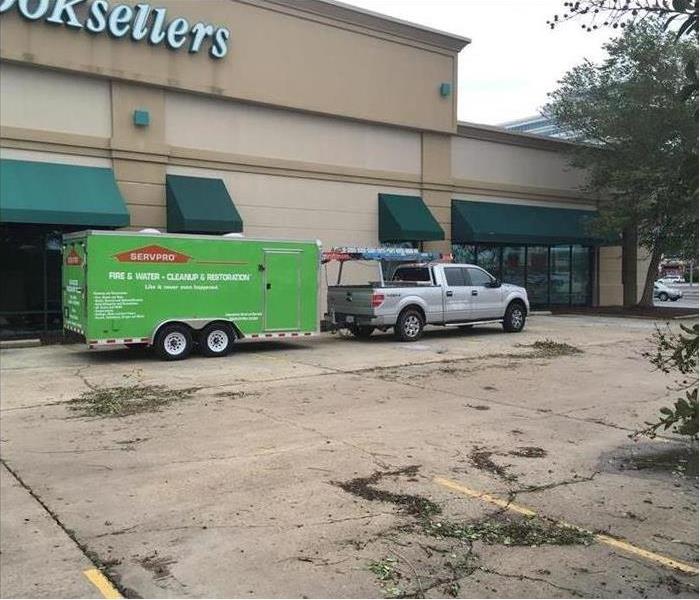
When business owners visualize water damage, they often picture a massive storm wiping out power lines, flooding offices, and shutting down businesses for days at a time. It is true that commercial water damage is often the result of floods and water that stems from weather events and storms.
However, many entrepreneurs and business space renters forget that storms and severe weather aren't the only causes of floods and water damage. Here are some of the typical causes of water damage to commercial buildings.
1. Malfunctioning sprinkler systems
Some older office and retail buildings still have outdated sprinkler systems that work in conjunction with fire protection systems. While such sprinklers can come in handy during a fire emergency, they can also cause commercial flood damage if they are faulty or in need of replacement. This could easily damage inventory and business assets.
2. Damaged appliances and equipment
This cause of commercial flood damage is more common in restaurants and catering facilities, as well as any business that has appliances and equipment that make use of water. If the appliance fails and sends water across your building, especially during late hours when no one is around, you may come back to work and face a water emergency.
3. Broken pipes and plumbing
Just like in a residence, if the plumbing system in your workplace fails water damage could be the result.
4. Backed up sewer lines
This is another cause of commercial water damage that often catches business owners by surprise. Should the sewer line to your building back up or become damaged, realize the potential dangers of contaminated Black Water which can cause health effects and ruin products and office furnishings.
If your business has suffered commercial water damage, SERVPRO of Virginia Beach will get you back up and running again "like it never even happened". Give us a call at 757-431-1400.
Virginia Beach Water Loss in a Commercial Building
11/23/2018 (Permalink)
When a water event occurs in your property, damage to the structure and contents can occur. The type of water that affects a building includes:
Category 1 water originates from a sanitary water source and does not pose substantial risk from dermal, ingestion, or inhalation exposure. In most cases drying procedures are recommended.
Category 2 water contains significant contamination and has the potential to cause discomfort or sickness if contacted by people. For this category, environmental interpretation is critical as drying for some materials is acceptable while removal of others must occur
Category 3 water is grossly contaminated and can contain pathogenic, toxigenic or other harmful agents. In most cases removal is necessary and environmental remediation is necessary.
When a water event occurs a water extraction contractor is generally hired to remove the water. However, the ability of the contractor to identify the water category, deal with the issues of health and safety properly as well as remove or dry out the affected building materials and contents can vary greatly.
Assessment for water damage independently of the water removal contractor ensures that the project is dealt with relative to the category of water, health and safety concerns are identified and controlled and their work product is validated.
Mold Behind Wallpaper
11/23/2018 (Permalink)
Mold behind wallpaper is a big health concern. To get rid of the mold you must remove the wallpaper. First and foremost remove the wallpaper safely by wetting it with a wetting agent and water. But first wear a good cartridge-type respirator.
When removing mold behind wallpaper safely wet it first. Even if the wallpaper removes dry still wet it
A simple dust or particulate mask won't offer adequate protection. Also wear gloves and goggles, remember safety first. In a garden type sprayer add the wetting agent and water for easy application.
Using the sprayer to wet the wallpaper down will reduce the mold spores from becoming airborne. Even if the wallpaper removes dry still wet it first. Move slowly and deliberately so you don't stir up spores as you work.
Once the wallpaper is removed from the walls the next step is to wash the walls down with a water and bleach solution. This should remove the mold from the walls if it is just surface mold. If the walls are soft and spongy the mold may have penetrated deeper into the wall.
One way to tell if the walls are totally saturated with mold you can take a utility knife and cut a small square out of the wall and look at the back side of the square. If there is mold behind the wall then you should replace the walls. If you plan on wallpapering again use a Nonwoven wallpaper so you will never get mold behind wallpaper again. Nonwoven wallpapers can breath unlike vinyl wallpapers.
Virginia Beach Mold Removal and Remediation
11/23/2018 (Permalink)
Any home or business can quickly become infested with mold with the introduction of a water source, like a roof or plumbing leak. Mold can spread throughout a property in as little as 48-72 hours, and can produce allergens and irritants that have the potential to cause other health effects.
If you suspect that your home or business has a mold problem, SERVPRO of Virginia Beach can inspect and assess your property. If mold is found, they have the training, equipment, and expertise to handle the situation.
SERVPRO of Virginia Beach
- Provide 24/7 Emergency Service
- Highly Trained Water Restoration Specialists
- Faster to Any Size Disaster
- A Trusted Leader in the Restoration Industry with over 1,700 Franchises
If You See Signs of Mold, Call SERVPRO of Virginia Beach 757-431-1400.
Understanding Mold
Microscopic mold spores exist almost everywhere, outdoors and indoors, making it impossible to remove all mold from a home or business. Some restoration businesses advertise “mold removal” and even guarantee to remove all mold, which is a fallacy. Consider the following mold facts:
- Mold is present almost everywhere, indoors and outdoors.
- Mold spores are microscopic and float along in the air, and may enter your home through windows, doors, or AC/heating systems or even hitch a ride indoors on your clothing or on a pet.
- Mold spores thrive on moisture. Mold spores can quickly grow into colonies when exposed to water.
- Before mold remediation can begin, any sources of water or moisture must be addressed. Otherwise, the mold may return.
- Mold often produces a strong, musty odor and can lead you to possible mold problem areas.
- Even higher-than-normal indoor humidity can support mold growth. Keep indoor humidity below 45 percent.
Common Mold Misconceptions
With sensational news stories and misleading advertising, you can easily understand why so many people are misinformed about indoor mold. Learn the facts about mold and the mold remediation process.
Basic Mold Facts For Virginia Beach
11/23/2018 (Permalink)
What are molds?
Molds are fungi that can be found both indoors and outdoors. No one knows how many species of fungi exist but estimates range from tens of thousands to perhaps three hundred thousand or more. Molds grow best in warm, damp, and humid conditions, and spread and reproduce by making spores. Mold spores can survive harsh environmental conditions, such as dry conditions, that do not support normal mold growth.
What are some of the common indoor molds?
- Cladosporium
- Penicillium
- Alternaria
- Aspergillus
Where are molds found?
Molds are found in virtually every environment and can be detected, both indoors and outdoors, year round. Mold growth is encouraged by warm and humid conditions. Outdoors they can be found in shady, damp areas or places where leaves or other vegetation is decomposing. Indoors they can be found where humidity levels are high, such as basements or showers.
How can people decrease mold exposure?
Sensitive individuals should avoid areas that are likely to have mold, such as compost piles, cut grass, and wooded areas. Inside homes, mold growth can be slowed by controlling humidity levels and ventilating showers and cooking areas. If there is mold growth in your home, you should clean up the mold and fix the water problem. Mold growth can be removed from hard surfaces with commercial products, soap and water, or a bleach solution of no more than 1 cup of household laundry bleach in 1 gallon of water. Follow the manufacturers’ instructions for use (see product label).
If you choose to use bleach to clean up mold:
- Never mix bleach with ammonia or other household cleaners. Mixing bleach with ammonia or other cleaning products will produce dangerous, toxic fumes.
- Open windows and doors to provide fresh air.
- Wear rubber boots, rubber gloves, and goggles during cleanup of affected area.
- If the area to be cleaned is more than 10 square feet, consult the U.S. Environmental Protection Agency (EPA) guide titled Mold Remediation in Schools and Commercial Buildings.
- Always follow the manufacturer’s instructions when using bleach or any other cleaning product.
Specific Recommendations:
- Keep humidity levels as low as you can—no higher than 50%–all day long. An air conditioner or dehumidifier will help you keep the level low. Bear in mind that humidity levels change over the course of a day with changes in the moisture in the air and the air temperature, so you will need to check the humidity levels more than once a day.
- Use an air conditioner or a dehumidifier during humid months.
- Be sure the home has adequate ventilation, including exhaust fans.
- Add mold inhibitors to paints before application.
- Clean bathrooms with mold killing products.
- Do not carpet bathrooms and basements.
- Remove or replace previously soaked carpets and upholstery.
What areas have high mold exposures?
- Antique shops
- Greenhouses
- Saunas
- Farms
- Mills
- Construction areas
- Flower shops
- Summer cottages
I found mold growing in my home, how do I test the mold?
Generally, it is not necessary to identify the species of mold growing in a residence, and CDC does not recommend routine sampling for molds. Current evidence indicates that allergies are the type of diseases most often associated with molds. Since the susceptibility of individuals can vary greatly either because of the amount or type of mold, sampling and culturing are not reliable in determining your health risk. If you are susceptible to mold and mold is seen or smelled, there is a potential health risk; therefore, no matter what type of mold is present, you should arrange for its removal.
A qualified environmental lab took samples of the mold in my home and gave me the results. Can CDC interpret these results?
Standards for judging what is an acceptable, tolerable, or normal quantity of mold have not been established. If you do decide to pay for environmental sampling for molds, before the work starts, you should ask the consultants who will do the work to establish criteria for interpreting the test results. They should tell you in advance what they will do or what recommendations they will make based on the sampling results. The results of samples taken in your unique situation cannot be interpreted without physical inspection of the contaminated area or without considering the building’s characteristics and the factors that led to the present condition.
Severe Weather Facts and Myths for Virginia Beach
11/23/2018 (Permalink)
Myth: Highway and interstate overpasses are safe shelters against a tornado.
Fact: Overpasses can concentrate the tornado winds, causing them to be significantly stronger. This places the people under them in an even more dangerous situation. In recent years, several people seeking shelter beneath overpasses have been killed or severely injured. Being above ground level during a tornado is dangerous.
Myth: The low pressure with a tornado causes buildings to explode. Opening the windows will equalize the pressure, saving the building.
Fact: Opening the windows in an attempt to equalize pressure will have no effect. It is the violent winds and debris that cause most structural damage. It is more important for you to move to a safe area away from windows and exterior walls. With a tornado, every second counts, so use your time wisely and take cover.
Myth: Thunderstorms and tornadoes always move from west to east.
Fact: More often than not, thunderstorms move from west to east. Conditions in the atmosphere dictate how and where storms will move, and it can be in any direction. Tornadoes have been known to act erratic, and can change directions and speed very quickly. Never try to outrun a tornado in a vehicle.
Myth: It’s not raining here, and skies above me are clear, therefore I am safe from lightning.
Fact: Lightning can strike many miles away from the thunderstorm. If storms are in your area, but skies happen to be clear above you, that certainly does not imply you are safe from lightning. Though these “Bolts from the Blue” are infrequent, lightning strikes 10 to 15 miles away from the storm are not out of the question.
Myth: Since I am inside my house and out of the storm, I am completely safe from lightning.
Fact: Just because you have taken shelter inside, you are not automatically safe. While inside waiting out a storm, avoid using the telephone or electrical appliances and do not take showers or baths. Also stay away from doors and windows. Telephone lines, cords, plumbing, even metal window and door frames are all lightning conductors and pose a threat
Myth: Large and heavy vehicles, such as SUVs and pickups, are safe to drive through flood waters.
Fact: It is a common belief that the larger the vehicle, the deeper the water it can drive through. Many people do not realize that two feet of water can float most vehicles, including SUVs and pickups. If the water is moving rapidly, vehicles can be swept away.
Myth: Flash floods only occur along flowing streams.
Fact: Flash floods can and do occur in dry creek or river beds as well as urban areas where no streams are present.
Virginia Beach Storm Facts, Tips & Safety
11/23/2018 (Permalink)
Severe Thunderstorm Facts
Thunderstorms are defined as storms that produce thunder and lightning. Severe thunderstorms may also produce:
- Rain
- High winds
- Sleet or snow
It’s important to note that thunderstorms do not always produce moisture. A storm in which you see lightning and hear thunder but never feel a drop of water is known as a “dry” thunderstorm. Thunderstorms that produce hail and tornadoes are known as “supercell” storms. Storms occur either in clusters or lines; therefore, they may present as a single thunderstorm or as multiple thunderstorms hitting one after the other.
Causes
Thunderstorms are caused when moisture from the lower or mid-level part of the atmosphere mixes with warm, unstable air from the ground. Moisture and air then push upwards into the higher atmosphere to form clouds that produce thunder and lightning, as well as potential precipitation. Spring, summer and fall are most conducive to thunderstorms because the sun heats the ground and moisture is more perceptible in the air, especially in humid climates.
Thunderstorms must also be lifted to begin their formation. Some sources of lift include:
- More heat on the ground than in the air
- Changes in atmospheric conditions near mountains
- Weather front changes caused by clashing cold and hot air
- Drylines, or when moist and dry air clash
- Land or sea breezes
Any of these situations can immediately create a thunderstorm without warning, even in the middle of a clear blue day. In many cases, these storms will also be accompanied by lightning. Most will not come with hail or tornadoes, unless they occur in tornado-prone states such as Kansas, Oklahoma, Texas and Missouri.
Return to Top
Thunderstorm Statistics
Severe thunderstorms are responsible for a significant number of injuries, fatalities and property damage claims across the United States every year. According to statistics reported by the National Oceanic and Atmospheric Administration (NOAA) in 2013:
- Lightning accounted for 23 fatalities, 145 injuries and $23.9 million in property damage.
- Tornadoes caused 55 fatalities, 756 injuries and $3,642.2 million in property damage.
- High winds resulted in 17 deaths, 121 injuries and $626.8 million in property damage.
- Hail led to 4 injuries and $1,234.5 million in property damage.
- Flash flooding ended in 60 deaths, 25 injuries and $956.9 million in property damage.
It’s estimated that at least 867,000 people are affected by thunderstorms every year, with lightning accounting for at least 300 injuries and roughly 60 fatalities. Moreover, at least 16 million thunderstorms occur worldwide every year — and at least 2,000 storms are causing damages and injuries around the world at any given time.
Return to Top
Preparing for Severe Thunderstorm Conditions
Severe thunderstorms can cause significant physical harm as well as damage to your home and land; therefore, it’s imperative to take measures to protect yourself. Some homeowners might invest in lightning rods to better defend their homes against a surge. There are also whole-house surge protectors so you don’t have a power outage during a severe thunderstorm. There are many other types of defenses you can put in place to protect your home against severe thunderstorms. For example, here’s how to prepare for hail, winds, tornadoes and floods.
Hail Damage
If you have a car, it’s imperative that you park it in your garage before a severe thunderstorm. Otherwise you could be looking at dents, cracks in the windshield and potentially broken glass on the driver or passenger’s side. While hail is not the most common precipitation to accompany a severe thunderstorm, it can happen. You could also:
- Install wind shutters (i.e. hurricane shutters), designed to defend against high winds and hail.
- Purchase & install pressure or high impact windows.
- Secure doors with heavy-duty bolts at the top and bottom of the door frame.
Hail can cause damage to many parts of the home, but it most commonly hits the roof the hardest. A damaged shingle, in particular, can allow water to get through to the roof deck and cause harm to your ceiling and support beams. This will eventually lead to more leaks in your roof, stains on the ceiling and walls, and potential flooding.
The cost to repair a roof following such damages will be expensive, but holding off could lead to even more costly repairs down the road. It’s best to perform repairs as quickly as possible. The two types of repairs you might be faced with include:
- Asphalt: Hail damage will appear as a dark spot or bruise because the granules will be missing. Look for holes, cracks or absent shingles. Repair immediately.
- Other shingles: Wood, metal, tile and other shingles will be hit hard by hail as well. Cracked, missing or broken shingles will allow leaking, so you’ll need a roofer in immediately to fix the problem.
Wind Damage
Winds can reach at least 300 miles per hour during a severe thunderstorm, which can rip siding off your home and exacerbate the pelting of your exterior with hail and debris as well. Wind damage repairs can cost thousands of dollars, depending on the extent of the injury. While you can’t prepare for flying debris from other houses, you can minimize damage by curtailing debris in your own yard. To prevent wind damage, you can:
- Trim back tree branches to prevent fallen limbs.
- Secure window shutters to defend against debris.
- Tie down anything that could fly away and hit the siding or the roof.
If your siding is looking worse for wear, have a siding professional come out to repair it. It could make the difference in whether you’re left with an intact home exterior after a storm or not.
Tornado Damage
Tornado damage occurs following high winds from blowing debris. While you can’t do a lot to prepare your home for a tornado, it helps to trim tree branches back from your roof and windows. You can also reinforce your roof to better handle high winds:
- Shake roof: Add more nails.
- Slate roof: Seal down with cement.
- Tile roof: Place a steel strap over the tiles.
- Asphalt roof: Nothing can be done, but inspect after.
You can also invest in a storm cellar, which is built underground and allows great defense against high winds during a tornado. A storm shelter is built close to the home so you have easy access during a tornado and don’t have to run far for safety. A storm cellar door is built at an angle so that debris blows over the door. This allows for debris to roll over the door rather than trap it, so you can get in and out easily. The confines of a storm cellar for a family is around 8 by 12 feet with an arched roof. It’s made of cement blocks and rebar to ensure maximum defenses.
Flood Damage
Flooding can cause tens of thousands of dollars in damages to your home. To prepare your home for potential flooding, ensure that the ground is sloped away from your foundation. This will defend your home against water buildup. Also, regularly maintain any storm drains, gutters and downspouts. Other tips include:
- Cleaning gutters regularly
- Check and clean storm drains on a bimonthly basis
- Clean the storm drain cover
- Check window wells and sump pumps
- Construct barriers to stop flood water from getting into your home.
- Raise your heating system to a higher floor level to avoid flood water.
- Seal cracks in the basement walls.
Return to Top
Warnings, Alerts & Where to Go
You will see severe thunderstorm warnings and alerts appear throughout the span of the storm, whether it’s on the radio, TV or your smartphone. You can find warnings:
- In emergency notifications on smartphones
- On weather apps as alerts in real time
- On the radio from the National Weather Association
- On TV at the bottom as a grey moving bar with affected counties, times
When you see a severe thunderstorm warning in effect for your area, you need to stay indoors until at least 30 minutes after the last clap of thunder. Stay away from windows and doors, in case they happen to blow open or break in high wind conditions. Stay out of water in case of lightning. If you’re driving when you get the alert, head home if you’re close or get off the road immediately.
Return to Top
Storm Recovery and Damage Repair
After a severe thunderstorm hits your home, you could be looking at a few hundred dollars worth of simple repairs — broken windows, landscape upkeep and debris removal, for example — or you could be looking at thousands of dollars in repairs due to hail damage and flooding. Survey the extent of the damage and determine whether it will cause additional long-term issues; immediately fix anything that will. Here are some common post-storm damages and how to address them:
Roof Damage
Broken tree branches, high winds, flying debris and hail can cause roof damage that will need to be addressed following a severe thunderstorm. Some signs of roof damage after a storm include:
- Holes
- Split seams
- Missing, bruised or dented shingles
- Cracked or broken tiles
- Granules in the gutters
- Leaks
- Dents on the vents and gutters or roof flashing
It’s imperative that you have a roofing contractor fix your roof following a severe thunderstorm. Otherwise, these damages could lead to expensive interior problems like attic flooding, ceiling stains, and mold. In worst-case scenarios — those in which your roof is old and cannot handle the high winds or hail storms — your roof may cave in on itself. This is uncommon, but you do run the risk of having to replace your roof if it’s reaching the 15-20 year mark around the time of a severe thunderstorm.
Siding
Weather associated with severe thunderstorms can also significantly impact the exterior and siding of your home, causing:
- Cracks that run parallel to the siding
- Chips or breaks in siding
- Breaks or holes that are punched into the siding by hail and debris
- Dings and dents, most commonly found in aluminum siding
- Paint damage such as chips, cracks and color changes or small black marks
If your siding shows cracks, chips, or dings and dents, have it repaired immediately to prevent pests, insects or climate conditions from further impacting your home. Breaks and holes, in particular, negate the siding’s ability to defend your home entirely. Such damage will require siding to be replaced by a contractor — in parts or in whole — which could cost thousands of dollars. Paint damage is the least of concerns because it’s a cosmetic injury rather than a functional one.
Windows and Doors
Windows and doors bear the brunt of severe thunderstorms’ debris and high winds, making them highly susceptible to damages. Some damages you’ll see after a storm might include:
- Cracked or splitting doors and frames
- Broken glass or shattered windows
- Debris embedded in a door or window
- Paint chipped or cracking around a door or window
Contractors recommend taking the following steps to protect your windows and doors against severe thunderstorms.:
- Window film: This keeps window glass from shattering.
- Plywood boards: Install over windows before a storm.
- Storm shutters: Shutters defend against high winds and debris.
- High impact glass: Impact glass breaks into two pieces rather than shattering when hit by debris.
Tree Damage
While you can trim your trees back before a storm, there’s still a chance that high winds, flying debris and hail will cause them to bend, twist and break during a severe thunderstorm. There are six different ways a tree can be damaged during a storm:
- Blow-over: A tree is pushed over by high winds.
- Stem failure: Stems break under high winds because of old wounds and pest damage.
- Crown twist: Tree crowns will twist and split under high winds because of poor maintenance, or because they’re lopsided.
- Root failure: Poor anchorage to the ground will cause the root to pull up or snap, and the tree will fall or lean over.
- Branch failure: Branches will break off from the tree because they’re poorly attached in the first place.
- Lightning: Lightning will hit the tree and cause small explosions down the line of the tree, causing it to break and fall.
There’s not much a homeowner can do to prep a tree for potential damage except provide good care and maintenance. Trim trees on a regular basis and try to keep branches away from your home and power lines.
Flood Damage
If your home is flooded following a severe thunderstorm, there are various steps you can take to recover your home. It’s going to be a long process, involve a lot of tearing up, remodeling and time, but your home will go back to its original state eventually. Some recommendations from the CDC include:
- Wear safety gear.
- Get rid of anything that can’t be cleaned (bedding, fabric flooring, upholstery, toys, linens)
- Throw away drywall and insulation that’s wet.
- Deep clean and scrub hard surfaces with hot water and dish detergent.
- Use fans, A/C units and dehumidifiers to speed the drying process.
- Wash all clothing touched by flood water with hot water and laundry detergent.
Be aware of electrical power lines, natural gas lines, frayed wires and any other hazards from flooding that could injure you. You should check with the gas company or the fire department before returning to your home to avoid injury. Do not return to your home during the day to avoid any accidents from being unable to see. You shouldn’t be allowed to return until the police or fire department say it’s okay. You should also not wade in standing water or around downed power lines, just in case.
If you need help with the big part of the recovery job — pulling up carpet, taking down drywall, removing appliances, so forth — you can call in a disaster recovery contractor to help you. These professionals are licensed and experienced in handling situations like flood recovery and know where to start. They can also look out for disaster-specific issues like mold, foundation issues and the like.
Return to Top
Top States for Thunderstorms
Some states are more prone to severe thunderstorms than others, which means homeowners in such states need to be better prepared. According to a report on WeatherBug, in 2013 the top states for severe thunderstorms between March 1 and June 17 included:
- Texas: 922 events*
- Oklahoma: 725 events
- Kansas: 652 events
- Missouri: 515 events
- Illinois: 456 events
- Nebraska: 405 events
- Iowa: 403 events
- New York: 252 events
- Mississippi: 233 events
- Virginia: 232 events
- Louisiana: 223 events
*Note: events are defined as severe thunderstorms
The most active states — Texas, Oklahoma, Kansas and Missouri — received 300 severe thunderstorm alerts per week.
Return to Top
Thunderstorm Safety Tips and Prevention
To keep your home and family safe before and during a thunderstorm, it’s imperative that you take precautionary measures — especially if you live in an area prone to storms.
To prepare for a thunderstorm, the Federal Emergency Management Association (FEMA) recommends:
- Putting together an emergency kit and family plan
- Removing debris and branches
- Securing outdoor objects that could blow away or damage the home
- Staying inside your home
- Closing all exterior windows and doors
- Unplugging all electronic equipment before the storm.
While there isn’t much you can do to prevent a severe thunderstorm, you can keep the damages to a minimum by securing as much in your home as possible and reinforcing the defenses around your home exterior. Tie down your roofing or seal it with mortar, call in siding professionals and clean up all the debris around your house.
There are storm damage professionals who can come in following a natural disaster and help with the recovery. While they don’t fix everything, they can help you start the process. If you want to read more about what they do, read this FAQ from the National Storm Damage Center.
How to Keep Your Insurance Down
Standard homeowner policies cover your home and what’s in it. You should be covered for storm damages and major natural disasters, including severe thunderstorms; however, flooding is not generally covered. Storm-resistance improvements that will lower your premiums include:
- Impact-resistant shingles
- High impact glass
- Storm shutters
Always file a claim following a severe thunderstorm if your home is extensively damaged.
Fun Storm Facts for Virginia Beach
11/23/2018 (Permalink)
Are you afraid of storms, or do you embrace them? Whichever side you fall on, we all have some sort of respect for storms. They can cause great damage, paint beautiful pictures across the sky, alter any outdoor plans, and completely turn a day around. Although you’ve probably experienced many thunderstorms in your life, you might not know a whole lot about them. In today’s post, we’re going to share some fun storm facts that you may not have known!
- The typical thunderstorm is 15 miles in diameter!
- The typical thunderstorm lasts about 30 minutes.
- About 1,800 thunderstorms are happening around the world at any given moment.
- Lightning kills more people than tornadoes every year.
- A severe storm “watch” means that a serious storm has the potential to develop, but has not developed yet. However, a sever storm “warning” means that a storm has developed and been sighted.
- About 10% of storms are classified as “severe”.
- If you’re ever heard the term the “four horsemen” of thunderstorms, it’s referring to wind/tornadoes, hail, floods, and lightning.
- Thunderstorm clouds grow to heights of above 20,000 feet!
- A “derecho” is a type of severe storm that lasts a long time, covers a great distance, and involves serious wind.
- Wind speeds can be up to 120 mph in thunderstorms, even without a tornado.
- A massive hailstorm in Munich, Germany, in 1984 caused over $1 billion worth of damage.
- In 1933, huge hailstones were reported to have fallen around a city in Massachusetts, containing fresh, frozen ducks inside.
4 Facts About Hurricanes for Virginia Beach
11/21/2018 (Permalink)
Hurricane season runs from June through November. Here is Virginia Beach, we thankfully did not get hit this year. However our southern neighbors in North Carolina did and it was devastating.
Living near the coast in the south, most people are all too familiar with the hurricane season and the tropical storms that come with it. But what about hurricane damage to your home? If you haven’t had hurricane damage before, here are 4 facts about hurricane damage you need to know before the storm hits.
1. Primary Causes of Hurricane Damage
The primary cause of hurricane damage to homes is damage from high wind and flooding from the torrential rains.
2. What the Wind Does
The wind can cause damage to siding and it can break windows and blow in garage doors. Broken and downed trees are another result of hurricane damage.
3. What the Water Does
Torrential rains can often cause flooding from overwhelmed gutters and downspouts, broken windows and damaged roofs, and saturated soil around and near your home.
4. What a Storm Damage Expert Will Do
A storm damage restoration company like SERVPRO of Virginia Beach will help you deal with hurricane damage quickly. With 24-hour emergency response and the tools and equipment to deal with the damage to trees, siding and flooding, they’re you’re one-stop-shop for hurricane damage.
Please give us a call at 757-431-1400.
8 Bad "Facts" About Mold That Everyone in Virginia Beach Thinks Are True
11/21/2018 (Permalink)
8 Bad “Facts” About Mold That Everyone Thinks Are True
With all the misinformation about mold out there it is easy to over react. Here are four “facts” that are over reactions to mold.
Bad “Fact” 1: All Mold Is Bad
Nope! Have you ever eaten blue cheese or take penicillin? Mold is used in the making this kind of cheese and medicine.
Bad “Fact” 2: All Mold Causes Health Problems
In reality, the effect of mold on people varies greatly. Molds produce allergens, and while some people will be allergic to the allergens produced by mold not everyone will react to mold, and the effects can be varied depending on ones’ sensitivity to mold
People who are highly sensitive to mold may develop allergic reactions and show symptoms such as difficulty breathing, bloody noses, itchy and watery eyes, etc. People with already compromised immune symptoms are also at risk for reacting to mold, and some studies have suggested that serious health effects can arise from repeated exposure to mold, so it is not something to play around with.
Bad “Fact” 3: There Should be No Mold Inside
In reality mold is all around us and is very natural. There are mold spores in the air you are breathing and there is really no way around this unless you decide to live inside a plastic, environmentally controlled bubble. The problem is not that there is mold indoors the problem is with the concentration of mold indoors. Mold should not be growing in your walls or on surfaces as that can be a problem and contribute to allergic reactions.
We will always live with mold, the question is how much mold should we live with? The answer to that is still being worked out. As mold affects people differently you should talk to your doctor if you think you are suffering from exposure to mold and you take steps to reduce your exposure to mold..
Bad “Fact” 4: Bleach Kills Mold
This is kind of a half truth. Bleach may kill certain kinds of mold on non-porous surfaces, however, it is not clear that bleach can kill all kinds of mold nor kill mold on porous surfaces such as wood. Research is continuing to be done on the effectiveness of bleach as a mold cleanup agent. It should be noted that using bleach to “kill” mold poses its own health risks and is not a recommended solution by EPA or OSHA. Bleach is also very corrosive and can cause further damage if not used correctly.
Bad “Fact” 5: Killing Mold is Enough, I Don’t Need to Remove it
Killing mold is not enough. Putting aside the conflicting reports on what kills mold, simply killing mold does not remove the health effects as the allergens are still present even in dead mold. To properly protect against health effects, removal of the affected areas is often necessary. Care must be taken when removing the affected areas so that the allergens and mold is not spread throughout the house. That is why professional mold remediation services are often necessary to properly fix a mold problem.
Bad “Fact” 6: Mold is Natural, You Shouldn’t Worry About it
While mold may be natural, consistent exposure to mold can have negative affects on ones health. If mold is growing in your home or place of business it needs to be addressed as it will deteriorate your building and can cause health problems.
Bad “Fact” 7: If You Only See a Little Mold it is Probably Nothing to Worry About
If mold is to the point where it is visibly growing on surfaces in your home you have a problem. Mold is like an iceberg, you generally only see the tip of it while the majority is below the surface. If you see a little bit of mold you most likely have more growing under the surface out of site.
Bad “Fact” 8: Cleaning up Mold isn’t Hard. You Should Do it Yourself
This is another half truth. While you may be able to clean up certain kinds of mold in small quantities most people are not equipped to do proper mold remediation. Simply wiping down the evidence is not good enough. To properly “cleanup” a mold problem you must identify the cause, isolate the area to keep the mold from spreading, and clean and or remove the affected surfaces. Unless you know how to setup a containment unit, have a couple of commercial sized HEPA air filtration units, protective gear, HEPA vacuums, specialized cleaning agents, and can do a wet extraction to keep mold spores from spreading. Call SERVPRO of Virginia Beach if you think you may have any mold. 757-431-1400.
Virginia Beach: Your Mop is Not Qualified!
10/17/2018 (Permalink)
We know how disruptive unseen water damage can be for your home or business. For this reason, SERVPRO of Virginia Beach offers 24-hour emergency response services. We understand how to manage the drying process and use the proper equipment and moisture measuring devices. We ensure your home or building is quickly and thoroughly dried. This helps prevent secondary water damage and allows you to regain control quickly, ensuring your structure and its contents are properly dried, deodorized and protected.
So, before you risk further damaging the value of your home or business by attempting to clean up the mess yourself, call SERVPRO of Virginia Beach and let us make it "Like it never even happened."
757-431-1400 It's always best to call us directly!
7 Ways to Prepare for Winter in Virginia Beach
10/17/2018 (Permalink)
As seasons change, so do property owners preparation checklists. With winter weather upon us, it is important for homeowners and property managers to do everything they can do to reduce risks of costly water damage caused by frozen pipes.
When water freezes, it expands. That’s why a can of soda explodes if it’s put into a freezer to chill quickly and then forgotten. When water freezes in a pipe, it expands the same way. If it expands enough, the pipe bursts and water escapes leaving serious damage as a result.
Pipes in attics, crawlspaces, and outside walls are all vulnerable to freezing, especially if there are cracks or openings that allow the cold, outside air to flow across the pipes. Holes in an outside wall where television, cable or telephone lines enter can provide access for cold air to reach pipes.
The Red Cross warns that pipe freezing is likely to occur after consecutive days and nights of freezing (32 degrees) or below conditions. Taking the following precautions ahead of time can help you prevent potential pipe catastrophes:
- Keep a slow trickle of water flowing through faucets, especially if the pipes for faucets run through unheated or uninsulated areas of your home. Allowing cold water to trickle from a faucet can alleviate pressure and prevent a rupture even if freezing occurs.
- If a vacant home, keep the temperature above 65 degrees.
- Cap outdoor water fixtures. By placing a cover on outdoor spigots and faucets, it reduces the possibility these fixtures build up with ice.
- Keep cabinet doors open during cold spells. This allows warm air to circulate around pipes.
If you have done nothing to prevent frozen pipes and you have water leaking or you have no water pressure, it likely means your pipes have burst. According to State Farm Insurance, this happens to more than 50 million families each year in the United States. If a pipe has even 1/8” crack, it can release 250 gallons of water a day.
You must act fast to prevent further, and more costly damage.
- This first step is to always shut down your property’s main water supply. (Depending on the amount of water and location, you may want to first turn off electricity.)
- If it’s heated water that’s coming from the broken pipe, you should also close the valve attached to your hot water heater.
- After you’ve shut down the water, call a plumber for help with repairing or replacing the burst pipe.
Make SERVPRO of Virginia Beach your first call to help you and your local insurance agent assess the damage. We will work for you to restore your property and your life to make it "Like it never even happened."
Staying Safe in the Summer
7/2/2018 (Permalink)
Each summer, families and friends across the country enjoy the summer months with barbecues, camping trips, or by cooling off in a pool or lake. In order to enjoy these occasions, it is important to keep safety top of mind to ensure you have fun in the sun.
According to the United States Fire administration, just under 8,600 Americans are injured by fireworks and almost 5,000 are injured by charcoal/wood burning and propane grill fires, annually. A barbecue grill should always be supervised when in use. Keep children and pets a safe distance from the grilling area to prevent accidental burns or tipping off the grill.
If you enjoy lounging by the pool or going for a boat ride to cool off from the summer sun, make sure you exercise caution, especially when children are present. Only swim in approved areas and supervise children at all times when near the water.
Summertime should be a time to make memories and enjoy the great outdoors. The following tips, provided by the National Fire Protection Association (NFPA), will help keep you safe all summer long.
- When using a charcoal grill, only use starter fluid designed for barbecue grills; do not add fluid after coals have been lit.
- When using a gas grill, ensure the hose connection is tight; check hoses for leaks. Applying soapy water to the hoses will easily and safely reveal any leaks.
- Always wear a U.S. Coast Guard-approved PFD (personal floatation device) when boating, jet-skiing, tubing or water-skiing. Air-filled swimming aids, like water wings or inner tubes, are not substitutes for approved PFDs. An adult should always supervise children using these devices.
- Be sure to extinguish all smoking materials and shut down motors and heating devices before fueling a boat. In case of a spill, wipe up fuel and check for fuel leakage and odors.
- When camping, always use a flame retardant tent and setup camp far away from the campfire. Only use flashlights or battery-powered lanterns inside the tent, not liquid-filled heaters or lanterns.
- Always build a campfire down wind from the tent area. Clear vegetation and dig a pit before building your campfire. Always extinguish the fire before going to sleep or leaving the campsite. To extinguish, cover with dirt or pour water over the fire.
- Store liquid fire starter (not gasoline) away from your tent and campfire and only use dry kindling to freshen a campfire.
- Consider leaving firework use to trained professionals. Stay back at least 500 feet from professional fireworks displays.
SERVPRO of Virginia Beach wishes you a safe and happy summer!
Residential Cleaning Services
5/31/2018 (Permalink)
Life happens. Kids spill drinks, pets have accidents and homes get dirty. SERVPRO of Virginia Beach has the expertise to provide a deeper clean than your basic house cleaning service. The residential cleaning services performed by SERVPRO professionals will not only ease the burden of the constant maintenance of your home, but will also create a safe, clean and comfortable living environment for you and your family.
You know SERVPRO of Virginia Beach as a leader in Fire and Water Cleanup and Restoration, but our professional residential cleaning services can also make a dirty carpet "Like it never even happened."
Need Cleaning Services?
Call Us Today 757-716-8785
Residential Cleaning Services include:
Carpet & Upholstery Cleaning
The SERVPRO carpet and upholstery cleaning service will not only get out the dirt you see, but will also remove the unwanted dust you don’t. A professionally cleaned carpet and furniture may make all the difference in brightening up a room and freshening up your home.
Air Duct Cleaning
We all have tasks around the house that don’t make it to the top of our priority list. Properly maintaining your home’s air ducts should not be one of them. Regular duct cleaning can increase your home’s heating and cooling efficiency and improve the quality of the air you and your family breathe.
Odor Removal
Your basic cleaning service is not going to have the expertise to effectively deodorize your home. Take advantage of SERVPRO’s residential cleaning services to remove unwanted odors.
Sewage and Biohazard Clean Up
SERVPRO experts are ready to assist in the clean up of sewage and other biohazard materials and provide deep cleaning services for your home.
Are Your Ducts in Order?
5/21/2018 (Permalink)
Did you know, your ventilation system is often the biggest culprit in poor indoor air quality?? Inspecting the ductwork in your facility or home should be a high priority. In most cases, the HVAC system has been operating for some time without much attention.
Dirty ducts can circulate odors, contaminants such as mold, and irritating dust throughout a building or home.
Keeping the HVAC system and ductwork clean can potentially extend the life span of the equipment by allowing it to operate at peak condition, which may even save money. Duct cleaning may not always be necessary.. calling a professional to inspect your system and ductwork to make recommendations about the best way to address any indoor air quality concerns is a good idea. Regular inspections can save money and provide peace of mind on the health of your HVAC system and ductwork.
In some circumstances, such as after fire, smoke or suspected mold growth, duct cleaning becomes an essential part of the cleanup process.
The professionals at SERVPRO of Virginia Beach use a portable ventilation and air duct cleaning system to examine ductwork and make a clean sweep, removing dust and grime. The process is as follows;
- The process begins using patented equipment including a roto-scraper, which automatically adapts to the duct's shape and diameter while traveling through the duct, removing debris and filth before vacuuming begins.
- Next, a powerful push-pull air delivery and collection system transfers the debris from the ductwork to a 16-gallon container.
- Air is filtered through a HEPA filtration system, removing 99.97% of the particles in the air stream. HEPA filters capture debris and keep the indoor environment clean.
- As an optional process, a sealant or coating product may be sprayed to address odor or microbial concerns.
- Filters will be either cleaned or replaced to remove odor and dirt.
This Duct Cleaning System is proven and cost efficient.
Contact SERVPRO of Virginia Beach for more information or toschedule a duct cleaning appointment. 757-716-8785
Assured PackOut
5/21/2018 (Permalink)
Assured PackOut Express is an easy-to-use iPad app that makes listing contents not only fast but also accurate. Larger claims can be done just as quickly and efficiently as smaller claims, and contents lists can even be previewed with the client onsite using the app.
The Assured PackOut Express iPad app also includes a fast, but very thorough, photo management system. While taking photos with an iPad's built in camera, photos are automatically saved with the item description, notes, barcode, room location and packout technician. Photos can easily be retrieved to verify item condition and reduce replacement fraud.
Because iPads are used to list, reports can be ready much faster than using pen and paper. A Total Loss Report can be provided in Excel format, including information such as make, model and year, to better help calculate settlements. A Presentation Report can also be provided that shows a clients items are property recorded and looked after. By using electronic copies of these reports, both time and paper are saved.
This professional approach gives clients confidence in their claim being settled. With this straightforward inventory management, we can locate and retrieve items for clients fast, and give updates on the cleaning status, which can be a relief at a time of great stress and worry. SERVPRO of Virginia Beach knows this service will help keep clients satisfied.
For more information on this state of the art contents management program, contact SERVPRO of Virginia Beach, 757-716-8785
Mold Prevention Tips
5/21/2018 (Permalink)
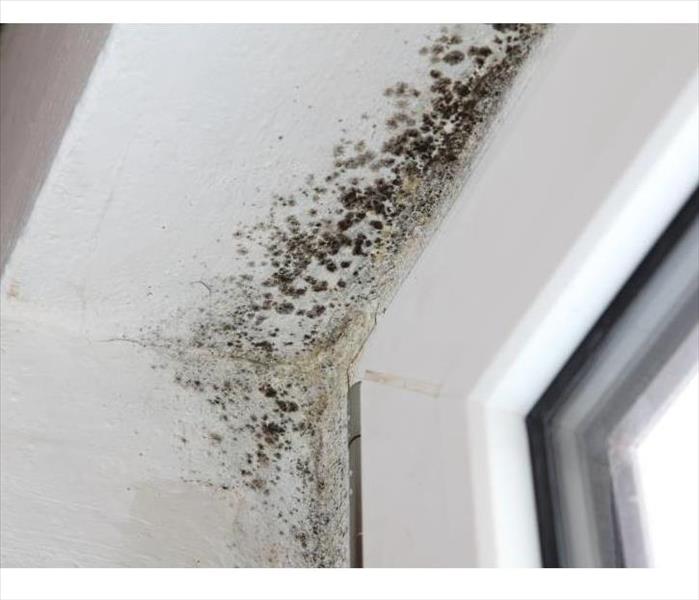
Mold. The very sound of the word is enough to make a person cringe.
Yes, mold can be good-- it's essential in making brie and penicillin, for example, but it can also be very, very bad, especially when it grows undetected in your home.Some Facts About Mold
Mold spores spread easily and cannot be completely eradicated. Mold can grow anywhere: on carpet, clothing, food, paper and even in places you can't see, such as the back of drywall, areas inside walls around leaking or condensing pipes, or above ceiling tiles. Not only is a mold problem difficult and costly to fix, but mold can also produce allergens and irritants (and rarely, toxins) that may compromise your health. So what can you do if you're concerned about mold growing on a property? The best approach is preventing mold before it becomes a problem. And the key to mold prevention is simple: moisture control. Mold Prevention Tips
Click below for nine ways to curb moisture indoors, and the mold that thrives on it.
9 Ways to Curb Indoor Moisture and Prevent Mold:
1. Identify problem areas and correct them. You can't mold-proof a property, but you can make it mold-resistant. Do an audit of the property: where are the problem areas? Does the basement flood? Do you notice frequent condensation on an upstairs window? Is there a water stain on the ceiling from a persistent leak? Preventing mold from growing or spreading might be as simple as ripping up carpet in a damp basement, installing mold-resistant products, or repairing damaged gutters. Or it may be a matter of major excavation and waterproofing. Whatever the case, address the problem now. It might cost some money up front, but it will surely be more costly down the road if mold continues to grow unchecked.
2. Dry wet areas immediately. Mold can't grow without moisture, so tackle wet areas right away. Seepage into the basement after a heavy rainfall, accumulation from a leaky pipe, even a spill on the carpet should be dried within 24 to 48 hours. If you've experienced a flood, remove water-damaged carpets, bedding, and furniture if they can't be completely dried. Even everyday occurrences need attention: don't leave wet items lying around the house, and make sure to dry the floor and walls after a shower. Don't leave wet clothes in the washing machine, where mold can spread quickly. Hang them to dry — preferably outside or in areas with good air circulation.
3. Prevent moisture with proper ventilation. It may be that your routine domestic activities are encouraging the growth of mold in the property. Make sure an activity as simple as cooking dinner, taking a shower, or doing a load of laundry doesn't invite mold by providing proper ventilation in your bathroom, kitchen, laundry room, and any other high-moisture area. Vent appliances that produce moisture — clothes dryers, stoves — to the outside (not the attic). Use AC units and dehumidifiers (especially in humid climates), but make sure they don’t produce moisture themselves by checking them periodically and cleaning them as directed by the manufacturer. Your energy-efficient property may be holding moisture inside, so open a window when cooking or washing dishes or showering, or run an exhaust fan.
4. Equip the property with mold-resistant products. Building a new home or renovating an old one? Use mold-resistant products like mold-resistant drywall or mold-resistant Sheetrock, and mold inhibitors for paints. Traditional drywall is composed of a gypsum plaster core pressed between plies of paper. Mold-resistant drywall is paperless — the gypsum core is covered in fiberglass, making the surface highly water-resistant. Moisture-resistant drywall is especially valuable in areas prone to wetness, such as bathrooms, laundry rooms, basements, and kitchens. Not only is traditional drywall more susceptible to mold than the paperless kind, but it is also difficult to rid of mold, and removal and replacement can be expensive. Mold-resistant gypsum board is also available; the core of the drywall is developed in such a way to prevent moisture absorption, and thus prevent mold growth.
5. Monitor humidity indoors. The EPA recommends keeping indoor humidity between 30 and 60 percent. You can measure humidity with a moisture. You'll also be able to detect high humidity by simply paying attention to potential problem areas of the property. Telltale signs of excessive humidity include condensation on windows, pipes, and walls. If you notice condensation, dry the surface immediately and address the source of moisture. (For example, turn off a humidifier if water appears on the inside of nearby windows.)
6. Direct water away from the property. If the ground around the property isn't sufficiently sloped away from the foundation, water may collect there and seep into your crawlspace or basement.
7. Clean or repair roof gutters. A mold problem might be a simple matter of a roof that is leaking because of full or damaged gutters. Have your roof gutters cleaned regularly and inspected for damage. Repair them as necessary, and keep an eye out for water stains after storms that may indicate a leak.
8. Improve air flow in your home. According to the EPA, as temperatures drop, the air is able to hold less moisture. Without good air flow in a property, that excess moisture may appear on your walls, windows and floors. To increase circulation, open doors between rooms, move furniture away from walls, and open doors to closets that may be colder than the rooms they’re in. Let fresh air in to reduce moisture and keep mold at bay.
9. Keep mold off household plants. They're beautiful and help keep your indoor air clean — and mold loves them. The moist soil in indoor plants is a perfect breeding ground for mold, which may then spread to other areas of your house. Instead of getting rid of your plants, try adding a bit of Taheebo tea to the water you give to your houseplants. The oil of this tree, which withstands fungi even in rain forests, helps hinder mold growth in plant soil and can be found at natural food stores.
Finally, educate yourself on your region's climate — be it the cold and wet Northeast, the hot and wet South, the hot and dry Southwest, or the cold and dry West — and how it responds to moisture. There is no one-size-fits-all solution when it comes to mold prevention. Knowing what works for your climate and your home is an important first step.
Virginia Beach Smoke & Soot
5/21/2018 (Permalink)
Smoke and soot is very invasive and can penetrate various cavities within your home, causing hidden damage and odor. Our smoke damage expertise and experience allows us to inspect and accurately assess the extent of the damage to develop a comprehensive plan of action.
Smoke and soot facts:
- Hot smoke migrates to cooler areas and upper levels of a structure.
- Smoke flows around plumbing systems, seeping through the holes used by pipes to go from floor to floor.
- The type of smoke may greatly affect the restoration process.
Different Types of Smoke
There are two different types of smoke–wet and dry. As a result, there are different types of soot residue after a fire. Before restoration begins, SERVPRO of Virginia Beach will test the soot to determine which type of smoke damage occurred. The cleaning procedures will then be based on the information identified during pretesting. Here is some additional information:
Wet Smoke – Plastic and Rubber
- Low heat, smoldering, pungent odor, sticky, smeary. Smoke webs are more difficult to clean.
Dry Smoke – Paper and Wood
- Fast burning, high temperatures, heat rises therefore smoke rises.
Protein Fire Residue – Produced by evaporation of material rather than from a fire
- Virtually invisible, discolors paints and varnishes, extreme pungent odor.
Our Fire Damage Restoration Services
Since each smoke and fire damage situation is a little different, each one requires a unique solution tailored for the specific conditions. We have the equipment, expertise, and experience to restore your fire and smoke damage. We will also treat your family with empathy and respect and your property with care.
Have Questions about Fire, Smoke, or Soot Damage?
Call Us Today – 757-716-8785
It's The Water You Don't See
5/21/2018 (Permalink)
It's The Water You Don't See...
Even small water damages have the potential to cause serious structural and indoor air quality issues over time.
The key to avoiding costly future restoration is to handle every water problem as a real threat to your property. The proper equipment makes a measurable difference in reducing the damage expense during a water loss. When time matters most, technology and equipment must be counted on to perform.
Here are a few tools used by Professional Restoration Contractors to properly mitigate a loss;
Moisture Sensors- used to detect moisture in carpets, baseboards and walls.
Moisture Meters- used to determine the actual moisture content of various materials. The meter provides accurate readings to monitor the drying process.
Thermohygrometers- measures temperature and relative humidity to calculate and create an environment most conducive to drying. When handling a contaminated loss (CAT 2 or 3), it is not only important to dry the structure, but disinfect and often deodorize.
Ultra Low-Volume (ULV) Foggers- used to atomize liquid deodorizing agents, producing a fine mist that can easily penetrate the site where odor-causing residues may accumulate. It can also be use to inject fungicides and disinfectants into wall cavities and other hard-to-reach areas.
Thermal Foggers- dispenses solvent-based products by creating a dense fog that consists of tiny particles of deodorant solution that attach to and neutralize odor causing particles.
The bottom line... ALWAYS treat a water damage seriously. Call a professional contractor that is trained and experienced in property damage restoration.
Call SERVPRO of Virginia Beach for any restoration needs you may have at 757-716-8785.
Prevent Water Damage to Your Furnace This Winter
1/15/2018 (Permalink)
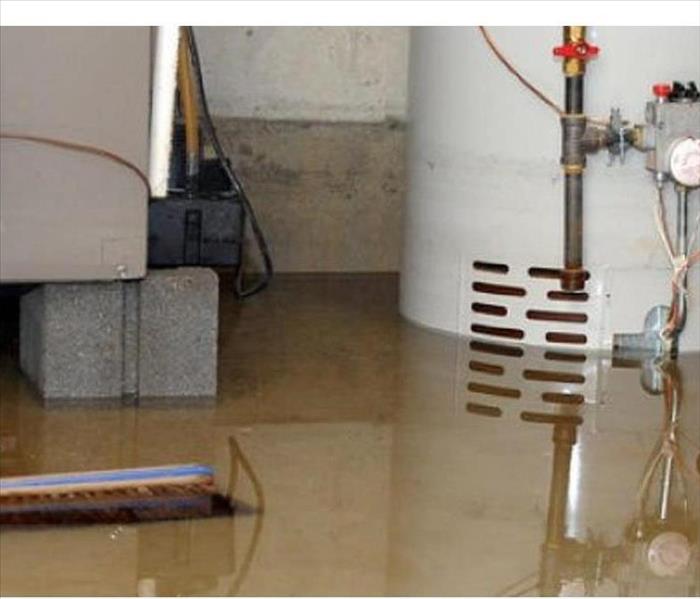 Water Damaged Furnace
Water Damaged Furnace
Every winter, especially if you live in a cold climate, your home is under assault from the elements. Eventually, that constant assault can cause your home’s systems to fail. One common result of these failures is water damage. And while any type of water damage is bad, there are certain types of damage that can be worse than others. That’s especially true in the winter.
Perhaps no system in your home is more important in the winter than your furnace. Without it, you’d be in big trouble. So while the impact of home water damage is bad no matter how you look at it, having your furnace damaged when the temps are freezing outside can be catastrophic. So let’s talk about things you can do to protect your furnace from water damage should the worst case scenario happen to you this winter.
Furnaces are hidden from view for a reason. They’re not exactly focal points of a home you want people’s eyes drawn towards. Whether it’s in a crawl space, basement or mechanical closet, it’s typically in a place you naturally don’t find yourself visiting very often. One way to help protect your furnace from water damage is to create an elevated platform upon which the furnace can sit. If it’s the case your furnace is found in an unfinished basement, you can simply pour a concrete block and install the furnace there. If it’s in a closet, it may make more sense to create a wooden box to hold the furnace. In either case, having the additional 18-24″ of height can typically protect against most types of home water damage. Granted, in massive flood events this isn’t going to have much effect, but then again there isn’t much you can do from a preventative stand point when mother nature decides to take charge.
Please call SERVPRO for any restoration needs that you may have. 757-431-1400
Steps To Take After Suffering Storm Damage in Virginia Beach
12/6/2017 (Permalink)
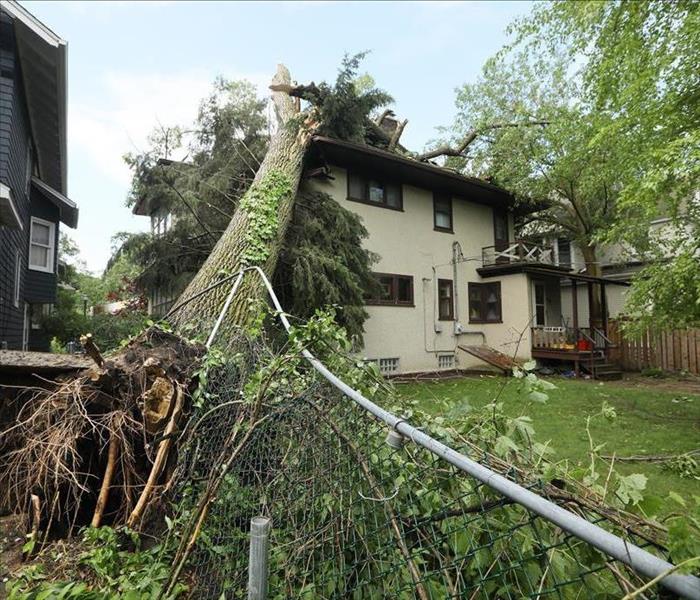 Storm Damage in Virginia Beach, VA
Storm Damage in Virginia Beach, VA
Storm damage can occur at any time and can cause an immense amount of harm to your home. Heavy rains can cause flooding and powerful winds can cause roof damage and downed trees on your property. Some post-storm damage can create safety and health hazards as well, so having a strategy to deal with damage will help you to be ready to take steps immediately after the storm.
Take Safety Precautions
Heavy winds and rain can create physical hazards such as collapsed roofing materials, window damage, collapsed walls or standing water in the basement or home interior. In addition, moisture can soak into furniture, carpeting, and building materials making the perfect environment for mold growth that can cause health issues. Shut off the main gas line if you smell gas. Beware of broken glass, exposed nails, and other sharp objects on the property. Contact SERVPRO of Virginia Beach to help do basic tasks to secure your property and make it safe to use. If necessary, arrange for an alternative place for you and your family to live while your property is being restored to safe living condition.
Photograph the Damage
If it is safe to move around your property, use your cellphone or a camera to photograph the damage so that you will have a record for your insurance company. This action will ensure that you are fully compensated.
Contact Your Insurance Company
Contact your insurance agent to notify them about the damage to your home immediately. The company will send out an adjustor to determine the extent of the damage so that payment for repairs can be made.
SERVPRO of Virginia Beach 757-431-1400
Steps to Take After a House Fire
12/6/2017 (Permalink)
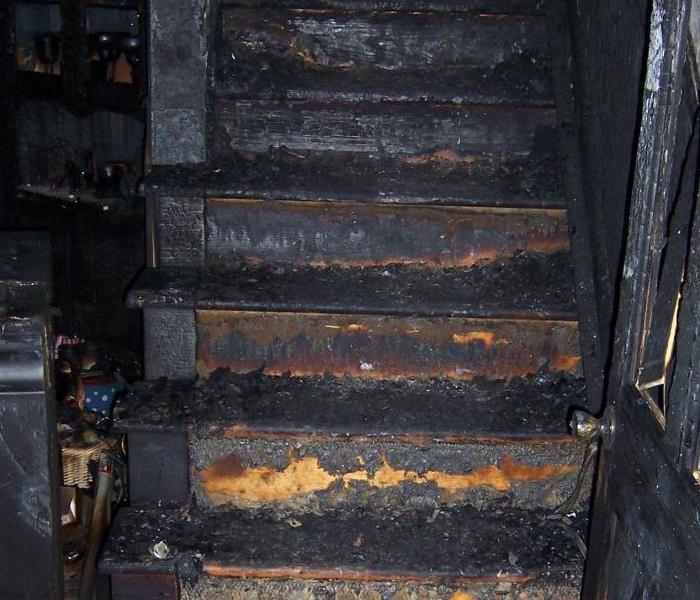 Fire Damage
Fire Damage
A house fire is traumatic event that can certainly leave you with a mix of emotions. You’ll be nervous, worried, scared, upset, wondering what to do next, and just how to do it. First things first…take a deep breath, try to relax, and know that everything will be more than fine. Ultimately you need to make sure that your family is safe and sound. Once you can confirm that, then you can tackle the recovery process of your home and belongings.
We’ve compiled a list of five things that you should do and be aware of after a fire. This way, you can approach the rebuilding of your home in a cool, calm, and collected manner!
(1) Review with the authorities and the professionals as to when it is safe to enter the home after the fire. The fire department will make sure that the fire is completely extinguished and then will go through their precautionary measures in order to deem the area ‘safe’.
(2) Know who to contact. First, contact any family members to let them know of the occurrence and the fact that you are safe. Review, and then contact your insurance company. A clean-up team, such as G.W.Savage, should also be one of the first calls made. We can efficiently and professionally get you back into your home – it will be as if nothing happened!
(3) Get the fire report. Typically coming to you from the fire department, this correspondence will review the facts of the fire – the home structure, the area of the fire, as well as the time and date. In some cities and towns, you may need to call the fire department directly in order to get a copy of this report.
(4) Make sure to secure your property. If you are not securing the property, you could potentially be making a bad situation into a terrible one – your home could be robbed of it’s remaining property, or, in some cases, another individual could be injured on the property (becoming your responsibility). You can ask the authorities and emergency services on the best methods in securing what is yours.
(5) Begin the clean-up process. Interior and exterior clean-up will most certainly be required, and more often than not there is damage that you cannot locate with the naked eye. That said, you should definitely hire a professional service like SERVPRO to do a thorough cleaning of all areas and of all soot, smoke, and odor.
Call us at 757-431-1400
Mold Behind Wall Paper
12/6/2017 (Permalink)
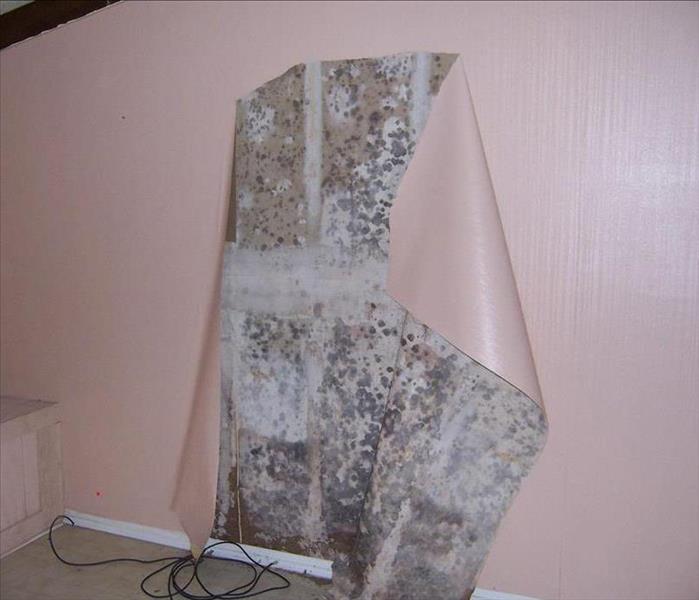 Mold
Mold
Mold behind wallpaper is a big health concern. To get rid of the mold you must remove the wallpaper. First and foremost remove the wallpaper safely by wetting it with a wetting agent and water. But first wear a good cartridge-type respirator.
When removing mold behind wallpaper safely wet it first. Even if the wallpaper removes dry still wet itA simple dust or particulate mask won't offer adequate protection. Also wear gloves and goggles, remember safety first. In a garden type sprayer add the wetting agent and water for easy application.
Using the sprayer to wet the wallpaper down will reduce the mold spores from becoming airborne. Even if the wallpaper removes dry still wet it first. Move slowly and deliberately so you don't stir up spores as you work.
Once the wallpaper is removed from the walls the next step is to wash the walls down with a water and bleach solution. This should remove the mold from the walls if it is just surface mold. If the walls are soft and spongy the mold may have penetrated deeper into the wall.
One way to tell if the walls are totally saturated with mold you can take a utility knife and cut a small square out of the wall and look at the back side of the square. If there is mold behind the wall then you should replace the walls. If you plan on wallpapering again use a Nonwoven wallpaper so you will never get mold behind wallpaper again. Nonwoven wallpapers can breath unlike vinyl wallpapers.
Commercial Restoration Services
12/5/2017 (Permalink)
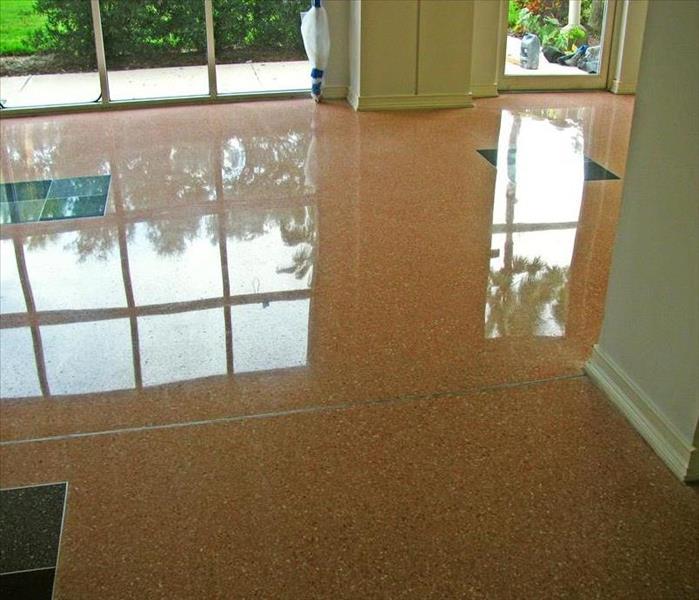 Commercial Restoration
Commercial Restoration
A commercial property is always at risk of being damaged by natural elements. If your business gets hit by a disaster, you’ll need a commercial restoration company with real-world experience and the resources to return your property to its normal state. SERVPRO Restoration has over years of experience in residential and commercial restoration services. Our team of experts offers:
- Commercial water damage restoration
- Commercial fire damage restoration
- Commercial mold damage restoration
- Commercial storm damage restoration
Our professionals have the training and equipment needed to restore your business after common issues with minimal interruption to your daily operations. SERVPRO also provides disaster planning to ensure that your property fortified in case future damage strikes.
At SERVPRO, we offer 24/7 commercial restoration and reconstruction services for damage caused by water, fire, smoke, mold, storms, and other disasters.
Why SERVPRO Commercial Restoration?
What makes SERVPRO Restoration different from other commercial restoration services? We offer multiple services through one point of contact. This means you only need one number to reach our reconstruction, emergency services mitigation, contents cleaning, training, insurance claims assistance, and disaster planning teams. You can depend on us for additional commercial damage services like cost savings, streamlined catastrophe planning, and minimized disruption.
SERVPRO has a longstanding heritage dedicated to innovation, resourcefulness, empathy, and outstanding customer service. Our franchise organization is proud to provide fast, high-quality cleanup and restoration services to both commercial and residential properties. We always put your property first at SERVPRO.
Call SERVPRO ! 757-431-1400
Signs of Storm Damage
12/5/2017 (Permalink)
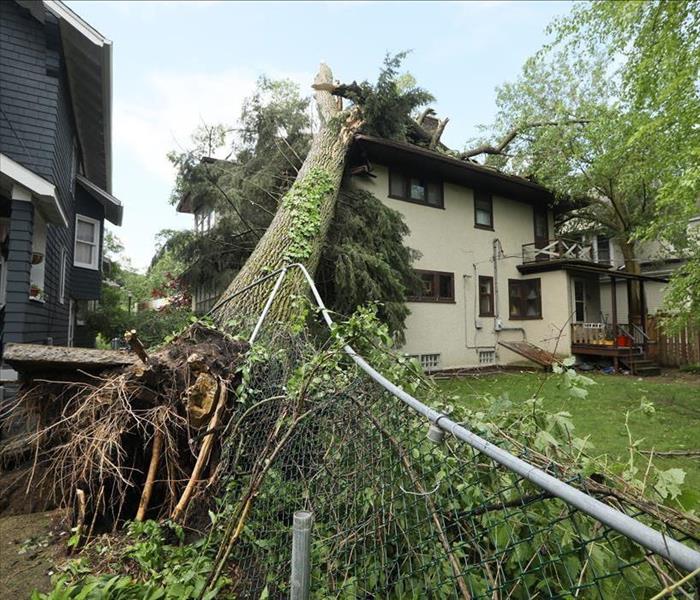 Storm Damage
Storm Damage
- Roof: Look for shingles that have discoloration, tearing, or even holes in them. These can all be signs that your roof has been damaged. Another sign is if there are leaks in your roof or your ceiling.
- Gutters: After a hail storm, looking for dents or dings can also give you a better picture of what the storm did to the rest of your home. Your gutters can also give you insight to whether you have roof damage. Check to see if there are granules from the asphalt shingles in your gutter.
- Windows: Look at each of the windows at your homes and note any signs of shattered or broken windows and frame damage. This is especially important after a hail storm or a strong wind storm.
- Exterior: Not only is it important to look at the siding of your home to check for damage, it is also important that you check any appliances. Inspect your AC/HCAC unit as well as items such as a barbeque grill.
After your inspection, if you notice any signs of storm damage follow up by checking the area for signs of mold, mildew, pests or other secondary damage. If damage has occurred have it repaired immediately. Call SERVPRO at 757-431-1400 for any restoration needs you may have.
6 Facts About Commercial Water Damage
12/4/2017 (Permalink)
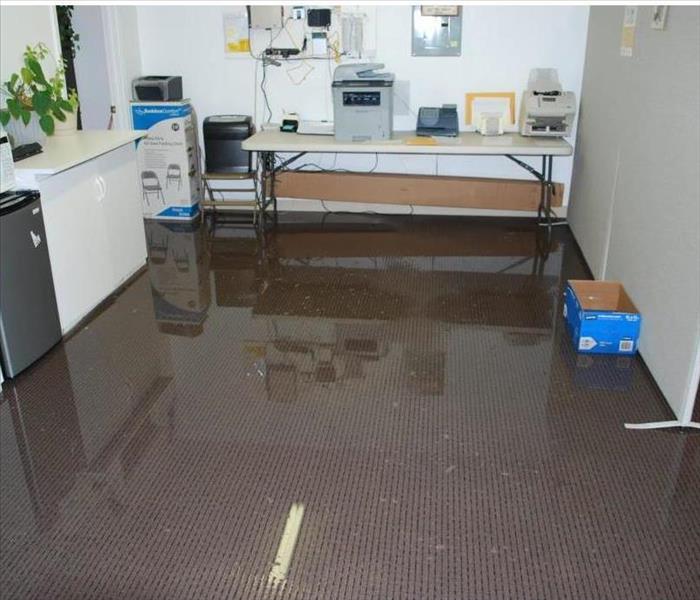 Commercial Water Loss
Commercial Water Loss
When it comes to water damage to a residential or commercial property, there is more than meets the eye.
Here are some water facts and figures as they pertain to the restoration industry:
1. Water is capable of dissolving a variety of different substances. In fact, water is known as the “universal solvent” because it dissolves more substances than any other liquid.
2. A sheet of drywall standing upright with its edge sitting in a ½” of water can wick water up to 6 inches in less than three hours.
3. Mold typically begins to grow in 24 to 48 hours in an untreated moist environment.
4. A good indication of a failing hot water heater is a puddle of water underneath it, indicating a slow leak, or rusted or corroded fittings on the top of the heater. If you don’t investigate the leak ASAP, you may quickly flood your home because water heaters are under a great deal of water pressure.
5. There are three categories of water contamination defined in the restoration industry:
- Category One – Water from a clean water source with no substantial risk of causing sickness or discomfort. Examples include water from a broken water supply pipe or an overflowing bath tub.
- Category Two – Water that has a significant degree of chemical, biological, and/or physical contamination. Examples include water from aquariums, dishwasher or clothes washer leaks, and water entering the structure from below grade. Discharged Category One water that sits untreated more for more than 24 hours becomes Category Two.
- Category Three – Water emanating from a grossly unsanitary source or carrying disease causing agents. Examples include discharges from sewer or septic systems/pipes and flood waters. Discharged Category One water that sits more for more than 48 hours becomes Category Three. Discharged Category Two water that sits more for more than 24 hours becomes Category Three.
6. Controlling pathogenic microorganisms during a restoration project may require the use of chemical agents that act as biocides. The United States Environmental Protection Agency (EPA) has defined three levels of biocidal activity:
- Sanitizers – Designed to reduce the number of microorganisms.
- Disinfectants – Designed to destroy or inhibit the growth of microorganisms but not necessarily their spores.
- Sterilizer – Designed to destroy all microorganisms (fungi/molds, bacteria, viruses, etc.) and their spores.
Commercial Water Damage
12/4/2017 (Permalink)
 Commercial Water Damage
Commercial Water Damage
Commercial Water Damage Restoration
Water damage can strike your business at any time. At United Water Restoration, we understand the urgency and the delicacy of the situation. Mold growth can lead to serious health issues, as well as damaged property, lawsuits, and even potential structural issues. For a business, municipal building, or similar structure, floodwaters also mean one powerful truth: your building is closed for business until the damage is remediated. Every hour spent cleaning up is an hour of lost revenue and productivity. So when an emergency situation arises in your business, give SERVPRO a call and we’ll be there fast with the help you need.
Water Damage Causes
Water damage can be caused by a toilet clogging or overflowing, general plumbing problems, a leaking roof or old pipes. Our experts will assess the issue by tracking down any pockets of excess moisture and remove them accordingly. The high-tech equipment used to locate these pockets include moisture meters and Thermal imaging permits the ability to measure the moisture in hidden pockets and behind tile and other materials that may not feel wet on the outside. SERVPRO finds these moisture pockets and professionally dries the equipment and area to ensure proper recovery and remove any moisture from drywall or other materials. Through our process we can speed up drying to prevent the growth of any mold or other harmful bacteria by building drying chambers.
Is it essential that water damage restoration is given proper attention in a timely matter. If left unrepaired, it will worsen which will lead to more and more problems.
Water Damage Restoration Process
We will provide care and consideration to your concerns and business needs. The steps we take are as follows:
• Secure the site and assess the water damage
• Begin water extraction procedures immediately
• Remove carpet pads if necessary
• Take steps to prevent the growth of mold and mildew
• Use our state of the art equipment, including industrial-strength blowers and dehumidifiers to completely dry carpet, floors, walls, and ceilings
• Water-damaged machinery, IT equipment, personal belongings, furniture, and other movable items are taken to our contents cleaning laboratory where they are thoroughly taken apart if necessary, dried, cleaned, and put together again in peak running order. Our goal is always to restore rather than replace
• Once cleanup, drying, and disinfection of the affected area is complete, our in-house contractors restore walls, paint, flooring (if necessary), ceilings, woodwork, and all other interior and exterior structural elements.
We get you back in business. Fast! If a disaster should strike, whether a tornado, hurricane, fire or a simple sprinkler head break, SERVPRO is here to help. We’ll guide you each step of the way! We’re at your side through each step of the restoration process. It pays to be prepared!
Facts About Fire Restoration
12/4/2017 (Permalink)
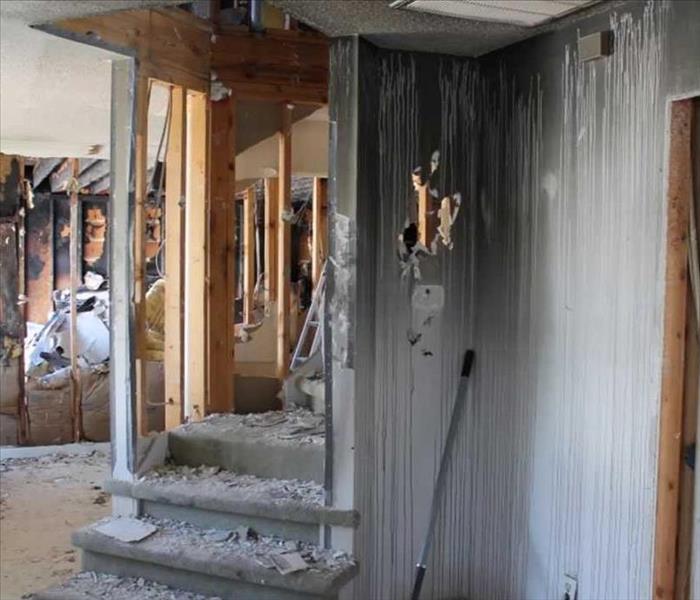 Fire Damage
Fire Damage
While it’s true that a house fire can be an extremely difficult and overwhelming experience, professional fire restoration companies are available to help you deal with the aftermath. When fire damage is the result of fire in our home—one of the scariest and most devastating events we can face—it can make us feel panicked, vulnerable, and helpless. The good news is that you don’t have to deal with it alone when you have the right fire restoration services to guide you.
What professional fire restoration companies do is a science designed to provide the most effective restoration and resolution after a fire to get your home back to its original condition and get you back to life as you know it.
Here are 3 amazing facts about fire restoration, and #3 just might surprise you:
#1: With a House Fire, Smoke Goes Everywhere
Even if you have a tiny kitchen fire with minimal damage, you will experience the smell of smoke and have the potential for smoke damage throughout other areas of your home, or maybe even throughout your entire home. Smoke travels everywhere. It’s made up of particles of the fuel that burned in the fire combined with chemicals and particulates that become airborne during the fire and then move throughout your house.
Smoke damage restoration is one of the primary concerns during fire restoration. If smoke damage is not treated properly it can cause more and more problems as it sits on surfaces throughout your home. And the odor lingers long after the fire is out and can make a home unlivable if it isn’t dealt with successfully. It takes the proper tools, equipment, products, and know-how to get rid of smoke damage.
#2: Fire Damage Is Often More Extensive (and More Dangerous) than It Looks
When the fire is out and the smoke has cleared, the danger isn’t necessarily over. Fire damage is often more extensive than it first appears. A small fire can damage not just the surface where the fire occurred but can damage the interiors of walls and ceilings and can affect the electrical and the structure of your home in unexpected ways.
When fire burns, the temperature and ferocity often depends on the fuel. In a home fire, that often includes lots of synthetic and petroleum based products like carpet and flooring, toys and furniture, and plastics and artificial laminates. This type of fire creates smoke and soot residue that is greasy and smeary and can be difficult to remove as well as toxic to handle.
When there is a fire against a wall, it can also burn the interior support structure and the floor below. This is another danger you could be facing if you choose to enter the home before it’s deemed safe by the fire department. Use caution when dealing with the interior of your home as well as the residue left behind by the fire. Call in a professional before you do anything.
#3: House Fires Lead to Water, Water Everywhere!
One of the most damaging things about a house fire isn’t necessarily the flames but the water used to extinguish them. Surprised? You’re not alone. Most homeowners expect to find fire damage after a fire, not water damage. The truth is that water can often cause more damage after the fact than the fire itself.
The water, though essential to put out the fire, is used in massive quantities and will run down through your home, pooling in the lowest areas of each floor. Not only can this cause damage to your belongings and the structure of your home, but it can cause an even more dangerous situation as it creates the perfect environment for mold growth.
Dealing with mold after a fire is more common than you might think. Mold is damaging to your home and belongings but it can also pose a huge health risk and needs to be dealt with by an experienced professional. This is why the fire restoration process generally includes water damage restoration to ensure a successful and safe repair.
Fire damage is something we all hope we never have to deal with, but if you should be faced with a fire in your home, it’s important to know what you’re dealing with and why you should put the care of your home in the hands of a restoration company.
Contact SERVPRO for any restoration needs at 757-431-1400.
Know The Facts About Business Fire Restoration
12/4/2017 (Permalink)
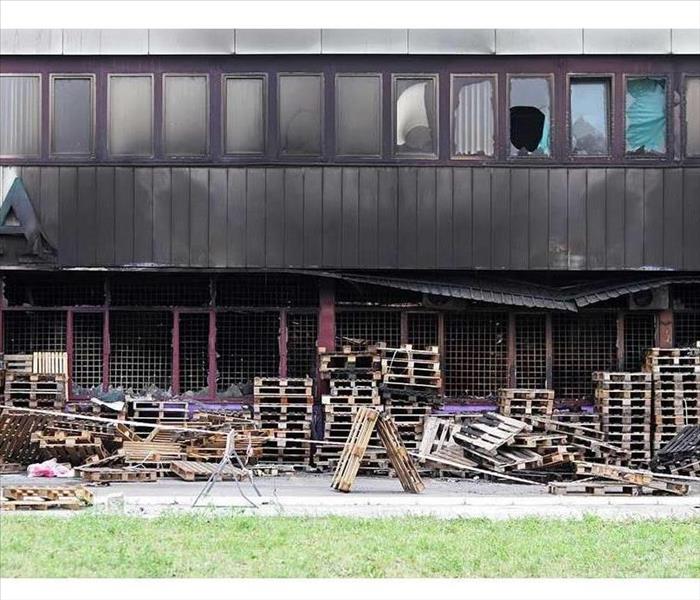 Commercial restoration
Commercial restoration
Know the Facts about Business Fires
According to the U.S. Small Business Administration, as many as one in four businesses that suffer some kind of major disaster do not reopen afterward. It’s true, overcoming a major loss is extremely difficult, but with the right restoration company and team on your side, working hand-in-hand with your insurance company, the chance of your Indianapolis-area company surviving is pretty high!
Depending on the size of the fire, and the amount of damage, some businesses that have come to SERVPRO for help have reopened just days after the fire happened. Thanks to innovations in smoke odor removal, fire damage restoration, and cleaning in general, it is possible for crews to start work nearly immediately after the fire department clears the scene, and have things back up and running in no time. Although, again, that all depends on the severity of the fire. But no matter the severity, recovery is possible!
According to the National Fire Prevention Association, U.S. fire departments responded to about 3,300 office property fires per year between 2007 and 2011. Those fires resulted in about $112 million in property damage each year, and most were in business offices – and happened during business hours. However, the good news is the number of business fires was down a whopping 71 percent from 1980 to 2011.
Here are some other stats from the NFPA:
Time of Day
- Peak time of day for office fires: Noon – 2p.m. (a.k.a. lunch time!)
- 69% happened between 7 a.m. and 7 p.m.
- The 31% that occurred between 7 p.m. and 7 a.m. caused 67% of recorded property damage, because they went undetected longer. This also highlights the need for automatic detection equipment and working sprinkler systems.
- 19% of fires happened on weekends.
Cause of the Business Fires
- 29% were caused by cooking equipment. However, just 6% of these fires caused actual property damage.
- Intentionally-set fires caused the most direct property damage – 21%.
- Electrical equipment is the second leading cause of office fires.
- Just 2% of office fires start in a concealed space like an attic, in the ceiling, or in another conceals space. However, these fires accounted for 13% of the direct property damage.
Containment & Putting it Out
- 4 out of 5 fires were confined to the room of origin.
- 90% of fires were large enough to activate sprinklers, which were effective 88% of the time.
- Deaths per 1,000 stores were 62% lower in offices equipped with sprinklers compared to those without.
Industrial/Manufacturing Facility Fires
The NFPA also has statistics specific to manufacturing facilities. According to their research, there are about 37,000 fires at industrial or manufacturing facilities each year, resulting in 18 deaths, 279 injuries, and $1 billion in property damage. Heating equipment and stop tools were the leading cause – sparking 28 percent of the fires. Mechanical failure or malfunction caused 24 percent of the fires.
Planning for the Worst
As part of your emergency preparation plan, be sure to have a local, reputable restoration company – like SERVPRO– on speed dial. The sooner you get the professionals in cleaning up after the disaster, the sooner you can get back to business 757-431-1400.
Mold Removal and Mold Remediation
12/4/2017 (Permalink)
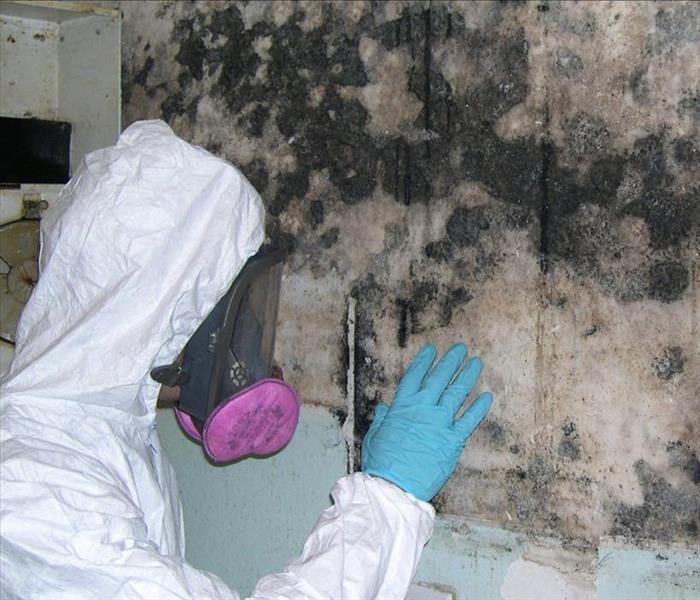 Mold
Mold
Any home or business can quickly become infested with mold with the introduction of a water source, like a roof or plumbing leak. Mold can spread throughout a property in as little as 48-72 hours, and can produce allergens and irritants that have the potential to cause other health effects.
If you suspect that your home or business has a mold problem, SERVPRO Franchise Professionals can inspect and assess your property. If mold is found, they have the training, equipment, and expertise to handle the situation.
SERVPRO Franchise Professionals
- Provide 24/7 Emergency Service
- Highly Trained Water Restoration Specialists
- Faster to Any Size Disaster
- A Trusted Leader in the Restoration Industry with over 1,700 Franchises
If You See Signs of Mold, Call SERVPRO 757-431-1400.
Understanding Mold
Microscopic mold spores exist almost everywhere, outdoors and indoors, making it impossible to remove all mold from a home or business. Some restoration businesses advertise “mold removal” and even guarantee to remove all mold, which is a fallacy. Consider the following mold facts:
- Mold is present almost everywhere, indoors and outdoors.
- Mold spores are microscopic and float along in the air, and may enter your home through windows, doors, or AC/heating systems or even hitch a ride indoors on your clothing or on a pet.
- Mold spores thrive on moisture. Mold spores can quickly grow into colonies when exposed to water.
- Before mold remediation can begin, any sources of water or moisture must be addressed. Otherwise, the mold may return.
- Mold often produces a strong, musty odor and can lead you to possible mold problem areas.
- Even higher-than-normal indoor humidity can support mold growth. Keep indoor humidity below 45 percent.
Common Mold Misconceptions
With sensational news stories and misleading advertising, you can easily understand why so many people are misinformed about indoor mold. Learn the facts about mold and the mold remediation process.
Storm & Wind Damage
12/4/2017 (Permalink)
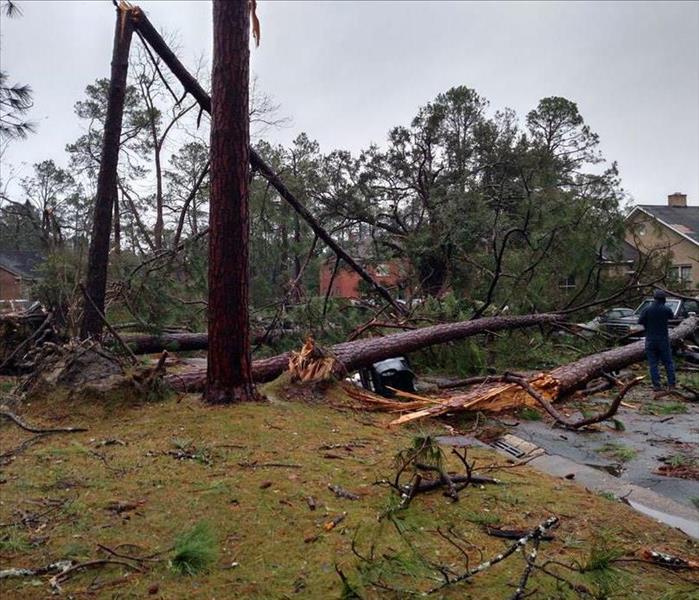 Storm Damage
Storm Damage
There are many areas of the United States that have experienced heavy winds and storms this season and the strong powerful winds can cause significant damage to a home. Wind damage and water damage are the most common results of a heavy storm and it is important to contact SERVPRO as soon as the storm is over to help limit and repair the damage. Wind damage can happen to your home directly from the strong wind or indirectly from the wind blowing debris into your house. These wind damage facts will help you better understand the potential for wind damage and how to prevent it.
Storm Damaged Roof
Wind Type Varies by Storm and Causes Different Degrees of Wind Damage
Thunderstorms are the most common source of wind and storm damage but winds from hurricanes or tornadoes are stronger and can cause more severe damage. It is important to know when a storm is approaching your area and what type of storm it is so you know the potential and level of damage to expect. Thunderstorms are responsible for over half of all wind damage cases in the U.S. but the storm damage repair may be more costly for hurricane or tornado wind damage.
Characteristics of the Wind Affect the Wind Damage
The wind has many characteristics that differ depending on the situation. Some characteristics to take into account include speed, direction, and duration of the gusts and recognizing them can help you protect your home and property effectively from wind damage. Recognizing the characteristics of the wind can also help you determine how much potential damage to expect.
Preventing Wind and Storm Damage
Most wind damage is caused by flying debris either from plants or other structures and objects that are not secured. If a storm is approaching your area, make sure any potential debris around your home such as patio furniture, toys, garbage cans, and other objects are either secured or brought inside. Your doors and windows should also be secured to help minimize the potential storm damage to the home.
Wind and Storm Damage Repair Costs
Wind damage can cause a range of destruction to your property from broken windows and fallen tree branches to more severe damage to the roof, garage, or car. Billions of dollars are spent on wind damage repair and storm damage restoration each year and understanding the nature of wind damage can help you limit the amount of damage to your home and save on restoration and repair costs. The cost of wind damage repair generally ranges from about $880 almost $11,000 with most homeowners spending on average between $4,600 and $7,000 for repairs. Make sure to contact SERVPRO for an estimate on the wind damage repair for your home.
Wind damage from different types of storms is a major cause of destruction to homes and by understanding the characteristics of wind damage, you can help keep your home protected during a storm. Different types of storms bring different types of winds and the storm damage caused by the wind can range from minor damage to more costly structural damage. If your home sustains wind damage during a storm, make sure to call SERVPRO immediately. These qualified technicians can provide effective wind damage and storm damage repair.
Please give us a call at 757-431-1400.
5 Things You Need To Know About Water Damage Statistics
12/4/2017 (Permalink)
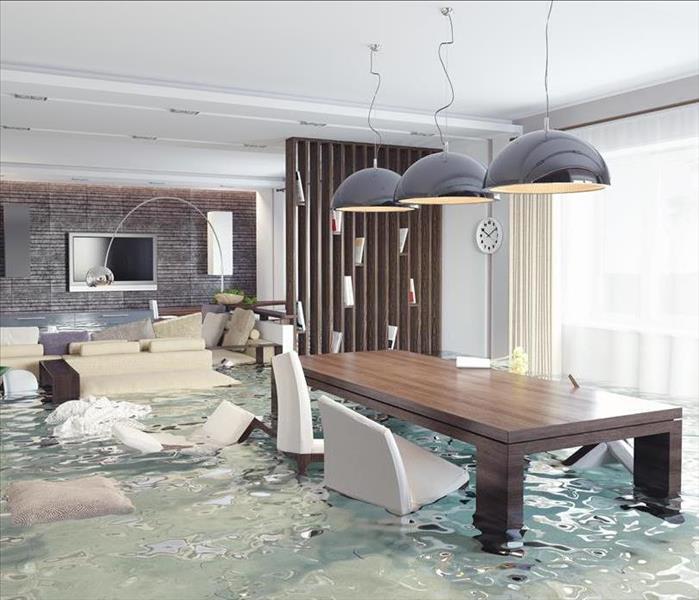 Water damage
Water damage
When a pipe bursts, a drain backs up, or a flood occurs in your home, it can be hard to see past the mess. A million questions will run through your mind.
What do I do now?
What’s going to happen?
Is my stuff ruined?
And the most important question of all: Will my homeowner’s insurance cover the damage?
There’s no doubt about it. Water damage is extremely stressful, and the more you know about it, the better you’ll be able to decide how to address it. Here are five things that every homeowner needs to know about water damage.
1. There are different insurance policies for flood damage and water damage.
You might think that water is water, whether it’s from flooding or a burst pipe, but flood damage is not covered under homeowner’s insurance. If you live in an area likely to experience flooding, you will probably already have a separate policy through the National Flood Insurance Policy (NFIP). When you report the claim to the insurance company, make sure to specify whether the claim is for water damage or for flood damage, so they can begin adjusting your claim correctly.
2. Not all water damage is covered by your insurance.
It is a good idea to look over your insurance policy and familiarize yourself with any exclusion to your water damage coverage. For instance, most policies cover sudden damage, like water damage from a really bad storm or from an overflowing washing machine. On the other hand, any water damage that happens because you didn’t maintain the property may be excluded, as well as gradual leaks that caused water damage over time.
3. Once water damage has happened, the clock is ticking before it gets worse.
When your property has been water damaged, you don’t have the luxury of waiting around for a convenient time to start the cleanup. Secondary damage from mold growth can present serious health risks associated with mold in the living environment.
Mold spores are everywhere, but they need moisture and a nutrient source to grow. And that is exactly what your wet carpet or drywall offers.
There is a 24 to 48 hour window from the time something gets wet until mold CAN begin to grow. After that time, mold will multiply rapidly. When mold growth is widespread, you may need the services of SERVPRO mold remediation service to safely treat and remove the mold.
To prevent mold growth, you will need to get your property completely dry again within that 48-hour window. To do this, you’ll need to contact a company that specializes in water damage restoration and emergency water extraction. They will have the professional water removal equipment and drying equipment to get the job done as quickly as possible. Many have 24-hour a day emergency hotlines, so you can start recovering your property almost immediately.
4. Your insurance company needs to know right away.
It’s a good idea to call your insurance company right away when you discover water damage. Your insurance agent can start the claims process immediately, as well as guide you through the first steps you will need to take to protect your property from more damage, like stopping the source of the water at the main water turnoff.
5. The pollution level of the water is important.
Water damage is categorized as one of three levels by how polluted the water source was that caused the damage.
Category 1: Water from a clean water source, like a fresh water line for a dishwasher. This water will not cause illness or any ill effects.
Category 2: Water that may cause illness through contact. It may have bacteria in it,
Even though water may start out as Category 1, that doesn’t mean it will stay that way. Any contamination that the water touches, such as dirty carpeting or soil from the ground, can change water damage Category to 2 or even Category 3. And since standing breeds bacteria, the longer the water is around, the worse the contamination of your property.
More contamination can mean that the restoration team will have to use more aggressive measures to clean your structure and property, and it might mean that soft furnishings, like your carpet and the carpet pad, may have to be discarded for your safety.
Water damage can be dangerous and expensive, so preventing water damage is an important part of home maintenance. But if you know the basics of what to do once it happens, you can prevent it from doing its worst.
Call SERVPRO for any water damage restoration you may have. 757-431-1400
Water Damage Statistics
12/4/2017 (Permalink)
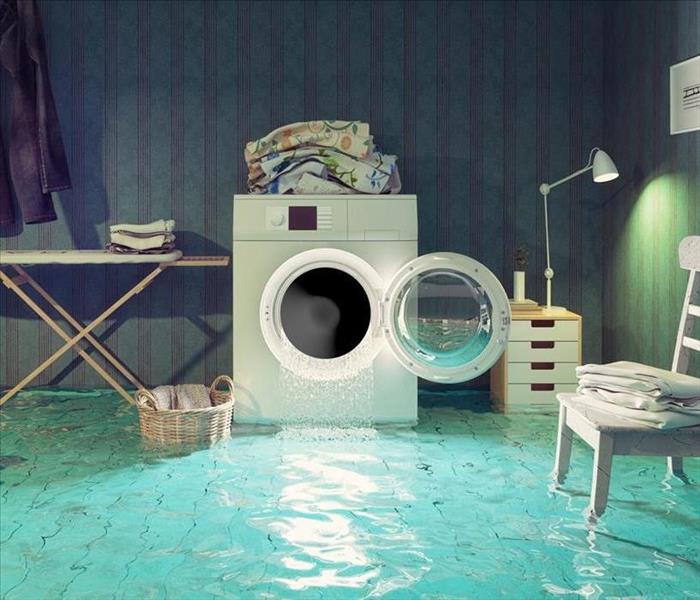 Water Damage
Water Damage
Water Damage Statistics
Water damage covers a broad range of potential loss. Homeowners understand that wear and tear will occur in any circumstance; however, there are a variety of unforeseen events that may trigger water damage. Natural disasters are often given the most blame for water damage, and they should, considering that the majority of damages due to water stem from some sort of outside environmental factor.
Nevertheless, water damage may come in a variety of forms. Understanding the sources of this type of damage is important to not only potentially preventing an incident, but more importantly, to understand where you stand in the eyes of your insurance provider. Water damage in homes most typically comes from the following causes:
- Frozen pipes
- Leaking pipes
- Leaky roof
- Broken washing machine hose
- Plumbing problems
- Insulations issues
The water damage statistics below will highlight the widespread nature of this issue. While many people do not view this as a common occurrence, water damage accounts for a significant number of homeowners insurance claims. The following are some of the most interesting water damage statistics:
- Almost 40 percent of all homeowners have said that they have experienced loss from water damage
- About 93 percent of all water damage can be prevented
- Water damage is the second most frequently filed insurance claim in the United States
- 250 gallons of water is released a day due to a 1/8-inch crack in a pipe
- About 20 percent of all insurance claims related to water damage of some kind
- Billions of dollars in property losses are spent each year as a direct result of water damages
Those homeowners with an understanding of the prospective damages associated with water are much more likely to stop problems before they become major issues. Hopefully these water damage statistics were able to shed some light on the vast complications that may arise from water in the home. If you or your family has experienced water damage and are looking to file a claim, contact Arguello, Hope & Associates for more information.
To get started today, simply fill out a Free Case Review form on this page.
Water Damage Insurance Coverage
First and foremost, homeowners must maintain an understanding of exactly what is and is not covered under their current insurance policy. Without this knowledge, homeowners will be left in shock when disaster strikes and they must pay for these damages out of pocket. Besides purchasing a flood policy for protection, you may be able to add coverage to your existing policy. These additions may cover things such as the following:
- Mold remediation (varies on state)
- Backup of drains or sewers
- Plumbing water damage
- Air conditioning damages
- Water heater damage
Homeowners must be astute in recognizing water damage as early as possible. When a sudden storm, plumbing issue, or sewer backup occurs, knowing what will be covered will ease stress and make the entire repair process much more fluid. To find out more, contact our SERVPRO franchise at 757-431-1400.
Work Place Water Damage Restored By SERVPRO
11/29/2017 (Permalink)
 Commercial Building Water Loss
Commercial Building Water Loss
When business owners visualize water damage, they often picture a massive storm wiping out power lines, flooding offices, and shutting down businesses for days at a time. It is true that commercial water damage is often the result of floods and water that stems from weather events and storms.
However, many entrepreneurs and business space renters forget that storms and severe weather aren't the only causes of floods and water damage. Here are some of the typical causes of water damage to commercial buildings.
1. Malfunctioning sprinkler systems
Some older office and retail buildings still have outdated sprinkler systems that work in conjunction with fire protection systems. While such sprinklers can come in handy during a fire emergency, they can also cause commercial flood damage if they are faulty or in need of replacement. This could easily damage inventory and business assets.
2. Damaged appliances and equipment
This cause of commercial flood damage is more common in restaurants and catering facilities, as well as any business that has appliances and equipment that make use of water. If the appliance fails and sends water across your building, especially during late hours when no one is around, you may come back to work and face a water emergency.
3. Broken pipes and plumbing
Just like in a residence, if the plumbing system in your workplace fails water damage could be the result.
4. Backed up sewer lines
This is another cause of commercial water damage that often catches business owners by surprise. Should the sewer line to your building back up or become damaged, realize the potential dangers of contaminated Black Water which can cause health effects and ruin products and office furnishings.
If your business has suffered commercial water damage, SERVPRO of Virginia Beach will get you back up and running again. Give us a call at 757-431-1400.
Winter Heating Hazards
11/29/2017 (Permalink)
 Fire Place
Fire Place
Winter is the same anywhere you go...lower temperatures & shorter days. Often times we use alternative heat sources like fireplaces, portable space heaters, and wood burning stoves to make our homes cozy. Did you know that heating equipment is a leading cause of home fire deaths?
Keep the following safety tips in mind to help reduce your risk of a heating-related fire:
- Keep anything flammable at least three feet away from heating equipment, like the furnace, fireplace, wood stove, or a portable space heater. Have a three foot "kid-free zone around open fires and space heaters.
- Make sure the fireplace has a sturdy screen to stop sparks from flying into the room. Ashes should be cool before putting them in a metal container. Keep the container a safe distance away from your home.
- Remember to turn portable heaters off when leaving the room or going to bed.
- Always use the right kind of fuel, specified by the manufacturer, for fuel burning space heaters.
- Have heating equipment and chimneys cleaned and inspected every year by a qualified professional.
- Have a qualified professional install stationary space heating equipment, water heaters or central heating equipment according to the local codes and manufacturer's instructions.
- Test smoke alarms monthly.
Different Causes of Commercial Water Damage
11/16/2017 (Permalink)
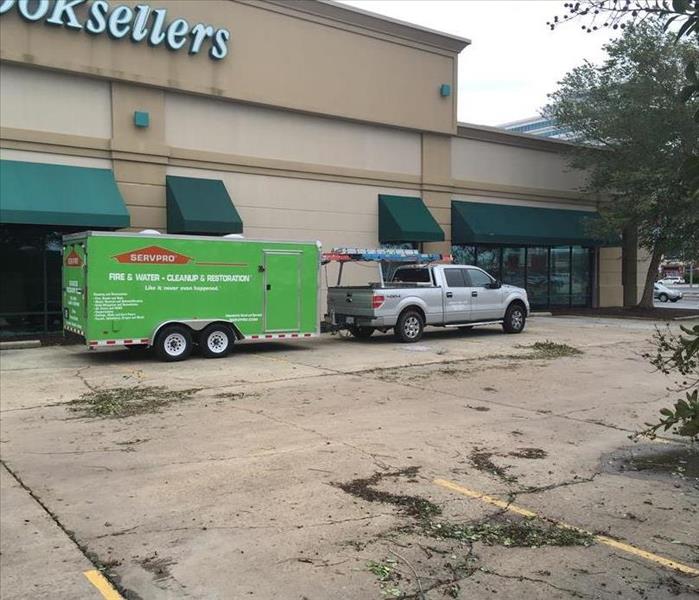 Water Damage at Barnes & Noble
Water Damage at Barnes & Noble
Work Place Water Damage is Restored by SERVPRO
When business owners visualize water damage, they often picture a massive storm wiping out power lines, flooding offices, and shutting down businesses for days at a time. It is true that commercial water damage is often the result of floods and water that stems from weather events and storms.
However, many entrepreneurs and business space renters forget that storms and severe weather aren't the only causes of floods and water damage. Here are some of the typical causes of water damage to commercial buildings.
1. Malfunctioning sprinkler systems
Some older office and retail buildings still have outdated sprinkler systems that work in conjunction with fire protection systems. While such sprinklers can come in handy during a fire emergency, they can also cause commercial flood damage if they are faulty or in need of replacement. This could easily damage inventory and business assets.
2. Damaged appliances and equipment
This cause of commercial flood damage is more common in restaurants and catering facilities, as well as any business that has appliances and equipment that make use of water. If the appliance fails and sends water across your building, especially during late hours when no one is around, you may come back to work and face a water emergency.
3. Broken pipes and plumbing
Just like in a residence, if the plumbing system in your workplace fails water damage could be the result.
4. Backed up sewer lines
This is another cause of commercial water damage that often catches business owners by surprise. Should the sewer line to your building back up or become damaged, realize the potential dangers of contaminated Black Water which can cause health effects and ruin products and office furnishings.
If your business has suffered commercial water damage, SERVPRO of Virginia Beach will get you back up and running again. Give us a call at 757-431-1400.
Water Loss in a Commercial Building Leaves Not a Moment to Spare
11/16/2017 (Permalink)
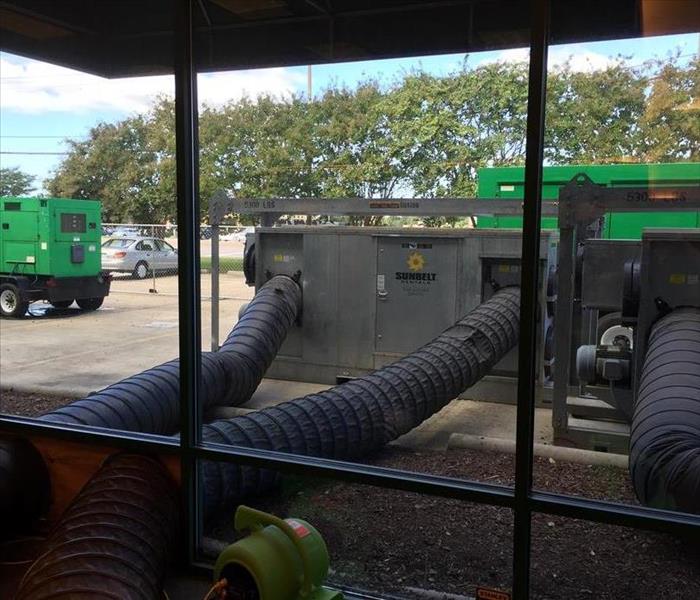 Commercial Water Loss
Commercial Water Loss
When a water event occurs in your property, damage to the structure and contents can occur. The type of water that affects a building includes:
Category 1 water originates from a sanitary water source and does not pose substantial risk from dermal, ingestion, or inhalation exposure. In most cases drying procedures are recommended.
Category 2 water contains significant contamination and has the potential to cause discomfort or sickness if contacted by people. For this category, environmental interpretation is critical as drying for some materials is acceptable while removal of others must occur
Category 3 water is grossly contaminated and can contain pathogenic, toxigenic or other harmful agents. In most cases removal is necessary and environmental remediation is necessary.
When a water event occurs a water extraction contractor is generally hired to remove the water. However, the ability of the contractor to identify the water category, deal with the issues of health and safety properly as well as remove or dry out the affected building materials and contents can vary greatly.
Assessment for water damage independently of the water removal contractor ensures that the project is dealt with relative to the category of water, health and safety concerns are identified and controlled and their work product is validated.
8 Bad "Facts" ABout Mold Everyone Thinks Are True
11/16/2017 (Permalink)
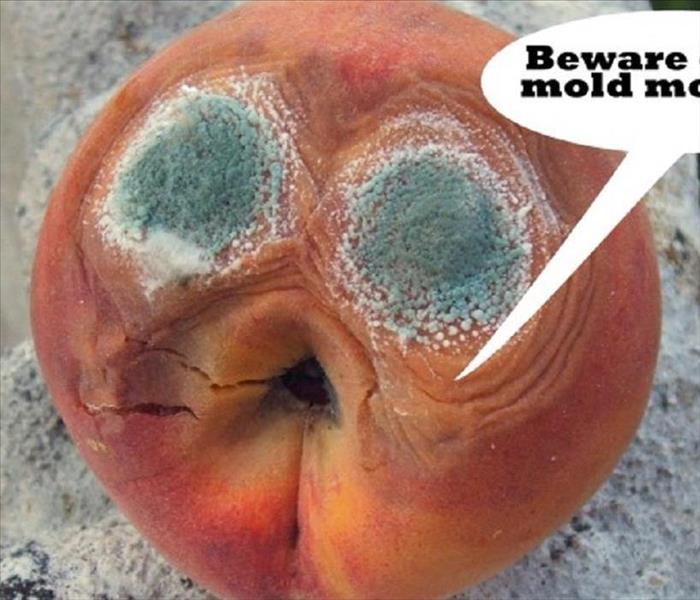 Mold Monster
Mold Monster
8 Bad “Facts” About Mold That Everyone Thinks Are True
With all the misinformation about mold out there it is easy to over react. Here are four “facts” that are over reactions to mold.
Bad “Fact” 1: All Mold Is Bad
Nope! Have you ever eaten blue cheese or take penicillin? Mold is used in the making this kind of cheese and medicine.
Bad “Fact” 2: All Mold Causes Health Problems
In reality, the effect of mold on people varies greatly. Molds produce allergens, and while some people will be allergic to the allergens produced by mold not everyone will react to mold, and the effects can be varied depending on ones’ sensitivity to mold
People who are highly sensitive to mold may develop allergic reactions and show symptoms such as difficulty breathing, bloody noses, itchy and watery eyes, etc. People with already compromised immune symptoms are also at risk for reacting to mold, and some studies have suggested that serious health effects can arise from repeated exposure to mold, so it is not something to play around with.
Bad “Fact” 3: There Should be No Mold Inside
In reality mold is all around us and is very natural. There are mold spores in the air you are breathing and there is really no way around this unless you decide to live inside a plastic, environmentally controlled bubble. The problem is not that there is mold indoors the problem is with the concentration of mold indoors. Mold should not be growing in your walls or on surfaces as that can be a problem and contribute to allergic reactions.
We will always live with mold, the question is how much mold should we live with? The answer to that is still being worked out. As mold affects people differently you should talk to your doctor if you think you are suffering from exposure to mold and you take steps to reduce your exposure to mold..
Bad “Fact” 4: Bleach Kills Mold
This is kind of a half truth. Bleach may kill certain kinds of mold on non-porous surfaces, however, it is not clear that bleach can kill all kinds of mold nor kill mold on porous surfaces such as wood. Research is continuing to be done on the effectiveness of bleach as a mold cleanup agent. It should be noted that using bleach to “kill” mold poses its own health risks and is not a recommended solution by EPA or OSHA. Bleach is also very corrosive and can cause further damage if not used correctly.
Bad “Fact” 5: Killing Mold is Enough, I Don’t Need to Remove it
Killing mold is not enough. Putting aside the conflicting reports on what kills mold, simply killing mold does not remove the health effects as the allergens are still present even in dead mold. To properly protect against health effects, removal of the affected areas is often necessary. Care must be taken when removing the affected areas so that the allergens and mold is not spread throughout the house. That is why professional mold remediation services are often necessary to properly fix a mold problem.
Bad “Fact” 6: Mold is Natural, You Shouldn’t Worry About it
While mold may be natural, consistent exposure to mold can have negative affects on ones health. If mold is growing in your home or place of business it needs to be addressed as it will deteriorate your building and can cause health problems.
Bad “Fact” 7: If You Only See a Little Mold it is Probably Nothing to Worry About
If mold is to the point where it is visibly growing on surfaces in your home you have a problem. Mold is like an iceberg, you generally only see the tip of it while the majority is below the surface. If you see a little bit of mold you most likely have more growing under the surface out of site.
Bad “Fact” 8: Cleaning up Mold isn’t Hard. You Should Do it Yourself
This is another half truth. While you may be able to clean up certain kinds of mold in small quantities most people are not equipped to do proper mold remediation. Simply wiping down the evidence is not good enough. To properly “cleanup” a mold problem you must identify the cause, isolate the area to keep the mold from spreading, and clean and or remove the affected surfaces. Unless you know how to setup a containment unit, have a couple of commercial sized HEPA air filtration units, protective gear, HEPA vacuums, specialized cleaning agents, and can do a wet extraction to keep mold spores from spreading. Call SERVPRO of Virginia Beach if you think you may have any mold. 757-431-1400.
4 Facts About Hurricanes You Need To Know
11/16/2017 (Permalink)
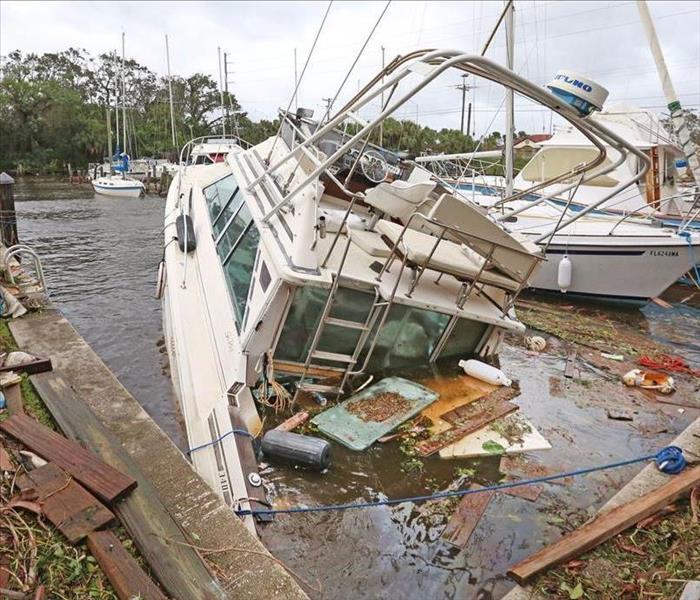 Hurricane Irma
Hurricane Irma
Hurricane season is June through November. So, here we are. Hurricane season. And though Georgia rarely gets a direct hit by a hurricane, living near the coast in the south, most people are all too familiar with the hurricane season and the tropical storms that come with it. But what about hurricane damage to your home? If you haven’t had hurricane damage before, here are 4 facts about hurricane damage you need to know before the storm hits.
1. Primary Causes of Hurricane Damage
The primary cause of hurricane damage to homes is damage from high wind and flooding from the torrential rains.
2. What the Wind Does
The wind can cause damage to siding and it can break windows and blow in garage doors. Broken and downed trees are another result of hurricane damage.
3. What the Water Does
Torrential rains can often cause flooding from overwhelmed gutters and downspouts, broken windows and damaged roofs, and saturated soil around and near your home.
4. What a Storm Damage Expert Will Do
A storm damage restoration company like SERVPRO of Virginia Beach will help you deal with hurricane damage quickly. With 24-hour emergency response and the tools and equipment to deal with the damage to trees, siding and flooding, they’re you’re one-stop-shop for hurricane damage.
Please give us a call at 757-431-1400.
Basic Mold Facts
11/16/2017 (Permalink)
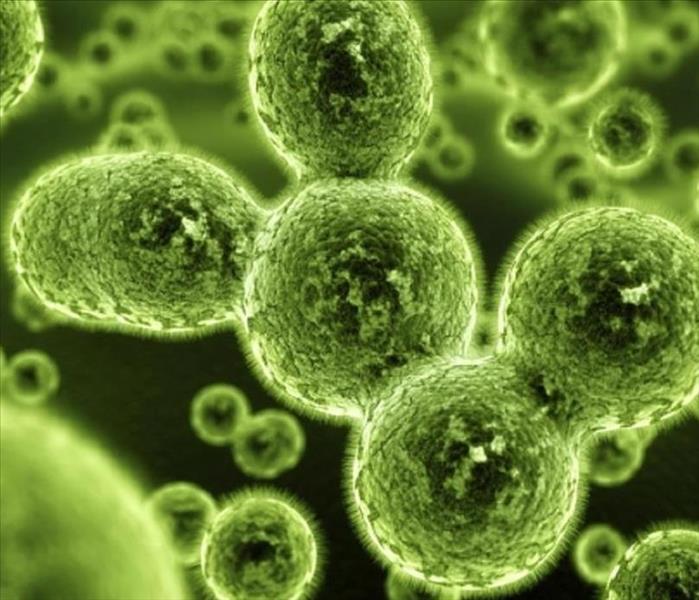 Green Mold
Green Mold
What are molds?
Molds are fungi that can be found both indoors and outdoors. No one knows how many species of fungi exist but estimates range from tens of thousands to perhaps three hundred thousand or more. Molds grow best in warm, damp, and humid conditions, and spread and reproduce by making spores. Mold spores can survive harsh environmental conditions, such as dry conditions, that do not support normal mold growth.
What are some of the common indoor molds?
- Cladosporium
- Penicillium
- Alternaria
- Aspergillus
Where are molds found?
Molds are found in virtually every environment and can be detected, both indoors and outdoors, year round. Mold growth is encouraged by warm and humid conditions. Outdoors they can be found in shady, damp areas or places where leaves or other vegetation is decomposing. Indoors they can be found where humidity levels are high, such as basements or showers.
How can people decrease mold exposure?
Sensitive individuals should avoid areas that are likely to have mold, such as compost piles, cut grass, and wooded areas. Inside homes, mold growth can be slowed by controlling humidity levels and ventilating showers and cooking areas. If there is mold growth in your home, you should clean up the mold and fix the water problem. Mold growth can be removed from hard surfaces with commercial products, soap and water, or a bleach solution of no more than 1 cup of household laundry bleach in 1 gallon of water. Follow the manufacturers’ instructions for use (see product label).
If you choose to use bleach to clean up mold:
- Never mix bleach with ammonia or other household cleaners. Mixing bleach with ammonia or other cleaning products will produce dangerous, toxic fumes.
- Open windows and doors to provide fresh air.
- Wear rubber boots, rubber gloves, and goggles during cleanup of affected area.
- If the area to be cleaned is more than 10 square feet, consult the U.S. Environmental Protection Agency (EPA) guide titled Mold Remediation in Schools and Commercial Buildings.
- Always follow the manufacturer’s instructions when using bleach or any other cleaning product.
Specific Recommendations:
- Keep humidity levels as low as you can—no higher than 50%–all day long. An air conditioner or dehumidifier will help you keep the level low. Bear in mind that humidity levels change over the course of a day with changes in the moisture in the air and the air temperature, so you will need to check the humidity levels more than once a day.
- Use an air conditioner or a dehumidifier during humid months.
- Be sure the home has adequate ventilation, including exhaust fans.
- Add mold inhibitors to paints before application.
- Clean bathrooms with mold killing products.
- Do not carpet bathrooms and basements.
- Remove or replace previously soaked carpets and upholstery.
What areas have high mold exposures?
- Antique shops
- Greenhouses
- Saunas
- Farms
- Mills
- Construction areas
- Flower shops
- Summer cottages
I found mold growing in my home, how do I test the mold?
Generally, it is not necessary to identify the species of mold growing in a residence, and CDC does not recommend routine sampling for molds. Current evidence indicates that allergies are the type of diseases most often associated with molds. Since the susceptibility of individuals can vary greatly either because of the amount or type of mold, sampling and culturing are not reliable in determining your health risk. If you are susceptible to mold and mold is seen or smelled, there is a potential health risk; therefore, no matter what type of mold is present, you should arrange for its removal.
A qualified environmental lab took samples of the mold in my home and gave me the results. Can CDC interpret these results?
Standards for judging what is an acceptable, tolerable, or normal quantity of mold have not been established. If you do decide to pay for environmental sampling for molds, before the work starts, you should ask the consultants who will do the work to establish criteria for interpreting the test results. They should tell you in advance what they will do or what recommendations they will make based on the sampling results. The results of samples taken in your unique situation cannot be interpreted without physical inspection of the contaminated area or without considering the building’s characteristics and the factors that led to the present condition.
Storm Facts, Tips and Safety
11/16/2017 (Permalink)
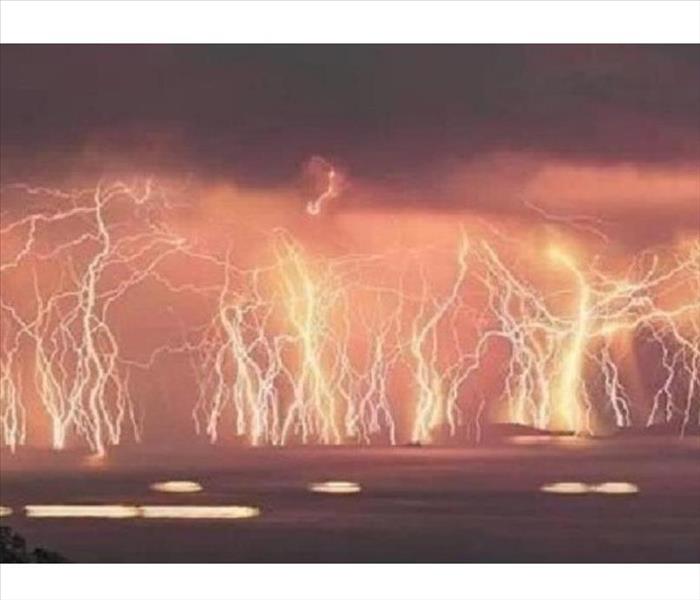 Storm Facts
Storm Facts
Severe Thunderstorm Facts
Thunderstorms are defined as storms that produce thunder and lightning. Severe thunderstorms may also produce:
- Rain
- High winds
- Sleet or snow
It’s important to note that thunderstorms do not always produce moisture. A storm in which you see lightning and hear thunder but never feel a drop of water is known as a “dry” thunderstorm. Thunderstorms that produce hail and tornadoes are known as “supercell” storms. Storms occur either in clusters or lines; therefore, they may present as a single thunderstorm or as multiple thunderstorms hitting one after the other.
Causes
Thunderstorms are caused when moisture from the lower or mid-level part of the atmosphere mixes with warm, unstable air from the ground. Moisture and air then push upwards into the higher atmosphere to form clouds that produce thunder and lightning, as well as potential precipitation. Spring, summer and fall are most conducive to thunderstorms because the sun heats the ground and moisture is more perceptible in the air, especially in humid climates.
Thunderstorms must also be lifted to begin their formation. Some sources of lift include:
- More heat on the ground than in the air
- Changes in atmospheric conditions near mountains
- Weather front changes caused by clashing cold and hot air
- Drylines, or when moist and dry air clash
- Land or sea breezes
Any of these situations can immediately create a thunderstorm without warning, even in the middle of a clear blue day. In many cases, these storms will also be accompanied by lightning. Most will not come with hail or tornadoes, unless they occur in tornado-prone states such as Kansas, Oklahoma, Texas and Missouri.
Return to Top
Thunderstorm Statistics
Severe thunderstorms are responsible for a significant number of injuries, fatalities and property damage claims across the United States every year. According to statistics reported by the National Oceanic and Atmospheric Administration (NOAA) in 2013:
- Lightning accounted for 23 fatalities, 145 injuries and $23.9 million in property damage.
- Tornadoes caused 55 fatalities, 756 injuries and $3,642.2 million in property damage.
- High winds resulted in 17 deaths, 121 injuries and $626.8 million in property damage.
- Hail led to 4 injuries and $1,234.5 million in property damage.
- Flash flooding ended in 60 deaths, 25 injuries and $956.9 million in property damage.
It’s estimated that at least 867,000 people are affected by thunderstorms every year, with lightning accounting for at least 300 injuries and roughly 60 fatalities. Moreover, at least 16 million thunderstorms occur worldwide every year — and at least 2,000 storms are causing damages and injuries around the world at any given time.
Return to Top
Preparing for Severe Thunderstorm Conditions
Severe thunderstorms can cause significant physical harm as well as damage to your home and land; therefore, it’s imperative to take measures to protect yourself. Some homeowners might invest in lightning rods to better defend their homes against a surge. There are also whole-house surge protectors so you don’t have a power outage during a severe thunderstorm. There are many other types of defenses you can put in place to protect your home against severe thunderstorms. For example, here’s how to prepare for hail, winds, tornadoes and floods.
Hail Damage
If you have a car, it’s imperative that you park it in your garage before a severe thunderstorm. Otherwise you could be looking at dents, cracks in the windshield and potentially broken glass on the driver or passenger’s side. While hail is not the most common precipitation to accompany a severe thunderstorm, it can happen. You could also:
- Install wind shutters (i.e. hurricane shutters), designed to defend against high winds and hail.
- Purchase & install pressure or high impact windows.
- Secure doors with heavy-duty bolts at the top and bottom of the door frame.
Hail can cause damage to many parts of the home, but it most commonly hits the roof the hardest. A damaged shingle, in particular, can allow water to get through to the roof deck and cause harm to your ceiling and support beams. This will eventually lead to more leaks in your roof, stains on the ceiling and walls, and potential flooding.
The cost to repair a roof following such damages will be expensive, but holding off could lead to even more costly repairs down the road. It’s best to perform repairs as quickly as possible. The two types of repairs you might be faced with include:
- Asphalt: Hail damage will appear as a dark spot or bruise because the granules will be missing. Look for holes, cracks or absent shingles. Repair immediately.
- Other shingles: Wood, metal, tile and other shingles will be hit hard by hail as well. Cracked, missing or broken shingles will allow leaking, so you’ll need a roofer in immediately to fix the problem.
Wind Damage
Winds can reach at least 300 miles per hour during a severe thunderstorm, which can rip siding off your home and exacerbate the pelting of your exterior with hail and debris as well. Wind damage repairs can cost thousands of dollars, depending on the extent of the injury. While you can’t prepare for flying debris from other houses, you can minimize damage by curtailing debris in your own yard. To prevent wind damage, you can:
- Trim back tree branches to prevent fallen limbs.
- Secure window shutters to defend against debris.
- Tie down anything that could fly away and hit the siding or the roof.
If your siding is looking worse for wear, have a siding professional come out to repair it. It could make the difference in whether you’re left with an intact home exterior after a storm or not.
Tornado Damage
Tornado damage occurs following high winds from blowing debris. While you can’t do a lot to prepare your home for a tornado, it helps to trim tree branches back from your roof and windows. You can also reinforce your roof to better handle high winds:
- Shake roof: Add more nails.
- Slate roof: Seal down with cement.
- Tile roof: Place a steel strap over the tiles.
- Asphalt roof: Nothing can be done, but inspect after.
You can also invest in a storm cellar, which is built underground and allows great defense against high winds during a tornado. A storm shelter is built close to the home so you have easy access during a tornado and don’t have to run far for safety. A storm cellar door is built at an angle so that debris blows over the door. This allows for debris to roll over the door rather than trap it, so you can get in and out easily. The confines of a storm cellar for a family is around 8 by 12 feet with an arched roof. It’s made of cement blocks and rebar to ensure maximum defenses.
Flood Damage
Flooding can cause tens of thousands of dollars in damages to your home. To prepare your home for potential flooding, ensure that the ground is sloped away from your foundation. This will defend your home against water buildup. Also, regularly maintain any storm drains, gutters and downspouts. Other tips include:
- Cleaning gutters regularly
- Check and clean storm drains on a bimonthly basis
- Clean the storm drain cover
- Check window wells and sump pumps
- Construct barriers to stop flood water from getting into your home.
- Raise your heating system to a higher floor level to avoid flood water.
- Seal cracks in the basement walls.
Return to Top
Warnings, Alerts & Where to Go
You will see severe thunderstorm warnings and alerts appear throughout the span of the storm, whether it’s on the radio, TV or your smartphone. You can find warnings:
- In emergency notifications on smartphones
- On weather apps as alerts in real time
- On the radio from the National Weather Association
- On TV at the bottom as a grey moving bar with affected counties, times
When you see a severe thunderstorm warning in effect for your area, you need to stay indoors until at least 30 minutes after the last clap of thunder. Stay away from windows and doors, in case they happen to blow open or break in high wind conditions. Stay out of water in case of lightning. If you’re driving when you get the alert, head home if you’re close or get off the road immediately.
Return to Top
Storm Recovery and Damage Repair
After a severe thunderstorm hits your home, you could be looking at a few hundred dollars worth of simple repairs — broken windows, landscape upkeep and debris removal, for example — or you could be looking at thousands of dollars in repairs due to hail damage and flooding. Survey the extent of the damage and determine whether it will cause additional long-term issues; immediately fix anything that will. Here are some common post-storm damages and how to address them:
Roof Damage
Broken tree branches, high winds, flying debris and hail can cause roof damage that will need to be addressed following a severe thunderstorm. Some signs of roof damage after a storm include:
- Holes
- Split seams
- Missing, bruised or dented shingles
- Cracked or broken tiles
- Granules in the gutters
- Leaks
- Dents on the vents and gutters or roof flashing
It’s imperative that you have a roofing contractor fix your roof following a severe thunderstorm. Otherwise, these damages could lead to expensive interior problems like attic flooding, ceiling stains, and mold. In worst-case scenarios — those in which your roof is old and cannot handle the high winds or hail storms — your roof may cave in on itself. This is uncommon, but you do run the risk of having to replace your roof if it’s reaching the 15-20 year mark around the time of a severe thunderstorm.
Siding
Weather associated with severe thunderstorms can also significantly impact the exterior and siding of your home, causing:
- Cracks that run parallel to the siding
- Chips or breaks in siding
- Breaks or holes that are punched into the siding by hail and debris
- Dings and dents, most commonly found in aluminum siding
- Paint damage such as chips, cracks and color changes or small black marks
If your siding shows cracks, chips, or dings and dents, have it repaired immediately to prevent pests, insects or climate conditions from further impacting your home. Breaks and holes, in particular, negate the siding’s ability to defend your home entirely. Such damage will require siding to be replaced by a contractor — in parts or in whole — which could cost thousands of dollars. Paint damage is the least of concerns because it’s a cosmetic injury rather than a functional one.
Windows and Doors
Windows and doors bear the brunt of severe thunderstorms’ debris and high winds, making them highly susceptible to damages. Some damages you’ll see after a storm might include:
- Cracked or splitting doors and frames
- Broken glass or shattered windows
- Debris embedded in a door or window
- Paint chipped or cracking around a door or window
Contractors recommend taking the following steps to protect your windows and doors against severe thunderstorms.:
- Window film: This keeps window glass from shattering.
- Plywood boards: Install over windows before a storm.
- Storm shutters: Shutters defend against high winds and debris.
- High impact glass: Impact glass breaks into two pieces rather than shattering when hit by debris.
Tree Damage
While you can trim your trees back before a storm, there’s still a chance that high winds, flying debris and hail will cause them to bend, twist and break during a severe thunderstorm. There are six different ways a tree can be damaged during a storm:
- Blow-over: A tree is pushed over by high winds.
- Stem failure: Stems break under high winds because of old wounds and pest damage.
- Crown twist: Tree crowns will twist and split under high winds because of poor maintenance, or because they’re lopsided.
- Root failure: Poor anchorage to the ground will cause the root to pull up or snap, and the tree will fall or lean over.
- Branch failure: Branches will break off from the tree because they’re poorly attached in the first place.
- Lightning: Lightning will hit the tree and cause small explosions down the line of the tree, causing it to break and fall.
There’s not much a homeowner can do to prep a tree for potential damage except provide good care and maintenance. Trim trees on a regular basis and try to keep branches away from your home and power lines.
Flood Damage
If your home is flooded following a severe thunderstorm, there are various steps you can take to recover your home. It’s going to be a long process, involve a lot of tearing up, remodeling and time, but your home will go back to its original state eventually. Some recommendations from the CDC include:
- Wear safety gear.
- Get rid of anything that can’t be cleaned (bedding, fabric flooring, upholstery, toys, linens)
- Throw away drywall and insulation that’s wet.
- Deep clean and scrub hard surfaces with hot water and dish detergent.
- Use fans, A/C units and dehumidifiers to speed the drying process.
- Wash all clothing touched by flood water with hot water and laundry detergent.
Be aware of electrical power lines, natural gas lines, frayed wires and any other hazards from flooding that could injure you. You should check with the gas company or the fire department before returning to your home to avoid injury. Do not return to your home during the day to avoid any accidents from being unable to see. You shouldn’t be allowed to return until the police or fire department say it’s okay. You should also not wade in standing water or around downed power lines, just in case.
If you need help with the big part of the recovery job — pulling up carpet, taking down drywall, removing appliances, so forth — you can call in a disaster recovery contractor to help you. These professionals are licensed and experienced in handling situations like flood recovery and know where to start. They can also look out for disaster-specific issues like mold, foundation issues and the like.
Return to Top
Top States for Thunderstorms
Some states are more prone to severe thunderstorms than others, which means homeowners in such states need to be better prepared. According to a report on WeatherBug, in 2013 the top states for severe thunderstorms between March 1 and June 17 included:
- Texas: 922 events*
- Oklahoma: 725 events
- Kansas: 652 events
- Missouri: 515 events
- Illinois: 456 events
- Nebraska: 405 events
- Iowa: 403 events
- New York: 252 events
- Mississippi: 233 events
- Virginia: 232 events
- Louisiana: 223 events
*Note: events are defined as severe thunderstorms
The most active states — Texas, Oklahoma, Kansas and Missouri — received 300 severe thunderstorm alerts per week.
Return to Top
Thunderstorm Safety Tips and Prevention
To keep your home and family safe before and during a thunderstorm, it’s imperative that you take precautionary measures — especially if you live in an area prone to storms.
To prepare for a thunderstorm, the Federal Emergency Management Association (FEMA) recommends:
- Putting together an emergency kit and family plan
- Removing debris and branches
- Securing outdoor objects that could blow away or damage the home
- Staying inside your home
- Closing all exterior windows and doors
- Unplugging all electronic equipment before the storm.
While there isn’t much you can do to prevent a severe thunderstorm, you can keep the damages to a minimum by securing as much in your home as possible and reinforcing the defenses around your home exterior. Tie down your roofing or seal it with mortar, call in siding professionals and clean up all the debris around your house.
There are storm damage professionals who can come in following a natural disaster and help with the recovery. While they don’t fix everything, they can help you start the process. If you want to read more about what they do, read this FAQ from the National Storm Damage Center.
How to Keep Your Insurance Down
Standard homeowner policies cover your home and what’s in it. You should be covered for storm damages and major natural disasters, including severe thunderstorms; however, flooding is not generally covered. Storm-resistance improvements that will lower your premiums include:
- Impact-resistant shingles
- High impact glass
- Storm shutters
Always file a claim following a severe thunderstorm if your home is extensively damaged.
Severe Weather Facts & Myths
11/16/2017 (Permalink)
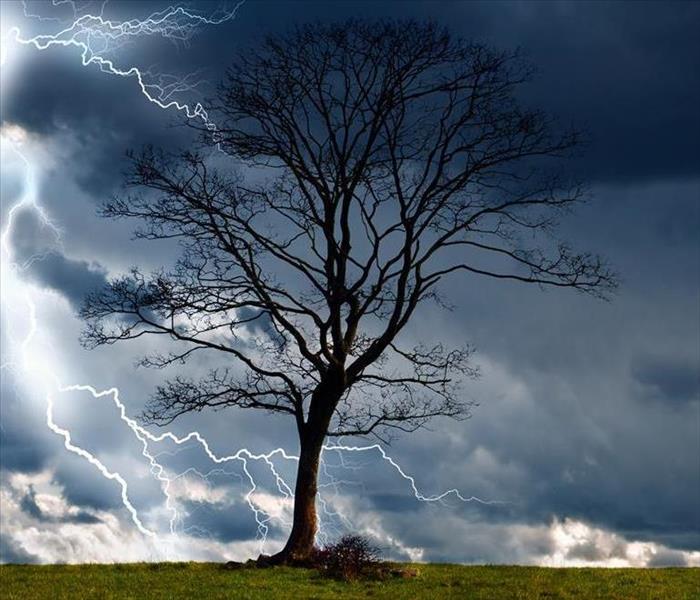 Thunder Storm
Thunder Storm
Myth: Highway and interstate overpasses are safe shelters against a tornado.
Fact: Overpasses can concentrate the tornado winds, causing them to be significantly stronger. This places the people under them in an even more dangerous situation. In recent years, several people seeking shelter beneath overpasses have been killed or severely injured. Being above ground level during a tornado is dangerous.
Myth: The low pressure with a tornado causes buildings to explode. Opening the windows will equalize the pressure, saving the building.
Fact: Opening the windows in an attempt to equalize pressure will have no effect. It is the violent winds and debris that cause most structural damage. It is more important for you to move to a safe area away from windows and exterior walls. With a tornado, every second counts, so use your time wisely and take cover.
Myth: Thunderstorms and tornadoes always move from west to east.
Fact: More often than not, thunderstorms move from west to east. Conditions in the atmosphere dictate how and where storms will move, and it can be in any direction. Tornadoes have been known to act erratic, and can change directions and speed very quickly. Never try to outrun a tornado in a vehicle.
Myth: It’s not raining here, and skies above me are clear, therefore I am safe from lightning.
Fact: Lightning can strike many miles away from the thunderstorm. If storms are in your area, but skies happen to be clear above you, that certainly does not imply you are safe from lightning. Though these “Bolts from the Blue” are infrequent, lightning strikes 10 to 15 miles away from the storm are not out of the question.
Myth: Since I am inside my house and out of the storm, I am completely safe from lightning.
Fact: Just because you have taken shelter inside, you are not automatically safe. While inside waiting out a storm, avoid using the telephone or electrical appliances and do not take showers or baths. Also stay away from doors and windows. Telephone lines, cords, plumbing, even metal window and door frames are all lightning conductors and pose a threat
Myth: Large and heavy vehicles, such as SUVs and pickups, are safe to drive through flood waters.
Fact: It is a common belief that the larger the vehicle, the deeper the water it can drive through. Many people do not realize that two feet of water can float most vehicles, including SUVs and pickups. If the water is moving rapidly, vehicles can be swept away.
Myth: Flash floods only occur along flowing streams.
Fact: Flash floods can and do occur in dry creek or river beds as well as urban areas where no streams are present.
Mold Found in Local Virginia Beach, VA Home
11/16/2017 (Permalink)
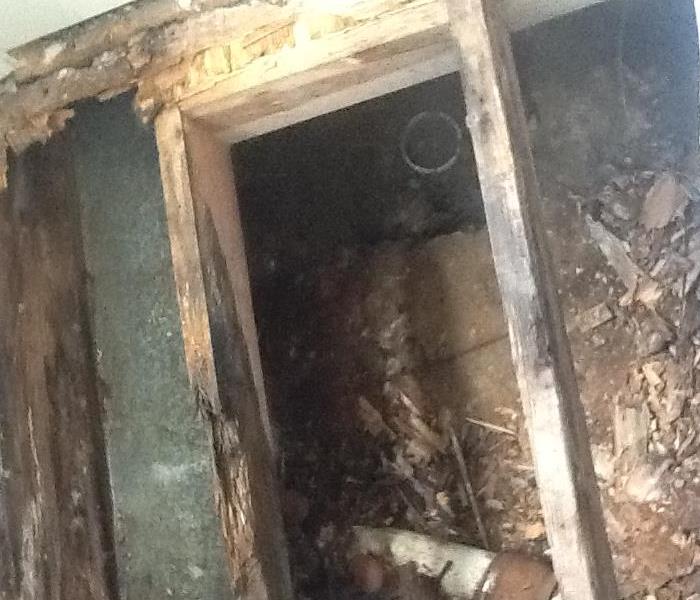 Mold beneath wall
Mold beneath wall
Mold on wall11/10/2017
This mold was found after this local family called us for a pipe burst that happened behind their wall. Our technicians saw this after doing demolition and wanted to get this tested before resuming to make sure this was mitigated properly. After confirming with the industrial hygienists that this was indeed mold we performed the proper mitigation. Such as wearing the correct PPE, setting air scrubbers, sanitizing, and also doing tear out as needed to ensure that it was gone.
Please be sure to call SERVPRO of Virginia Beach for any mitigation needs you may have. 757-431-1400
10 Facts About Black Mold
11/16/2017 (Permalink)
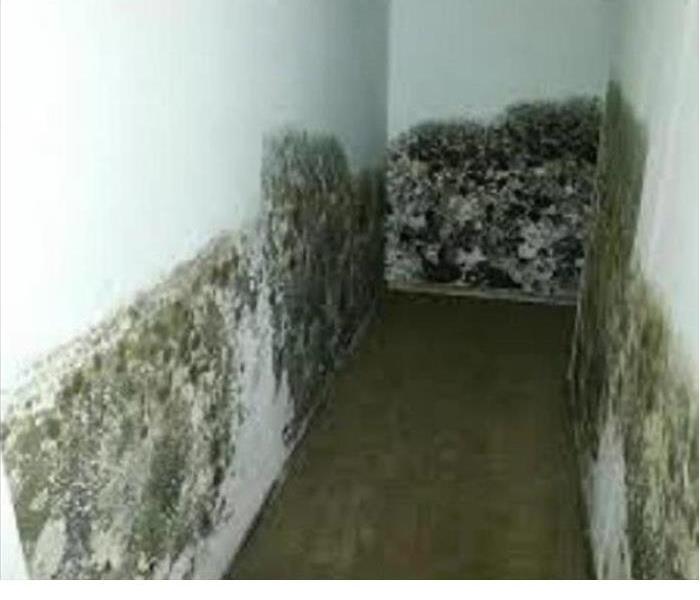 Mold
Mold
Here Are 10 Facts About Stachybotrys Mold That You Need to Know
1. The “Toxic Black Mold” People Are Most Concerned About Is Called Stachybotrys Chartarum or Stachybotrys Atra.
For the purposes of this article I have interchanged the names Stachybotrys, Black Mold and Stachy to mean the same thing.
In fact, this particular mold gained wide scale recognition as one of the most harmful fungi, especially in the United States. Back in 1993-1994, there was a serious outbreak of pulmonary hemorrhage affecting infants in Cleveland Ohio.
Research revealed that Stachybotrys Chartarum growing inside the home of the sick infants.
Since that time there have been a number of other cases involving “Toxic Black Mold” across the nation, resulting in lawsuits and problems for building owners on how to address this issue.
However, there is much debate regarding the specifics on this topic with regard to medical claims… yet the common consensus is that people get sick when they ingest or breathe the harmful mycotoxins from this fungus.
It should also be stressed that several other non-related mold types, including Aspergillus can be dangerous as well. Some of these other molds are black, as well as green, blue, pink, brown, white and yellow.
Anytime you see a moisture issue and resulting mold in your home or building, the situation must be addressed in short order. Call in a professional for best results.
2. According To The Centers for Disease Control and Prevention, Black Mold, And All Other Mold Is Not Toxic…
The term “Toxic Mold” is apparently incorrect. Instead, it is the mycotoxins released from this fungus that are considered toxic. I have included a link at the bottom of this article for more clarification on this.
3. Black Mold May Or May Not Produce Toxins.
According to another article written in Mold-Help.org blog, there are a variety of conditions that will determine whether a mold will produce toxins. Although this mold has the ability to produce health compromising toxins, they do not always release the poisons.
It depends on a number of factors, such as the surface it is grows on, the temperature, the food source and humidity.
4. Stachybotrys Is A Wet, Sticky Mold.
Stachy spores are clumped together in a sticky coating so they do not usually travel well in air currents like many other mold types. However, if they dry out or become disturbed, they can be disbursed.
Dry mold is not really dead; it lies dormant and can still be dangerous. In the dry state it can take on the appearance of soot.
Due to its sticky make up, Stachy is best collected and tested by taking physical swab or tape surface samples. They can then be sent to a microbial lab for analysis.
Inspectors may suspect that a home has Stachybotrys, (based on visible observation) yet still choose to conduct air samples to determine if any other kinds of mold are present.
Knowing that these spores do not travel well in the air, you should be especially concerned if the only one tiny Stachybotrys clump is revealed in a lab report. This is a clear indication that thousands more are likely to be present.
5. Excessive Prolonged Moisture Leads To Stachybotrys growth.
This fungus needs to be exposed to moisture for long periods of time (1-2 weeks) before it begins to colonize.
Other mold types commonly found in a home, such as Aspergillus, Penecillium and Cladosporium, can grow within 24-48 hours.
Indoors, it grows best on organic cellular materials like insulation paper backing, drywall, ceiling tiles, cardboard, wallpaper or any other paper based materials.
A quick case study: During one of my inspections, a large concentration of Stachybotrys Chartarum was found behind a mattress leaning along a bedroom wall. According to the strata president, this was caused by high humidity over a three-month stretch.
Normally one would expect to see this fungus growing because of a long-standing flood or leak rather than high humidity.
To save money, the homeowners were air-drying all of their laundry in one bedroom, while keeping the windows and door closed. It was like a humid rain forest.
The takeaway from this… high humidity over time can cause this fungus to grow. Keep the windows open (about an inch or two) for cross ventilation and always use the dryer rather than hanging moist clothing in a closed room.
6. Poisonous Toxins Released By Stachy, And Other Molds Are Called Mycotoxins.
These poisons (mycotoxins) are what make people ill when they are ingested or inhaled. Another reason this mold has been called Toxic Black Mold is due to the fact that it produces more mycotoxins than most other types of indoor mold.
7. Toxic Black Mold Is Not Always Visible.
This mold is not easily seen for a number of reasons. It needs to be sitting in moisture for at least 8 days to begin growing. Visible leaks are usually dealt with right away, so it wouldn’t have the time to colonize.
A small leak that develops over time can start the process when the leak is not visible. Problems begin without us knowing, as many leaks are concealed behind walls, and under carpets, floorboards above the ceiling in and areas that have been saturated for long periods of time.
At this point is it too late… People begin to experience health effects, or eventually see the signs once it has established a presence. By this time, the subsequent damage can be vast and expensive.
8. This Black Mold Has A Very Distinctive Odour.
Some would describe it as a potent, damp, stale, musty or rotting earthy wood smell. If this strong type of odour is present, yet different from other rooms in the home, then the area should be investigated for mold infestation. Consider this a priority.
9. Over Time, Stachy Will Usually Dominate Other Molds.
Through testing and analysis we know that this mold grows best when exposed to moisture for at least a week, or more. When its food source is low in nitrogen and high in cellulose, (organic materials) Stachy is happy… us and other molds, not so much.
Although different mold colonies will likely grow beforehand, once the Stachy takes form, it will dominate the environment completely.
10. Dry Mold Will Grow Again When Exposed To Moisture.
It’s true… Stachybotrys and several other mold types can sit dormant for thousands of years until it gets wet, allowing new growth to take form.
For this reason, I strongly recommend calling in a professional remediation contractor to discard all contaminated items, and or building materials.
Call SERVPRO of Virginia Beach for any mold remediation needs you may have. 757-431-1400
Fun Storm Facts
11/16/2017 (Permalink)
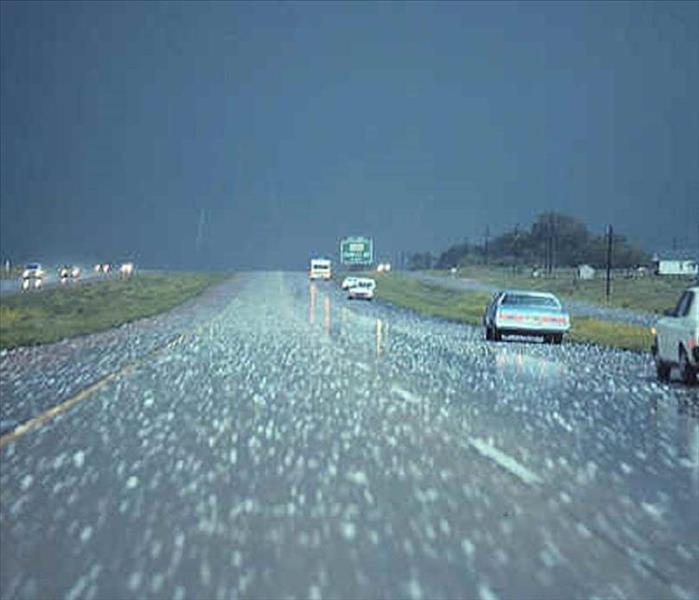 Hail Storm
Hail Storm
Are you afraid of storms, or do you embrace them? Whichever side you fall on, we all have some sort of respect for storms. They can cause great damage, paint beautiful pictures across the sky, alter any outdoor plans, and completely turn a day around. Although you’ve probably experienced many thunderstorms in your life, you might not know a whole lot about them. In today’s post, we’re going to share some fun storm facts that you may not have known!
- The typical thunderstorm is 15 miles in diameter!
- The typical thunderstorm lasts about 30 minutes.
- About 1,800 thunderstorms are happening around the world at any given moment.
- Lightning kills more people than tornadoes every year.
- A severe storm “watch” means that a serious storm has the potential to develop, but has not developed yet. However, a sever storm “warning” means that a storm has developed and been sighted.
- About 10% of storms are classified as “severe”.
- If you’re ever heard the term the “four horsemen” of thunderstorms, it’s referring to wind/tornadoes, hail, floods, and lightning.
- Thunderstorm clouds grow to heights of above 20,000 feet!
- A “derecho” is a type of severe storm that lasts a long time, covers a great distance, and involves serious wind.
- Wind speeds can be up to 120 mph in thunderstorms, even without a tornado.
- A massive hailstorm in Munich, Germany, in 1984 caused over $1 billion worth of damage.
- In 1933, huge hailstones were reported to have fallen around a city in Massachusetts, containing fresh, frozen ducks inside.
10 Important Fire Damage Facts
11/8/2017 (Permalink)
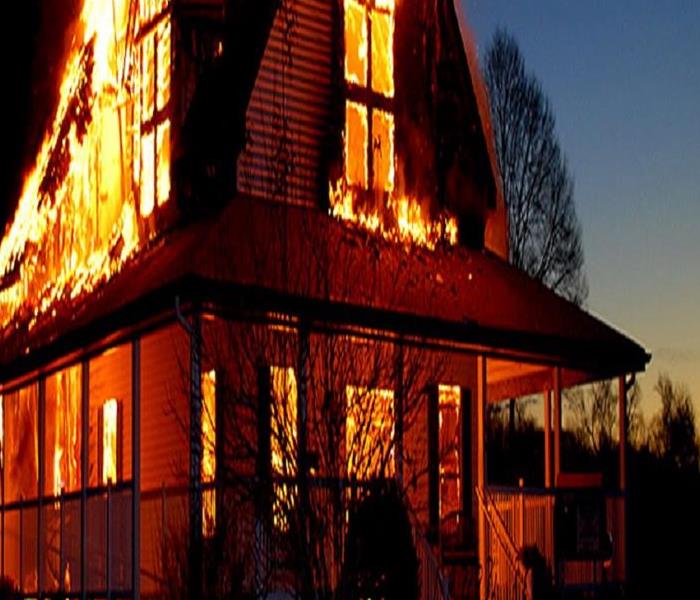 House on Fire
House on Fire
While flames can cause the most visible damage to your property during a fire, smoke and soot are silent and sometimes invisible hazards that could cost lives. Water is also a reason for damage after a fire. Even firefighters themselves may cause some damage before they can completely put out a fire. Here are 10 important things to know about fires.
1. In a fire, more people die from inhaling smoke than from the flames. Never think that if you avoid the flames you are safe. Always keep away from smoke.
2. Soot is a coating of fine, black dust created when wood, coal, or oil-based substances are burned. These carbon particles float into the air and settle anywhere. Inhaling soot can caused severe lung deficiencies or even death.
3. If soot contaminates items in your home or business, a fire restoration service provider like SERVPRO must assess the damage to see if restoration is possible.
Need Fire Restoration Advice Or Services? Call SERVPRO Of Virginia Beach At 757-431-1400
4. The worst possible effect of soot is its tendency to cause cancer and cause serious defects in newborns. Soot produces poly cyclic aromatic hydrocarbons. These hydrocarbons are responsible for gene mutation for particular groups of genes. They can cause birth defects and increase the chances of getting cancer.
Water’s Good And Bad
5. Water’s great at putting out most fires but the water itself can cause great damage. You must make sure, after the fire is out, that your home or business is completely dried.
6. Mold colonies can begin to grow just 48 hours after water damage occurs. The combination of fire, water, and mold damage to your commercial property or home could result in a complete loss if not handled properly. See our posts about mold, mold myths, and how to clean up mold.
7. Use caution if you decide to do some of the cleanup after a fire. Never start your cleaning process until you’re properly attired. Wear heavy-duty gloves, safety goggles, and a face mask. Carefully cover your nose and make sure your safety glasses have no place for dust or soot to get into your eyes.
Why Firefighters Break Windows And Cut Holes In Roofs
8. Firefighters are true heroes. However, they often must break windows and cut holes in the roof of buildings on fire. As a fire burns, the fire moves up and down and across, growing very fast. Firefighters break windows and cut holes in roofs to provide ventilation that slows the fire’s growth. Ventilation also helps get rid of dark smoke that makes it hard for firefighters to see where they’re going. The holes and broken windows help firefighters fight the fire more quickly. The bottom line is that breaking windows and cutting holes in roofs help save lives and property.
9. Firefighters will also cut holes in walls at times. That’s not about ventilation. It’s done so the fire department is sure that the fire is completely out. Fire departments don’t want to risk leaving a fire that’s not visible but is still active inside the walls or in other hidden places.
10. If you have a fire, get a copy of the fire report. In most areas, a fire report is a public document. Ask for it at the fire department or fire marshal’s office. The fire report will help you with information that your insurance company and other official offices may request.
For more, see After The Fire: Returning to Normal from FEMA.
Here To Help
The team at SERVPRO of Virginia Beach has specialized training and experience in fire restoration services and natural disaster cleanup.
Call SERVPRO of Virginia Beach 757-431-1400 anytime, 24/7.
Facts About Mold
11/8/2017 (Permalink)
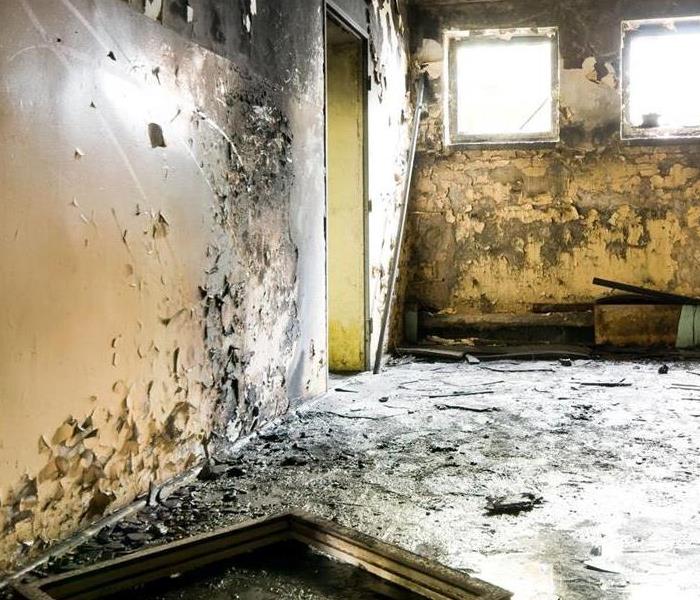 Mold Photo
Mold Photo
The Facts about Mold: For Everyone
What is mold?
The term “mold” is a colloquial term for a group of filamentous fungi that are common on food or wet materials. This includes the green Penicillium species that produces penicillin, and fungi that spoil our bread, fruit, cheese and crops. Most of these are Ascomycetes that produce a lot of spores.
The majority of the molds that grow on damp building materials are found in the soil and are adapted to grow on a wide variety of materials. Outdoors, molds live in the soil, on plants, and on dead or decaying matter. There are thousands of species of mold and they can be any color. Different mold species are adapted to different moisture conditions ranging from very wet to just damp. Many times, mold can be detected by a musty odor. Live spores act like seeds, forming new mold growths (colonies) under the right conditions. All of us are exposed to a variety of fungal spores daily in the air we breathe, both outdoors and indoors.
How mold gets into a house or building
Mold and fungal spores occur naturally outdoors, where fungi are the earth’s most important recyclers. Indoors, mold needs moisture to grow; it becomes a problem only where there is water damage, elevated and prolonged humidity, or dampness. Common sources of excessive indoor moisture that can lead to mold problems include:
- flooding from surface waters (i.e., overflowing rivers) or from severe storms;
- roof leaks from damaged or missing roofing materials, ice dams or blocked gutters;
- storm-driven rain through window frames, exterior walls or door assemblies;
- leaking pipes, sewer back-ups or overflows;
- damp basements or crawl spaces due to a high water table or poorly managed rainwater drainage; and
- condensation on cold surfaces.
How to prevent mold growth
The key to preventing and stopping indoor mold growth is to control excessive moisture and condensation. Keeping susceptible areas in the home clean and dry is critical. In general, mold will not grow indoors without water, dampness or excessive moisture.
Three main factors contribute to condensation of water on building surfaces:- Relative Humidity: Condensation occurs when the air is saturated with water and it cannot hold any more moisture. For example, steam generated from bathroom showers or from cooking can fill up the air with moisture, which will then condense into drops of water on cooler surfaces, such as mirrors and windows. Where possible, localized sources of humidity, such as clothes dryers, should be directly vented to the outdoors. To lower indoor humidity during warm, humid weather, air conditioners and/or dehumidifiers should be used. In chronically damp areas such as basements or crawlspaces, it is often recommended that dehumidifiers be used to maintain humidity levels below 60 percent.
- Temperature: Warm air holds more moisture than cold air. Condensation occurs when warm humid air comes into contact with a cold surface and the moisture condenses into water. This can often be seen on single-pane windows, where water condenses and then runs down, causing the wood frames and sills to rot and the wall under the windows to blister. Condensation can occur on exterior walls, particularly north-facing walls, if they are not properly insulated. Other chronically cold surfaces, such as cold water pipes, should be covered with insulation to help prevent condensation.
- Poor Ventilation: Indoor humidity can build up if there is not enough ventilation and exchange of indoor and outdoor air. Where there is little or no air movement, such as behind dressers and cabinets, surfaces can remain cooler than surrounding areas, which can lead to increased condensation and mold growth. It is recommended that the area be ventilated and the occupants use exhaust fans (vented to the outdoors) to remove moisture from high-humidity areas, particularly in bathrooms, kitchens and laundry areas. Furniture should be moved slightly away from walls so that air can freely pass behind it. Air should be allowed to circulate between rooms and regularly ventilate to remove humid air. Fans should be used as needed.
Other things that can be done are to clean and repair gutters regularly, make sure the ground slopes down and away from the home’s foundation and keep air conditioner drip pans and drain lines clean. In addition, in air conditioned buildings in hot and humid climates, vinyl wall coverings on the interior sides of exterior walls should not be used, as these materials can trap moisture, resulting in mold growth underneath them.
In the case of floods or leaking pipes, any standing water should be promptly removed and water-damaged materials should either be dried out and cleaned, or removed and replaced. Porous materials that are wet for more than 48 hours are likely to produce mold growth and should be discarded. In instances where the water damage is extensive, it is recommended that professional help, such as a commercial restoration company, be consulted.
If you think you may have mold or have had a water damage,please call SERVPRO of Virginia Beach at 757-431-1400.
Four Signs of Water Damage in Your Commercial Building
11/2/2017 (Permalink)
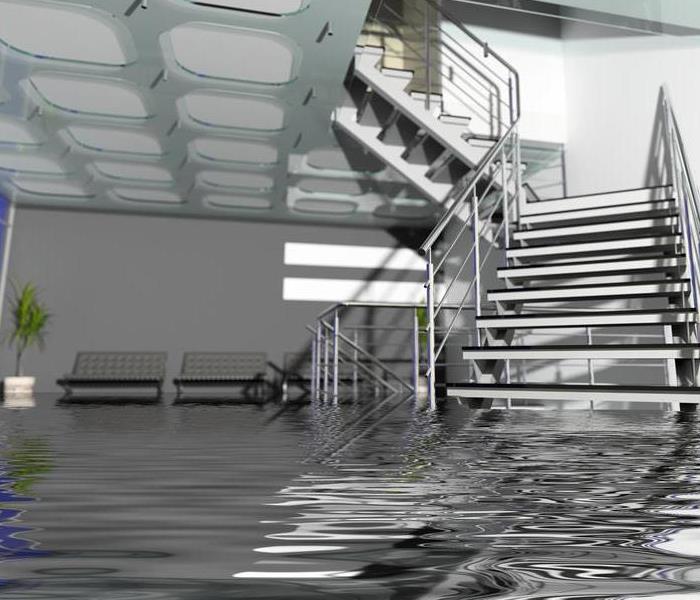 Commercial Water Damage
Commercial Water Damage
When water infiltrates your masonry, time is of the essence. The longer a leak lasts, the more damage it does. If you see any of these signs of a leak, you should get your masonry evaluated by a professional.
1. Bulging, spalling, and cracking
These are all exterior signs of a leak that is degrading the masonry. Once water has leaked past the mortar joints, it can wear away at the masonry. After water has begun corroding the steel beneath, this damage will become much worse as a result of rust jacking.
2. Rust staining
This is a late-stage sign of water infiltration. You’ll find this commonly in concrete structures, where the red rust stain is visible on a lighter surface. When you see rust staining, it’s a sign that water has penetrated not only the masonry but the steel structure beneath. Water is causing the corrosion of the steel, which leaves a stain on the masonry surface.
Steel will expand as it rusts, creating further damage to your building’s structure. We call that rust jacking.
3. Mold and musty odors
After water has made it past the exterior, you may notice signs of water damage inside the building. One of these signs could be a sign of mildew or mold. Mold is not always easy to detect.
4. Interior damage
Other interior signs that can tip you off to a water leak are staining on interior walls and ceilings. You may also see cracked drywall or peeling wallpaper as water begins to saturate your interior walls.
Keep water from damaging your building
At SERVPRO of Virginia Beach, we help restore and rehabilitate the exterior of commercial buildings so you don’t have to worry about what happens when water leaks into your building. We can help you prevent it from happening and even if water damage does happen we can always make it "Like it never even happened."
What's New at SERVPRO of Virginia Beach ?
10/26/2017 (Permalink)
 Roto Brush
Roto Brush
Clean air ducts are the foundation for good indoor air quality. As homeowners and business owners, you want to be able to breathe clean indoor air for your families, your guests, employees and customers. Over several years, air ducts can become contaminated with mold, fungi and bacteria, as well as dust. Running your HVAC system is only filtering whatever is in your dirty ducts throughout your home or facility. Proper cleaning with professional air duct cleaning machines and systems is the BEST way to improve indoor air quality.
At SERVPRO of Virginia Beach, our mission is to be the premier property damage restoration contractor in Hampton Roads. To do so, we are continuously training our staff and updating our procedures to stay current (and the BEST!) within our industry.
We are VERY excited to introduce this new air duct cleaning technology to our inventory;
The Brushbeast by Rotobrush.
It's four powerful vacuum motors, paired with it's 450 RPM 120/220V brush motor, will make short work of even the most difficult air duct cleaning job, while still remaining safe to use with any type of air duct system, including flex ducts.
This new equipment will help make our duct cleaning procedures more fast and efficient.. And your dirty ducts, Like they never even happened.
Contact our office 757-431-1400 for Residential and Commercial Duct Cleaning Prices AND Specials!
Ways to Spot Frozen Pipes
10/25/2017 (Permalink)
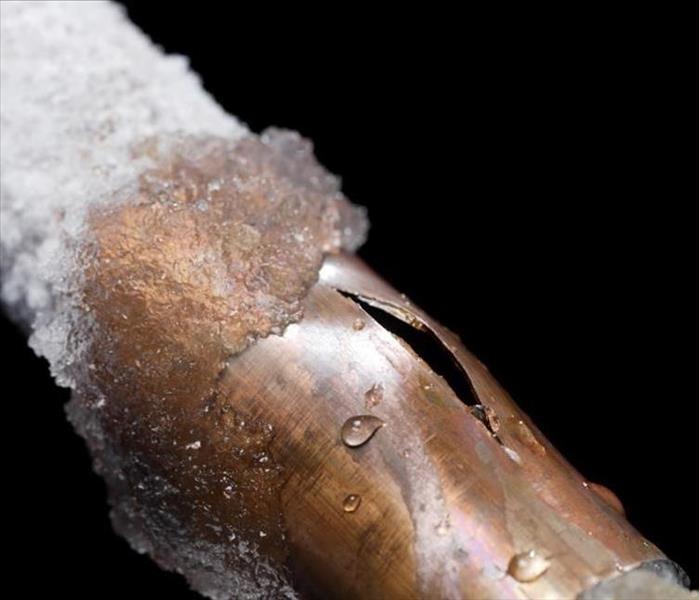 Frozen Pipe
Frozen Pipe
As the weather begins to transition into the colder months there are certain precautions homeowners should begin to take to keep their home safe under freezing conditions.
One of the most common headaches homeowners face during the colder months are frozen pipes.
Have you ever placed a can of soda in the freezer and simply just forgot about it and by the time you realized you forgot the can has already exploded making a mess of your freezer? Well, when water freezes in a pipe, it expands in the same way. If it expands enough, the pipe bursts and water escapes leaving serious damage as a result.
Pipes in attics, crawlspaces, and outside walls are all vulnerable to freezing, especially if there are cracks or openings that allow cold, outside air to flow across the pipes. Holes in an outside wall where television, cable or telephone lines enter can provide access for cold air to reach pipes.
Pipes tend to freeze after consecutive days and nights of freezing (32degrees Fahrenheit) and below freezing temperatures.
Frozen pipes should cause many homeowners concern, for bigger issues may and will arise. If you are unaware of the status of your pipes or what are some clues of a frozen pipe here’s a few signs that may help you.
- A slow stream of water, or no water at all coming through.
- Visible frost on your pipes
- Unusual loud sounds coming from your faucets
- Strange odors coming from your faucets
If any of these signs appear then it likely means your pipes have burst. If this is true, you must act fast, a few things you can do to prevent any further damage.
- This first step is to always shut down your property’s main water supply. (Depending on the amount of water and location, you may want to first turn off electricity.)
- If it’s heated water that’s coming from the broken pipe, you should also close the valve attached to your hot water heater.
- After you’ve shut down the water, call a plumber for help with repairing or replacing the burst pipe.
During this time of need, make SERVPRO of Virginia Beach your first call to help you and your local insurance agent assess the damage. We will work for you to restore your property and your life to make it "Like it never even happened."
Water Damage Facts vs. Fiction
10/25/2017 (Permalink)
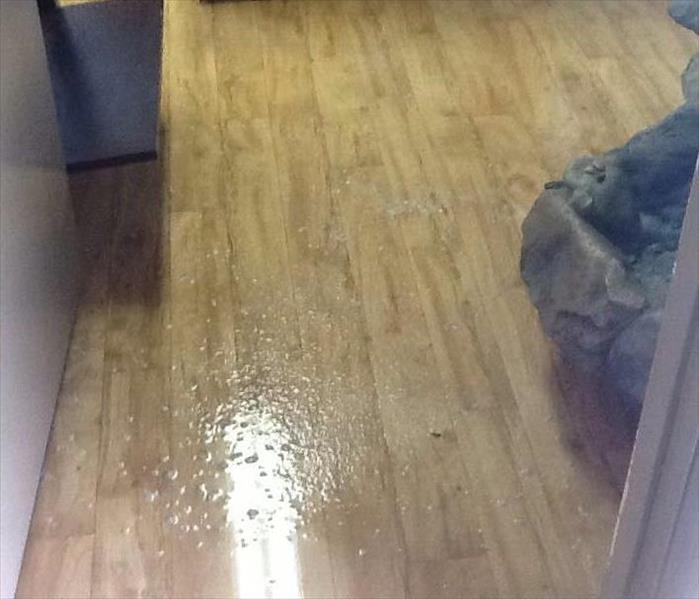 Water Damage
Water Damage
Water damage is a common problem. Most homes will have water damage at some point. There are a lot of myths about water damage.
Myth: Insurance Will not pay for Water Damage
Fact: In most cases, home insurance and renters insurance will pay for water damage. However, every company is different. Make sure that you ask your insurance provider if they will pay for water damage.
Myth: You can Take Care of Water Damage Yourself
Fact: You should always call a professional if your home has water damage. If water damage is not handled properly, then mold can develop. You may also end up spending more money in the long run if you do not get water damage repaired by a professional.
Myth: Water Removal can Wait
Fact: You do not want to wait. The longer you wait, the more likely your home is to develop mold. The water may also damage your floor and possessions.
Myth: Water Damage is not There if you Cannot see It
Fact: You may not be able to see the water damage. The water may in the ceiling or walls. A professional will be able to find the hidden water.
Myth: Water Removal is the Only Thing That is Necessary
Fact: Water removal is the first step. However, there are several other things that need to be done after all of the water is removed. The professional will have to sanitize and disinfect the area. They will also have to apply an anti-fungicide to the area in order to prevent microbial growth.
Myth: Water Damage Does not Smell
Fact: Mildew has a musky smell.
If you need a water damage specialist please call our water damage restoration experts at SERVPRO of Virginia Beach at 757-431-1400
It's The Water You Don't See...
10/25/2017 (Permalink)
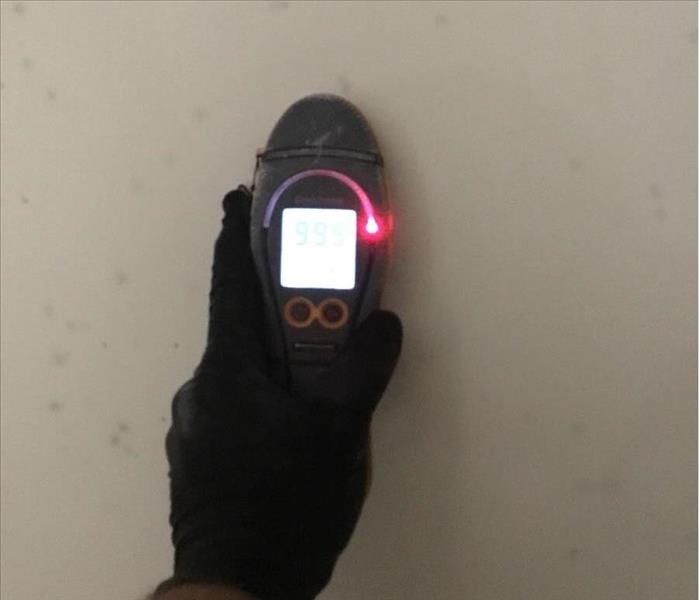 Moisture Readings
Moisture Readings
It's The Water You Don't See...
Even small water damages have the potential to cause serious structural and indoor air quality issues over time.
The key to avoiding costly future restoration is to handle every water problem as a real threat to your property. The proper equipment makes a measurable difference in reducing the damage expense during a water loss. When time matters most, technology and equipment must be counted on to perform.
Here are a few tools used by Professional Restoration Contractors to properly mitigate a loss;
Moisture Sensors- used to detect moisture in carpets, baseboards and walls.
Moisture Meters- used to determine the actual moisture content of various materials. The meter provides accurate readings to monitor the drying process.
Thermohygrometers- measures temperature and relative humidity to calculate and create an environment most conducive to drying. When handling a contaminated loss (CAT 2 or 3), it is not only important to dry the structure, but disinfect and often deodorize.
Ultra Low-Volume (ULV) Foggers- used to atomize liquid deodorizing agents, producing a fine mist that can easily penetrate the site where odor-causing residues may accumulate. It can also be use to inject fungicides and disinfectants into wall cavities and other hard-to-reach areas.
Thermal Foggers- dispenses solvent-based products by creating a dense fog that consists of tiny particles of deodorant solution that attach to and neutralize odor causing particles.
The bottom line... ALWAYS treat a water damage seriously. Call a professional contractor that is trained and experienced in property damage restoration.
Call SERVPRO of Virginia Beach for any restoration needs you may have at 757-431-1400.
6 ways to prepare now for hurricanes
9/18/2017 (Permalink)
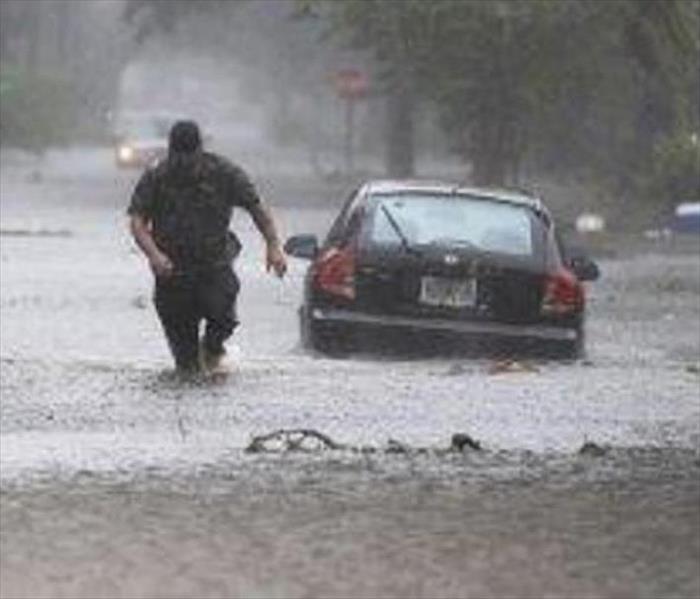 Hurricane Photo
Hurricane Photo
The worst thing that people who live along coastlines can do is not to prepare for tropical storms and hurricanes.
According to the National Hurricane Center, the two key factors contributing to weather safety during hurricanes are preparing in advance for the risks and to act on those preparations when alerted by emergency officials.
The director of the National Hurricane Center, Rick Knabb, and AccuWeather Hurricane Expert Dan Kottlowski, outlined certain precautionary steps that people in areas impacted by hurricanes and tropical storms should take.
1. Evacuation planning
The main reason people have to evacuate during hurricanes is from a storm surge, which is an abnormal rise of water generated by a storm’s winds that can reach heights well over 20 feet and can span hundreds of miles of coastlines, according to the National Hurricane Center.
"Evacuation planning is number one on the list,” Knabb said.
Knabb urged that people find out today if they live in a hurricane evacuation area, which is an area in which residents must leave their homes in the event of a hurricane.
Local governments provide the public with information about evacuation areas and the evacuation plans, and Knabb recommended that people review this information in advance.
“Some people will actually test the evacuation route in good weather,” Kottlowski said. “Waiting until the day of the hurricane isn’t a smart idea since everyone will be in a heightened state of anxiety.”
While people who live in storm surge areas fall within areas that are urged to evacuate during a hurricane, people who live outside of these zones should still look into safety precautions during a hurricane.
While evacuation shelters do provide supplies, Kottlowski said, “Shelters can get overrun and may not have enough supplies."
These kits should include water, food, blankets and clothing.
Dimitri Pinckney installs hurricane shutters in advance of Hurricane Matthew on the Isle of Palms, S.C., Wednesday, Oct. 5, 2016. (AP Photo/Mic Smith)
Car owners should also contact auto insurance companies and move their cars into an off-site location or secured building.
“You won’t be able to take every vehicle you own to the shelter, but if you leave the vehicle outside, it could be seriously damaged,” Kottlowski said.
4. Make copies of important documents
Those living in or near hurricane areas should make copies of proof of ownership documents of any property not limited to their homes, cars and boats.
These documents can be stored in the hurricane kit or in any safe location that does not risk being damaged during the hurricane.
“If a hurricane levels your house, you have to prove that it is your house,” Kottlowski said.
5. Protect your home
Residents and tenants should inspect their homes to confirm that there is no damage that a hurricane could increase.
Any issues with the overall structure should be repaired, including loose shingles or damaged roofs.
“Any possible compromises to the roof or house will become an open avenue for strong and gusty winds,” Kottlowski said.
Residences with yards should also make a list of anything laying on the ground outside that could get tossed into the air and become debris during high winds.
Kottlowski also said residents should purchase supplies, including plywood to cover windows and extra security to keep doors from blowing open, in advance, to secure their homes from damaging winds.
6. Back up your electronics
Aside from keeping extra batteries and chargers around during a hurricane, people are also encouraged to backup any electronic devices.
Knabb said data should be stored at an off-site location so that data can be recovered if something were to happen to the physical computer or device during a hurricane.
Make SERVPRO of Virginia Beach your first call to help you and your local insurance agent assess the damage. We will work for you to restore your property and your life to make it "Like it never even happened®." 757-431-1400
Staying Safe in the Summer
6/9/2017 (Permalink)
Each summer, families and friends across the country enjoy the summer months with barbecues, camping trips, or by cooling off in a pool or lake. In order to enjoy these occasions, it is important to keep safety top of mind to ensure you have fun in the sun.
According to the United States Fire administration, just under 8,600 Americans are injured by fireworks and almost 5,000 are injured by charcoal/wood burning and propane grill fires, annually. A barbecue grill should always be supervised when in use. Keep children and pets a safe distance from the grilling area to prevent accidental burns or tipping off the grill.
If you enjoy lounging by the pool or going for a boat ride to cool off from the summer sun, make sure you exercise caution, especially when children are present. Only swim in approved areas and supervise children at all times when near the water.
Summertime should be a time to make memories and enjoy the great outdoors. The following tips, provided by the National Fire Protection Association (NFPA), will help keep you safe all summer long.
- When using a charcoal grill, only use starter fluid designed for barbecue grills; do not add fluid after coals have been lit.
- When using a gas grill, ensure the hose connection is tight; check hoses for leaks. Applying soapy water to the hoses will easily and safely reveal any leaks.
- Always wear a U.S. Coast Guard-approved PFD (personal floatation device) when boating, jet-skiing, tubing or water-skiing. Air-filled swimming aids, like water wings or inner tubes, are not substitutes for approved PFDs. An adult should always supervise children using these devices.
- Be sure to extinguish all smoking materials and shut down motors and heating devices before fueling a boat. In case of a spill, wipe up fuel and check for fuel leakage and odors.
- When camping, always use a flame retardant tent and setup camp far away from the campfire. Only use flashlights or battery-powered lanterns inside the tent, not liquid-filled heaters or lanterns.
- Always build a campfire down wind from the tent area. Clear vegetation and dig a pit before building your campfire. Always extinguish the fire before going to sleep or leaving the campsite. To extinguish, cover with dirt or pour water over the fire.
- Store liquid fire starter (not gasoline) away from your tent and campfire and only use dry kindling to freshen a campfire.
- Consider leaving firework use to trained professionals. Stay back at least 500 feet from professional fireworks displays.
Your local SERVPRO Franchise wishes you a safe and happy summer!
Getting Ready for the Upcoming Heat
5/24/2017 (Permalink)
As summer approaches, it is time to consider safety precautions for extreme heat in the coming months. Heat affects all people, but especially the young, elderly, sick, and overweight. Urban area residents also have a greater chance of being affected than those who live in rural areas due to the heat island effect.
According to the EPA, "the can can heat dry, exposed urban surfaces, such as roofs and pavement, to temperatures 50-90°F hotter than the air, while shaded or moist surfaces -- often in more rural surroundings -- remain close to air temperatures." These surface island heat islands are more likely after sunset "due to the slow release of heat from urban infrastructure."
Whether you are in an urban or rural area, there are several things you can do to prepare for and prevent extreme heat from affecting you. If possible, stay indoors in air conditioning. Be sure to check on your pets who may be outdoors or bring them inside. Stay hydrated and limit alcohol and caffeine intake.
If you must go outside, wear loose-fitting, light-colored clothing, and be sure to apply sunscreen often. Pay attention to signs of heat exhaustion, which are heavy sweating; weakness; cold, pale, and clammy skin; nausea or vomiting; and fainting, according to the Center for Disease Control and Prevention (CDC). Heat exhaustion can lead to heat stroke, which is life-threating. Signs of heat stroke are a high body temperature (103°+), rapid and strong pulse, and possible unconsciousness. If you think someone has heat stroke, call 911 immediately and move the person somewhere cool. Reduce body temperature with cool, wet cloths or a bath. Do not give a person with heat stroke fluids, and treat the situation as s serious medical emergency (CDC).
If you live in a humid climate, be aware of the heat index. The heat index factors in the humidity, which can make the temperature feel 15° hotter.
Extreme heat is a serious danger. For more information on preparation and prevention, visit ready.gov or cdc.gov.
Extreme Heat Safety Tips to Prepare You Home
- Install window air conditioners snugly; insulate if necessary.
- Check air-conditioning ducts for proper insulation
- Install temporary window reflectors (for use between windows and drapes), such as aluminum foil-covered cardboard, to reflect heat back outside.
- Weather-strip doors and sills to keep cool air in.
- Cover windows that receive morning or afternoon sun with drapes, shades, awnings, or louvers. (Outdoor awnings or louvers can reduce the heat that enters a home by up to 80%).
- Keep storm windows up all year.
Source: ready.gov
Poor Indoor Air Quality? -- Dirty Air Ducts are the Culprit!
5/2/2017 (Permalink)
More often times than not poor air quality in homes and commercial buildings can be attributed to a dirty ventilation system. Your HVAC system should be a high priority and demand your attention regularly. Dirty ducts can circulate odors, contaminants such as mold, and irritating dust throughout your building or home.
A routine service that SERVPRO offers is inspections of the heating, ventilation and air conditioning (HVAC) unit. Keeping the HVAC system and ductwork clean can potentially extend the life span of the equipment by allowing it to operate at peak condition, which may save you money!
SERVPRO Duct Cleaning System is proven and cost efficient. We use a portable ventilation and air duct cleaning system to examine ductwork and make a clean sweep, removing years of dust and grime.
Contact us today for more information or to schedule a duct cleaning appointment!
Emergency Fire Damage Do's & Don'ts
5/2/2017 (Permalink)
These tips will assist you in taking proper actions until we arrive to a scene of a fire. Follow these DOs and DON'Ts to help reduce damage and increase the chances of a successful restoration:
DO:
- Limit movement in the home to prevent soot particles from being embedded into carpet and avoid tracking
- Keep hands clean. Soot on hands can further soil upholstery, walls and woodwork
- If electricity is off, empty freezer and refrigerator completely and prop doors open to help prevent odor
- Wipe soot from metal kitchen and bathroom faucets, trim, and appliances.
- If heat is off during winter, pour RV antifreeze in sinks, toilet bowls, holding tanks, and tubs to avoid freezing pipes and fixtures
- Tape double layers of cheesecloth over air registers to stop particles of soot from getting in or out of the HVAC system
DON'T:
- Don't attempt to wash any walls or painted surfaces without contacting SERVPRO first
- Don't attempt to clean any electrical appliances that may have been close to fire, heat, or water without first consulting an authorized repair service
- Don't turn on ceiling fixtures if ceiling is wet. Wiring may be wet or damaged and cause electrical shock, and air movement may create secondary damage
"Prepare" is the Buzz Word of 2017
1/24/2017 (Permalink)
Resolutions are key to starting the new year, so why not resolve to be READY? No one ever plans on a disaster, but you can prepare for it. The SERVPRO Emergency READY Profile (ERP) will help ensure you are "Ready for whatever happens" in 2017.
In the event of an emergency, the ERP can help minimize business interruption by having an immediate plan of action in place for your facility. The ERP is a comprehensive document containing critical information about your business, including emergency contacts, shut-off valve locations and priority areas. The ERP also establishes your local SERVPRO of Virginia Beach as your disaster mitigation and restoration provider, giving you access to over 45 years experience and a System more than 1,700 Franchises strong. The ERP is a no-cost assessment; all it requires is a little time, making it a great value that could save you time and money in the future. By downloading the free SERVPRO READY App, this information is stored electronically and can be accessed using your mobile device putting help at your fingertips.
Having a plan in place may help minimize the amount of time your business is inactive and get you back in the building following a disaster. Don't wait until disaster strikes -- resolve to be READY.
Always Be Prepared! -- How to Prepare for Winter Weather and Avoid Water Damage
1/5/2017 (Permalink)
As seasons change, so do property owners preparation checklists. With winter weather upon us, it is important for homeowners and property managers to do everything they can do to reduce risks of costly water damage caused by frozen pipes.
When water freezes, it expands. That’s why a can of soda explodes if it’s put into a freezer to chill quickly and then forgotten. When water freezes in a pipe, it expands the same way. If it expands enough, the pipe bursts and water escapes leaving serious damage as a result.
Pipes in attics, crawlspaces, and outside walls are all vulnerable to freezing, especially if there are cracks or openings that allow the cold, outside air to flow across the pipes. Holes in an outside wall where television, cable or telephone lines enter can provide access for cold air to reach pipes.
The Red Cross warns that pipe freezing is likely to occur after consecutive days and nights of freezing (32 degrees) or below conditions. Taking the following precautions ahead of time can help you prevent potential pipe catastrophes:
- Keep a slow trickle of water flowing through faucets, especially if the pipes for faucets run through unheated or uninsulated areas of your home. Allowing cold water to trickle from a faucet can alleviate pressure and prevent a rupture even if freezing occurs.
- If a vacant home, keep the temperature above 65 degrees.
- Cap outdoor water fixtures. By placing a cover on outdoor spigots and faucets, it reduces the possibility these fixtures build up with ice.
- Keep cabinet doors open during cold spells. This allows warm air to circulate around pipes.
If you have done nothing to prevent frozen pipes and you have water leaking or you have no water pressure, it likely means your pipes have burst. According to State Farm Insurance, this happens to more than 50 million families each year in the United States. If a pipe has even 1/8” crack, it can release 250 gallons of water a day.
You must act fast to prevent further, and more costly damage.
- This first step is to always shut down your property’s main water supply. (Depending on the amount of water and location, you may want to first turn off electricity.)
- If it’s heated water that’s coming from the broken pipe, you should also close the valve attached to your hot water heater.
- After you’ve shut down the water, call a plumber for help with repairing or replacing the burst pipe.
Make SERVPRO of Virginia Beach your first call to help you and your local insurance agent assess the damage. We will work for you to restore your property and your life to make it Like It Never Happened®.
SERVPRO of Virginia Beach got the call to send our Disaster Recovery Team to Louisiana
9/13/2016 (Permalink)
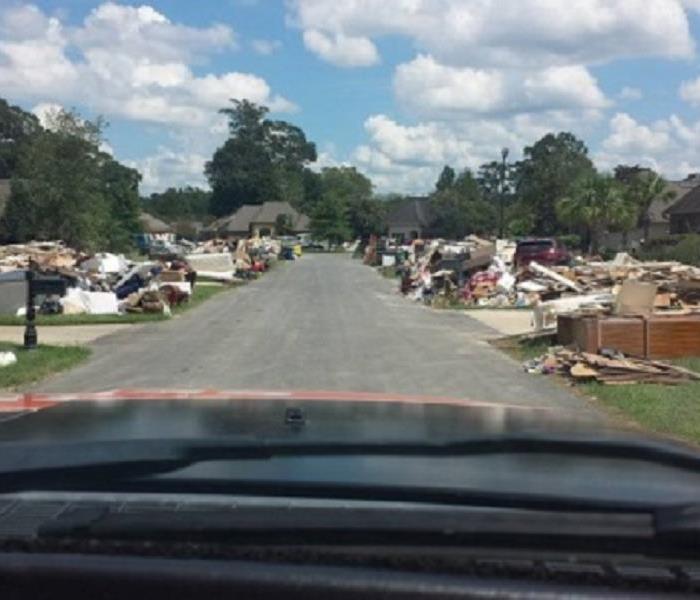 Storm Disaster on 1 street in Louisiana
Storm Disaster on 1 street in Louisiana
At first we believed we were traveling to Louisiana to help restore the flood damage
….We found we were restoring more than homes, we were restoring Lives
I am so honored to have been a part of SERVPRO of Virginia Beach’s Disaster Recovery Team and even more honored to work for a company like SERVPRO. Within hours SERVPRO had mobilized the largest restoration team to go to Louisiana. Over 2,000 SERVPRO employees, hundreds of trucks and equipment and the best experience and knowledge in the industry made way to the devastated regions of Louisiana. Most of you have heard me talk about our capabilities and strength in numbers but this time I was a part of it and experienced it first hand. To say I was WOWED is an understatement. Every corner, every road bled green and orange as SERVPROs from across the country gathered together to restore homes and lives. It was amazing to see and the best part was the hugs, smiles and thumbs up we received from the Louisiana residents. I am especially proud of the hardworking crew of SERVPRO of Virginia Beach, working 12 to 14 hour days with little sleep and a huge determination to do the job right and to quickly help those in need.
Our Disaster Recovery Team consisted of myself, Jason Cheracles, Wally Anderton, Ben Wynkoop, LaNese Holiday, Malcolm Williams, Bryce Games, Esteban Casillas, Kris Spell, Stephan Spell, Jerry Noell and Robert Kite. We aren’t just saying SERVPRO is the best, we are living it. I am a proud employee of SERVPRO of Virginia Beach. And when you need us, we will be there to make it like it never even happened.
Virginia Beach Smoke & Soot Cleanup
8/24/2016 (Permalink)
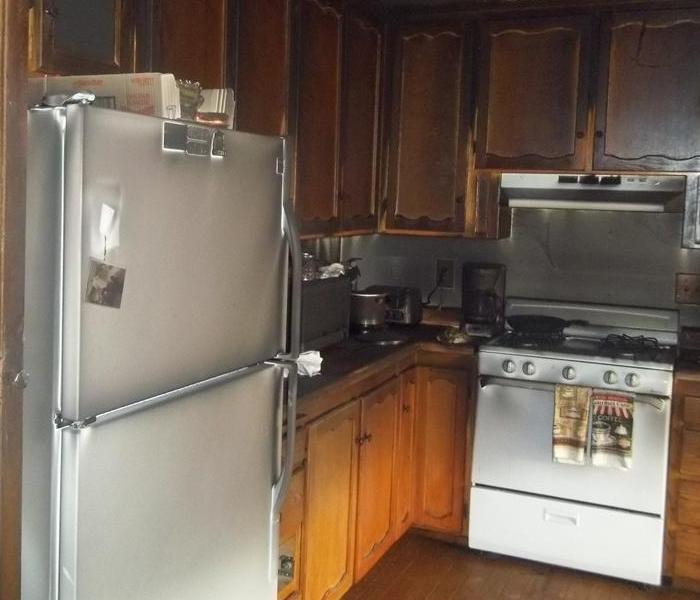 Smoke and soot damage can cause a pervasive odor in your Virginia Beach home.
Smoke and soot damage can cause a pervasive odor in your Virginia Beach home.
Smoke and soot is very invasive and can penetrate various cavities within your home, causing hidden damage and odor. Our smoke damage expertise and experience allows us to inspect and accurately assess the extent of the damage to develop a comprehensive plan of action.
Smoke and soot facts:
- Hot smoke migrates to cooler areas and upper levels of a structure.
- Smoke flows around plumbing systems, seeping through the holes used by pipes to go from floor to floor.
- The type of smoke may greatly affect the restoration process.
Different Types of Smoke
There are two different types of smoke–wet and dry. As a result, there are different types of soot residue after a fire. Before restoration begins, SERVPRO of Virginia Beach will test the soot to determine which type of smoke damage occurred. The cleaning procedures will then be based on the information identified during pretesting. Here is some additional information:
Wet Smoke – Plastic and Rubber
- Low heat, smoldering, pungent odor, sticky, smeary. Smoke webs are more difficult to clean.
Dry Smoke – Paper and Wood
- Fast burning, high temperatures, heat rises therefore smoke rises.
Protein Fire Residue – Produced by evaporation of material rather than from a fire
- Virtually invisible, discolors paints and varnishes, extreme pungent odor.
Our Fire Damage Restoration Services
Since each smoke and fire damage situation is a little different, each one requires a unique solution tailored for the specific conditions. We have the equipment, expertise, and experience to restore your fire and smoke damage. We will also treat your family with empathy and respect and your property with care.
Have Questions about Fire, Smoke, or Soot Damage?
Call Us Today – 757-431-1400
September: National Preparedness Month
8/17/2016 (Permalink)
As a business owner or manager, you are a leader in your community and have the opportunity to set an example for your employees, customers and community to follow. This September 2016, join our community in preparing for emergencies and disasters of all types and leading efforts to encourage the community as a whole to become more prepared.
Disasters not only devastate individuals and neighborhoods, but entire communities, including businesses of all sizes. As an employer in your community, having a business continuity plan can help protect your company, its employees and its infrastructure, and maximizes your chances of recovery after an emergency or disaster. Ready Business asks companies to take three simple steps: plan to stay in business, encourage your people to become Ready and protect your investment.
This year, the Ready Campaign and Citizen Corps, with support from Coalition Members across the nation, including a wide range of businesses and organizations, is focusing National Preparedness Month (NPM) on encouraging individuals, families, and businesses to take active steps toward becoming Ready. We must work together as a team to ensure that our families, businesses, neighborhoods, and communities are Ready. Ready Business, an extension of the Ready Campaign, helps business owners and managers of small and medium-sized businesses prepare their employees, operations and assets in the event of an emergency. The Business section of Ready.gov contains vital information for businesses on how to get started preparing their business and their unique needs during an emergency. For more information on NPM, or for help preparing your business, call 1-800-BE-READY, 1- 888-SE-LISTO, and TTY 1-800-462-7585 or visit Ready.gov/business where business owners can download or order free Ready information, publications, and much more.
SERVPRO of Virginia Beach will be speaking at this event!
6/2/2016 (Permalink)
Date: June 29, 2016
Time: 8:30 am
Tips To Avoid Accidents in Occupied & Vacant Commercial StructuresLocation: Great Bridge Dry Cleaners, 408 Network Station, Chesapeake,VA 23320
Here is an excerpt from the HRRA website regarding the Commercial Alliance:
Commercial Alliance
The Commercial Alliance is a council within the Hampton Roads REALTORS® Association. This professional organization represents Commercial REALTORS® throughout the Southeastern Virginia Region who specialize in selling, leasing and managing commercial real estate. Member firms include Appraisers, Attorneys, Title Companies, Lenders, Developers, and other entities associated with commercial sales and leasing. The Commercial Alliance provides networking opportunities and serves as a business partner disseminating news and information to all its members while serving the needs of commercial professionals in Southeastern Virginia for well over 20 years.
http://www.hrra.com/councils-and-committees/commercial-alliance.html
Breakfast with Bizzy Bea's Flooring
5/27/2016 (Permalink)
Thank you to Arneta Cato with Bizzy Bea's in Virginia Beach, VA for bringing SERVPRO of Virginia Beach breakfast on May 4th!
Arneta came in to teach us about flooring options that are "water friendly" and easy to clean types of carpet.
She also went into short detail about their kitchen and bath remodeling, as well as being a total home renovation company.
Thank you for the education!
Bizzy Bea's Floor To Ceiling Remodeling
3022 Virginia Beach Blvd.
Virginia Beach, VA 23452
sales@bizzybeaflooring.us
www.bizzybeas.com
757-222-3353 - Store
Golf Anyone?
5/26/2016 (Permalink)
This 2016 Spring has been a Golfer's dream. SERVPRO of Virginia Beach has already participated in 7 Community Association Golf outings as sponsors, and as attendees. We have even had the pleasure of placing 1st at the Lynchburg Claims Association outing in Amherst, VA on May 20th, and 1st at the Tidewater AGCVA tournament on May 9th. Thank you to all who have participated!
Training, Training, and more Training!
5/26/2016 (Permalink)
SERVPRO of Virginia Beach has been busy this spring increasing our skills and knowledge. We have had more employees take additional IICRC certification classes in Fire & Smoke Restoration Technician (FSRT), Commercial Drying Specialist (CDS), and Applied Structural Drying (ASD). Some have also been certified in HIPAA, Hazwoper, Subrogation and Forklift/AWP training. We are excited to put this knowledge to use and make your damage "Like it never even happened."
3 Ethics Classes were a SUCCESS!
5/26/2016 (Permalink)
Thank you to all the agents that came to one of our 3 FREE classes offered in April 2016!
We love seeing you all and are glad that we can provide classes that help you meet your Virginia Insurance Education requirements.
We are planning more classes later this year, and look forward to seeing you again.
Partnering with the City of Virginia Beach LEPC
5/26/2016 (Permalink)
 City of Virginia Beach & City of Virginia Beach Fire Department
City of Virginia Beach & City of Virginia Beach Fire Department
The City of Virginia Beach Local Emergency Planning Committee (LEPC) invited SERVPRO of Virginia Beach to come to their meeting on Tuesday April 5, 2016 to give a presentation on Water Damage Restoration. We enjoyed meeting our representatives from the community, including law enforcement, emergency medical services, fire services, local environmental agencies, health care, media, industry, and local officials.
We appreciate all that they do!
Contact Information
Office of Emergency Management
https://www.vbgov.com/government/departments/fire/emergency-mgmt/Pages/local-emer-planning.aspx
2016 Hurricane Season to be Most Active since 2012
5/23/2016 (Permalink)
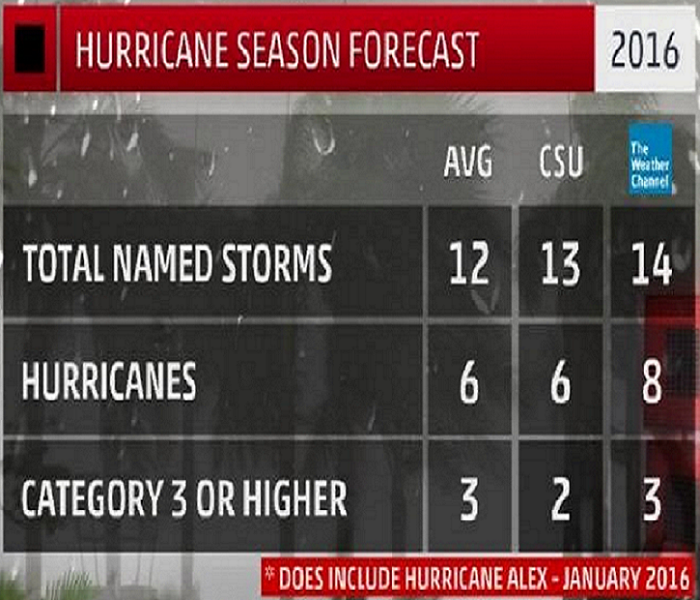 2016 Hurricane Forecast
2016 Hurricane Forecast
2016 Hurricane Season to be Most Active Since 2012
The 2016 Atlantic hurricane season is expected to be the most active since 2012, according to a forecast released Friday by The Weather Company, an IBM Business.
A total of 14 named storms, eight hurricanes and three major hurricanes are forecast during the coming season.
This is greater than the 30-year historical average of 12 named storms, six hurricanes and three major hurricanes for the Atlantic basin. A major hurricane is one that is Category 3 or stronger on the Saffir-Simpson Hurricane Wind Scale.
The Weather Company's forecast also calls for a slightly higher number of named storms and hurricanes than an outlook issued earlier in April by Colorado State University (CSU) that is headed by Dr. Phil Klotzbach. That forecast said the Atlantic was expected to see 13 named storms, six hurricanes and two major hurricanes.
An important note about both outlooks is that the seasonal forecast numbers do include Hurricane Alex, a rare January hurricane that struck the Azores a few months back. Though the official hurricane season spans the months from June through November, occasionally we can see storms form outside those months.
Goodbye El Nino.. Hello La Nina
The strong El Niño we saw this winter continues to fade away and may transition to its counterpart La Niña by this fall. Of course, if this handoff from El Niño to La Niña conditions occurs, it could happen during the middle of the 2016 hurricane season.
Klotzbach said that the transition from El Niño to neutral or La Niña conditions during the 2016 hurricane season makes this particular hurricane outlook very uncertain.
The transition could cause the early part of the hurricane season to be less active while the second half of the season may more active, according to The Weather Company's outlook.
757-431-1400 | www.SERVPROofvirginiabeach.com
What's NEW at SERVPRO of Virginia Beach?
4/26/2016 (Permalink)
 BRUSHBEAST by Rotobrush Air Duct Cleaning Machine
BRUSHBEAST by Rotobrush Air Duct Cleaning Machine
Clean air ducts are the foundation for good indoor air quality. As homeowners and business owners, you want to be able to breathe clean indoor air for your families, your guests, employees and customers. Over several years, air ducts can become contaminated with mold, fungi and bacteria, as well as dust. Running your HVAC system is only filtering whatever is in your dirty ducts throughout your home or facility. Proper cleaning with professional air duct cleaning machines and systems is the BEST way to improve indoor air quality.
At SERVPRO of Virginia Beach, our mission is to be the premier property damage restoration contractor in Hampton Roads. To do so, we are continuously training our staff and updating our procedures to stay current (and the BEST!) within our industry.
We are VERY excited to introduce this new air duct cleaning technology to our inventory;
The Brushbeast by Rotobrush.
It's four powerful vacuum motors, paired with it's 450 RPM 120/220V brush motor, will make short work of even the most difficult air duct cleaning job, while still remaining safe to use with any type of air duct system, including flex ducts.
This new equipment will help make our duct cleaning procedures more fast and efficient.. And your dirty ducts, Like they never even happened.
Contact our office 757-431-1400 for Residential and Commercial Duct Cleaning Prices AND Specials!
Mold Prevention Tips
4/22/2016 (Permalink)
Mold. The very sound of the word is enough to make a person cringe.
Yes, mold can be good-- it's essential in making brie and penicillin, for example, but it can also be very, very bad, especially when it grows undetected in your home.Some Facts About Mold
Mold spores spread easily and cannot be completely eradicated. Mold can grow anywhere: on carpet, clothing, food, paper and even in places you can't see, such as the back of drywall, areas inside walls around leaking or condensing pipes, or above ceiling tiles. Not only is a mold problem difficult and costly to fix, but mold can also produce allergens and irritants (and rarely, toxins) that may compromise your health. So what can you do if you're concerned about mold growing on a property? The best approach is preventing mold before it becomes a problem. And the key to mold prevention is simple: moisture control. Mold Prevention Tips
Click below for nine ways to curb moisture indoors, and the mold that thrives on it. 9 Ways to Curb Indoor Moisture and Prevent Mold:
1. Identify problem areas and correct them. You can't mold-proof a property, but you can make it mold-resistant. Do an audit of the property: where are the problem areas? Does the basement flood? Do you notice frequent condensation on an upstairs window? Is there a water stain on the ceiling from a persistent leak? Preventing mold from growing or spreading might be as simple as ripping up carpet in a damp basement, installing mold-resistant products, or repairing damaged gutters. Or it may be a matter of major excavation and waterproofing. Whatever the case, address the problem now. It might cost some money up front, but it will surely be more costly down the road if mold continues to grow unchecked.
2. Dry wet areas immediately. Mold can't grow without moisture, so tackle wet areas right away. Seepage into the basement after a heavy rainfall, accumulation from a leaky pipe, even a spill on the carpet should be dried within 24 to 48 hours. If you've experienced a flood, remove water-damaged carpets, bedding, and furniture if they can't be completely dried. Even everyday occurrences need attention: don't leave wet items lying around the house, and make sure to dry the floor and walls after a shower. Don't leave wet clothes in the washing machine, where mold can spread quickly. Hang them to dry — preferably outside or in areas with good air circulation.
3. Prevent moisture with proper ventilation. It may be that your routine domestic activities are encouraging the growth of mold in the property. Make sure an activity as simple as cooking dinner, taking a shower, or doing a load of laundry doesn't invite mold by providing proper ventilation in your bathroom, kitchen, laundry room, and any other high-moisture area. Vent appliances that produce moisture — clothes dryers, stoves — to the outside (not the attic). Use AC units and dehumidifiers (especially in humid climates), but make sure they don’t produce moisture themselves by checking them periodically and cleaning them as directed by the manufacturer. Your energy-efficient property may be holding moisture inside, so open a window when cooking or washing dishes or showering, or run an exhaust fan.
4. Equip the property with mold-resistant products. Building a new home or renovating an old one? Use mold-resistant products like mold-resistant drywall or mold-resistant Sheetrock, and mold inhibitors for paints. Traditional drywall is composed of a gypsum plaster core pressed between plies of paper. Mold-resistant drywall is paperless — the gypsum core is covered in fiberglass, making the surface highly water-resistant. Moisture-resistant drywall is especially valuable in areas prone to wetness, such as bathrooms, laundry rooms, basements, and kitchens. Not only is traditional drywall more susceptible to mold than the paperless kind, but it is also difficult to rid of mold, and removal and replacement can be expensive. Mold-resistant gypsum board is also available; the core of the drywall is developed in such a way to prevent moisture absorption, and thus prevent mold growth.
5. Monitor humidity indoors. The EPA recommends keeping indoor humidity between 30 and 60 percent. You can measure humidity with a moisture. You'll also be able to detect high humidity by simply paying attention to potential problem areas of the property. Telltale signs of excessive humidity include condensation on windows, pipes, and walls. If you notice condensation, dry the surface immediately and address the source of moisture. (For example, turn off a humidifier if water appears on the inside of nearby windows.)
6. Direct water away from the property. If the ground around the property isn't sufficiently sloped away from the foundation, water may collect there and seep into your crawlspace or basement.
7. Clean or repair roof gutters. A mold problem might be a simple matter of a roof that is leaking because of full or damaged gutters. Have your roof gutters cleaned regularly and inspected for damage. Repair them as necessary, and keep an eye out for water stains after storms that may indicate a leak.
8. Improve air flow in your home. According to the EPA, as temperatures drop, the air is able to hold less moisture. Without good air flow in a property, that excess moisture may appear on your walls, windows and floors. To increase circulation, open doors between rooms, move furniture away from walls, and open doors to closets that may be colder than the rooms they’re in. Let fresh air in to reduce moisture and keep mold at bay.
9. Keep mold off household plants. They're beautiful and help keep your indoor air clean — and mold loves them. The moist soil in indoor plants is a perfect breeding ground for mold, which may then spread to other areas of your house. Instead of getting rid of your plants, try adding a bit of Taheebo tea to the water you give to your houseplants. The oil of this tree, which withstands fungi even in rain forests, helps hinder mold growth in plant soil and can be found at natural food stores.
Finally, educate yourself on your region's climate — be it the cold and wet Northeast, the hot and wet South, the hot and dry Southwest, or the cold and dry West — and how it responds to moisture. There is no one-size-fits-all solution when it comes to mold prevention. Knowing what works for your climate and your home is an important first step.
Announcing our NEW 5000cfm Desiccant
3/4/2016 (Permalink)
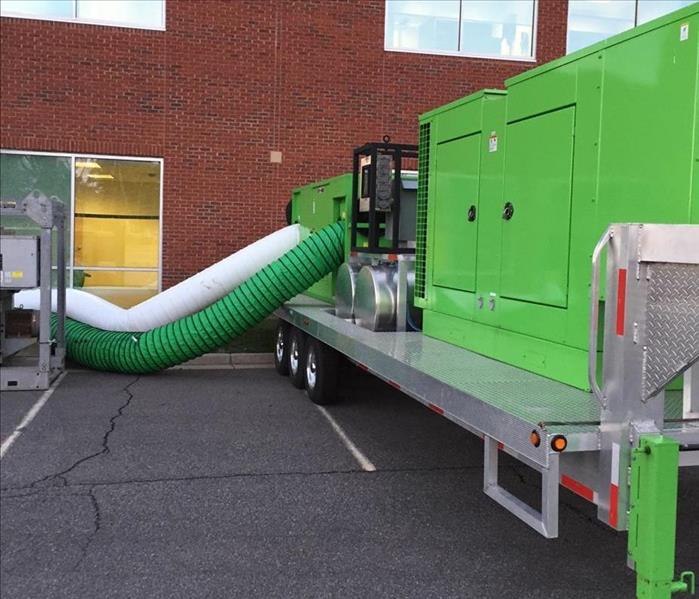 The New Desiccant at Work!
The New Desiccant at Work!
At SERVPRO of Virginia Beach, our mission is to be the premier fire and water restoration contractor in Hampton Roads. To do so, we are continuously training our staff and updating our procedures to stay current within our industry. We are very excited to introduce this state of the art piece of equipment and announce that we are the ONLY restoration contractor in Hampton Roads to own it!
This commercial trailer houses a 5000 CFM Desiccant, capable of drying a medium to large commercial building, and a 150kw Generator. Together, this trailer of equipment can conveniently save both time and money when it matters most.
For more information, contact SERVPRO of Virginia Beach at (757) 431-1400.
Are Your Ducts In Order?
5/4/2015 (Permalink)
Did you know, your ventilation system is often the biggest culprit in poor indoor air quality?? Inspecting the ductwork in your facility or home should be a high priority. In most cases, the HVAC system has been operating for some time without much attention.
Dirty ducts can circulate odors, contaminants such as mold, and irritating dust throughout a building or home.
Keeping the HVAC system and ductwork clean can potentially extend the life span of the equipment by allowing it to operate at peak condition, which may even save money. Duct cleaning may not always be necessary.. calling a professional to inspect your system and ductwork to make recommendations about the best way to address any indoor air quality concerns is a good idea. Regular inspections can save money and provide peace of mind on the health of your HVAC system and ductwork.
In some circumstances, such as after fire, smoke or suspected mold growth, duct cleaning becomes an essential part of the cleanup process.
The professionals at SERVPRO of Virginia Beach use a portable ventilation and air duct cleaning system to examine ductwork and make a clean sweep, removing dust and grime. The process is as follows;
The process begins using patented equipment including a roto-scraper, which automatically adapts to the duct's shape and diameter while traveling through the duct, removing debris and filth before vacuuming begins. Next, a powerful push-pull air delivery and collection system transfers the debris from the ductwork to a 16-gallon container. Air is filtered through a HEPA filtration system, removing 99.97% of the particles in the air stream. HEPA filters capture debris and keep the indoor environment clean. As an optional process, a sealant or coating product may be sprayed to address odor or microbial concerns. Filters will be either cleaned or replaced to remove odor and dirt. This Duct Cleaning System is proven and cost efficient.
Contact SERVPRO of Virginia Beach for more information or to
schedule a duct cleaning appointment.
Wireless Emergency Alerts
10/17/2014 (Permalink)
Wireless Emergency Alerts
Wireless Emergency Alerts (WEA) are emergency messages sent by authorized government-alerting authorities through your mobile carrier. Government partners include local and state public agencies, FEMA, the FCC, the Department of Homeland Security, and the National Weather Service.
Alerts received at the right time can help keep you safe during an emergency. With WEA, alerts can be sent to your mobile device when you may be in harm's way, without need to download an app or subscribe to a service. WEA may be used to share;
Extreme weather warningsLocal emergencies requiring evacuation or immediate actionAMBER alertsPresidential Alerts during a national emergency A WEA will look like a text message, and typically show the type and time of the alert, any action you should take, and the agency issuing the alert. The message will be no more than 90 characters.
Visit www.ctia.org/wea to learn more about Wireless Emergency Alerts, including how to determine if your mobile device is WEA-capable.
Assured PackOut
10/17/2014 (Permalink)
Assured PackOut Express is an easy-to-use iPad app that makes listing contents not only fast but also accurate. Larger claims can be done just as quickly and efficiently as smaller claims, and contents lists can even be previewed with the client onsite using the app.
The Assured PackOut Express iPad app also includes a fast, but very thorough, photo management system. While taking photos with an iPad's built in camera, photos are automatically saved with the item description, notes, barcode, room location and packout technician. Photos can easily be retrieved to verify item condition and reduce replacement fraud.
Because iPads are used to list, reports can be ready much faster than using pen and paper. A Total Loss Report can be provided in Excel format, including information such as make, model and year, to better help calculate settlements. A Presentation Report can also be provided that shows a clients items are property recorded and looked after. By using electronic copies of these reports, both time and paper are saved.
This professional approach gives clients confidence in their claim being settled. With this straightforward inventory management, we can locate and retrieve items for clients fast, and give updates on the cleaning status, which can be a relief at a time of great stress and worry. SERVPRO of Virginia Beach knows this service will help keep clients satisfied.
For more information on this state of the art contents management program, contact SERVPRO of Virginia Beach, (757) 431-1400.
Plan to stay in business
4/29/2013 (Permalink)
As a business owner or manager, you are a leader in your community and have the opportunity to set an example for your employees, customers and community to follow. This September, join your community in preparing for emergencies and disasters of all types and leading efforts to encourage the community as a whole to become more prepared.
It can happen... Disasters not only devastate individuals and neighborhoods, but entire communities, including businesses of all sizes. As an employer in your community, having a business continuity plan can help protect your company, its employees, and its infrastructure, and maximizes your chances of recovery after an emergency or disaster.
Ready Business asks companies to take three simple steps: plan to stay in business; encourage your people to become Ready and protect your investment. This year, the Ready Campaign and Citizen Corps, with support from Coalition Members across the nation, including a wide range of businesses and organizations, is focusing National Preparedness month (NPM) on encouraging individuals, families, and businesses to take active steps toward becoming Ready.
Ready Business, an extension of the Ready Campaign, helps business owners and managers of small and medium-sized businesses prepare their employees, operations and assets in the event of an emergency. The Business section of Ready.gov contains vital information for businesses on how to get started preparing their business and their unique needs during an emergency.
For more information on NPM, or for help preparing your business, call 1-800-BE-READY, 1-800-SE-LISTO, and TTY 1-800-462-7585 or visit Ready.gov/business where business owners can download or order free Ready information, publications, and much more. 1,2,3 - GO!
Recommended Items for a Basic Emergency Supply Kit:
- Water: one gallon per person per day
- Food, non-perishable 3-day supply
- Manual can opener
- Battery operated radio, preferably a NOAA Weather Radio with tone alert and extra batteries
- Flashlight and extra batteries
- First Aid kit Whistle to signal for help
- Clothing: Dust masks or bandanas
- Plastic sheeting, garbage bags
- Duct tape
- Wrench or pliers to turn off utilities, if necessary
- Local maps
- Hygiene items
- Important documents such as copies of insurance policies, identification and bank account information
- Cash
- Fire extinguisher
- Matches in a waterproof container
SERVPRO of Virginia Beach 757-431-1400 It's always best to call us directly.
The facts on flash floods
4/29/2013 (Permalink)
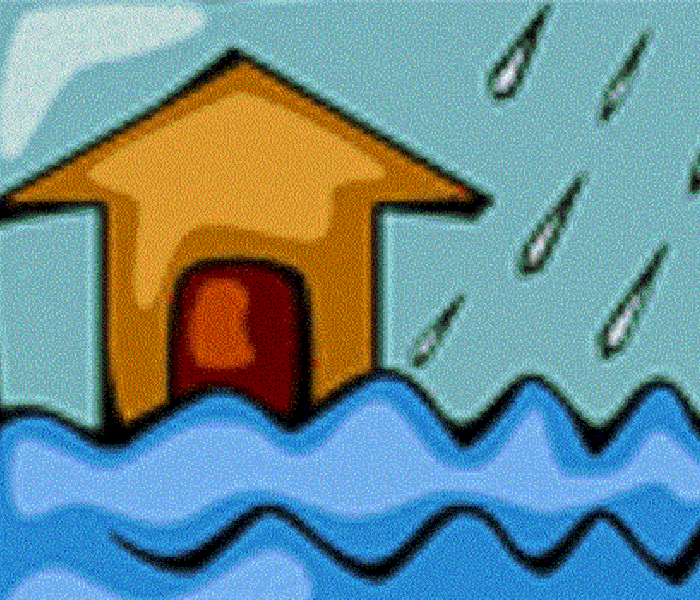
Floods are the most common and costly natural disaster. While some of Mother Nature's more demonstrative displays, such as hurricanes, tornadoes and earthquakes, get more public attention, floods are the number one weather-related killer in the U.S.
Flash Floods are the most dangerous kind of flood, combining the nearly unstoppable force of flood waters with deadly unpredictability and speed. The truth is as simple as it is tragic: Just six inches of fast-moving flood water can knock a grown man off his feet, and just two feet of water can cause a car to begin floating.
Should a flash flood strike your area, SERVPRO of Virginia Beach wants you to be equipped with the following tips to help keep you safe.
You cannot outrun a flash flood. Get to higher ground!
Stay away from and keep children away from drainage ditches and storm drains.
Never drive into water covering the road. You do not know how deep it is or if the road underneath the water has been washed away.
If your vehicle stalls, leave it immediately and seek higher ground if it is safe to do so.
Be especially cautious at night when it is difficult to recognize flood dangers
Do not attempt to cross flowing water is the water is above ankle level
Please contact SERVPRO of Virginia Beach for
Water Removal & Dehumidification
Catastrophic Storm Response
Mold Mitigation and Remediation
Fire, smoke, soot
Move outs and content restoration
Duct Cleaning
Biohazard, Crime Scene and Vandalism
SERVPRO of Virginia Beach
757-431-1400
It's always best to call us directly.
Plan two escapes
4/29/2013 (Permalink)
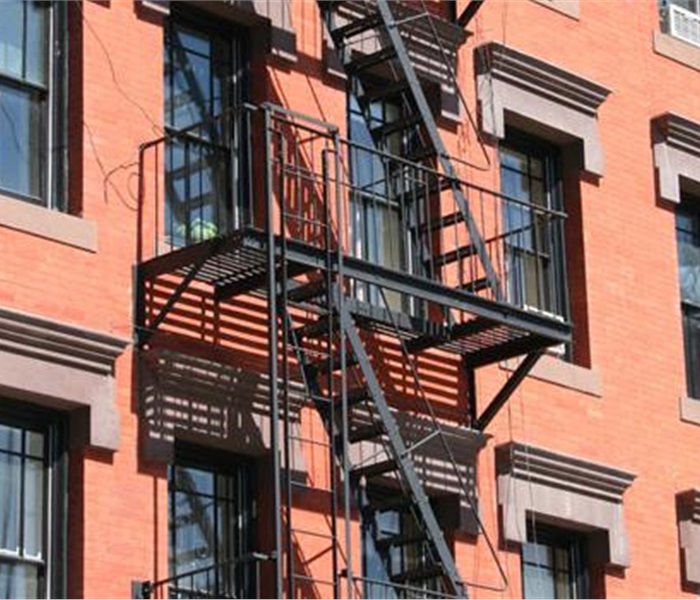
One home structure fire was reported every 85 seconds in 2010.
Most fatal fires kill one or two people. In 2010, 19 home fires killed five or more people. These 19 fires resulted in 101 deaths.
In 2010, U.S. fire departments responded to 369,500 home structure fires. These fires caused 13,350 civilian injuries, 2,640 civilian deaths, and $6.9 billion in direct damage.
As scary as those scenarios look in black and white, imagine just how frightening they are in technicolor.
Though some fires are unavoidable acts of nature or unpredictable accidents, many fires in the home and workplace are avoidable. The following tips, courtesy of the National Fire Protection Association, can help reduce the likelihood of a fire in your business or home.
Watch your cooking. Stay in the kitchen if you are frying, grilling, or broiling food.
Give space heaters space. Keep space heaters at least three feet from anything that can burn.
Smoke outside. If you must smoke inside, have a sturdy, deep ashtray. Never smoke in bed.
Keep matches and lighters out of reach in high cabinets, preferably under a child lock.
Inspect electrical cords. Replace cords that are cracked, damaged, have broken plugs or have loose connections.
Be careful when using candles. Keep candles at least one foot from anything that can burn. Blow them out before you leave the room or go to sleep.
Have a fire escape plan. Make a fire escape plan and practice it at least twice a year. Also, as is this year's theme for fire prevention week -- MAKE SURE YOU HAVE TWO ESCAPE ROUTES.
Install smoke alarms on every level of your office or home and inside bedrooms. Interconnect them so they all sound at once.
Test smoke alarms. Test alarms once per month. Replace batteries once per year or as needed.
Install sprinklers. Sprinklers can help maintain and sometimes even extinguish fires, giving your local Fire Department a better chance of saving your property.
*Fire Prevention Week*
It is important to have a home and office fire escape plan that prepares your family or staff to think fast and get out quickly when the smoke alarm sounds. What if your first escape route is blocked by smoke or flames? That's why having two ways out is such a key part of your plan. This year's theme,"Have 2 Ways Out!", focuses on the importance of fire escape planning and practice.
Have 2 Ways Out!
SERVPRO of Virginia Beach
757-431-1400
It's always best to call us directly.
Do Not Fall for Fire Hazards
4/29/2013 (Permalink)

Fall decorations like dried flowers and cornstalks are highly flammable. Keep these and other decorations away from open flames and heat sources, including light bulbs and heaters.
Keep emergency exits clear of decorations, so nothing blocks escape routes.
Teach children to stay away from open flames. Be sure they know how to stop, drop and roll if their clothing catches fire.
Remember safety first, when choosing a Halloween costume. Consider avoiding billowing fabric. If you are making your costume, choose material that won't easily ignite if it comes into contact with heat or a flame.
It is safest to use a flashlight or battery-operated candle in a jack-o-lantern. Use extreme caution if using a real candle.
Place lit pumpkins away from anything that can burn and out of the way of doorsteps, walkways and yards.
Flashlights are a safe alternative to candles or torch lights when decorating walkways and yards.
Facts and information provided by National Fire Protection Association, nfpa.org
SERVPRO of Virginia Beach
757-431-1400
It's always best to call us directly.
Not too crisp for a hurricane
4/29/2013 (Permalink)
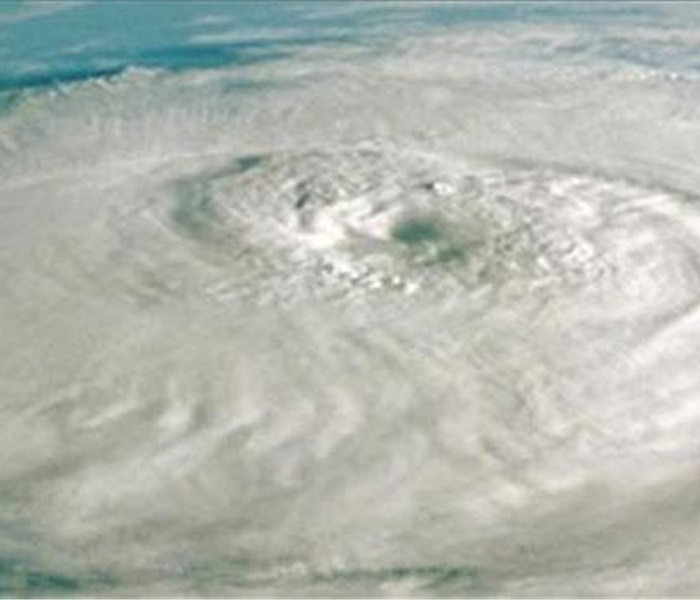
With crisper temperatures upon us, it's easy to forget that when it comes to hurricanes, we aren't out of the woods yet. Hurricane season doesn't officially end until November 30 -- so stay prepared and also remember that disasters come in all shapes and sizes and can strike at any time.
As a U.S. Department of Homeland Security National Preparedness Coalition member, SERVPRO® is committed to promoting preparedness planning and providing community resources to help prepare for emergency or disaster situations.
These tips apply to all types of disasters - whether earthquakes, floods, tornadoes, blizzards, or wildfires.
SERVPRO® Franchise Professionals want to help spread the important message on preparation to all areas and communities, no matter which corner of the country you call home. Whether you live on the East Coast, Gulf Coast, the West Coast, or anywhere in between, contact your local SERVPRO® Franchise Professionals for resources to help protect your home and business.
Write this down...
A well-equipped disaster supply kit should include, but is not limited to, the following items:
Water: 1 gallon per person daily.
Food: 3 to 7 days' worth of nonperishable or canned food, and manual can-opener.
Bedding: Blankets and pillows.
Clothing: Although the outside temperature may be warm, you may be working and cleaning. To help protect your skin, include pants and long-sleeve shirts.
First aid kit: In the very least, include sanitizers and bandages.
Cash: Keep some cash and small bills in your supply kit in case banks are closed.
SERVPRO of Virginia Beach
757-431-1400
It's always best to call us directly.
When it gets too hot in the kitchen
4/29/2013 (Permalink)

The holidays and cooking go hand in hand. But more time in the kitchen means an increased chance for cooking-related fires.
According to the National Fire Protection Association (NFPA), cooking has long been the leading cause of residential fires and fire injuries, and while Thanksgiving is the peak day for residential cooking fires, folks tend to start heading into the kitchen more and more as temperatures drop and Halloween really marks the beginning of the season for baked and fried treats.
A kitchen fire, regardless of the size, can be overwhelming. And while these fires typically begin on the stove, the damage generally affects the entire kitchen including, the walls, ceiling, air ducts and appliances.
A cooking fire is typically ignited by food or the grease and oils used to prepare the food, making cleanup more difficult.
The professionals at SERVPRO of Virginia Beach are trained in the cleanup and care of your home or business and contents following a fire. Proper remediation of fire, smoke, soot and water damage can help prevent further damage such as lingering odors, mold growth and permanent discoloration of items.
Before attempting to clean any smoke or
fire damage, contact SERVPRO of Virginia Beach.
SERVPRO of Virginia Beach
757-431-1400
It's always best to call us directly.
This stinks!
4/29/2013 (Permalink)
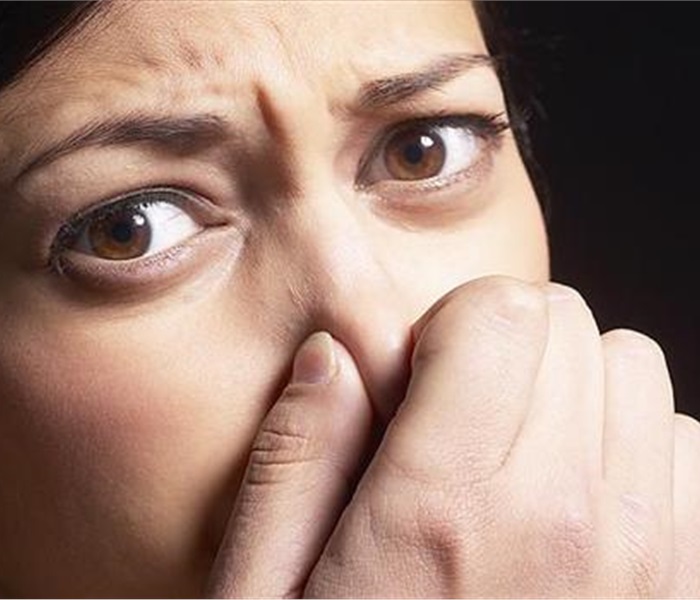
As various materials burn, the smoke produced travels throughout the structure, leaving odorous residues and deposits on surfaces and in hard to reach places. Unless fast, professional action is taken, these residues and deposits can cause permanent damage to contents and may result in periodically resurfacing odors.
From top to bottom...
Servpro of Virginia Beach provides specialized services that rid your home or business of offensive odors left by fire or smoke damage. Any restorable item in affected areas will be professionally cleaned and deodorized, including: furniture, draperies and upholstery, electronics, art, flooring, walls, ceilings, HVAC air ducts and more.
Search and Destroy
SERVPRO of Virginia Beach professionals do NOT cover up lingering odors with a fragrance, they seek out and remove the sources of the odor. Ask us to explain the various deodorization methods available and which will work best for you.
If you or a customer suffer a fire damage -- or some other accident -- and require deodorization services, contact SERVPRO of Virginia Beach. Whether it's fire, water or mold damage -- or just a stubborn odor that refuses to go away -- we'll help make it "Like it Never Even Happened."
SERVPRO of Virginia Beach
757-431-1400
It's always best to call us directly.
Protecting Your Property from Winter Weather
4/29/2013 (Permalink)
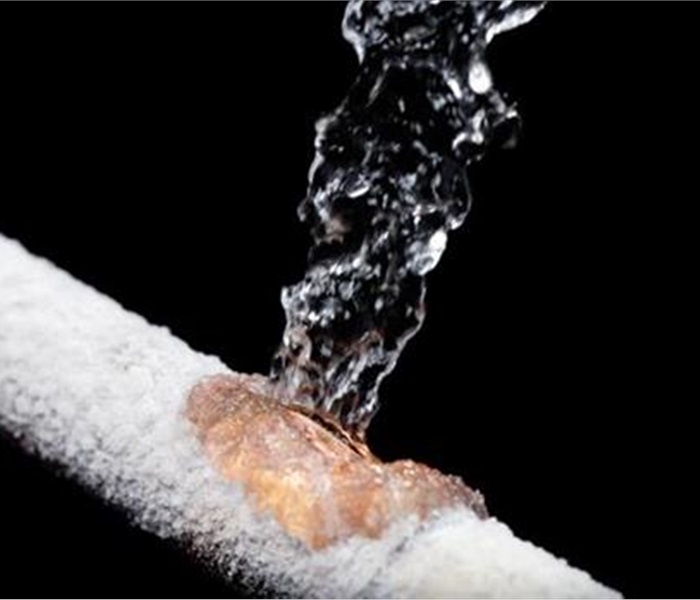
Cold weather can have a huge impact on your home or business if you are not properly prepared. Whether it is heavy rain, freezing temperatures, damaging winds, sleet or snow, all can cause serious property damage. While you can't control the weather, you can take steps to be prepared and help take the sting out of winter weather.
To help prevent costly damages due to weather, consider taking the following actions before the harsh winter weather hits.
Check your business property for downed tree limbs and branches. Weather such as wind, heavy rain, ice and snow, can cause damage to the property as well as potential personal injuries.
Inspect property, especially walkways and parking lots, for proper drainage to alleviate flood hazard potential.
Inspect all handrails, stairwells and entryways to address and correct potential slippery or hazardous areas. Install mats or non-slip surfaces and post caution signs where water could be present.
Roofs, water pipes and gutters should all be inspected to ensure they are in proper order. Gutter downspouts should be directed away from your building. Clear gutters of debris that may have gathered during the fall. Leaves and other obstructions can lead to a damming effect, that can cause roof damage and interior water problems.
Protect water pipes from freezing by simply allowing water to drip when temperatures dip below freezing. If pipes are under a cabinet, leave cabinet doors open, allowing warm air to circulate around the pipes. If the building has outdoor faucets, consider shutting water off at the main valve in the basement or crawl space. Once the valve is off, open the outdoor faucet to ensure it drains, preventing any remaining water from freezing in the pipe.
Ask your SERVPRO of Virginia Beach professional about completing an Emergency READY Profile (ERP) for your business. The ERP is a no-cost assessment to your facility and provides you with a plan to get back in business fast following a disaster.
SERVPRO of Virginia Beach
757-431-1400
It's always best to call us directly.
Power hungry?
4/29/2013 (Permalink)
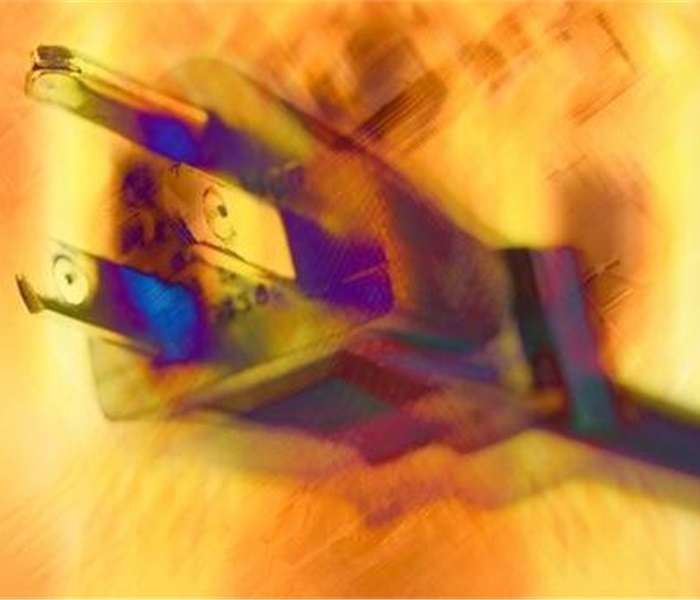
Don't get smoked
A recent report from the U.S. Fire Administration (USFA) shows home electrical fires claim the lives of 280 Americans each year and injure 1,000 more. Many electrical fires in the home or workplace are caused by overloaded circuits and extension cords.
December and January are the peak months for electrical fires. The USFA says fires occur more often in these months due to the increased time spent indoors, which also increases the use of lighting, heating and appliances.
Many electrical fires can be avoided if basic safety precautions are taken. Review the safety tips below to reduce your risk of an electrical fire.
Routinely check your electrical appliances and wiring.
Frayed wires can cause fires.
Replace any electrical tool or appliance if it overheats, shorts out, causes even small electrical shocks or gives off smoke or sparks.
If an appliance has a three-prong plug, use it only in a three slot outlet. Never force it to fit into a two-slot outlet or extension cord.
Following these simple safety rules should help keep your home or business safe from an electrical fire. In the unfortunate event that an electrical fire does happen, call SERVPRO of Virginia Beach and we'll make it "Like it never even happened."
Servpro of Virginia Beach
757-431-1400
It's always best to call us directly.
Get Ready!
4/29/2013 (Permalink)
Advantages of the SERVPRO Emergency READY Profile
A no-cost assessment of your facility.
A concise profile that contains only the critical information needed in the event of an emergency.
A guide to help you get back into your building following a disaster.
Identification of the line of command for authorizing work to begin.
Provides facility details such as shut-off valve locations, priority areas and priority contact information.
Profile is viewable online or on your SERVPRO READY APP and is secured with a login and password.
Don't wait until a disaster strikes. Contact SERVPRO of Virginia Beach to establish your Emergency READY Profile.
SERVPRO of Virginia Beach 757-431-1400
It's always best to call us directly.
Know your smoke
4/29/2013 (Permalink)
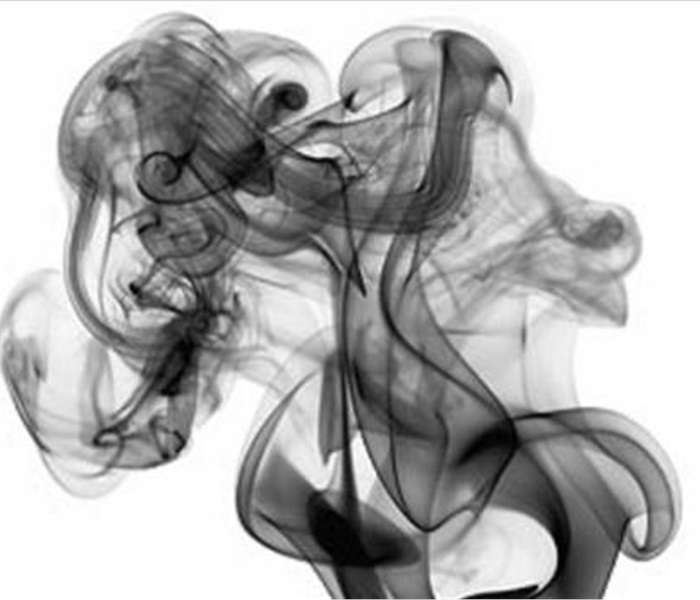
When SERVPRO of Virginia Beach arrives on the scene of a fire, the first step is to calm the customer's fears. The next step is to pre-test the smoke to determine what type of fire has taken place. Knowing the types of smoke and their behavior patterns is crucial to proper cleanup protocol.
Smoke and soot residue can damage carpet, upholstery and contents if not removed quickly and efficiently. In a fire-damaged structure with soot on walls and surfaces, cleaning and restoration is less disruptive and more cost-efficient than replacement. Replacement means a longer disruption time than restoration. For a business waiting to reopen or a family that just wants to come home, this downtime can present a enormous hardship.
Do not leave the first vital hours to anyone who does not understand pre-testing.
The character of smoke
Wet Smoke: generated by the burning of plastics and rubber. Identifiable by it's pungent odor -- the residue is sticky and smears easily.
Dry Smoke: generated by the burning of paper and wood at high temperatures. More residue found at high levels as heat rises.
Protein Smoke: is a product of the evaporation of material during fire, not the fire itself. Although virtually invisible, It discolors paint and varnishes and has an extremely acrid smell.
We know the rules...
Insurance and business professionals understand the rule, "Restore whenever possible, replace only when necessary." SERVPRO of Virginia Beach works hard to ensure pre-testing is completed on every loss to determine restorability. Pre-testing should occur immediately to qualify restoration with the customer by identifying the following:
Items unaffected by the loss
Restorable items
Items that cannot be restored
Questionable items that need an adjuster's professional opinion
Determine the most effective cleaning and restoration processes
Identify pre-existing conditions
Gauge the extent of the loss
Reduce overall costs of the restoration process
Eliminate needless replacements
Judge what is restorable and what must be replaced.
SERVPRO of Virginia Beach
757-431-1400
It's always best to call directly.
How cold is it?
4/29/2013 (Permalink)
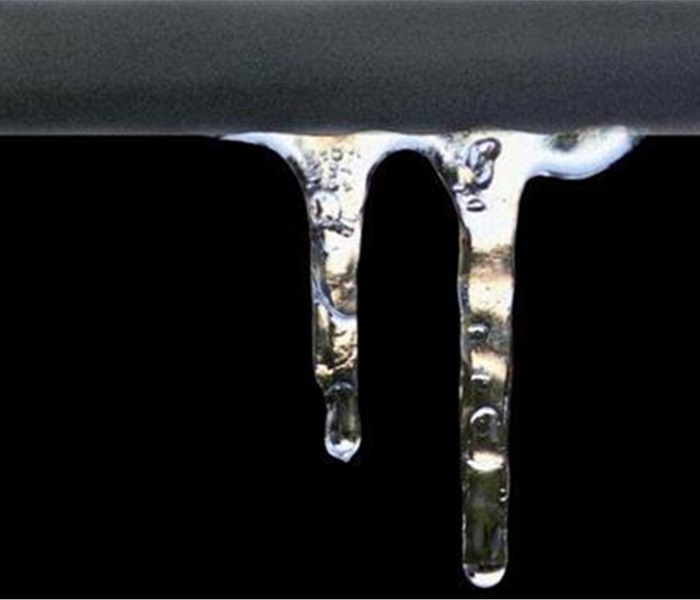
It's so cold Eskimos are closing their windows!
It's so cold hitchhikers are holding up pictures of their thumbs!
It's so cold Richard Simmons is wearing pants!
All joking aside, it's cold out there. In fact, it's so cold out there that we here at SERVPRO of Virginia Beach thought the timing was good to remind you about the damage freezing temperatures can cause to your home or business if you aren't prepared.
Tips for Winter Property Safety:
Keep cabinet doors open during consistent cold temperatures. This allows warm air to circulate around pipes.
Keep a slow trickle of water flowing through faucets, especially if the pipes run through unheated or uninsulated areas of your home or business.
Consider shutting off outdoor faucets. Find the shut-off valve and turn it to "off."
If you do turn off outdoor faucets, be sure to open the faucet to help ensure it drains completely and the inner valve in shut off.
Ensure gutters are clean and secure. Leaves and debris accumulate, causing a damming effect on gutters, which can lead to roof problems and water damage.
Provide the proper maintenance of your furnace, this can reduce the risk of puff backs.
SERVPRO of Virginia Beach
757-431-1400
It's best to call us directly.
Snow what!
4/29/2013 (Permalink)
Snow is a lot like liver and onions. You either love it or hate it. But, if you find yourself stranded in your vehicle in the middle of a snow event, you can either hate the fact that you weren't prepared for it, or love that you are.
S'now what...
Mother nature can be a real beast. In fact, she's a killer. And when it comes to a snow event, the best idea for safety is to stay off the roads and keep warm and safe at home. However, that isn't always possible. When you find that you must venture out on snowy and icy roads, you know to stay alert, drive a little slower, brake according to road conditions... But what if your vehicle breaks down or gets stuck and you must wait for help in a disabled vehicle in dangerously cold, wet weather?
SERVPRO of Virginia Beach wants you to be prepared in the face of any hazard that may cross your path, whether flood, fire or treacherous travel conditions.
Please take a moment to look at the list (below) of suggested items to keep in your vehicle. Just a little bit of preparation can keep a little emergency from becoming a catastrophe.
Stay warm and carry on! And tune in to AM 1310 on radio to stay alert to the latest weather conditions.
SERVPRO of Virginia Beach
757-431-1400
It's always best to call us directly
Keep These Things in Your Vehicle
Cell phone
Car charger
LED flashlight
Bag of rock salt
Shovel
Wool blankets/one for each passenger
Ice scraper
Leatherman or Swiss Army knife
Jumper cables
Two quarts of oil
Extra fuses
Fix-a-Flat
Paper towels
First aid kit
Prescription and OTC medications
Winter boots, scarves, hats and heavy winter clothes for each passenger
Water
Snack bars
Toilet paper
Music/games for young passengers
Do not throw caution to the wind
4/29/2013 (Permalink)
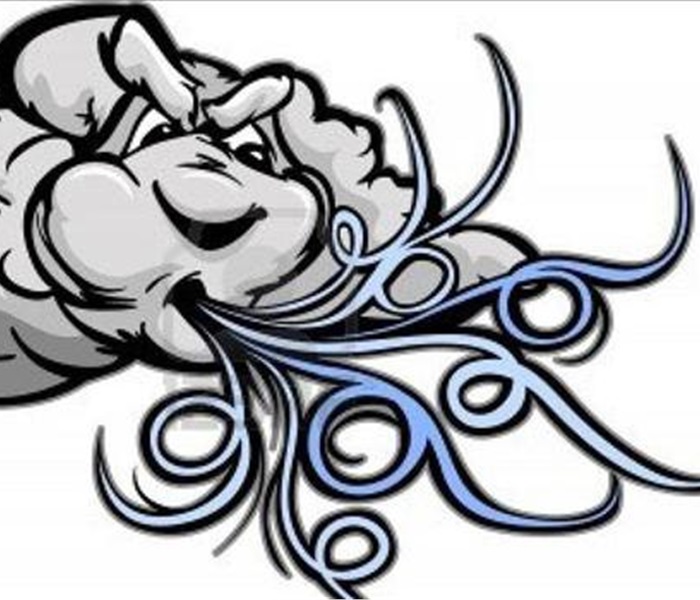
Winds in our area have been picking up throughout the day and the National Weather Service has updated previous wind advisories and is now warning of sustained winds of 20-30 mph with gusts of up to 50 mph through 5 a.m. Thursday.
Please take a moment today to check areas around your home and business that may be particularly susceptible to wind damage. With the recent snow and up to a half an inch of rain forecast for late this evening, the wet ground could compound issues with smaller trees as well as those with shallow root systems causing trees to topple. Power lines could also be affected.
Any weather-related havoc is likely to happen overnight while folks are usually in bed so it is important to asses any potential safety hazards before the wind and rain hit.
If nothing else, maybe you'll sleep better!
Tips for avoiding wind damage from Nationwide Insurance
Shingles should meet or exceed the local building code, and be rated high for wind and impact resistance.
Make sure shingles are snugly nailed down and fitted tightly together.
Inspect the roof sheathing to ensure it is securely nailed to avoid sections being peeled off by winds.
Make sure the connection between the roof and walls is tight to avoid updrafts lifting off the roof.
Check that HVAC units, skylights and pipes are tightly affixed and won't be blown off.
About walls and doors:
Is the building well sealed to prevent wind from getting in cracks and crevices and causing interior damage?
Check all siding and windows to ensure they are tightly attached.
All entry doors should be triple hinged and secured with a deadbolt lock for maximum windstorm protection.
Overhead doors should be able to withstand high winds and braced sufficiently.
Regarding outdoor areas:
Storage sheds and outbuildings should be securely anchored.
Evaluate everything you have stored outside, such as equipment, inventory and supplies, and make sure these are anchored or can be easily moved inside if a storm approaches.
Make sure dumpsters, outdoor lighting fixtures and fencing are secured. Strong windstorms can pick up items, such as waste receptacles, and turn them into destructive missiles.
Are there large shrubs and trees close to your building? Make sure they are healthy and pruned to prevent large limbs or whole trees from falling onto your building.
Outdoor signage should be tightly anchored and secure, and designed to withstand the weather in your region. Check with your insurer to see if your sign is included in your property insurance or if you need an endorsement to cover it.
Ensure your commercial property insurance covers any damage to your building or other business property caused by a windstorm.
About vehicles and fleet:
If possible, store any vehicles inside a garage or storage building.
Never park vehicles under a tree if a storm approaches.
If you must park vehicles outdoors, be aware of things that could cause damage such as branches, lampposts and power lines.
If a windstorm approaches, consider sending fleet vehicles home with approved drivers for the business to dilute the risk of damage.
Should you encounter damage from wind or rain at your personal or business property, please call SERVPRO of Virginia Beach and let us make it Like it never even happened.
757-431-1400
It's always best to call us directly
Steps To Protect Commercial Buildings From Wind Driven Rain
4/29/2013 (Permalink)
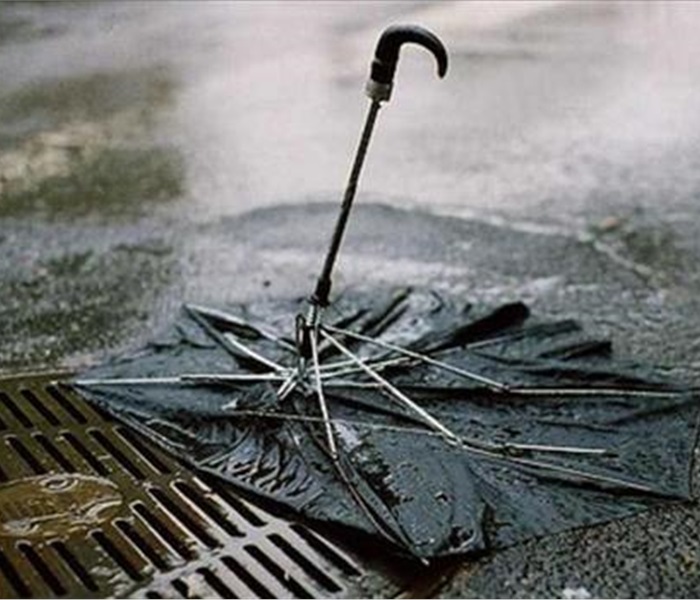
More than 60 percent of the United States is vulnerable to damage from high-wind events such as hurricanes, straight-line winds and severe thunderstorms that can produce high winds and heavy rains. Here in Hampton Roads, we are certainly susceptible to damage from strong winds and rain -- and, evidenced by recent weather events, it need not be hurricane season for us to take a wallop from wind.
Taking simple steps can make a big difference when it comes to reducing the damage caused by wind-driven rain.
Check for leaks around windows and doors, especially near corners.
Check for peeling paint, it can be a sign of water getting into the wood.
Inspect for discolorations in paint or caulking, swelling of the window or doorframe or surrounding materials.
Flashing, which is typically a thin metal strip found around doors, windows, thresholds, chimneys, and roofs, is designed to prevent water intrusion in spaces where two different building surfaces meet.
All vents, including gable vents, roof vents, and exhaust vents should be well anchored to the roof, flashed and sealed to prevent leaks.
And while the outside of the building may survive unscathed, inside water intrusion can soak documents, computers and other valuable supplies.
Water damage can threaten a business's ability to quickly bounce back after a storm. SERVPRO of Virginia Beach can help with cleanup to get your business back up and running and can assist you with future concerns by creating a plan. And it's a free service.
In addition to preparing the building against water damage, leaks can find their way in through any opening, it's important to plan for the worst before it happens. The IBHS suite of Open for Business® continuity planning and recovery tools can get you on the road to preparation. Should your building become damaged by a catastrophic event such as wind-driven rain, take appropriate actions to prevent further water damage once it is safe to do so. Water damage left unattended can result in structural failure or, potentially, mold growth. Here's what to do:
Remove standing water and all moist materials, such as wet, damaged flooring or rugs, carpet, personal property, stock, equipment or inventory, and consult SERVPRO of Virginia Beach determine the extent of the repairs necessary.
Board up damaged windows and doors.
After you have dealt with the immediate crises, contact your insurance agent to report the loss and let them know you'll be using SERVPRO of Virginia Beach for mitigation and restoration needs.
Stay dry.
SERVPRO of Virginia Beach
757-431-1400
It's always best to call us directly.
Why use SERVPRO of Virginia Beach
4/29/2013 (Permalink)
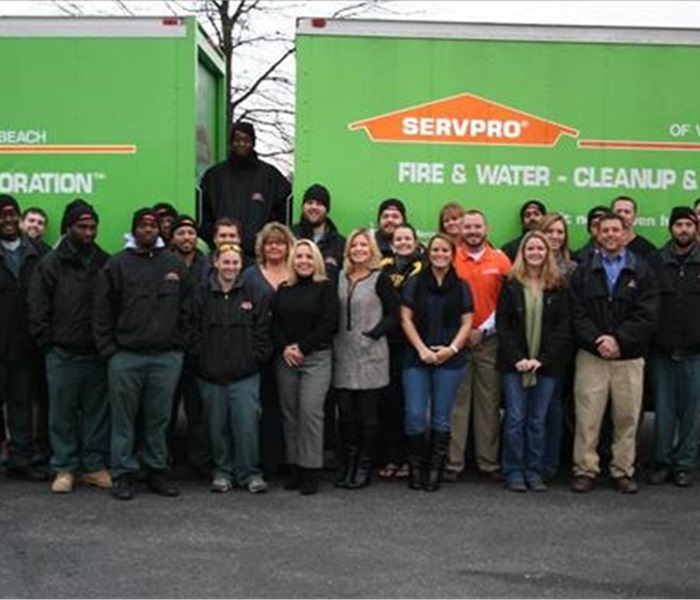
There is never a good time for storm waters to flood
your property or fire to smoke out your home or business.
Disasters seem to strike at the worst possible moment.
Timely and efficient mitigation is the key to reducing costs and
minimizing business interuption. The sooner restoration and cleanup begins,
the sooner you and your customers can resume your everyday lives.
That is why it is important to choose a team with the capabilities
to help make any size disaster.. Like it never even happened.
The Benefits of Using SERVPRO of Virginia Beach
Class "A" Licensed Contractor
24 Hour Competitive Bids
Drug Free Workplace with Criminal Background Checks
IICRC Certified Firm & IICRC Certified Team
Onsite Climate Controlled Storage Facilites
Large Loss/Storm Team Member
Free estimates/advice
3 day dry down average
And those are just a few reasons! For more information on our services
and why we are the best cleanup and restoration team in Hampton Roads,
visit our website at www.servproofvirginiabeach.com or call our office
to speak to one of our staff members. We're Ready for Whatever Happens.
SERVPRO is Named No. 1 in Cleanup & Restoration
On Wednesday, February 13th, Marketwire.com annoucned
that the SERVPRO Franchise system earned the No. 1
spot in the cleanup and restoration industry for the
10th consecutive year in Entreprenuer Magazine Franchise 500!
Read the article below!
http://www.marketwire.com/press-release/servpror-earns-top-spot-in-industry-category-on-entrepreneur-franchise-500-list-1756617.htm
Remember, it is always best to call our office directly!
757-431-1400
Do not fall victim to a dryer fire
4/29/2013 (Permalink)
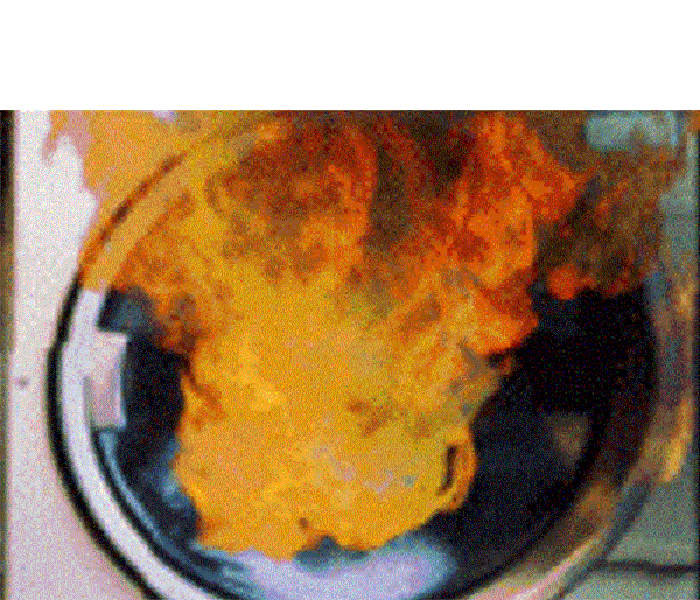
An electric or gas clothes dryer is nearly an essential part of life in most homes. In families with children, the laundry can seem a daunting task, going on forever with washing machines and dryers churning and turning away slowly at a never-ending mountain of laundry.
But, all that convenience carries with it the possibility of a deadly hazard -- a dryer fire -- the leading cause of home fires in this country at the rate of about 15,000 every year.
*Don't dry dangerously*
While today's clothes dryer is in itself a safe piece of machinery and and a feat of modern technology, it isn't fail-safe and requires regular preventive maintenance to prevent fires that could start in your lint trap or anywhere within your dryer's venting.
When lint traps aren't cleaned as often as they should be, the resulting build-up in the screen or other areas can cause the dryer to perform poorly, operate at elevated temperatures and possibly overheat -- with dangerous consequences. Vent systems must also be checked and cleaned to maintain proper air flow for the same reasons.
Problems may also occur if consumers place improper items in their dryers, such as foam backed rugs or athletic shoes, or vent their appliances with plastic or vinyl exhaust materials. Make sure that whatever you put in your dryer is approved and safe to place in a dryer. When in doubt, check the washing instructions on the tag of the clothing or consult the manufacturers website for more information.
Please follow these useful tips to avoid a dryer fire. In the unfortunate event that you encounter a dryer fire and the damage left in its wake, please call us at SERVPRO of Virginia Beach and we can make it Like it Never Even Happened.
757-431-1400
It' s always best to call us directly
Clean it up: Do not sweep common sense under the rug
4/29/2013 (Permalink)
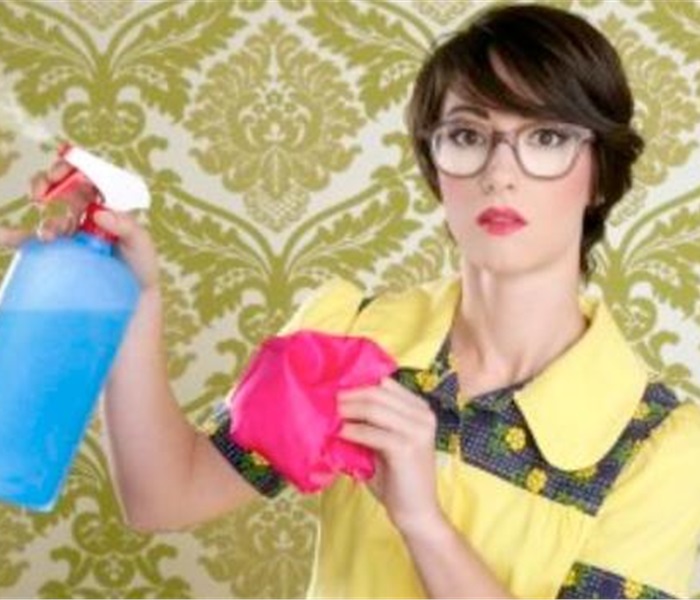
*Room-by-Room*
Since you're already moving from room to room cleaning, it's the perfect time to update your home inventory-or start one. An up-to-date home inventory can help make the recovery process easier if you need to file an insurance claim. Just create a list and snap pictures of your belongings. And, while you are at it, give your smoke and carbon monoxide detectors a test, replace batteries if needed and take a peek at the expiration dates on your fire extinguishers.
*Give appliances some love*
Give your appliances some love. Dust and clean your refrigerator's coils using a vacuum attachment, or buy a refrigerator coil brush. Don't forget to change the filters in your furnace/air conditioner and stove hood. Clean, well-maintained appliances tend to run more efficiently,and safely which can mean a lower electric bill, cleaner air ducts and less chances for fire.
*Get Caulky*
Look for worn grout or caulk between tiles in the bathroom or kitchen. Even the smallest crack can lead to expensive repairs down the line. Reseal any areas you find with a penetrating grout sealer.
All of these great spring cleaning tips came from the folks at Allstate. We are just happy to pass them along.
And remember, should fire or water interrupt your home or business, SERVPRO of Virginia Beach is here 24 hours a day, seven days a week ready to make it Like it Never Even Happened!
It's always best to call us directly!
757-431-1400
Your smart phone may be smarter than you think
4/29/2013 (Permalink)

*A beacon in the darkness*
Unless you find yourself starring alongside Vin Diesel as one of a group of marooned space travelers struggling for survival on a sun-scorched world that has become Pitch Black, your wireless device could be the most important tool you have in a disaster -- and not just because of that handy flashlight app you downloaded.
*Seek the sun*
Purchase additional batteries and car-charger adapters for wireless devices; make sure to keep the batteries fully charged. Keep phones, laptops, PDAs, batteries, chargers and other equipment in a dry, accessible location. It is a good idea to keep them in a waterproof bag. Consider purchasing a solar-powered charger.
*Know who to call*
Maintain a list of emergency phone numbers - police, fire and rescue agencies; power companies; insurance providers; family, friends and co-workers. Distribute wireless phone numbers to family members and friends and forward your home phone to your wireless number if you will be away from your home or have to evacuate.
*Try texting*
Send brief text messages rather than voice calls - often text messages get through when wireless networks are overwhelmed during a crisis. Finally, limit non-emergency calls to conserve battery power and free-up wireless networks for vital communications.
Identify a contact who lives out-of-state to notify that you are safe. It may be easier to make a long-distance phone call than to call across town, so an out-of-town contact may be in a better position to communicate among separated family members. Be sure every member of your family knows vital land-line phone numbers as well as cell lines.
Consider adding coins or a prepaid phone card to your emergency kit. If your cell phone has an
"ICE" (In Case of Emergency) contact function, program your contact today. If you are in an
accident, emergency personnel will often check your ICE listings in order to get a hold of
someone you know. Make sure to inform your ICE contact that you have selected
them as an emergency contact.
During a crisis or emergency, timely information is needed in order to make smart decisions.
Be Informed ( http://www.ready.gov/be-informed ) about many types of emergencies and
disasters that may occur.
And should you find yourself facing a disaster such as a water damage or fire, SERVPRO of Virginia Beach is here and ready to help make it Like it Never Even Happened. Just call us directly at 757-431-1400 - you may even want to program it into your smart phone!
757-431-1400
It's always best to call us directly
How to pick the right fire extinguisher
4/29/2013 (Permalink)
Here's a tip... Choosing the appropriate Fire Extinguisher
Class A:
This is the most common extinguisher and can be used to put out fires in ordinary combustibles such as cloth, wood, rubber, paper and many plastics.
Class B:
Used on fires involving flammable liquids such as grease, gasoline and oil.
Class C:
Designed for fires involving appliances, tools or other equipment electrically energized or plugged in.
Class D:
For use on flammable metals; often specific for the type of metal in question. These are typically found only in factories working with these metals.
Class K:
Intended for use on fires that involve vegetable oils, animal oils or fats in cooking appliances. These extinguishers are generally found in commercial kitchens, but are becoming more popular in the residential market for use in kitchens.
SERVPRO of Virginia Beach is quietly taking to the streets, every hour of every day, proving that whenever there is a house full of water or an office full of smoke, there is a van full of clean! It's always best to call our office directly! 757-431-1400





 24/7 Emergency Service
24/7 Emergency Service






















